Similar presentations:
C++ Network Programming Systematic Reuse with ACE & Frameworks
1. C++ Network Programming Systematic Reuse with ACE & Frameworks
C++ Network ProgrammingSystematic Reuse with
ACE & Frameworks
Dr. Douglas C. Schmidt
d.schmidt@vanderbilt.edu
www.dre.vanderbilt.edu/~schmidt/
Professor of EECS
Vanderbilt University
Nashville, Tennessee
2.
Presentation OutlineCover OO techniques & language features that enhance software quality
• Patterns, which embody
reusable software
architectures & designs
• Frameworks, which can
be customized to support
concurrent & networked
applications
• OO language features, e.g., classes, dynamic binding &
inheritance, parameterized types
2
Presentation Organization
1. Overview of product-line
architectures
2. Overview of frameworks
3. Server/service & configuration
design dimensions
4. Patterns & frameworks in ACE +
applications
3.
MotivationNav
Air
Frame
HUD
Nav
AP
FLIR
Air
Frame
GPS
IFF
IFF
Cyclic
Exec
AP
HUD
Cyclic
Exec
F-15
HUD
Air
Frame
FLIR
AP
FLIR
GPS
IFF
GPS
Cyclic
Exec
A/V-8B
Legacy distributed real-time &
embedded (DRE) systems
have historically been:
• Stovepiped
• Proprietary
• Brittle & non-adaptive
• Expensive
• Vulnerable
3
Nav
GPS
Nav
AP
Consequence:
Small HW/SW
changes have big
(negative) impact
on DRE system
QoS & maintenance
FLIR
Air
Frame
Cyclic
Exec
F/A-18
HUD
IFF
UCAV
4.
MotivationF/A 18
product
variant
A/V 8-B
product
variant
F-15
product
variant
Air
Frame
FLIR
HUD
GPS
AP
UCAV
product
variant
Nav
IFF
Domain-specific Services
Common Middleware Services
Distribution Middleware
Host Infrastructure Middleware
OS & Network Protocols
Product-line
architecture
Hardware (CPU, Memory, I/O)
• Frameworks factors out many reusable general-purpose & domainspecific services from traditional DRE application responsibility
• Essential for product-line architectures (PLAs)
• Product-lines & frameworks offer many configuration opportunities
• e.g., component distribution & deployment, user interfaces & operating
systems, algorithms & data structures, etc.
4
5. Overview of Product-line Architectures (PLAs)
• PLA characteristics are capturedvia Scope, Commonalities, &
Variabilities (SCV) analysis
• This process can be applied to
identify commonalities &
variabilities in a domain to
guide development of a PLA
[Coplien]
•e.g., applying SCV to Bold Stroke
• Scope: Bold Stroke component
architecture, object-oriented application
frameworks, & associated components,
e.g., GPS, Airframe, & Display
Reusable Application
Components
Reusable Architecture
Framework
Air
Frame
FLIR
HUD
GPS
AP
Nav
IFF
Domain-specific Services
James Coplien et al.
Commonality & Variability
in Software Engineering,
IEEE
Software 1998
5
Common Middleware Services
Distribution Middleware
Host Infrastructure Middleware
OS & Network Protocols
6. Applying SCV to Bold Stroke PLA
•Commonalities describe the attributes that are common across allmembers of the family
• Common object-oriented frameworks & set of component types
• e.g., GPS, Airframe, Navigation, & Display components
• Common middleware
infrastructure
• e.g., Real-time
CORBA & a variant
of Lightweight
CORBA Component
Model (CCM) called
Prism
GPS
Component
Display
Component
Airframe
Component
Heads Up
Display
Bold Stroke Common Components
Domain-specific Services
Common Middleware Services
Distribution Middleware
Host Infrastructure Middleware
OS & Network Protocols
6
Hardware (CPU, Memory, I/O)
7.
Applying SCV to Bold Stroke PLA• Variabilities describe the
attributes unique to the different
members of the family
GPS
Component
• Product-dependent
component implementations
(GPS/INS)
• Product-dependent
component connections
• Product-dependent
component assemblies (e.g.,
different weapons systems
for security concerns)
• Different hardware, OS, &
network/bus configurations
Display
Component
Airframe
Component
Heads Up
Display
Bold Stroke Common Components
GPS = 40 Hz
GPS = 20 Hz
Nav
Air
Frame
HUD
AP
FLIR
IFF
GPS
F/A 18 F
Nav
GPS=20Hz
Air
Frame
Air
Frame
HUD
AP
FLIR
GPS
IFF
AP
F 15K
Domain-specific Services
7
Distribution Middleware
Host Infrastructure Middleware
OS & Network Protocols
Hardware (CPU, Memory, I/O)
GPS
FLIR
HUD
Common Middleware Services
Frameworks are essential
for developing PLAs
Nav
IFF
UCAV
8. Overview of Frameworks
Framework Characteristics•Frameworks exhibit
•Frameworks provide
•Frameworks are
“inversion of control” at integrated domain-specific “semi-complete”
runtime via callbacks
structures & functionality
applications
Application-specific
functionality
Mission
Computing
Scientific
Visualization
E-commerce
GUI
Networking
8
Database
www.cs.wustl.edu/~schmidt/frameworks.html
9. Benefits of Frameworks
• Design reuse• e.g., by guiding application
developers through the steps
necessary to ensure successful
creation & deployment of
software
AdminClient
Admin
Controllres
Admin
Views
Proxy
PickingClient
Picking
Controllres
Thin UI Clients
Broker
Picking
Views
Proxy
Broker
Distribution
Infrastructure
OS-Access
Layer
Component
Repository
Communication
Component
Configurator
Services
Broker
Broker
Scheduler/
ActivationList
Reactor
Service
Request
Logging
Handler
ThreadPool
Service
Request
Service
Request
WarehouseRepHalfX
9
*
Concurrency
Infrastructure
10. Benefits of Frameworks
• Design reuse• e.g., by guiding application
developers through the steps
necessary to ensure successful
creation & deployment of
software
• Implementation reuse
• e.g., by amortizing software
lifecycle costs & leveraging
previous development &
optimization efforts
10
11. Benefits of Frameworks
• Design reuse• e.g., by guiding application
developers through the steps
necessary to ensure successful
creation & deployment of
software
• Implementation reuse
• e.g., by amortizing software
lifecycle costs & leveraging
previous development &
optimization efforts
• Validation reuse
• e.g., by amortizing the efforts of
validating application- &
platform-independent portions
of software, thereby enhancing
software reliability & scalability
11
www.dre.vanderbilt.edu/scoreboard
12. Comparing Reuse Techniques
APPLICATIONSPECIFICFUNCTIONALITY
LOCAL
INVOCATIONS
Class Library Architecture
Math
IPC
ADTs
Files
Strings
GUI
EVENT
LOOP
GLUE
CODE
Locks
Reactor
ADTs
Strings
INVOKES
Files
• A class is a unit of abstraction &
implementation in an OO programming
language, i.e., a reusable type that often
implements patterns
• Classes in class libraries are typically passive
NETWORKING
Framework Architecture
APPLICATIONSPECIFIC
FUNCTIONALITY
CALLBACKS
GUI
Locks
• A framework is an integrated set of classes
that collaborate to produce a reusable
architecture for a family of applications
• Frameworks implement pattern languages
DATABASE
Component Architecture
Naming
Events
Logging
12
Locking
Middleware Bus
• A component is an encapsulation unit with
one or more interfaces that provide clients
with access to its services
• Components can be deployed & configured
via assemblies
13. Taxonomy of Reuse Techniques
13Class
Libraries
Frameworks
Components
Micro-level
Meso-level
Macro-level
Stand-alone
language entities
“Semicomplete”
applications
Stand-alone
composition entities
Domainindependent
Domain-specific
Domain-specific or
Domain-independent
Borrow caller’s
thread
Inversion of
control
Borrow caller’s
thread
14. The Frameworks in ACE
ACE frameworks are a product-line architecture for domain of network applicationsApplicationspecific
functionality
Acceptor
Connector
Stream
Component
Configurator
Reactor
Proactor
Task
ACE Framework
Inversion of Control & Hook Methods
Reactor & Proactor
Calls back to application-supplied event handlers to perform
processing when events occur synchronously & asynchronously
Service Configurator
Calls back to application-supplied service objects to initialize,
suspend, resume, & finalize them
Task
Calls back to an application-supplied hook method to perform
processing in one or more threads of control
Acceptor/Connector
Calls back to service handlers to initialize them after they are
connected
Streams
Calls back to initialize & finalize tasks when they are pushed &
popped from a stream
14
15. Commonality & Variability in ACE Frameworks
Commonality & Variability in ACE FrameworksFramework
Commonality
Variability
Reactor
• Time & timer interface
• Time & timer implementation
• Synchronous initiation event
• Synchronous event detection, demuxing, &
handling interface
Proactor
• Asynchronous completion event
handling interface
dispatching implementation
• Asynchronous operation & completion event
handler demuxing & dispatching
implementation
Service
Configurator
• Methods for controlling service
• Number, type/implementation, & order of
lifecycle
• Scripting language for
interpreting service directives
service configuration
• Dynamical linking/unlinking implementation
Task
• Intra-process message queueing
• Strategized message memory management
& processing
• Concurrency models
& synchronization
• Thread implementations
• Synchronous/asynchronous &
• Communication protocols
Acceptor/
Connector
Streams
15
active/passive connection
establishment & service handler
initialization
• Type of service handler
• Service handler creation, accept/connect, &
activation logic
• Layered service composition
• Number, type, & order of services
• Message-passing
composed
• Concurrency model
• Leverages Task commonality
16. The Layered Architecture of ACE
www.cs.wustl.edu/~schmidt/ACE.html•Large open-source user community
• www.cs.wustl.edu/~schmidt/ACE-users.html
16
Features
•Open-source
•200,000+
lines of C++
•40+ personyears of effort
•Ported to
many OS
platforms
•Commercial support by Riverace
• www.riverace.com/
17. Networked Logging Service Example
Key Participants• Client application
processes
• Generate log records
• Client logging daemons
• Buffer log records &
transmit them to the
server logging daemon
• Server logging daemon
• Receive, process, &
store log records
C++ code for all logging
service examples are in
• ACE_ROOT/examples/
C++NPv1/
• ACE_ROOT/examples/
C++NPv2/
17
18. Patterns in the Networked Logging Service
Half-Sync/Half-Async
Leader/
Followers
Monitor
Object
Active
Object
Reactor
Pipes &
Filters
AcceptorConnector
Component
Configurator
Proactor
Wrapper
Facade
18
Strategized
Locking
Scoped
Locking
Thread-safe
Interface
19. Service/Server Design Dimensions
•When designing networked applications, it's important to recognizethe difference between a service, which is a capability offered to
clients, & a server, which is the mechanism by which the service is
offered
•The design decisions regarding services & servers are easily
confused, but should be considered separately
•This section covers the following service & server design
dimensions:
•Short- versus long-duration services
•Internal versus external services
•Stateful versus stateless services
•Layered/modular versus monolithic services
•Single- versus multiservice servers
•One-shot versus standing servers
19
20. Short- versus Long-duration Services
• Short-duration servicesexecute in brief, often fixed,
amounts of time & usually
handle a single request at a
time
• Examples include
• Computing the current time
of day
• Resolving the Ethernet
number of an IP address
• Retrieving a disk block from
the cache of a network file
server
• To minimize the amount of time
spent setting up a connection,
short-duration services are
often implemented using
connectionless protocols
• e.g., UDP/IP
20
• Long-duration services run for extended, often
variable, lengths of time & may handle numerous
requests during their lifetime
• Examples include
• Transferring large software releases via FTP
• Downloading MP3 files from a Web server
using HTTP
• Streaming audio & video from a server using
RTSP
• Accessing host resources remotely via TELNET
• Performing remote file system backups over a
network
• Services that run for longer durations allow more
flexibility in protocol selection. For example, to
improve efficiency & reliability, these services are
often implemented with connection-oriented
protocols
• e.g., TCP/IP or session-oriented protocols,
such as RTSP or SCTP
21. Internal vs. External Services
21• Internal services execute in the
same address space as the
server that receives the request
• External services execute in
different process address
spaces
• Communication &
synchronization between internal
services can be very efficient
• They are generally more robust
than internal services since they
are isolated from each other
• Rogue services can cause
problems for other services,
however
• IPC & synchronization overhead
is higher, however
22. Monolithic vs. Layered/Modular Services
• Layered/modular services can bedecomposed into a series of
partitioned & hierarchically related
tasks
• They are generally easier to
understand, evolve, & maintain
• Performance can be a problem,
however
22
• Monolithic services are tightly
coupled clumps of functionality that
aren't organized hierarchically
• They are harder to understand,
evolve, & maintain
• They may be more efficient,
however
23. Single Service vs. Multiservice Servers
• Single-service servers offer onlyone service
• Deficiencies include:
• Consuming excessive OS
resources
• Redundant infrastructure code
• Manual shutdown & restart
• Inconsistent administration
23
• Multiservice servers address the
limitations with single-service servers by
integrating a collection of single-service
servers into a single administrative unit
• Master server spawns external services
on-demand
• Benefits are the inverse of single-service
server deficiencies
24. Sidebar: Comparing Multiservice Server Frameworks
UNIX INETD• Internal services, such as ECHO & DAYTIME, are fixed at static link time
• External services, such as FTP & TELNET, can be dynamically reconfigured via
sending a SIGHUP signal to the daemon & performing socket/bind/listen
calls on all services listed in the inetd.conf file
• Since internal services cannot be reconfigured, any new listing of such services
must occur via fork() & exec*() family of system calls
System V UNIX LISTEN port monitoring
• Like INETD
• Supports only external services via TLI & System V STREAMS
• Supports standing servers by passing initialized file descriptors via STREAMS pipes
from the LISTEN
Windows Service Control Manager (SCM)
• More than just a port monitoring facility
24
• Uses RPC-based interface to initiate & control administrator-installed services that
typically run as separate threads within either a single service or a multiservice
daemon process
25. One-shot vs. Standing Servers
• One-shot servers are spawned ondemand, e.g., by an inetd superserver
• They perform service requests in a
separate thread or process
• A one-shot server terminates after the
completion of the request or session that
triggered its creation
• Primary benefit is lower resource
utilization
• Primary drawback is startup latency
25
• Standing servers continue to run beyond
the lifetime of any particular service
request or session they process
• Standing servers are often initiated at
boot time or by a superserver after the
first client request
• Primary benefit is amortized startup
latency
• Primary drawback is higher resource
utilization
26. The ACE Reactor Framework
Motivation•Many networked applications are developed as event-driven programs
•Common sources of events in these applications include activity on an IPC
stream for I/O operations, POSIX signals, Windows handle signaling, & timer
expirations
•To improve extensibility & flexibility, it’s important to decouple the detection,
demultiplexing, & dispatching of events from the handling of events
26
27. The ACE Reactor Framework
•The ACE Reactor framework implements the Reactor pattern(POSA2)
•This pattern & framework automates the
•Detection of events from various sources of events
•Demultiplexing the events to pre-registered handlers of these
events
•Dispatching to hook methods defined by the handlers to process
the events in an application-defined manner
27
28. The ACE Reactor Framework
•The classes in the ACE Reactor framework implement the Reactor pattern:28
29. The Reactor Pattern Participants
•The Reactor architectural pattern allowsevent-driven applications to demultiplex &
dispatch service requests that are delivered
to an application from one or more clients
Reactor
handle_events()
register_handler()
remove_handler()
<<uses>>
29
*
handle set
Synchronous
Event Demuxer
select ()
*
dispatches
Handle
*
owns
Event Handler
handle_event ()
get_handle()
notifies
Concrete Event
Handler A
handle_event ()
get_handle()
Concrete Event
Handler B
handle_event ()
get_handle()
30. The Reactor Pattern Dynamics
: Main Program: Concrete
Event Handler
Con. Event
Handler
Events
: Reactor
: Synchronous
Event
Demultiplexer
register_handler()
get_handle()
Handle
handle_events()
Handles
handle_event()
service()
Handles
Observations
•Note inversion of control
•Also note how long-running event
handlers can degrade the QoS since
callbacks steal the reactor’s thread!
30
select()
event
31. Pros & Cons of the Reactor Pattern
Pros & Cons of the Reactor PatternThis pattern offers four benefits:
•Separation of concerns
• This pattern decouples applicationindependent demuxing & dispatching
mechanisms from application-specific hook
method functionality
This pattern can incur liabilities:
•Restricted applicability
• This pattern can be applied
efficiently only if the OS supports
synchronous event demuxing on
handle sets
•Modularity, reusability, & configurability •Non-pre-emptive
• This pattern separates event-driven
application functionality into several
components, which enables the configuration
of event handler components that are loosely
integrated via a reactor
•Portability
• By decoupling the reactor’s interface from
the lower-level OS synchronous event
demuxing functions used in its
implementation, the Reactor pattern
improves portability
•Coarse-grained concurrency control
• This pattern serializes the invocation of event
handlers at the level of event demuxing &
dispatching within an application process or
thread
31
• In a single-threaded application,
concrete event handlers that
borrow the thread of their reactor
can run to completion & prevent the
reactor from dispatching other
event handlers
•Complexity of debugging &
testing
• It is hard to debug applications
structured using this pattern due to
its inverted flow of control, which
oscillates between the framework
infrastructure & the method callbacks on application-specific event
handlers
32. The ACE_Time_Value Class (1/2)
Motivation•Many types of applications need to represent & manipulate time values
•Different date & time representations are used on OS platforms, such as
POSIX, Windows, & proprietary real-time systems
•The ACE_Time_Value class encapsulates these differences within a
portable wrapper facade
32
33. The ACE_Time_Value Class (2/2)
Class Capabilities•This class applies the Wrapper Façade pattern & C++ operator
overloading to simplify portable time & duration related operations with
the following capabilities:
•It provides a standardized representation of time that's portable across
OS platforms
•It can convert between different platform time representations
•It uses operator overloading to simplify time-based comparisons by
permitting standard C++ syntax for time-based arithmetic & relational
expressions
•Its constructors & methods normalize time quantities
•It can represent either a duration or an absolute date & time
33
34. The ACE_Time_Value Class API
This class handles variability of time representation &manipulation across OS platforms via a common API
34
35. Sidebar: Relative vs. Absolute Timeouts
• Relative time semantics are oftenused in ACE when an operation used
it just once, e.g.:
• ACE IPC wrapper façade I/O
methods as well as higher level
frameworks, such as the ACE
Acceptor & Connector
•ACE_Reactor & ACE_Proactor
event loop & timer scheduling
•ACE_Process,
ACE_Process_Manager &
ACE_Thread_Manager wait()
methods
•ACE_Sched_Params for time slice
quantum
35
• Absolute time semantics are often
used in ACE when an operation may
be run multiple times in a loop, e.g.:
• ACE synchronizer wrapper
facades, such as
ACE_Thread_Semaphore &
ACE_Condition_Thread_Mutex
•ACE_Timer_Queue scheduling
mechanisms
•ACE_Task methods
•ACE_Message_Queue methods &
classes using them
36. Using the ACE_Time_Value Class (1/2)
• The following example creates two ACE_Time_Value objects whose valuescan be set via command-line arguments
• It then performs range checking to ensure the values are reasonable
1 #include "ace/OS.h"
2
3 const ACE_Time_Value max_interval (60 * 60); // 1 hour.
4
5 int main (int argc, char *argv[]) {
6
ACE_Time_Value expiration = ACE_OS::gettimeofday ();
7
ACE_Time_Value interval;
8
9
ACE_Get_Opt opt (argc, argv, "e:i:"));
10
for (int c; (c = opt ()) != -1;)
11
switch (c) {
12
'e': expiration += ACE_Time_Value (atoi (opt.opt_arg ()));
13
break;
14
'i': interval = ACE_Time_Value (atoi (opt.opt_arg ()));
15
break;
16
}
36
37. Using the ACE_Time_Value Class (2/2)
Note the use of relational operators17
18
19
20
21
22
23
24 }
37
if (interval > max_interval)
cout << "interval must be less than "
<< max_interval.sec () << endl;
else if (expiration > (ACE_Time_Value::max_time - interval))
cout << "expiration + interval must be less than "
<< ACE_Time_Value::max_time.sec () << endl;
return 0;
38. Sidebar: ACE_Get_Opt
•ACE_Get_Opt is an iterator for parsing command line options thatprovides a wrapper façade for the POSIX getopt() function
•Each instance of ACE_Get_Opt maintains its own state, so it can be
used reentrantly
•ACE_Get_Opt is easier to use than getopt() since the optstring &
argc/argv arguments are only passed once to its constructor
•It also supports “long options,” which are more expressive than
getopt()
•ACE_Get_Opt can be used to parse the argc/argv pair passed to
main() or to the init() hook method used by the ACE Service
Configurator framework
38
39. The ACE_Event_Handler Class (1/2)
Motivation•Networked applications are often “event
driven”
•i.e., their processing is driven by
callbacks
•There are problems with implementing
callbacks by defining a separate function
for each type of event
function1
data1
function2
data2
function3
data3
Demultiplexer
Event Sources
•It is therefore more effective to devise an
“object-oriented” event demultiplexing
mechanism
•This mechanism should implement
callbacks via object-oriented event
handlers
39
40. The ACE_Event_Handler Class (2/2)
Class Capabilities•This base class of all reactive event handlers provides the following
capabilities:
•It defines hook methods for input, output, exception, timer, & signal events
•Its hook methods allow applications to extend event handler subclasses in
many ways without changing the framework
•Its use of object-oriented callbacks simplifies the association of data with
hook methods that manipulate the data
•Its use of objects also automates the binding of an event source (or set of
sources) with data the event source is associated with, such as a network
session
•It centralizes how event handlers can be destroyed when they're not
needed
•It holds a pointer to the ACE_Reactor that manages it, making it simple
for an event handler to manage its event (de)registration correctly
40
41. The ACE_Event_Handler Class API
This class handles variability of event processingbehavior via a common event handler API
41
42. Types of Events & Event Handler Hooks
Types of Events & Event Handler Hooks• When an application registers an event handler with a reactor, it must indicate what
type(s) of event(s) the event handler should process
• ACE designates these event types via enumerators defined in
ACE_Event_Handler that are associated with handle_*() hook methods
• These values can be combined (``or'd'' together) to efficiently designate a set of
events
• This set of events can populate the ACE_Reactor_Mask parameter that's passed
to the ACE_Reactor::register_handler() methods
42
43. Event Handler Hook Method Return Values
• When registered events occur, the reactor dispatches the appropriate event handler'shandle_*() hook methods to process them
• When a handle_*() method finishes its processing, it must return a value that's
interpreted by the reactor as follows:
Return value
Behavior
Zero (0)
• Indicates that the reactor should continue to detect & dispatch the
registered event for this event handler (& handle if it's an I/O event)
• This behavior is common for event handlers that process multiple
instances of an event, for example, reading data from a socket as it
becomes available
Minus one (-1) • Instructs the reactor to stop detecting the registered event for this
event handler (& handle if it's an I/O event)
Greater than
zero (> 0)
• Indicates that the reactor should continue to detect & dispatch the
registered event for this event handler
• If a value >0 is returned after processing an I/O event, the reactor will
dispatch this event handler on the handle again before the reactor blocks
on its event demultiplexer
• Before the reactor removes an event handler, it invokes the handler's hook method
handle_close(), passing ACE_Reactor_Mask of the event that's now unregistered
43
44. Sidebar: Idioms for Designing Event Handlers
• To prevent starvation of•Consolidate an event handler's cleanup activities
activated event handlers, in its handle_close() hook method, rather
keep the execution time
than dispersing them throughout its other
of an event handler's
methods
handle_*() hook
•This idiom is particularly important when
methods short
dealing with dynamically allocated event
handlers that are deallocated via delete
•Ideally shorter than the
this, because it's easier to check whether
average interval
between event
there are potential problems with deleting nonoccurrences
dynamically allocated memory
• If an event handler has to •Only call delete this in an event handler's
handle_close() method & only after the
run for a long time,
consider queueing the
handler's final registered event has been
request in an ACE_
removed from the reactor
Message_Queue &
•This idiom avoids dangling pointers that can
processing it later, e.g.,
otherwise occur if an event handler that is
using a Half-Sync/Halfregistered with a reactor for multiple events is
Async pattern
deleted prematurely
44
45. Sidebar: Tracking Event Handler Registrations (1/2)
• Applications are responsible for determining when a dynamically allocated eventhandler can be deleted
• In the following example, the mask_ data member is initialized to accept both read &
write events
• The this object (My_Event_Handler instance) is then registered with the reactor
class My_Event_Handler : public ACE_Event_Handler {
private:
// Keep track of the events the handler's registered for.
ACE_Reactor_Mask mask_;
public:
// ... class methods shown below ...
};
My_Event_Handler (ACE_Reactor *r): ACE_Event_Handler (r) {
ACE_SET_BITS (mask_,
ACE_Event_Handler::READ_MASK
| ACE_Event_Handler::WRITE_MASK);
reactor ()->register_handler (this, mask_);
}
45
46. Sidebar: Tracking Event Handler Registrations (2/2)
• Whenever a handle_*() method returns an error (-1), the reactor passes thecorresponding event’s mask to the event handler’s handle_close() method to
unregister that event
• The handle_close() method clears the corresponding bit
• Whenever the mask_ data member becomes zero, the dynamically allocated event
handler must be deleted
virtual int handle_close (ACE_HANDLE, ACE_Reactor_Mask mask)
{
if (mask == ACE_Event_Handler::READ_MASK) {
ACE_CLR_BITS (mask_, ACE_Event_Handler::READ_MASK);
// Perform READ_MASK cleanup logic...
}
if (mask == ACE_Event_Handler::WRITE_MASK) {
ACE_CLR_BITS (mask_, ACE_Event_Handler::WRITE_MASK);
// Perform WRITE_MASK cleanup logic.
}
if (mask_ == 0) delete this;
return 0;
}
46
47. Using the ACE_Event_Handler Class (1/8)
•We implement our logging server by inheriting from ACE_Event_Handler &driving its processing via the reactor’s event loop to handle two types of
events:
•Data events, which indicate the arrival of log records from connected client
logging daemons
•Accept events, which indicate the arrival of
new connection requests from client logging
daemons
Logging
Event
Handler
Logging
Event
Handler
Logging
Acceptor
ACE_Reactor
47
48. Using the ACE_Event_Handler Class (2/8)
•We define two types of event handlers in our logging server:•Logging_Event_Handler
•Processes log records received from a connected client logging daemon
•Uses the ACE_SOCK_Stream to read log records from a connection
•Logging_Acceptor
•A factory that allocates a
Logging_Event_Handler
dynamically & initializes it
when a client logging
daemon connects
•Uses
ACE_SOCK_Acceptor to
initialize
ACE_SOCK_Stream
contained in
Logging_Event_Handler
48
49. Using the ACE_Event_Handler Class (3/8)
•Logging_Acceptor is a factory that allocates aLogging_Event_Handler dynamically & initializes it when a client
logging daemon connects
class Logging_Acceptor : public ACE_Event_Handler {
private:
// Factory that connects <ACE_SOCK_Stream>s passively.
ACE_SOCK_Acceptor acceptor_;
public:
// Simple constructor.
Logging_Acceptor (ACE_Reactor *r = ACE_Reactor::instance ())
: ACE_Event_Handler (r) {}
Note default use of
reactor singleton
// Initialization method.
virtual int open (const ACE_INET_Addr &local_addr);
// Called by a reactor when there's a new connection to accept.
virtual int handle_input (ACE_HANDLE = ACE_INVALID_HANDLE);
Key hook method dispatched by reactor
49
50. Sidebar: Singleton Pattern
• The Singleton pattern ensures a class • ACE offers singletons of a numberhas only instance & provides a global of important classes, accessed via
their instance() method, e.g.,
point of access to that instance
ACE_Reactor &
• e.g.,
ACE_Thread_Manager
class Singleton {
public:
static Singleton *instance(){
if (instance_ == 0) {
instance_ =
new Singleton;
}
return instance_;
}
void method_1 ();
// Other methods omitted.
private:
static Singleton *instance_;
// Initialized to 0.
};
50
• You can also turn your class into a
singleton via ACE_Singleton
• e.g.,
class MyClass {…};
typedef
ACE_Singleton<MyClass,
ACE_Thread_Mutex>
TheSystemClass;
…
MyClass *c =
TheSystemClass::
instance ();
Be careful using Singleton – it can cause tightly coupled designs!
51. Using the ACE_Event_Handler Class (4/8)
virtual int handle_close (ACE_HANDLE = ACE_INVALID_HANDLE,ACE_Reactor_Mask = 0);
Hook method called when object removed from Reactor
// Return the passive-mode socket's I/O handle.
virtual ACE_HANDLE get_handle () const
{ return acceptor_.get_handle (); }
};
int Logging_Acceptor::open (const ACE_INET_Addr &local_addr) {
if (acceptor_.open (local_addr) == -1) return -1;
return reactor ()->register_handler
(this, ACE_Event_Handler::ACCEPT_MASK);
}
Register ourselves with the reactor for accept events
int Logging_Acceptor::handle_close (ACE_HANDLE,
ACE_Reactor_Mask) {
acceptor_.close ();
delete this;
return 0;
}
It’s ok to “delete this” in this context!
51
52. Using the ACE_Event_Handler Class (5/8)
•Logging_Event_Handler processes log records received from aconnected client logging daemon
class Logging_Event_Handler : public ACE_Event_Handler {
protected:
// File where log records are written.
ACE_FILE_IO log_file_;
Logging_Handler logging_handler_; // Connection to remote peer.
public:
// Initialize the base class & logging handler.
Logging_Event_Handler (ACE_Reactor *r)
: ACE_Event_Handler (r), logging_handler_ (log_file_) {}
virtual int open (); // Activate the object.
// Called by a reactor when logging events arrive.
virtual int handle_input (ACE_HANDLE = ACE_INVALID_HANDLE);
Key hook method dispatched by reactor
// Called by a reactor when handler is closing.
virtual int handle_close (ACE_HANDLE, ACE_Reactor_Mask);
};
52
53. Using the ACE_Event_Handler Class (6/8)
Factory method called back by reactorwhen a connection event occurs
1 int Logging_Acceptor::handle_input (ACE_HANDLE) {
2
Logging_Event_Handler *peer_handler = 0;
3
ACE_NEW_RETURN (peer_handler,
4
Logging_Event_Handler (reactor ()), -1);
5
if (acceptor_.accept (peer_handler->peer ()) == -1) {
6
delete peer_handler;
7
return -1;
8
} else if (peer_handler->open () == -1) {
9
peer_handler->handle_close ();
10
return -1;
11
}
12
return 0;
13 }
53
54. Sidebar: ACE Memory Management Macros
• Early C++ compilers returned a NULL for failed memory allocations; the newercompilers throw an exception
• ACE macros unify the behavior & return NULL irrespective of whether an exception
is thrown or not
• They also set errno to ENOMEM
•ACE_NEW_RETURN returns a valid pointer or NULL on failure
•ACE_NEW simply returns
•ACE_NEW_NORETURN continues to execute even on failure
• Following version is for compilers that throw std::bad_alloc on allocation failure
#define ACE_NEW_RETURN(POINTER,CTOR,RET_VAL) \
do { try { POINTER = new CTOR; } catch (std::bad_alloc) \
{ errno = ENOMEM; POINTER = 0; return RET_VAL; } \
} while (0)
• Following is for compilers that offer a nothrow variant of operator new
#define ACE_NEW_RETURN(POINTER,CTOR,RET_VAL) \
do { POINTER = new (ACE_nothrow) CTOR; \
if (POINTER == 0) { errno = ENOMEM; return RET_VAL; } \
} while (0)
54
55. Using the ACE_Event_Handler Class (7/8)
1 int Logging_Event_Handler::open () {2
static std::string logfile_suffix = ".log";
3
std::string filename (MAXHOSTNAMELEN, ’\0’);
4
ACE_INET_Addr logging_peer_addr;
5
6
logging_handler_.peer ().get_remote_addr (logging_peer_addr);
7
logging_peer_addr.get_host_name (filename.c_str (),
8
filename.size ());
9
filename += logfile_suffix;
Create the log file
10
ACE_FILE_Connector connector;
11
connector.connect (log_file_,
12
ACE_FILE_Addr (filename.c_str ()),
13
0, // No timeout.
14
ACE_Addr::sap_any, // Ignored.
15
0, // Don't try to reuse the addr.
16
O_RDWR|O_CREAT|O_APPEND,
17
ACE_DEFAULT_FILE_PERMS);
18
Register with the reactor for input events
19
return reactor ()->register_handler
20
(this, ACE_Event_Handler::READ_MASK);
21 }
55
56. Using the ACE_Event_Handler Class (8/8)
Called back by the reactor when a data event occursint Logging_Event_Handler::handle_input (ACE_HANDLE)
{
return logging_handler_.log_record ();
}
Returns -1 when client closes connection
int Logging_Event_Handler::handle_close (ACE_HANDLE,
ACE_Reactor_Mask)
{
logging_handler_.close ();
log_file_.close ();
delete this;
return 0;
}
Called back by the reactor when handle_input() returns -1
56
57. Sidebar: Event Handler Memory Management (1/2)
Event handlers should generally be allocated dynamically for the followingreasons:
• Simplify memory management: For example, deallocation can be
localized in an event handler's handle_close() method, using the
event handler event registration tracking idiom
• Avoid “dangling handler” problems:
•For example an event handler may be instantiated on the stack or as a
member of another class
•Its lifecycle is therefore controlled externally, however, its reactor
registrations are controlled internally to the reactor
•If the handler gets destroyed while it is still registered with a reactor,
there will be unpredictable problems later if the reactor tries to dispatch
the nonexistent handler
• Avoid portability problems: For example, dynamic allocation alleviates
subtle problems stemming from the delayed event handler cleanup
semantics of the ACE_WFMO_Reactor
57
58. Sidebar: Event Handler Memory Management (2/2)
•Real-time systems• They avoid or minimize the use of dynamic memory to improve their
predictability
• Event handlers could be allocated statically for such applications
•Event Handler Memory Management in Real-time Systems
1.Do not call delete this in handle_close()
2.Unregister all events from reactors in the class destructor, at the latest
3.Ensure that the lifetime of a registered event handler is longer than the
reactor it's registered with if it can't be unregistered for some reason.
4.Avoid the use of the ACE_WFMO_Reactor since it defers the removal of
event handlers, thereby making it hard to enforce convention 3
5.If using ACE_WFMO_Reactor, pass the DONT_CALL flag to
ACE_Event_Handler::remove_handler() & carefully manage
shutdown activities without the benefit of the reactor's
handle_close() callback
58
59. Sidebar: Handling Silent Peers
• A client disconnection, both graceful & abrupt, are handled by the reactor bydetecting that the socket has become readable & will dispatch the
handle_input() method, which then detects the closing of the
connection
• A client may, however, stop communicating for which no event gets
generated in the reactor, which may be due to:
• A network cable being pulled out & put back shortly
• A host crashes without closing any connections
• These situations can be dealt with in a number of ways:
• Wait until the TCP
keepalive mechanism
abandons the peer &
closes the
connection, which
can be a very slow
procedure
59
• Implement an
application-level
policy or
mechanism, like a
heartbeat that
periodically tests for
connection liveness
• Implement an
application-level policy
where if no data has
been received for a
while, the connection is
considered to be
closed
60. The ACE Timer Queue Classes (1/2)
Motivation•Many networked applications perform activities periodically or must be
notified when specified time periods have elapsed
•Conventional OS timer mechanisms are limited since they
•Support a limited number of timers &
•Use signals to expire the timers
60
61. The ACE Timer Queue Classes (2/2)
Class Capabilities•The ACE timer queue classes allow applications to register time-driven
ACE_Event_Handler subclasses that provides the following
capabilities:
•They allow applications to schedule event handlers whose
handle_timeout() hook methods will be dispatched efficiently &
scalably at caller-specified times in the future, either once or at
periodic intervals
•They allow applications to cancel a timer associated with a particular
event handler or all timers associated with an event handler
•They allow applications to configure a timer queue's time source
61
62. The ACE Timer Queue Classes API
62This class handles variability of timer queue
mechanisms via a common timer queue API
63. Scheduling ACE_Event_Handler for Timeouts
• The ACE_Timer_Queue’sschedule() method is
passed two parameters:
1.A pointer to an event
handler that will be the
target of the
subsequent
handle_timeout()
dispatching and
63
2.A reference to an
ACE_Time_Value
indicating the absolute
timers future time when
the
handle_timeout()
hook method should be
invoked on the event
handler
• schedule() also takes two more optional
parameters:
3.A void pointer that's stored internally by
the timer queue & passed back unchanged
when handle_timeout() is dispatched
• This pointer can be used as an
asynchronous completion token (ACT) in
accordance with the Asynchronous
Completion Token pattern
• By using an ACT, the same event handler
can be registered with a timer queue at
multiple future dispatching times
4.A reference to a second ACE_Time_Value
that designates the interval at which the
event handler should be dispatched
periodically
64. The Asynchronous Completion Token Pattern
•This pattern allows an application to efficiently demultiplex & process theresponses of an asynchronous operation it invokes on services
•Together with each async operation that a client initiator invokes on a
service, transmit information (i.e., the ACT) that identifies how the initiator
should process the service’s response
Structure & Participants
ACE_Event
_Handler
handle_timeout()
ACE_Timer_Queue
schedule()
Timer
Queue
Impl
•In the ACE_Timer_Queue, schedule() is the async operation & the
ACT is a void * passed to schedule()
64
65. The Asynchronous Completion Token Pattern
•When the timer queue dispatches the handle_timeout() method on the eventhandler, the ACE is passed so that it can be used to demux the response
efficiently
Dynamic Interactions
ACE_Timer
_Queue
ACE_Event
_Handler
Timer Queue
Impl
handle_timeout()
•The use of this pattern minimizes the number of event handlers that need to
be created to handle timeouts.
65
66. Sidebar: ACE Time Sources
•The static time returning methods of ACE_Timer_Queue are required toprovide an accurate basis for timer scheduling & expiration decisions
•In ACE this is done in two ways:
•ACE_OS::gettimeofday()is a static method that returns a
ACE_Time_Value containing the current absolute date & time as reported
by the OS
•ACE_High_Res_Timer::gettimeofday_hr()is a static method that
returns the value of an OS-specific high resolution timer, converted to
ACE_Time_Value units based on number of clock ticks since boot time
•The granularities of these two timers varies by three to four orders of
magnitude
•For timeout events, however, the granularities are similar due to complexities
of clocks, OS scheduling & timer interrupt servicing
•If the application’s timer behavior must remain constant, irrespective of
whether the system time was changed or not, its timer source must use the
ACE_High_Res_Timer::gettimeofday_hr()
66
67. Using the ACE Timer Classes (1/4)
• We now show how to apply ACE timer queue “interval timers” to reclaimresources from those event handlers whose clients log records infrequently
• We use the Evictor pattern, which describes how & when to release resources,
such as memory & I/O handles, to optimize system resource management
class Logging_Acceptor_Ex : public Logging_Acceptor {
public:
typedef ACE_INET_Addr PEER_ADDR;
// Simple constructor to pass <ACE_Reactor> to base class.
Logging_Acceptor_Ex (ACE_Reactor *r = ACE_Reactor::instance ())
: Logging_Acceptor (r) {}
int handle_input (ACE_HANDLE) {
Logging_Event_Handler_Ex *peer_handler = 0;
Only difference (variability) is the event handler type…
ACE_NEW_RETURN (peer_handler,
Logging_Event_Handler_Ex (reactor ()), -1);
// ... same as Logging_Acceptor::handle_input()
}
};
67
68. Using the ACE Timer Classes (2/4)
class Logging_Event_Handler_Ex : public Logging_Event_Handler{
private:
// Time when a client last sent a log record.
ACE_Time_Value time_of_last_log_record_;
// Maximum time to wait for a client log record.
const ACE_Time_Value max_client_timeout_;
public:
typedef Logging_Event_Handler PARENT;
// 3600 seconds == one hour.
enum { MAX_CLIENT_TIMEOUT = 3600 };
Logging_Event_Handler_Ex
(ACE_Reactor *reactor,
const ACE_Time_Value &max_client_timeout
= ACE_Time_Value (MAX_CLIENT_TIMEOUT))
: Logging_Event_Handler (reactor),
time_of_last_log_record (0),
max_client_timeout_ (max_client_timeout) {}
68
69. Using the ACE Timer Classes (3/4)
virtual int open (); // Activate the event handler.// Called by a reactor when logging events arrive.
virtual int handle_input (ACE_HANDLE);
// Called when a timeout expires to check if the client has
// been idle for an excessive amount of time.
virtual int handle_timeout (const ACE_Time_Value &tv,
const void *act);
};
1 int Logging_Event_Handler_Ex::open () {
2
int result = PARENT::open ();
3
if (result != -1) {
4
ACE_Time_Value reschedule (max_client_timeout_.sec () / 4);
5
result = reactor ()->schedule_timer
6
(this, 0,
7
max_client_timeout_, // Initial timeout.
8
reschedule);
// Subsequent timeouts.
9
}
10
return result;
Creates an interval timer that fires every 15 minutes
11 }
69
70. Using the ACE Timer Classes (4/4)
int Logging_Event_Handler_Ex::handle_input (ACE_HANDLE h){
Log the last time this client was active
time_of_last_log_record_ =
reactor ()->timer_queue ()->gettimeofday ();
return PARENT::handle_input (h);
}
int Logging_Event_Handler_Ex::handle_timeout
(const ACE_Time_Value &now, const void *)
{
if (now - time_of_last_log_record_ >= max_client_timeout_)
reactor ()->remove_handler (this,
ACE_Event_Handler::READ_MASK);
return 0;
Evict the handler if client has been inactive too long
}
70
71. Sidebar: Using Timers in Real-time Apps
•Real-time applications must demonstrate predictable behavior•If a reactor is used to dispatch both I/O & timer queue handlers, the
timing variations in I/O handling can cause unpredictable behavior
•The event demultiplexing & synchronization framework integrating I/O
handlers & timer mechanisms in the reactor can cause unnecessary
overhead for real-time applications
•Real-time applications, must, therefore choose to handle timers in a
separate thread using the ACE_Timer_Queue
•Different thread priorities can be assigned based on the priorities of the
timer & I/O events
•This facility is provided by the ACE_Thread_Timer_Queue_Adapter
•See $ACE_ROOT/examples/Timer_Queue/ for examples
71
72. Sidebar: Minimizing ACE Timer Queue Memory Allocation
•ACE_Timer_Queue doesn’t support a size() method since there’s nogeneric way to represent size of different implementations of timer queue
•The timer queue subclasses therefore offer size related parameters in their
constructors
•The timer queue can resize automatically, however, this strategy involves
dynamic memory allocation that can be a source of overhead for real-time
applications
•ACE_Timer_Heap & ACE_Timer_Wheel classes offer the ability to
preallocate timer queue entries
•ACE reactor can use a custom-tuned timer queue using the following:
1. Instantiate the desired ACE timer queue class with the size &
preallocation argument, if any
2. Instantiate the ACE reactor implementation object with the timer queue
from step 1
3. Instantiate a new ACE_Reactor object supplying the reactor
implementation
72
73. The ACE_Reactor Class (1/2)
Motivation•Event-driven networked applications have historically been programmed
using native OS mechanisms, such as the Socket API & the select()
synchronous event demultiplexer
•Applications developed this way, however, are not only nonportable, they
are inflexible because they tightly couple low-level event detection,
demultiplexing, & dispatching code together with application event
processing code
•Developers must therefore rewrite all this code for each new networked
application, which is tedious, expensive, & error prone
•It's also unnecessary because much of event detection, demultiplexing, &
dispatching can be generalized & reused across many networked
applications.
73
74. The ACE_Reactor Class (2/2)
Class Capabilities•This class implements the Facade pattern to define an interface for
ACE Reactor framework capabilities:
•It centralizes event loop processing in a reactive application
•It detects events via an event demultiplexer provided by the OS &
used by the reactor implementation
•It demultiplexes events to event handlers when the event
demultiplexer indicates the occurrence of the designated events
•It dispatches the hook methods on event handlers to perform
application-defined processing in response to the events
•It ensures that any thread can change a Reactor's event set or
queue a callback to an event handler & expect the Reactor to act
on the request promptly
74
75. The ACE_Reactor Class API
This class handlesvariability of
synchronous event
demuxing mechanisms
via a common API
75
76. Using the ACE_Reactor Class (1/4)
•This example illustrates a server that runs in a single thread ofcontrol in a single process, handling log records from multiple
clients reactively
Reactor
Wrapper
Facade
Acceptor/C
onnector
template <class ACCEPTOR>
class Reactor_Logging_Server : public ACCEPTOR {
public:
Reactor_Logging_Server (int argc, char *argv[], ACE_Reactor *);
76};
77. Using the ACE_Reactor Class (2/4)
Sequence Diagram for Reactive Logging Server77
78. Using the ACE_Reactor Class (3/4)
1 template <class ACCEPTOR>2 Reactor_Logging_Server<ACCEPTOR>::Reactor_Logging_Server
3
(int argc, char *argv[], ACE_Reactor *reactor)
4
: ACCEPTOR (reactor) {
5
u_short logger_port = argc > 1 ? atoi (argv[1]) : 0;
6
ACE_TYPENAME ACCEPTOR::PEER_ADDR server_addr;
7
int result;
8
9
if (logger_port != 0)
10
result = server_addr.set (logger_port, INADDR_ANY);
11
else
12
result = server_addr.set ("ace_logger", INADDR_ANY);
13
if (result != -1)
14
result = ACCEPTOR::open (server_addr);
15
if (result == -1) reactor->end_reactor_event_loop ();
16 }
Shutdown the reactor’s event loop if an error occurs
78
79. Using the ACE_Reactor Class (4/4)
1 typedef Reactor_Logging_Server<Logging_Acceptor_Ex>2
Server_Logging_Daemon;
3
4 int main (int argc, char *argv[]) {
5
ACE_Reactor reactor;
6
Server_Logging_Daemon *server = 0;
7
ACE_NEW_RETURN (server,
8
Server_Logging_Daemon (argc, argv, &reactor),
9
1);
10
Dynamic allocation ensures proper deletion semantics
11
if (reactor.run_reactor_event_loop () == -1)
12
ACE_ERROR_RETURN ((LM_ERROR, "%p\n",
13
"run_reactor_event_loop()"), 1);
14
return 0;
15 }
79
80. Sidebar: Avoiding Reactor Deadlock in Multithreaded Applications (1/2)
•Reactors, though often used in single-threaded applications, can alsobe used in multithreaded applications
•In multi-threaded applications it is important to avoid deadlock between
multiple threads that are sharing an ACE_Reactor
•ACE_Reactor attempts to solve this problem to some extent by
holding a recursive mutex when it dispatches a callback to an event
handler
•If the dispatched callback method directly or indirectly calls back into
the reactor within the same thread of control, the recursive mutex's
acquire() method detects this automatically & simply increases its
count of the lock recursion nesting depth, rather than deadlocking the
thread
80
81. Sidebar: Avoiding Reactor Deadlock in Multithreaded Applications (2/2)
•Deadlock can still occur under the following circumstances:•The original callback method calls a second method that blocks trying to
acquire a mutex that's held by a second thread executing the same
method
•The second thread directly or indirectly calls into the same reactor
•Deadlock can occur since the reactor's recursive mutex doesn't realize
that the second thread is calling on behalf of the first thread where the
callback method was dispatched originally
•One way to avoid ACE_Reactor deadlock in a multithreaded application
is to not make blocking calls to other methods from callbacks if those
methods are executed concurrently by competing threads that directly or
indirectly call back into the same reactor
•It may be necessary to use an ACE_Message_Queue to exchange
information asynchronously if a handle_*() callback method must
communicate with another thread that accesses the same reactor
81
82. ACE Reactor Implementations (1/2)
•The ACE Reactor framework was designed for extensibility•There are nearly a dozen different Reactor implementations in ACE
•The most common ACE Reactor implementations are shown in the
following table:
82
83. ACE Reactor Implementations (2/2)
•The relationships amongst these classes are shown in the adjacentdiagram
•Note the use of the Bridge pattern
•The ACE_Select_Reactor & ACE_TP_Reactor are more similar
than the ACE_WFMO_Reactor
•It’s fairly straightforward to create your own Reactor
83
84. The ACE_Select_Reactor Class (1/2)
Motivation•The select() function is the most common synchronous event
demultiplexer
int select (int width,
//
fd_set *read_fds,
//
fd_set *write_fds,
//
fd_set *except_fds,
//
struct timeval *timeout);//
Maximum handle plus 1
Set of "read" handles
Set of "write" handles
Set of "exception" handles
Time to wait for events
•The select() function is tedious, error-prone, & non-portable
•ACE therefore defines the ACE_Select_Reactor class, which
is the default on all platforms except Windows
84
85. The ACE_Select_Reactor Class (2/2)
Class Capabilities•This class is an implementation of the ACE_Reactor interface that
provides the following capabilities:
• It supports reentrant reactor invocations, where applications can call
the handle_events() method from event handlers that are being
dispatched by the same reactor
• It can be configured to be either synchronized or nonsynchronized,
which trades off thread safety for reduced overhead
• It preserves fairness by dispatching all active handles in its handle
sets before calling select() again
85
86. The ACE_Select_Reactor Class API
8687. Sidebar: Controlling the Size of ACE_Select_Reactor (1/2)
• The number of event handlers that can be managed by an ACE_Select_Reactordefaults to the value of the FD_SETSIZE macro, which is used to manipulate the size
of fd_set
•FD_SETSIZE can play an important role in increasing the number of possible event
handlers in ACE_Select_Reactor
• This value can be controlled as follows:
• To create an ACE_Select_Reactor that's smaller than the default size of
FD_SETSIZE, simply pass in the value to the ACE_Select_Reactor::open()
method
• No recompilation of the ACE library is necessary
• To create an ACE_Select_Reactor that's larger than the default size of
FD_SETSIZE, change the value of FD_SETSIZE in the
$ACE_ROOT/ace/config.h file
• Recompilation of the ACE library (& possibly the OS kernel & C library on some
platforms) is required
• After recompiling & reinstalling the necessary libraries, pass in the desired
number of event handlers to the ACE_Select_Reactor::open() method
87
• The number of event handlers must be less than or equal to the new
FD_SETSIZE & the maximum number of handles supported by the OS
88. Sidebar: Controlling the Size of ACE_Select_Reactor (2/2)
•Although the steps described above make it possible to handle a largenumber of I/O handles per ACE_Select_Reactor, it's not necessarily
a good idea since performance may suffer due to deficiencies with
select()
•To handle a large numbers of handles, consider using the
ACE_Dev_Poll_Reactor that's available on certain UNIX platforms
•An alternative choice could be a design using asynchronous I/O based
on the ACE Proactor framework
•The ACE Proactor is available on Windows & certain UNIX platforms
that support asynchronous I/O
•Avoid the temptation to divide a large number of handles between
multiple instances of ACE_Select_Reactor since one of the
deficiencies stems from the need for select() to scan large fd_set
structures, not ACE's use of select()
88
89. The ACE_Select_Reactor Notification Mechanism
•ACE_Select_Reactor implements its default notificationmechanism via an ACE_Pipe
•This class is a bidirectional IPC mechanism that’s implemented via
various OS features on different platforms
•The two ends of the pipe play the following roles:
89
90. The ACE_Select_Reactor Notification Mechanism
The writer role• The ACE_Select_Reactor’s
notify() method exposes
the writer end of the pipe to
application threads, which use
the notify() method to
pass event handler pointers to
an ACE_Select_Reactor
via its notification pipe
90
The reader role
• The ACE_Select_Reactor registers the reader
end of the pipe internally with a READ_MASK
• When the reactor detects an event in the reader end
of its notification pipe it wakes up & dispatches its
notify handler to process a user-configurable number
of event handlers from the pipe
• The number of handlers dispatched is controlled by
max_notify_iterations()
91. Sidebar: The ACE_Token Class (1/2)
•ACE_Token is a lock whose interface is compatible with other ACE synchronizationwrapper facades, such as ACE_Thread_Mutex or ACE_RW_Mutex
• It has the following capabilities:
• It implements recursive mutex semantics
• Each ACE_Token maintains two ordered lists that are used to queue high- & lowpriority threads waiting to acquire the token
• Threads requesting the token using ACE_Token::acquire_write() are kept
in the high-priority list & take precedence over threads that call
ACE_Token::acquire_read(), which are kept in the low-priority list
• Within a priority list, threads that are blocked awaiting to acquire a token are
serviced in either FIFO or LIFO order according to the current queueing strategy
as threads release the token
• The ACE_Token queueing strategy can be obtained or set via calls to
ACE_Token::queueing_strategy() & defaults to FIFO, which ensures the
fairness among waiting threads
• In contrast, UNIX International & Pthreads mutexes don't strictly enforce any
particular thread acquisition ordering
91
92. Sidebar: The ACE_Token Class (2/2)
• For applications that don't require strict FIFO ordering, the ACE_Token LIFOstrategy can improve performance by maximizing CPU cache affinity.
• The ACE_Token::sleep_hook() hook method is invoked if a thread can't
acquire a token immediately
• This method allows a thread to release any resources it's holding before it waits
to acquire the token, thereby avoiding deadlock, starvation, & unbounded priority
inversion
•ACE_Select_Reactor uses an ACE_Token-derived class named
ACE_Select_Reactor_Token to synchronize access to a reactor
• Requests to change the internal states of a reactor use
ACE_Token::acquire_write() to ensure other waiting threads see the
changes as soon as possible
•ACE_Select_Reactor_Token overrides its sleep_hook() method to notify the
reactor of pending threads via its notification mechanism
92
93. Using the ACE_Select_Reactor Class (1/4)
•This example show how to usethe ACE_Select_Reactor’s
notify() mechanism to shut
down the logging server
cleanly
93
7
8
9
10
11
12
13
// Forward declarations.
ACE_THR_FUNC_RETURN controller (void *);
ACE_THR_FUNC_RETURN event_loop (void *);
typedef Reactor_Logging_Server<Logging_Acceptor_Ex>
Server_Logging_Daemon;
94. Using the ACE_Select_Reactor Class (2/4)
14 int main (int argc, char *argv[]) {15
ACE_Select_Reactor select_reactor;
16
ACE_Reactor reactor (&select_reactor);
17
Ensure we get the ACE_Select_Reactor
18
Server_Logging_Daemon *server = 0;
19
ACE_NEW_RETURN (server,
20
Server_Logging_Daemon (argc, argv, &reactor),
21
1);
22
ACE_Thread_Manager::instance()->spawn (event_loop, &reactor);
23
ACE_Thread_Manager::instance()->spawn (controller, &reactor);
24
return ACE_Thread_Manager::instance ()->wait ();
25 }
Barrier synchronization
static ACE_THR_FUNC_RETURN event_loop (void *arg) {
ACE_Reactor *reactor = ACE_static_cast (ACE_Reactor *, arg);
}
94
reactor->owner (ACE_OS::thr_self ());
reactor->run_reactor_event_loop ();
return 0;
Become “owner” (only needed for ACE_Select_Reactor)
95. Using the ACE_Select_Reactor Class (3/4)
Runs in a separate thread of control1 static ACE_THR_FUNC_RETURN controller (void *arg) {
2
ACE_Reactor *reactor = ACE_static_cast (ACE_Reactor *, arg);
3
Quit_Handler *quit_handler = 0;
4
ACE_NEW_RETURN (quit_handler, Quit_Handler (reactor), 0);
5
6
for (;;) {
7
std::string user_input;
8
std::getline (cin, user_input, '\n');
9
if (user_input == "quit") {
10
reactor->notify (quit_handler);
11
break;
Use the notify pipe to
12
}
wakeup the reactor & inform
13
}
it to shut down by calling
14
return 0;
handle_exception()
15 }
95
96. Using the ACE_Select_Reactor Class (4/4)
class Quit_Handler : public ACE_Event_Handler {public:
Quit_Handler (ACE_Reactor *r): ACE_Event_Handler (r) {}
virtual int handle_exception (ACE_HANDLE) {
reactor ()->end_reactor_event_loop ();
return -1;
}
Trigger call to handle_close() method
virtual int handle_close (ACE_HANDLE, ACE_Reactor_Mask)
{
delete this;
return 0;
}
It’s ok to “delete this” in this context
private:
// Private destructor ensures dynamic allocation.
virtual ~Quit_Handler () {}
};
96
97. Sidebar: Avoiding Reactor Notification Deadlock
•The ACE Reactor framework's notification mechanism enables a reactor to•Process an open-ended number of event handlers
•Unblock from its event loop
•By default, the reactor notification mechanism is implemented with a
bounded buffer & notify() uses a blocking send call to insert
notifications into the queue
•A deadlock can therefore occur if the buffer is full & notify() is called by
a handle_*() method of an event handler
•There are several ways to avoid such deadlocks:
•Pass a timeout to the notify() method
• This solution pushes the responsibility for handling buffer overflow to
the thread that calls notify()
•Design the application so that it doesn't generate calls to notify()
faster than a reactor can process them
• This is ultimately the best solution, though it requires careful analysis of
program behavior
97
98. Sidebar: Enlarging ACE_Select_Reactor’s Notifications
• In some situations, it's possible that a notification queued to anACE_Select_Reactor won't be delivered until after the desired event handler is
destroyed
• This delay stems from the time window between when the notify() method is
called & the time when the reactor reacts to the notification pipe, reads the
notification information from the pipe, & dispatches the associated callback
• Although application developers can often work around this scenario & avoid deleting
an event handler while notifications are pending, it's not always possible to do so
• ACE offers a way to change the ACE_Select_Reactor notification queueing
mechanism from an ACE_Pipe to a user-space queue that can grow arbitrarily large
• This alternate mechanism offers the following benefits:
• Greatly expands the queueing capacity of the notification mechanism, also helping
to avoid deadlock
• Allows the ACE_Reactor::purge_pending_notifications() method to
scan the queue & remove desired event handlers
• To enable this feature, add #define ACE_HAS_REACTOR_NOTIFICATION_QUEUE
to your $ACE_ROOT/ace/config.h file & rebuild ACE
• This option is not enabled by default because the additional dynamic memory
allocation required may be prohibitive for high-performance or embedded systems
98
99. The Leader/Followers Pattern
demultiplexesThe Leader/Followers architectural
pattern (P2) provides an efficient
concurrency model where multiple
threads take turns sharing event
sources to detect, demux, dispatch, &
process service requests that occur on
the event sources
Thread Pool
synchronizer
join()
promote_new_leader()
*
Event Handler
Handle
uses
*
This pattern eliminates the need for—&
the overhead of—a separate Reactor
thread & synchronized request queue
used in the Half-Sync/Half-Async pattern
Handle Set
handle_events()
deactivate_handle()
reactivate_handle()
select()
handle_event ()
get_handle()
Iterative Handles
Concrete Event
Handler A
Handles
Concurrent Handles
Handle Sets
Concurrent
Handle Sets
Iterative
Handle Sets
99
handle_event ()
get_handle()
UDP Sockets +
TCP Sockets +
WaitForMultipleObjects()
WaitForMultpleObjects()
UDP Sockets +
select()/poll()
TCP Sockets +
select()/poll()
Concrete Event
Handler B
handle_event ()
get_handle()
100. Leader/Followers Pattern Dynamics
Thread 11.Leader
thread
demuxing
Thread 2
: Thread
Pool
: Handle
Set
: Concrete
Event Handler
join()
handle_events()
join()
event
handle_event()
2.Follower
thread
promotion
3.Event
handler
demuxing &
event
processing
4.Rejoining the
thread pool
100
thread 2 sleeps
until it becomes
the leader
thread 2
waits for a
new event,
thread 1
processes
current
event
join()
thread 1 sleeps
until it becomes
the leader
deactivate_
handle()
promote_
new_leader()
handle_
events()
reactivate_
handle()
event
handle_event()
deactivate_
handle()
101. Pros & Cons of Leader/Followers Pattern
Pros & Cons of Leader/Followers PatternThis pattern provides two benefits:
•Performance enhancements
• This can improve performance as follows:
• It enhances CPU cache affinity &
eliminates the need for dynamic memory
allocation & data buffer sharing between
threads
• It minimizes locking overhead by not
exchanging data between threads, thereby
reducing thread synchronization
• It can minimize priority inversion because
no extra queueing is introduced in the
server
• It doesn’t require a context switch to
handle each event, reducing dispatching
latency
•Programming simplicity
101
• The Leader/Follower pattern simplifies the
programming of concurrency models where
multiple threads can receive requests,
process responses, & demultiplex
connections using a shared handle set
This pattern also incur liabilities:
•Implementation complexity
• The advanced variants of the
Leader/ Followers pattern are
hard to implement
•Lack of flexibility
• In the Leader/ Followers
model it is hard to discard or
reorder events because there
is no explicit queue
•Network I/O bottlenecks
• The Leader/Followers pattern
serializes processing by
allowing only a single thread
at a time to wait on the handle
set, which could become a
bottleneck because only one
thread at a time can
demultiplex I/O events
102. The ACE_TP_Reactor Class (1/2)
Motivation•Although ACE_Select_Reactor is flexible, it's somewhat
limited in multithreaded applications because only the owner
thread can ACE_Select_Reactor call its handle_events()
method
•One way to solve this problem is to spawn multiple threads &
run the event loop of a separate instance of
ACE_Select_Reactor in each of them
•This design can be hard to program, however, since it
requires developers to implement a proxy that partitions
event handlers evenly between the reactors to divide the load
evenly across threads
•The ACE_TP_Reactor is intended to simplify the use of the
ACE Reactor in multithreaded applications
102
103. The ACE_TP_Reactor Class (2/2)
Class Capabilities•This class inherits from ACE_Select_Reactor & implements the
ACE_Reactor interface & uses the Leader/Followers pattern to
provide the following capabilities:
•A pool of threads can call its handle_events() method, which can
improve scalability by handling events on multiple handles
concurrently
•It prevents multiple I/O events from being dispatched to the same
event handler simultaneously in different thread
•This constraint preserves the ACE_Select_Reactor’s I/O
dispatching behavior, alleviating the need to add synchronization
locks to a handler's I/O processing
•After a thread obtains a set of active handles from select(), the
other reactor threads dispatch from that handle set instead of
calling select() again
103
104. The ACE_TP_Reactor Class API
104105. Pros & Cons of ACE_TP_Reactor
Pros & Cons of ACE_TP_Reactor• Compared to other thread pool
models, such as the halfsync/half-async model,
ACE_TP_Reactor keeps all
event processing local to the
thread that dispatches the
handler, which yields the
following benefits:
• It enhances CPU cache affinity &
eliminates the need to allocate
memory dynamically & share data
buffers between threads
• It minimizes locking overhead by
not exchanging data between
threads
• It minimizes priority inversion
since no extra queueing is used
• It doesn't require a context switch
to handle each event, which
reduces latency
105
• Given the added capabilities of the
ACE_TP_Reactor, here are two reasons why you
would still use the ACE_Select_Reactor:
• Less overhead – While ACE_Select_Reactor
is less powerful than the ACE_TP_Reactor it
also incurs less time & space overhead
• Moreover, single-threaded applications can
instantiate the ACE_Select_Reactor_T template
with an ACE_Noop_Token-based token to eliminate
the internal overhead of acquiring & releasing tokens
completely
• Implicit serialization – ACE_Select_Reactor
is particularly useful when explicitly writing
serialization code at the application-level is
undesirable
• e.g., application programmers who are unfamiliar
with synchronization techniques may prefer to let the
ACE_Select_Reactor serialize their event
handling, rather than using threads & adding locks in
their application code
106. Using the ACE_TP_Reactor Class (1/2)
•This example revises theACE_Select_Reactor
example to spawn a pool of
threads that share the
Reactor_Logging_Server's
I/O handles
1
2
3
4
5
6
7
8
9
10
11
12
106
13
#include "ace/streams.h"
#include "ace/Reactor.h"
#include "ace/TP_Reactor.h"
#include "ace/Thread_Manager.h“
#include "Reactor_Logging_Server.h"
#include <string>
// Forward declarations
ACE_THR_FUNC_RETURN controller (void *);
ACE_THR_FUNC_RETURN event_loop (void *);
Note reuse
typedef Reactor_Logging_Server<Logging_Acceptor_Ex>
Server_Logging_Daemon;
107. Using the ACE_TP_Reactor Class (2/2)
14 int main (int argc, char *argv[]) {Ensure we get the
15
const size_t N_THREADS = 4;
ACE_TP_Reactor
16
ACE_TP_Reactor tp_reactor;
17
ACE_Reactor reactor (&tp_reactor);
18
auto_ptr<ACE_Reactor> delete_instance
19
(ACE_Reactor::instance (&reactor));
20
21
Server_Logging_Daemon *server = 0;
Spawn multiple
threads
22
ACE_NEW_RETURN (server,
23
Server_Logging_Daemon (argc, argv,
24
ACE_Reactor::instance ()), 1);
25
ACE_Thread_Manager::instance ()->spawn_n
26
(N_THREADS, event_loop, ACE_Reactor::instance ());
27
ACE_Thread_Manager::instance ()->spawn
28
(controller, ACE_Reactor::instance ());
29
return ACE_Thread_Manager::instance ()->wait ();
30 }
107
108. The ACE_WFMO_Reactor Class (1/2)
Motivation•Although select() is widely available, it's not always the best
demuxer:
•On UNIX platforms, it only supports demuxing of I/O handles
•On Windows, select() only supports demultiplexing of socket
handles
•It can only be called by one thread at a time for a particular set of
I/O handles, which can degrade potential parallelism
•ACE_WFMO_Reactor uses WaitForMultipleObjects() to
alleviate these problems & is the default ACE_Reactor
implementation on Windows
108
109. The ACE_WFMO_Reactor Class (2/2)
Class Capabilities•This class is an implementation of the ACE_Reactor interface that
also provides the following capabilities:
•It enables a pool of threads to call its handle_events()
method concurrently
•It allows applications to wait for socket I/O events &
scheduled timers, similar to the select()-based reactors, &
also integrates event demultiplexing & dispatching for all
event types that WaitForMultipleObjects() supports
109
110. The ACE_WFMO_Reactor Class API
110111. Sidebar: The WaitForMultipleObjects() Function
•The Windows WaitForMultipleObjects() event demultiplexerfunction is similar to select()
•It blocks on an array of up to 64 handles until one or more of them become
active (which is known as being “signaled” in Windows terminology) or until
the interval in its timeout parameter elapses
•It can be programmed to return to its caller when either any one or more of
the handles becomes active or all the handles become active
•In either case, it returns the index of the lowest active handle in the callerspecified array of handles
•Unlike the select() function, which only demultiplexes I/O handles,
WaitForMultipleObjects() can wait for many types of Windows
objects, including a thread, process, synchronizer (e.g., event, semaphore,
or mutex), change notification, console input, & timer
111
112. Sidebar: Why ACE_WFMO_Reactor is Windows Default
•The ACE_WFMO_Reactor is the default implementation of theACE_Reactor on Windows platforms for the following reasons:
•It lends itself more naturally to multithreaded processing, which is common
on Windows
•ACE_WFMO_Reactor was developed before ACE_TP_Reactor & was the
first reactor to support multithreaded event handling
•Applications often use signalable handles in situations where a signal may
have been used on POSIX (e.g., child process exit) & these events can be
dispatched by ACE_WFMO_Reactor
•It can handle a wider range of events than the ACE_Select_Reactor,
which can only handle socket & timer events on Windows.
•It's easily integrated with ACE_Proactor event handling
112
113. Using the ACE_WFMO_Reactor Class (1/5)
class Quit_Handler : public ACE_Event_Handler {private:
// Keep track of when to shutdown.
ACE_Manual_Event quit_seen_;
public:
1 Quit_Handler (ACE_Reactor *r): ACE_Event_Handler (r) {
2
SetConsoleMode (ACE_STDIN,
3
ENABLE_LINE_INPUT | ENABLE_ECHO_INPUT
4
| ENABLE_PROCESSED_INPUT);
This method only
5
if (reactor ()->register_handler
works on Windows
6
(this, quit_seen_.handle ()) == -1
7
|| ACE_Event_Handler::register_stdin_handler
8
(this, r, ACE_Thread_Manager::instance ()) == -1)
9
r->end_reactor_event_loop ();
113
10 }
114. Sidebar: ACE_Manual_Event & ACE_Auto_Event
Sidebar: ACE_Manual_Event & ACE_Auto_Event• ACE provides two
synchronization wrapper facade
classes : ACE_Manual_Event
& ACE_Auto_Event
• These classes allow threads in a
process to wait on an event or
inform other threads about the
occurrence of a specific event in
a thread-safe manner
• On Windows these classes are
wrapper facades around native
event objects, whereas on other
platforms ACE emulates the
Windows event object facility
• Events are similar to condition
variables in the sense that a
thread can use them to either
signal the occurrence of an
application-defined event or wait
for that event to occur
114
• Unlike stateless condition variables, a signaled
event remains set until a class-specific action
occurs
• e.g., an ACE_Manual_Event remains set until
it is explicitly reset & an ACE_Auto_Event
remains set until a single thread waits on it
• These two classes allow users to control the
number of threads awakened by signaling
operations, & allows an event to indicate a state
transition, even if no threads are waiting at the
time the event is signaled
• Events are more expensive than mutexes, but
provide better control over thread scheduling
• Events provide a simpler synchronization
mechanism than condition variables
• Condition variables are more useful for complex
synchronization activities, however, since they
enable threads to wait for arbitrary condition
expressions
115. Using the ACE_WFMO_Reactor Class (2/5)
virtual int handle_input (ACE_HANDLE h) {This is a WindowsCHAR user_input[BUFSIZ];
specific function
DWORD count;
if (!ReadFile (h, user_input, BUFSIZ, &count, 0)) return -1;
user_input[count] = '\0';
if (ACE_OS_String::strncmp (user_input, "quit", 4) == 0)
return -1;
return 0;
}
virtual int handle_close (ACE_HANDLE, ACE_Reactor_Mask)
{ quit_seen_.signal (); return 0; }
This hook method is called when a handle is signaled
virtual int handle_signal (int, siginfo_t *, ucontext_t *)
{ reactor ()->end_reactor_event_loop (); return 0; }
1 ~Quit_Handler () {
2
ACE_Event_Handler::remove_stdin_handler
3
(reactor (), ACE_Thread_Manager::instance ());
4
reactor ()->remove_handler (quit_seen_.handle (),
5
ACE_Event_Handler::DONT_CALL);
1156 }
116. Using the ACE_WFMO_Reactor Class (3/5)
class Logging_Event_Handler_WFMO: public Logging_Event_Handler_Ex {
public:
Logging_Event_Handler_WFMO (ACE_Reactor *r)
: Logging_Event_Handler_Ex (r) {}
We need a lock since the ACE_WFMO_Reactor
doesn’t suspend handles…
protected:
int handle_input (ACE_HANDLE h) {
ACE_GUARD_RETURN (ACE_SYNCH_MUTEX, monitor, lock_, -1);
return logging_handler_.log_record ();
}
ACE_Thread_Mutex lock_; // Serialize threads in thread pool.
};
116
117. Sidebar: Why ACE_WFMO_Reactor Doesn’t Suspend Handlers (1/2)
• The ACE_WFMO_Reactor doesn't implement a handler suspension protocol internallyto minimize the amount of policy imposed on application classes
• In particular, multithreaded applications can process events more efficiently when doing
so doesn't require inter-event serialization, e.g., when receiving UDP datagrams
• This behavior isn't possible in the ACE_TP_Reactor because of the semantic
differences in the functionality of the following OS event demultiplexing mechanisms:
•WaitForMultipleObjects()
• When demultiplexing a socket handle's I/O event, one ACE_WFMO_Reactor
thread will obtain the I/O event mask from WSAEnumNetworkEvents(), & the OS
atomically clears that socket's internal event mask
• Even if multiple threads demultiplex the socket handle simultaneously, only one
obtains the I/O event mask & will dispatch the handler
• The dispatched handler must take some action that re-enables demultiplexing for
that handle before another thread will dispatch it
•select()
• There's no automatic OS serialization for select()
117
• If multiple threads were allowed to see a ready-state socket handle, they would all
dispatch it, yielding unpredictable behavior at the ACE_Event_Handler layer &
reduced performance due to multiple threads all working on the same handle
118. Sidebar: Why ACE_WFMO_Reactor Doesn’t Suspend Handlers (2/2)
•It's important to note that the handler suspension protocol can't beimplemented in the application event handler class when it's used in
conjunction with the ACE_WFMO_Reactor
•This is because suspension requests are queued & aren't acted on
immediately
• A handler could therefore receive upcalls from multiple threads until the
handler was actually suspended by the ACE_WFMO_Reactor
•The Logging_Event_Handler_WFMO class illustrates how to use mutual
exclusion to avoid race conditions in upcalls
118
119. Using the ACE_WFMO_Reactor Class (4/5)
class Logging_Acceptor_WFMO : public Logging_Acceptor_Ex {public:
Logging_Acceptor_WFMO
(ACE_Reactor *r = ACE_Reactor::instance ())
: Logging_Acceptor_Ex (r) {}
Note the canonical
protected:
(common) form of
virtual int handle_input (ACE_HANDLE) {
this hook method
Logging_Event_Handler_WFMO *peer_handler = 0;
ACE_NEW_RETURN (peer_handler,
Logging_Event_Handler_WFMO (reactor ()), -1);
if (acceptor_.accept (peer_handler->peer ()) == -1)
{ delete peer_handler; return -1; }
else if (peer_handler->open () == -1)
{ peer_handler->handle_close (); return -1; }
return 0;
}
};
119
120. Using the ACE_WFMO_Reactor Class (5/5)
Main programACE_THR_FUNC_RETURN event_loop (void *); // Forward declaration.
typedef Reactor_Logging_Server<Logging_Acceptor_WFMO>
Server_Logging_Daemon;
int main (int argc, char *argv[]) {
const size_t N_THREADS = 4;
ACE_WFMO_Reactor wfmo_reactor;
ACE_Reactor reactor (&wfmo_reactor);
Ensure we get the ACE_WFMO_Reactor
Server_Logging_Daemon *server = 0;
ACE_NEW_RETURN
(server, Server_Logging_Daemon (argc, argv, &reactor), 1);
Quit_Handler quit_handler (&reactor);
Constructor registers
with reactor
ACE_Thread_Manager::instance ()->spawn_n
Barrier synchronization
(N_THREADS, event_loop, &reactor);
return ACE_Thread_Manager::instance ()->wait ();
}
120
121. Other Reactors Supported By ACE
•Over the previous decade, ACE's use in new environments hasyielded new requirements for event-driven application support
• e.g., GUI integration is an important area due to new GUI
toolkits & event loop requirements
•The following new Reactor implementations were made easier
due to the ACE Reactor framework's modular design:
121
122. Challenges of Using Frameworks Effectively
Now that we’ve examined the ACE Reactor frameworks, let’s examine thechallenges of using frameworks in more depth
• Determine if a framework applies to the problem domain & whether it has
sufficient quality
• Evaluating the time spent learning a framework outweighs the time saved by
reuse
• Learn how to debug applications written using a framework
• Identify the performance implications of integration application logic into a
framework
• Evaluate the effort required to develop a new framework
122
www.cs.wustl.edu/~schmidt/PDF/Queue-04.pdf
123. Determining Framework Applicability & Quality
Determining Framework Applicability & QualityApplicability
Quality
• Have domain experts &
product architects identify
common functionality with
other domains & conduct trade
study of COTS frameworks to
address domain-specific & independent functionality
during the design phase
• Will the framework allow applications to
cleanly decouple the callback logic from
the rest of the software?
• Conduct pilot studies that apply
COTS frameworks to develop
representative prototype
applications as part of an
iterative development
approach,
• e.g., the Spiral model or
eXtreme Programming (XP)
123
• Can applications interact with the
framework via a narrow & well defined
set of interfaces & facades?
• Does the framework document all the
API’s that are used by applications to
interact with the framework, e.g., does it
define pre-conditions & post-conditions
of callback methods via contracts?
• Does the framework explicitly specify
the startup, shutdown, synchronization,
& memory management contracts
available for the clients?
124. Evaluating Economics of Frameworks
• Determining effectiveframework cost metrics, which
measure the savings of reusing
framework components vs.
building applications from
scratch
• Conducting cost/effort
estimations, which is the
activity of accurately
forecasting the cost of buying,
building, or adapting a
particular framework
• Perform investment analysis &
justification, which determines
the benefits of applying
frameworks in terms of return
on investment
124
• COCOMO 2.0 is a widely used
software cost model estimator that
can help to predict the effort for new
software activities
• The estimates from these types of
models can be used as a basis of
determining the savings that could be
incurred by using frameworks
• A challenge confronting software
development organizations, however,
is that many existing software
cost/effort estimation methodologies
are not well calibrated to handle
reusable frameworks or standardsbased frameworks that provide subtle
advantages, such as code portability
or refactoring
125. Effective Framework Debugging Techniques
• Track lifetimes of objects bymonitoring their reference counts
• Monitor the internal request queue
lengths & buffer sizes maintained by
the framework
• Monitor the status of the network
connections in distributed systems
• Track the activities of designated
threads in a thread pool
• Trace the SQL statements issued by
servers to backend databases
• Perform design reviews early in
application development
process to convey interactions
between the framework & the
application logic
• Conduct code inspections that
focus on common mistakes,
such as incorrectly applying
memory ownership rules for
pre-registered components with
the frameworks
• Identify priority inversions in real-time
systems
• Select good automated
debugging tools, such as Purify
& Valgrind
• Track authentication & authorization
activities
• Develop automated regression
tests
125
126. Identify Framework Time & Space Overheads
Identify Framework Time & Space Overheads• Event dispatching latency
• Time required to callback event
handlers
• Synchronization latency
• Time spent acquiring/releasing
locks in the framework
• Resource management latency
• Time spent allocation/releasing
memory & other reusable resources
• Framework functionality latency
• Time spent inside the framework for
each operation
• Dynamic & static memory overhead
• Run-time & disk space usage
126
• Conduct systematic engineering
analysis to determine features &
properties required from a
framework
• Determine the “sweet spot” of
framework
• Develop test cases to empirically
evaluate overhead associated
with every feature & combination
of features
• Different domains have
different requirements
• Locate third-party performance
benchmarks & analysis to
compare with data collected
• Use google!
127. Evaluating Effort of Developing New Framework
• Perform commonality & variability analysis todetermine
• which classes should be fixed, thus defining
the stable shape & usage characteristics of
the framework
• which classes should be extensible to
support adaptation necessary to use the
framework for new applications
• Determine the right protocols for startup &
shutdown sequences of operations
• Develop right memory management & reentrancy rules for the framework
• Develop the right set of (narrow) interfaces that
can be used by the clients
Knowledge of patterns is essential!
127
128. Challenges of Using Frameworks Effectively
Observations•Frameworks are powerful, but hard to develop & use effectively by
application developers
•It’s often better to use & customize COTS frameworks than to develop inhouse frameworks
•Components are easier for application developers to use, but aren’t as
powerful or flexible as frameworks
Successful projects are
therefore often
organized using the
“funnel” model
128
129. Configuration Design Dimensions
•Networked applications can be created byconfiguring their constituent services together at
various points of time, such as compile time,
static link time, installation time, or run time
•This set of slides covers the following
configuration design dimensions:
•Static versus dynamic naming
•Static versus dynamic linking
•Static versus dynamic configuration
129
130. Static vs. Dynamic Linking & Configuration
Static vs. Dynamic Linking & Configuration• Static linking creates a complete
executable program by binding
together all its object files at
compile time and/or static link
time
• It typically tradesoff increased
runtime performance for larger
executable sizes
130
• Dynamic linking loads object files into &
unloads object files from the address space of a
process when a program is invoked initially or
updated at run time
• There are two general types of dynamic linking:
• Implicit dynamic linking &
• Explicit dynamic linking
• Dynamic linking can greatly reduce memory
usage, though there are runtime overheads
131. The ACE Service Configuration Framework
•The ACE Service Configurator framework implements the ComponentConfigurator pattern
•It allows applications to defer configuration & implementation decisions
about their services until late in the design cycle
•i.e., at installation time or runtime
•The Service Configurator supports the ability to activate services
selectively at runtime regardless of whether they are linked statically or
dynamically
•Due to ACE's
integrated framework
design, services using
the ACE Service
Configurator
framework can also be
dispatched by the ACE
Reactor framework
131
132. The ACE Service Configuration Framework
•The followingclasses are
associated with
the ACE Service
Configurator
framework
•These classes are
related as follows:
132
133. The Component Configurator Pattern
Context•The implementation of certain
application components depends
on a variety of factors:
•Certain factors are static, such
as the number of available
CPUs & operating system
support for asynchronous I/O
•Other factors are dynamic, such
as system workload
Problem
Prematurely committing to a particular
application component configuration is
inflexible & inefficient:
• No single application configuration is
optimal for all use cases
• Certain design decisions cannot be
made efficiently until run-time
Logger
Memory Processing
Threading
Mgmt
Conn
Mgmt
Demuxing
133
I/O
File
System
134. The Component Configurator Pattern
Solution•Apply the Component
Configurator design pattern
(P2) to enhance server
configurability
•This pattern allows an
application to link & unlink its
component implementations at
run-time
•Thus, new & enhanced
services can be added without
having to modify, recompile,
statically relink, or shut down &
restart a running application
134
Component
Component
* init()
components
Repository
fini()
suspend()
<<contains>>
resume()
info()
Component
Configurator
Concrete
Concrete
Component A Component B
135. Component Configurator Pattern Dynamics
: ComponentConfigurator
: Concrete
Component A
: Concrete
Component B
: Component
Repository
init()
1.Component
initialization &
dynamic
linking
Concrete
Comp. A
insert()
init()
Concrete
Comp. B
insert()
run_component()
2.Component
processing
run_component()
fini()
3.Component
termination &
dynamic
unlinking
135
Concrete
Comp. A
remove()
fini()
Concrete
Comp. B
remove()
136. Pros & Cons of the Component Configurator Pattern
Pros & Cons of theComponent Configurator Pattern
This pattern offers four benefits:
•Uniformity
• By imposing a uniform configuration &
control interface to manage components
•Centralized administration
This pattern also incurs liabilities:
•Lack of determinism & ordering
dependencies
• This pattern makes it hard to
determine or analyze the behavior of
an application until its components are
configured at run-time
• By grouping one or more components into
a single administrative unit that simplifies
•Reduced security or reliability
development by centralizing common
component initialization & termination
• An application that uses the
Component Configurator pattern may
activities
be less secure or reliable than an
•Modularity, testability, & reusability
equivalent statically-configured
• Application modularity & reusability is
application
improved by decoupling component
implementations from the manner in which •Increased run-time overhead &
the components are configured into
infrastructure complexity
processes
• By adding levels of abstraction &
indirection when executing
•Configuration dynamism & control
components
• By enabling a component to be
dynamically reconfigured without
•Overly narrow common interfaces
modifying, recompiling, statically relinking
• The initialization or termination of a
existing code & without restarting the
component may be too complicated or
component or other active components
too tightly coupled with its context to
be performed in a uniform manner
136 with which it is collocated
137. The ACE_Service_Object Class (1/2)
Motivation•Configuring & managing service life cycles involves
the following aspects:
• Initialization
• Execution control
• Reporting
• Termination
•Developing these capabilities in an ad hoc manner
can produce tightly coupled data structures &
classes
137
138. The ACE_Service_Object Class (2/2)
Class Capabilities•ACE_Service_Object provides a uniform interface that
allows service implementations to be configured & managed
by the ACE Service Configurator framework to provide the
following capabilities:
• It provides hook methods that initialize a service & shut a
service down
• It provides hook methods to suspend service execution
temporarily & to resume execution of a suspended service
• It provides a hook method that reports key service
information, such as its purpose, current status, & the port
number where it listens for client connections
138
139. The ACE_Service_Object Class API
139140. Sidebar: Dealing with Wide Characters in ACE
• Developers outside the United States are acutely aware that many character sets inuse today require more than one byte, or octet, to represent each character
• Characters that require more than one octet are referred to as “wide characters”
• The most popular multiple octet standard is ISO/IEC 10646, the Universal MultipleOctet Coded Character Set (UCS)
• Unicode is a separate standard, but is essentially a restricted subset of UCS that uses
two octets for each character (UCS-2)
• To improve portability & ease of use, ACE uses C++ method overloading & the macros
described below to use different character types without changing APIs:
140
141. Using the ACE_Service_Object Class (1/4)
• To illustrate the ACE_Service_Objectclass, we reimplement our reactive
logging server from the Reactor slides
• This revision can be configured
dynamically by the ACE Service
Configurator framework, rather than
configured statically
template <class ACCEPTOR>
class Reactor_Logging_Server_Adapter : public ACE_Service_Object {
public:
Hook methods inherited
from ACE_Service_Object
virtual
(int
virtual
virtual
int init
argc, ACE_TCHAR *argv[]);
int fini ();
int info (ACE_TCHAR **,
size_t) const;
virtual int suspend ();
virtual int resume ();
Note reuse of this class
private:
Reactor_Logging_Server<ACCEPTOR> *server_;
};
141
142. Using the ACE_Service_Object Class (2/4)
12
3
4
5
6
7
8
9
10
11
12
13
14
15
16
17
142
template <class ACCEPTOR> int
Reactor_Logging_Server_Adapter<ACCEPTOR>::init
(int argc, ACE_TCHAR *argv[])
This hook method is called
{
back by the ACE Service
Configurator framework to
int i;
initialize the service
char **array = 0;
ACE_NEW_RETURN (array, char*[argc], -1);
ACE_Auto_Array_Ptr<char *> char_argv (array);
for (i = 0; i < argc; ++i)
char_argv[i] = ACE::strnew (ACE_TEXT_ALWAYS_CHAR(argv[i]));
ACE_NEW_NORETURN (server_, Reactor_Logging_Server<ACCEPTOR>
(i, char_argv.get (),
ACE_Reactor::instance ()));
for (i = 0; i < argc; ++i) ACE::strdelete (char_argv[i]);
return server_ == 0 ? -1 : 0;
}
143. Sidebar: Portable Heap Operations with ACE
• A surprisingly common misconception is that simply ensuring the proper matching ofcalls to operator new() & operator delete() (or calls to malloc() & free())
is sufficient for correct heap management
• While this strategy works if there's one heap per process, there may be multiple heaps
• e.g., Windows supplies multiple variants of the C/C++ run-time library
(such as Debug versus Release & Multithreaded versus Single-threaded), each of which
maintains its own heap
• Memory allocated from one heap must be released back to the same heap
• It's easy to violate these requirements when code from one subsystem or provider frees
memory allocated by another
• To help manage dynamic memory, ACE offers matching allocate & free methods:
143
144. Using the ACE_Service_Object Class (3/4)
template <class ACCEPTOR> intReactor_Logging_Server_Adapter<ACCEPTOR>::fini () {
server_->handle_close (); server_ = 0; return 0;
}
This hook method is called by framework to terminate the service
1 template <class ACCEPTOR> int
2 Reactor_Logging_Server_Adapter<ACCEPTOR>::info
3
(ACE_TCHAR **bufferp, size_t length) const {
4
ACE_TYPENAME ACCEPTOR::PEER_ADDR local_addr;
5
server_->acceptor ().get_local_addr (local_addr);
6
This hook method is called by
7
ACE_TCHAR buf[BUFSIZ];
framework to query the service
8
ACE_OS::sprintf (buf,
9
ACE_TEXT ("%hu"),
10
local_addr.get_port_number ());
11
ACE_OS_String::strcat
12
(buf, ACE_TEXT ("/tcp # Reactive logging server\n"));
13
if (*bufferp == 0) *bufferp = ACE::strnew (buf);
14
else ACE_OS_String::strncpy (*bufferp, buf, length);
15
return ACE_OS_String::strlen (*bufferp);
16 }
144
145. Using the ACE_Service_Object Class (4/4)
template <class ACCEPTOR> intReactor_Logging_Server_Adapter<ACCEPTOR>::suspend ()
{
return server_->reactor ()->suspend_handler (server_);
}
These hook methods are called by
framework to suspend/resume a service
template <class ACCEPTOR> int
Reactor_Logging_Server_Adapter<ACCEPTOR>::resume ()
{
return server_->reactor ()->resume_handler (server_);
}
145
146. The ACE_Service_Repository Class (1/2)
Motivation•Applications may need to know what services
they are configured with
•Application services in multiservice servers
may require access to each other
•To provide info on configured services & to
avoid tightly coupling these services,
ACE_Service_Repository enables
applications & services to locate each other
at run time
146
147. The ACE_Service_Repository Class (2/2)
Class Capabilities• This class implements the Manager pattern (PLoPD3) to
control service objects configured by the Service
Configurator & to provide the following capabilities:
• It keeps track of all service implementations configured
into an application & maintains service status
• It provides the mechanism by which the ACE Service
Configurator framework inserts, manages, & removes
services
• It provides a convenient mechanism to terminate all
services, in reverse order
• It allows an individual service to be located by its name
147
148. The ACE_Service_Repository Class API
148149. Sidebar: The ACE_Dynamic_Service Template (1/2)
• The ACE_Dynamic_Service singleton template provides a type-safe way toaccess the ACE_Service_Repository programmatically
• An application process can use this template to retrieve services registered with its
local ACE_Service_Repository
• If an instance of the Server_Logging_Daemon service has been linked
dynamically & initialized by the ACE Service Configurator framework, an application
can use the ACE_Dynamic_Service template to access the service
programmatically as shown below:
typedef Reactor_Logging_Server_Adapter<Logging_Acceptor>
Server_Logging_Daemon;
Server_Logging_Daemon *logging_server =
ACE_Dynamic_Service<Server_Logging_Daemon>::instance
(ACE_TEXT ("Server_Logging_Daemon"));
ACE_TCHAR *service_info = 0;
logging_server->info (&service_info);
ACE_DEBUG ((LM_DEBUG, "%s\n", service_info));
ACE::strdelete (service_info);
149
150. Sidebar: The ACE_Dynamic_Service Template (2/2)
•As shown below, the TYPE template parameter ensures that a pointerto the appropriate type of service is returned from the static
instance() method:
template <class TYPE> class ACE_Dynamic_Service {
public:
// Use <name> to search the <ACE_Service_Repository>.
static TYPE *instance (const ACE_TCHAR *name) {
const ACE_Service_Type *svc_rec;
if (ACE_Service_Repository::instance ()->find
(name, &svc_rec) == -1) return 0;
const ACE_Service_Type_Impl *type = svc_rec->type ();
if (type == 0) return 0;
ACE_Service_Object *obj =
ACE_static_cast (ACE_Service_Object *,
type->object ());
return ACE_dynamic_cast (TYPE *, obj);
}
};
150
151. The ACE_Service_Repository_Iterator Class
•ACE_Service_Repository_Iterator implements the Iteratorpattern (GoF) to provide applications with a way to sequentially access
the ACE_Service_Type items in an ACE_Service_Repository
without exposing its internal representation
Never delete entries from an ACE_Service_Repository that's being
iterated over since the ACE_Service_Repository_Iterator is not a
robust iterator
151
152. Using the ACE_Service_Repository Class (1/8)
•This example illustrates how the ACE_Service_Repository &ACE_Service_Repository_Iterator classes can be used to
implement a Service_Reporter class
•This class provides a “meta-service” that clients can use to obtain
information on all services that the ACE Service Configurator
framework has configured into an application statically or
dynamically
•A client interacts with a Service_Reporter as follows:
•The client establishes a TCP connection to the
Service_Reporter object
•The Service_Reporter returns a list of all the server's services
to the client
•The Service_Reporter closes the TCP/IP connection
152
153. Using the ACE_Service_Repository Class (2/8)
class Service_Reporter : public ACE_Service_Object {public:
Service_Reporter (ACE_Reactor *r = ACE_Reactor::instance ())
: ACE_Service_Object (r) {}
virtual
virtual
virtual
virtual
virtual
int
int
int
int
int
init (int argc, ACE_TCHAR *argv[]);
fini ();
info (ACE_TCHAR **, size_t) const;
suspend ();
These hook methods are
resume ();
inherited from
ACE_Service_Object
protected:
virtual int handle_input (ACE_HANDLE);
These hook methods are
virtual ACE_HANDLE get_handle () const inherited from
{ return acceptor_.get_handle (); }
ACE_Event_Handler
private:
ACE_SOCK_Acceptor acceptor_; // Acceptor instance.
enum { DEFAULT_PORT = 9411 };
};
153
154. Using the ACE_Service_Repository Class (3/8)
This hook method is called back bythe ACE Service Configurator
framework to initialize the service
1 int Service_Reporter::init (int argc, ACE_TCHAR *argv[]) {
2
ACE_INET_Addr local_addr (Service_Reporter::DEFAULT_PORT);
3
ACE_Get_Opt get_opt (argc, argv, ACE_TEXT ("p:"), 0);
4
get_opt.long_option (ACE_TEXT ("port"),
5
'p', ACE_Get_Opt::ARG_REQUIRED);
6
for (int c; (c = get_opt ()) != -1;)
7
if (c == 'p') local_addr.set_port_number
8
(ACE_OS::atoi (get_opt.opt_arg ()));
9
acceptor_.open (local_addr);
Listen for connections
10
return reactor ()->register_handler
11
(this,
12
ACE_Event_Handler::ACCEPT_MASK);
13 }
Register to handle connection events
154
155. Using the ACE_Service_Repository Class (4/8)
This method is called back by ACE_Reactor1 int Service_Reporter::handle_input (ACE_HANDLE) {
2
ACE_SOCK_Stream peer_stream;
Note that this is an
3
acceptor_.accept (peer_stream);
iterative server
4
5
ACE_Service_Repository_Iterator iterator
6
(*ACE_Service_Repository::instance (), 0);
7
8
for (const ACE_Service_Type *st;
Note that this is the use
9
iterator.next (st) != 0;
of the Iterator pattern
10
iterator.advance ()) {
11
iovec iov[3];
12
iov[0].iov_base = ACE_const_cast (char *, st->name ());
13
iov[0].iov_len =
14
ACE_OS_String::strlen (st->name ()) * sizeof (ACE_TCHAR);
15
const ACE_TCHAR *state = st->active () ?
16
ACE_TEXT (" (active) ") : ACE_TEXT (" (paused) ");
17
iov[1].iov_base = ACE_const_cast (char *, state);
18
iov[1].iov_len =
19
ACE_OS_String::strlen (state) * sizeof (ACE_TCHAR);
155
156. Using the ACE_Service_Repository Class (5/8)
20ACE_TCHAR *report = 0;
// Ask info() to allocate buffer.
21
int len = st->type ()->info (&report, 0);
22
iov[2].iov_base = ACE_static_cast (char *, report);
23
iov[2].iov_len = ACE_static_cast (size_t, len);
24
iov[2].iov_len *= sizeof (ACE_TCHAR);
25
peer_stream.sendv_n (iov, 3);
26
ACE::strdelete (report);
27
}
Gather-write call
28
29
peer_stream.close ();
30
return 0;
31 }
156
157. Using the ACE_Service_Repository Class (6/8)
int Service_Reporter::info (ACE_TCHAR **bufferp,size_t length) const {
ACE_INET_Addr local_addr;
acceptor_.get_local_addr (local_addr);
ACE_TCHAR buf[BUFSIZ];
ACE_OS::sprintf
(buf, ACE_TEXT ("%hu"), local_addr.get_port_number ());
ACE_OS_String::strcat
(buf, ACE_TEXT ("/tcp # lists services in daemon\n"));
if (*bufferp == 0) *bufferp = ACE::strnew (buf);
else ACE_OS_String::strncpy (*bufferp, buf, length);
return ACE_OS_String::strlen (*bufferp);
}
int Service_Reporter::suspend ()
{ return reactor ()->suspend_handler (this); }
int Service_Reporter::resume ()
{ return reactor ()->resume_handler (this); }
157
158. Using the ACE_Service_Repository Class (7/8)
int Service_Reporter::fini () {reactor ()->remove_handler
(this,
ACE_Event_Handler::ACCEPT_MASK
| ACE_Event_Handler::DONT_CALL);
return acceptor_.close ();
}
Note the use of the DONT_CALL mask to avoid recursion
1
2
3
4
5
6
7
8
9
10
11
12
13
158
ACE_FACTORY_DEFINE (ACE_Local_Service, Service_Reporter)
ACE_STATIC_SVC_DEFINE (
These macros
Reporter_Descriptor,
integrate the service
ACE_TEXT ("Service_Reporter"),
with the ACE Service
ACE_SVC_OBJ_T,
Configurator
&ACE_SVC_NAME (Service_Reporter),
framework
ACE_Service_Type::DELETE_THIS
| ACE_Service_Type::DELETE_OBJ,
0 // This object is not initially active.
)
ACE_STATIC_SVC_REQUIRE (Reporter_Descriptor)
159. Using the ACE_Service_Repository Class (8/8)
• The ACE_FACTORY_DEFINE macro generates these functions automaticallyvoid _gobble_Service_Reporter (void *arg) {
ACE_Service_Object *svcobj =
ACE_static_cast (ACE_Service_Object *, arg);
delete svcobj;
}
We use extern “C” to avoid “name mangling”
extern "C" ACE_Service_Object *
_make_Service_Reporter (void (**gobbler) (void *)) {
if (gobbler != 0) *gobbler = _gobble_Service_Reporter;
return new Service_Reporter;
This function is typically
}
designated in a svc.conf file
159
160. Sidebar: The ACE Service Factory Macros (1/2)
• Factory & gobbler function macros• Static & dynamic services must supply a factory function to create the service
object & a “gobbler” function to delete it
• ACE provides the following three macros to help generate & use these functions:
•ACE_FACTORY_DEFINE(LIB, CLASS), which is used in an implementation
file to define the factory & gobbler functions for a service
•LIB is the ACE export macro prefix used with the library containing the
factory function
•CLASS is the type of service object the factory must create
•ACE_FACTORY_DECLARE(LIB, CLASS), which declares the factory function
defined by the ACE_FACTORY_DEFINE macro
• Use this macro to generate a reference to the factory function from a
compilation unit other than the one containing the ACE_FACTORY_DEFINE
macro
• ACE_SVC_NAME(CLASS), which generates the name of the factory function
defined via the ACE_FACTORY_DEFINE macro
160
• The generated name can be used to get the function address at compile time,
such as for the ACE_STATIC_SVC_DEFINE macro, below
161. Sidebar: The ACE Service Factory Macros (2/2)
• Static service information macro• ACE provides the following macro to generate static service registration information,
which defines the service name, type, & a pointer to the factory function the
framework calls to create a service instance:
•ACE_STATIC_SVC_DEFINE(REG, NAME, TYPE, FUNC_ADDR, FLAGS,
ACTIVE), which is used in an implementation file to define static service info
•REG forms the name of the information object, which must match the parameter
passed to ACE_STATIC_SVC_REQURE & ACE_STATIC_SVC_REGISTER
• Other parameters set ACE_Static_Svc_Descriptor attribute
• Static service registration macros
• The static service registration information must be passed to the ACE Service
Configurator framework at program startup
• The following two macros cooperate to perform this registration:
•ACE_STATIC_SVC_REQUIRE(REG), which is used in the service implementation
file to define a static object whose constructor will add the static service
registration information to the framework's list of known static services.
•ACE_STATIC_SVC_REGISTER(REG), which is used at the start of the main
program to ensure the object defined in ACE_STATIC_SVC_REQUIRES registers
the static service no later than the point this macro appears
161
162. Sidebar: The ACE_Service_Manager Class
•ACE_Service_Manager provides clients with access to administrative commands toaccess & manage the services currently offered by a network server
• These commands “externalize” certain internal attributes of the services configured into
a server
• During server configuration, an ACE_Service_Manager is typically registered at a
well-known communication port, e.g., port 9411
• Clients can connect to an ACE_Service_Manager at that port & issue one of the
following commands:
•help, which lists of all services configured into an application via the ACE Service
Configurator framework
•reconfigure, which is triggered to reread the local service configuration file
• If a client sends anything other than these two commands, its input is passed to
ACE_Service_Config::process_directive(), which enables remote
configuration of servers via command-line instructions such as
% echo "suspend My_Service" | telnet hostname 9411
• It's therefore important to use the ACE_Service_Manager only if your application runs
in a trusted environment since a malicious attacker can use it to deny access to
legitimate services or configure rogue services in a Trojan Horse manner
•ACE_Service_Manager is therefore a static service that ACE disables by default
162
163. The ACE_Service_Config Class (1/2)
Motivation•Statically configured applications have
the following drawbacks:
•Service configuration decisions are
made prematurely in the development
cycle
•Modifying a service may affect other
services adversely
•System performance may scale poorly
163
164. The ACE_Service_Config Class (2/2)
Class Capabilities• This class implements the Façade pattern to integrate other
Service Configurator classes & coordinate the activities
necessary to manage the services in an application via the
following capabilities:
• It interprets a scripting language can provide the Service
Configurator with directives to locate & initialize a service's
implementation at run time, as well as to suspend, resume,
reinitialize, & shut down a component after it's been initialized
• It supports the management of services located in the
application (static services) as well as those that must be
linked dynamically (dynamic services) from separate shared
libraries (DLLs)
• It allows service reconfiguration at run time
164
165. The ACE_Service_Config Class API
165166. ACE_Service_Config Options
• There's only one instance of ACE_Service_Config's state in a process• This class is a variant of the Monostate pattern, which ensures a unique state for its
instances by declaring all data members to be static
• The open() method is the common way of initializing the ACE_Service_Config
• It parses arguments passed in the argc & argv parameters, skipping the first
parameter (argv[0]) since that's the name of the program
• The options recognized by ACE_Service_Config are outlined in the following table:
166
167. Service Configuration Directives
• Directives are commands that can be passed to the ACE Service Configuratorframework to designate its behavior
• The following directives are supported:
• Directives can be specified to ACE_Service_Config in either of two ways:
• Using configuration files (named svc.conf by default) that contain one or more
directives
• Programmatically, by passing individual directives as strings to the
ACE_Service_Config::process_directive() method
167
168. BNF for the svc.conf File
• The complete Backus/Naur Format (BNF) syntax for svc.conf files parsedby the ACE_Service_Config is shown below:
<svc-conf-entries> ::= <svc-conf-entries> <svc-conf-entry> | NULL
<svc-conf-entry>
::= <dynamic> | <static> | <suspend> |
<resume> | <remove> | <stream>
<dynamic> ::= dynamic <svc-location> <parameters-opt>
<static> ::= static <svc-name> <parameters-opt>
<suspend> ::= suspend <svc-name>
<resume> ::= resume <svc-name>
<remove> ::= remove <svc-name>
<stream> ::= stream <streamdef> '{' <module-list> '}'
<streamdef> ::= <svc-name> | dynamic | static
<module-list> ::= <module-list> <module> | NULL
<module> ::= <dynamic> | <static> | <suspend> |
<resume> | <remove>
<svc-location> ::= <svc-name> <svc-type> <svc-factory> <status>
<svc-type> ::= Service_Object '*' | Module '*' | Stream '*' | NULL
<svc-factory> ::= PATHNAME ':' FUNCTION '(' ')'
<svc-name> ::= STRING
<status> ::= active | inactive | NULL
<parameters-opt> ::= '"' STRING '"' | NULL
168
169. Sidebar: The ACE_DLL Class
• ACE defines the ACE_DLL wrapper facade class to encapsulate explicitlinking/unlinking functionality
• This class eliminates the need for applications to use error-prone, weakly typed
handles & also ensures that resources are released properly by its destructor
• It also uses the ACE::ldfind() method to locate DLLs via the following algorithms:
• DLL filename expansion, where ACE::ldfind() determines the name of the DLL
by adding the appropriate prefix & suffix
• e.g., it adds the lib prefix & .so suffix for Solaris & the .dll suffix for Windows
• DLL search path, where ACE::ldfind() will also search for the designated DLL
using the platform's DLL search path environment variable
• e.g., it searches for DLLs using LD_LIBRARY_PATH on many UNIX systems &
PATH on Windows
• The key methods in the
ACE_DLL class are outlined
in the adjacent UML diagram
169
170. Using the ACE_Service_Config Class (1/3)
• This example shows how to apply the ACE Service Configurator framework tocreate a server whose initial configuration behaves as follows:
• It statically configures an instance of Service_Reporter
• It dynamically links & configures the Reactor_Logging_Server_Adapter
template into the server's address space
• We later show how to dynamically reconfigure the server to support a different
implementation of a reactive logging service
170
171. Using the ACE_Service_Config Class (2/3)
• We start by writing the following generic main() program• This program uses a svc.conf file to configure the
Service_Reporter & Reactor_Logging_Server_Adapter services
into an application process & then runs the reactor's event loop
1
2
3
4
5
6
7
8
9
10
11
12
13
#include "ace/OS.h"
#include "ace/Service_Config.h"
#include "ace/Reactor.h"
int ACE_TMAIN (int argc, ACE_TCHAR *argv[]) {
ACE_STATIC_SVC_REGISTER (Reporter);
ACE_Service_Config::open
(argc, argv, ACE_DEFAULT_LOGGER_KEY, 0);
ACE_Reactor::instance ()->run_reactor_event_loop ();
return 0;
}
Most of the rest of the examples use a similar main() function!
171
172. Using the ACE_Service_Config Class (3/3)
This is the SLD.cpp file used to define the Server_Logging_Daemon type#include "Reactor_Logging_Server_Adapter.h"
#include "Logging_Acceptor.h"
#include "SLD_export.h"
typedef Reactor_Logging_Server_Adapter<Logging_Acceptor>
Server_Logging_Daemon;
ACE_FACTORY_DEFINE (SLD, Server_Logging_Daemon)
This svc.conf file is used to configure the main program
1 static Service_Reporter "-p $SERVICE_REPORTER_PORT"
2
3 dynamic Server_Logging_Daemon Service_Object *
4 SLD:_make_Server_Logging_Daemon()
5
"$SERVER_LOGGING_DAEMON_PORT"
172
The ACE_Service_Config interpreter uses ACE_ARGV to expand
environment variables
173. Sidebar: The ACE_ARGV Class
•The ACE_ARGV class is a useful utility class that can•Transform a string into an argc/argv-style vector of strings
•Incrementally assemble a set of strings into an argc/argv vector
•Transform an argc/argv-style vector into a string
•During the transformation, the class can substitute environment
variable values for each $-delimited environment variable name
encountered.
•ACE_ARGV provides an easy & efficient mechanism to create
arbitrary command-line arguments
•Consider its use whenever command-line processing is required,
especially when environment variable substitution is desirable
•ACE uses ACE_ARGV extensively, particularly in its Service
Configurator framework
173
174. Sidebar: Using XML to Configure Services (1/2)
•ACE_Service_Config can be configured to interpret an XML scripting language• The Document Type Definition (DTD) for this language is shown below:
<!ELEMENT ACE_Svc_Conf (dynamic|static|suspend|resume
|remove|stream|streamdef)*>
<!ELEMENT streamdef ((dynamic|static),module)>
<!ATTLIST streamdef id IDREF #REQUIRED>
<!ELEMENT module (dynamic|static|suspend|resume|remove)+>
<!ELEMENT stream (module)>
<!ATTLIST stream id IDREF #REQUIRED>
<!ELEMENT dynamic (initializer)>
<!ATTLIST dynamic id ID #REQUIRED
status (active|inactive) "active"
type (module|service_object|stream)
#REQUIRED>
<!ELEMENT initializer EMPTY>
<!ATTLIST initializer init CDATA #REQUIRED
• The syntax of this XML
path CDATA #IMPLIED
configuration language is
params CDATA #IMPLIED>
<!ELEMENT static EMPTY>
different, though its semantics
<!ATTLIST static id ID #REQUIRED
are the same
params CDATA #IMPLIED>
<!ELEMENT suspend EMPTY>
• Although it's more verbose to
<!ATTLIST suspend id IDREF #REQUIRED>
compose, the ACE XML
<!ELEMENT resume EMPTY>
<!ATTLIST resume id IDREF #REQUIRED>
configuration file format is more
<!ELEMENT remove EMPTY>
flexible
<!ATTLIST remove id IDREF #REQUIRED>
174
175. Sidebar: Using XML to Configure Services (2/2)
• The XML representation of the svc.conf file shown earlier is shown below:1 <ACE_Svc_Conf>
2
<static id='Service_Reporter'
3
params='-p $SERVICE_REPORTER_PORT'/>
4
5
<dynamic id='Server_Logging_Daemon'
6
type='service_object'>
7
<initializer path='SLD'
8
init='_make_Server_Logging_Daemon'
9
params='$SERVER_LOGGING_DAEMON_PORT'/>
10
</dynamic>
11 </ACE_Svc_Conf>
• The XML svc.conf file is more verbose than the original format since it specifies
field names explicitly
• However, the XML format allows svc.conf files to express expanded capabilities,
since new sections & fields can be added without affecting existing syntax
• There's also no threat to backwards compatibility, as might occur if fields were added
to the original format or the field order changed
175
176. Sidebar: The ACE DLL Import/Export Macros
• Windows has specific rules for explicitly importing & exporting symbols in DLLs• Developers with a UNIX background may not have encountered these rules in the
past, but they are important for managing symbol usage in DLLs on Windows
• ACE makes it easy to conform to these rules by supplying a script that generates the
necessary import/export declarations & a set of guidelines for using them successfully
• To ease porting, the following procedure can be used on all platforms that ACE runs
on:
• Select a concise mnemonic for each DLL to be built
• Run the $ACE_ROOT/bin/generate_export_file.pl Perl script, specifying
the DLL's mnemonic on the command line
•The script will generate a platform-independent header file & write it to the
standard output
•Redirect the output to a file named <mnemonic>_export.h
•#include the generated file in each DLL source file that declares a globally visible
class or symbol
• To use in a class declaration, insert the keyword <mnemonic>_Export between
class & the class name
• When compiling the source code for the DLL, define the macro
<mnemonic>_BUILD_DLL
176
177. Service Reconfiguration
• An application using the ACE Service Configurator can be reconfigured at runtimeusing the following mechanisms:
• On POSIX, ACE_Service_Config can be integrated with the ACE Reactor
framework to reprocess its svc.conf files(s) upon receipt of a SIGHUP signal
• By passing the "reconfigure" command via ACE_Service_Manager
• An application can request its ACE_Service_Config to reprocess its configuration
files at any time
• e.g., a Windows directory change notification event can be used to help a program
learn when its configuration file changes & trigger reprocessing of the configuration
• An application can also specify individual directives for its ACE_Service_Config to
process at any time via the process_directive() method
Reconfiguration State Chart
CONFIGURE
init()
IDLE
TERMINATE
fini()
TERMINATE
fini()
177
RECONFIGURE
init()
RUNNING
RESUME
resume()
SUSPENDED
SUSPEND
suspend()
EXECUTE
run_component()
178. Reconfiguring a Logging Server
• By using the ACE ServiceConfigurator, a logging server
can be reconfigured dynamically
to support new services & new
service implementations
Logging Server Process
Logging Server Process
# Configure a logging server.
dynamic Server_Logging_Daemon Service_Object *
SLD:make_Server_Logging_Daemon()
“$SERVER_LOGGING_DAEMON_PORT"
INITIAL
CONFIGURATION
178
# Reconfigure a logging server.
remove Server_Logging_Daemon
dynamic Server_Logging_Daemon Service_Object *
SLDex:make_Server_Logging_Daemon_Ex()
“$SERVER_LOGGING_DAEMON_PORT"
dynamic Server_Shutdown Service_Object *
SLDex:_make_Server_Shutdown()
AFTER
RECONFIGURATION
179. Using Reconfiguration Features (1/2)
• The original logging server configuration has thefollowing limitations:
• It uses Logging_Acceptor, which doesn't time out
idle logging handlers
•ACE_Reactor::run_reactor_event_loop()
can’t be shut down on the reactor singleton
1
2
3
4
5
6
7
8
• We can add these
capabilities without affecting
existing code or the
Service_Reporter
service by defining a new
svc.conf file & instructing
the server to reconfigure
itself
remove Server_Logging_Daemon
dynamic Server_Logging_Daemon Service_Object *
SLDex:_make_Server_Logging_Daemon_Ex()
"$SERVER_LOGGING_DAEMON_PORT"
This is the updated
dynamic Server_Shutdown Service_Object *
SLDex:_make_Server_Shutdown()
svc.conf file
This SLDex.cpp file defines the new Server_Logging_Daemon_Ex type
typedef Reactor_Logging_Server_Adapter<Logging_Acceptor_Ex>
Server_Logging_Daemon_Ex;
179
ACE_FACTORY_DEFINE (SLDEX, Server_Logging_Daemon_Ex)
180. Using Reconfiguration Features (2/2)
class Server_Shutdown : public ACE_Service_Object {public:
virtual int init (int, ACE_TCHAR *[]) {
reactor_ = ACE_Reactor::instance ();
return ACE_Thread_Manager::instance ()->spawn
(controller, reactor_, THR_DETACHED);
}
virtual int fini () {
Quit_Handler *quit_handler = 0;
ACE_NEW_RETURN (quit_handler,
Quit_Handler (reactor_), -1);
return reactor_->notify (quit_handler);
}
// ... Other method omitted ...
private:
ACE_Reactor *reactor_;
};
Note how we can cleanly add
shutdown features via the
ACE Service Configurator
framework!
ACE_FACTORY_DEFINE (SLDEX, Server_Shutdown)
180
181. The ACE Task Framework
•The ACE Task framework provides powerful & extensibleobject-oriented concurrency capabilities that can spawn
threads in the context of an object
•It can also transfer & queue messages between objects
executing in separate threads
181
182. The ACE Task Framework
•The relationships between classes in ACE Task framework are shown below•These
classes are
reused from
the ACE
Reactor &
Service
Configurator
frameworks
182
183. The ACE_Message_Queue Class (1/3)
Motivation• When producer & consumer tasks are collocated in the same
process, tasks often exchange messages via an intraprocess
message queue
• In this design, producer task(s) insert messages into a
synchronized message queue serviced by consumer task(s) that
remove & process the messages
• If the queue is full, producers can either block or wait a bounded
amount of time to insert their messages
• Likewise, if the queue is empty, consumers can either block or wait
a bounded amount of time to remove messages
183
184. The ACE_Message_Queue Class (2/3)
Class Capabilities•This class is a portable intraprocess message queueing mechanism that
provides the following capabilities:
• It allows messages (i.e.,
ACE_Message_Blocks) to
be enqueued at the front or
rear of the queue, or in
priority order based on the
message's priority
• Messages can be
dequeued from the front or
back of the queue
•ACE_Message_Block provides an efficient message buffering mechanism
that minimizes dynamic memory allocation & data copying
184
185. The ACE_Message_Queue Class (3/3)
Class Capabilities•It can be instantiated for either multi- or single-threaded configurations,
allowing trade offs of strict synchronization for lower overhead when
concurrent access to a queue isn't required
•In multithreaded configurations, it supports configurable flow control,
which prevents fast producers from swamping the processing & memory
resources of slower consumers
•It allows timeouts on both enqueue/dequeue operations to avoid
indefinite blocking
•It can be integrated with the ACE Reactor
•It provides allocators that can be strategized so the memory used by
messages can be obtained from various sources
185
186. The ACE_Message_Queue Class API
186187. The Monitor Object Pattern
• The Monitor Object design pattern (POSA2) can be used to synchronize themessage queue efficiently & conveniently
• This pattern
synchronizes concurrent
method execution to
ensure that only one
method at a time runs
within an object
• It also allows an object’s
methods to
cooperatively schedule
their execution
sequences
Monitor Object
Client
2..*
uses
sync_method1()
sync_methodN()
Monitor Condition
wait()
notify()
notify_all()
uses
*
Monitor Lock
acquire()
release()
• It’s instructive to compare Monitor Object pattern solutions with Active Object
pattern solutions
•The key tradeoff is efficiency vs. flexibility
187
188. Monitor Object Pattern Dynamics
: ClientThread1
: Client
Thread2
: Monitor
Object
sync_method1()
1. Synchronized
method
invocation &
serialization
2. Synchronized
method thread
suspension
3. Monitor
condition
notification
4. Synchronized
method thread
resumption
: Monitor
Lock
acquire()
dowork()
wait()
the OS thread scheduler
automatically suspends
the client thread
sync_method2()
the OS thread
scheduler
automatically
resumes
the client
thread & the
synchronized
method
acquire()
the OS thread scheduler
atomically releases
the monitor lock
dowork()
notify()
release()
dowork()
release()
188
: Monitor
Condition
the OS thread scheduler
atomically reacquires
the monitor lock
189. Transparently Parameterizing Synchronization
ProblemSolution
•It should be possible to
customize component
synchronization mechanisms
according to the requirements
of particular application use
cases & configurations
•Apply the Strategized Locking design
pattern to parameterize component
synchronization strategies by making
them ‘pluggable’ types
•Hard-coding synchronization
strategies into component
implementations is inflexible
•Maintaining multiple versions
of components manually is not
scalable
189
•Each type objectifies a particular
synchronization strategy, such as a
mutex, readers/writer lock, semaphore,
or ‘null’ lock
•Instances of these pluggable types can
be defined as objects contained within a
component, which then uses these
objects to synchronize its method
implementations efficiently
190. Applying Strategized Locking to ACE_Message_Queue
template <class SYNCH_STRATEGY>Parameterized
class ACE_Message_Queue {
Strategized Locking
// ...
protected:
// C++ traits that coordinate concurrent access.
ACE_TYPENAME SYNCH_STRATEGY::MUTEX lock_;
ACE_TYPENAME SYNCH_STRATEGY::CONDITION notempty_;
ACE_TYPENAME SYNCH_STRATEGY::CONDITION notfull_;
};
• The traits classes needn’t derive from a common base class or use virtual
methods!
class ACE_MT_SYNCH {
class ACE_NULL_SYNCH {
public:
public:
typedef ACE_Thread_Mutex
typedef ACE_Null_Mutex
MUTEX;
MUTEX;
typedef ACE_Condition_Thread_Mutex
typedef ACE_Null_Condition
CONDITION;
CONDITION;
typedef ACE_Thread_Semaphore
typedef ACE_Null_Semaphore
SEMAPHORE;
SEMAPHORE;
// …
// …
};
};
190
191. Sidebar: C++ Traits & Traits Class Idioms
Sidebar: C++ Traits & Traits Class Idioms• A trait is a type that conveys
information used by another class or
algorithm to determine policies at
compile time
• These C++ idioms are similar in spirit to the
Strategy pattern, which allows substitution
of class behavioral characteristics without
requiring a change to the class itself
• A traits class is a useful way to collect a • The Strategy pattern involves a defined
set of traits that should be applied in a
interface that's commonly bound
given situation to alter another class's
dynamically at run time using virtual
behavior appropriately
methods
• Traits & traits classes are C++ policybased class design idioms that are
widely used throughout the C++
standard library
• In contrast, the traits & traits class idioms
involve substitution of a set of class
members and/or methods that can be bound
statically at compile time using C++
parameterized types
ACE_Message_Queue<ACE_NULL_SYNCH>
st_mq;
ACE_Message_Block *mb;
ACE_Message_Queue<ACE_MT_SYNCH>
mt_mq;
ACE_Message_Block *mb;
// Does not block.
st_mq.dequeue_head (mb);
// Does block.
mt_mq.dequeue_head (mb);
191
192. Minimizing Unnecessary Locking
ContextProblem
•Components in multi-threaded
applications that contain intracomponent method calls
•Thread-safe components should be
designed to avoid unnecessary
locking
•Components that have applied the
Strategized Locking pattern
•Thread-safe components should be
designed to avoid “self-deadlock”
template <class SYNCH_STRAT> int
ACE_Message_Queue<SYNCH_STRAT>::dequeue_head
(ACE_Message_Block &*mb, ACE_Time_Value &tv){
ACE_GUARD_RETURN (SYNCH_STRAT::MUTEX, g, lock_, -1);
...
while (is_empty ())...
}
template <class SYNCH_STRAT> int
ACE_Message_Queue<SYNCH_STRAT>::is_empty (void) const {
ACE_GUARD_RETURN (SYNCH_STRAT::MUTEX, g, lock_, -1);
return cur_bytes_ == 0 && cur_count_ == 0;
}
192
193. Minimizing Unnecessary Locking
Solution•Apply the Thread-safe Interface design pattern to minimize locking
overhead & ensure that intra-component method calls do not incur ‘selfdeadlock’
•This pattern structures all components that process intra-component
method invocations so that interface methods check & implementation
methods trust
193
template <class SYNCH_STRAT> int
ACE_Message_Queue<SYNCH_STRAT>::dequeue_head
(ACE_Message_Block &*mb, ACE_Time_Value &tv) {
ACE_GUARD_RETURN (SYNCH_STRAT::MUTEX, g, lock_, -1);
...
while (is_empty_i ())...
}
template <class SYNCH_STRAT> int
ACE_Message_Queue<SYNCH_STRAT>::is_empty_i (void) const {
return cur_bytes_ == 0 && cur_count_ == 0;
}
194. Sidebar: Integrating ACE_Message_Queue & ACE_Reactor
Sidebar: Integrating ACE_Message_Queue & ACE_Reactor• Some platforms can
integrate native message
queue events with
synchronous event
demultiplexing
• e.g., AIX's select() can
demux events generated
by System V message
queues
• The ACE_Message_Queue class contains methods
that can set a notification strategy
• This notification strategy must be derived from
ACE_Notification_Strategy, which allows the
flexibility to insert any strategy necessary for your
application
•ACE_Reactor_Notification_Strategy’s
constructor associates it with an ACE_Reactor, an
ACE_Event_Handler, & an event mask
• Although this use of
• After the strategy object is associated with an
select() is nonportable,
ACE_Message_Queue, each queued message
it’s useful to integrate a
triggers the following sequence of actions
message queue with a
•ACE_Message_Queue calls the strategy's
reactor in many applications
notify() method
•ACE_Message_Queue
•ACE_Reactor_Notification_Strategy’s
therefore offers a portable
notify() method notifies the associated reactor
way to integrate event
using the reactor notification mechanism
queueing with the ACE
• The reactor dispatches the notification to the
Reactor framework
specified event handler using the designated mask
194
195. Sidebar: The ACE_Message_Queue_Ex Class
• The ACE_Message_Queue classenqueues & dequeues
ACE_Message_Block objects, which
provide a dynamically extensible way
to represent messages
• For programs requiring strongly typed
messaging, ACE provides the
ACE_Message_Queue_Ex class,
which enqueues & dequeues
messages that are instances of a
MESSAGE_TYPE template parameter,
rather than an ACE_Message_Block
•ACE_Message_Queue_Ex offers the
same capabilities as
ACE_Message_Queue
• Its primary advantage is that applicationdefined data types can be queued without
the need to type cast on enqueue &
dequeue or copy objects into the data
portion of an ACE_Message_Block
• Since ACE_Message_Queue_Ex is not
derived from ACE_Message_Queue,
however, it can't be used with the
ACE_Task class
template <class SYNCH_STRATEGY,
class MESSAGE_TYPE>
class ACE_Message_Queue_Ex {
int enqueue_tail (MESSAGE_TYPE *, ACE_Time_Value *);
// …
};
195
196. Sidebar: ACE_Message_Queue Shutdown Protocols
•To avoid losing queued messages unexpectedly when anACE_Message_Queue needs to be closed, producer & consumer threads can
implement the following protocol:
1.A producer thread can enqueue a special message, such as a message
block whose payload is size 0 and/or whose type is MB_STOP, to indicate
that it wants the queue closed
2.The consumer thread can close the queue when it receives this shutdown
message, after processing any other messages ahead of it in the queue
•A variant of this protocol can use ACE_Message_Queue::enqueue_prio()
to boost the priority of the shutdown message so it takes precedence over
lower-priority messages that may already reside in the queue
•There are other methods that can be used to close or temporarily deactivate
an ACE_Message_Queue:
• flush(), releases the messages in a queue, but doesn't change its state
• deactivate(), changes the queue state to DEACTIVATED & wakes up all
196
threads waiting on enqueue/dequeue operations, but doesn’t release any queued
messages
197. Using the ACE_Message_Queue Class (1/20)
•This example shows how ACE_Message_Queue can be used toimplement a client logging daemon
•The implementation uses a producer/consumer concurrency model
where separate threads handle input & output processing
197
198. Using the ACE_Message_Queue Class (2/20)
Input ProcessingOutput Processing
• The main thread uses an event handler • A separate forwarder thread runs
concurrently, performing following steps:
& ACE Reactor framework to read log
• Dequeueing messages from the
records from sockets connected to
message queue
client applications via network loopback
• Buffering messages into larger chunks
• The event handler queues each log
• Forwarding the chunks to the server
record in the synchronized
logging daemon over a TCP connection
ACE_Message_Queue
198
199. Using the ACE_Message_Queue Class (3/20)
•CLD_Handler: Target ofcallbacks from the
ACE_Reactor that
receives log records from
clients, converts them into
ACE_Message_Blocks,
& inserts them into the
synchronized message
queue that's processed by
a separate thread &
forwarded to the logging
server
•CLD_Acceptor: A factory that passively accepts connections from clients &
registers them with the ACE_Reactor to be processed by the CLD_Handler
•CLD_Connector: A factory that actively establishes (& when necessary
reestablishes) connections with the logging server
•Client_Logging_Daemon: A facade class that integrates the other three
classes together
199
200. Using the ACE_Message_Queue Class (4/20)
#if !defined (FLUSH_TIMEOUT)#define FLUSH_TIMEOUT 120 /* 120 seconds == 2 minutes. */
#endif /* FLUSH_TIMEOUT */
class CLD_Handler : public ACE_Event_Handler {
public:
enum { QUEUE_MAX = sizeof (ACE_Log_Record) * ACE_IOV_MAX };
// Initialization hook method.
virtual int open (CLD_Connector *);
// Shutdown hook method.
virtual int close ();
Maximum size
of the queue
// Accessor to the connection to the logging server.
virtual ACE_SOCK_Stream &peer () { return peer_; }
Reactor hook methods
virtual int handle_input (ACE_HANDLE handle);
virtual int handle_close (ACE_HANDLE = ACE_INVALID_HANDLE,
ACE_Reactor_Mask = 0);
200
201. Using the ACE_Message_Queue Class (5/20)
protected:// Forward log records to the server logging daemon.
virtual ACE_THR_FUNC_RETURN forward ();
// Send buffered log records using a gather-write operation.
virtual int send (ACE_Message_Block *chunk[], size_t count);
// Entry point into forwarder thread of control.
static ACE_THR_FUNC_RETURN run_svc (void *arg);
Adapter function
// A synchronized <ACE_Message_Queue> that queues messages.
ACE_Message_Queue<ACE_MT_SYNCH> msg_queue_;
Note the use of the ACE_MT_SYNCH traits class
ACE_Thread_Manager thr_mgr_; // Manage the forwarder thread.
CLD_Connector *connector_; // Pointer to our <CLD_Connector>.
ACE_SOCK_Stream peer_; // Connection to logging server.
};
201
202. Using the ACE_Message_Queue Class (6/20)
Hook method dispatched by reactor1 int CLD_Handler::handle_input (ACE_HANDLE handle) {
2
ACE_Message_Block *mblk = 0;
3
Logging_Handler logging_handler (handle);
4 Note decoupling of read vs. write for log record
5
if (logging_handler.recv_log_record (mblk) != -1)
6
if (msg_queue_.enqueue_tail (mblk->cont ()) != -1) {
7
mblk->cont (0); mblk->release ();
8
return 0; // Success.
9
}
10 else
11
mblk->release ();
12
// Error return.
13
14 }
return -1;
202
203. Using the ACE_Message_Queue Class (7/20)
1 int CLD_Handler::open (CLD_Connector *connector) {2
connector_ = connector;
3
int bufsiz = ACE_DEFAULT_MAX_SOCKET_BUFSIZ;
4
peer ().set_option (SOL_SOCKET, SO_SNDBUF,
5
&bufsiz, sizeof bufsiz);
6
msg_queue_.high_water_mark (CLD_Handler::QUEUE_MAX);
7
return thr_mgr_.spawn (&CLD_Handler::run_svc,
8
this, THR_SCOPE_SYSTEM);
9 }
Create new thread of control that
invokes run_svc() adapter function
ACE_THR_FUNC_RETURN CLD_Handler::run_svc (void *arg) {
CLD_Handler *handler = ACE_static_cast (CLD_Handler *, arg);
return handler->forward ();
}
Adapter function forward messages to server logging daemon
203
204. Using the ACE_Message_Queue Class (8/20)
1 ACE_THR_FUNC_RETURN CLD_Handler::forward () {2
ACE_Message_Block *chunk[ACE_IOV_MAX];
3
size_t message_index = 0;
4
ACE_Time_Value time_of_last_send (ACE_OS::gettimeofday ());
5
ACE_Time_Value timeout;
6
ACE_Sig_Action no_sigpipe ((ACE_SignalHandler) SIG_IGN);
7
ACE_Sig_Action original_action;
8
no_sigpipe.register_action (SIGPIPE, &original_action);
9
Ignore SIGPIPE signal
10
for (;;) {
11
if (message_index == 0) {
12
timeout = ACE_OS::gettimeofday ();
13
timeout += FLUSH_TIMEOUT;
14
} Wait a bounded period of time for next message
15
ACE_Message_Block *mblk = 0;
16
if (msg_queue_.dequeue_head (mblk, &timeout) == -1) {
17
if (errno != EWOULDBLOCK) break;
18
else if (message_index == 0) continue;
19
} else { Shutdown protocol
20
if (mblk->size () == 0
21
&& mblk->msg_type () == ACE_Message_Block::MB_STOP)
204
22
{ mblk->release (); break; }
205. Using the ACE_Message_Queue Class (9/20)
2324
25
26
27
28
29
30
31
32
33
34
35
36
37
38 }
205
chunk[message_index] = mblk;
++message_index;
}
Send buffered messages at appropriate time
if (message_index >= ACE_IOV_MAX
|| (ACE_OS::gettimeofday () - time_of_last_send
>= FLUSH_TIMEOUT)) {
if (send (chunk, message_index) == -1) break;
time_of_last_send = ACE_OS::gettimeofday ();
}
Send any remaining
}
buffered messages
if (message_index > 0) send (chunk, message_index);
msg_queue_.close ();
no_sigpipe.restore_action (SIGPIPE, original_action);
return 0;
Restore signal disposition
206. Using the ACE_Message_Queue Class (10/20)
1 int CLD_Handler::send (ACE_Message_Block *chunk[],2
size_t &count) {
3
iovec iov[ACE_IOV_MAX];
4
size_t iov_size;
5
int result = 0;
Initialize gather-write buffer
6
7
for (iov_size = 0; iov_size < count; ++iov_size) {
8
iov[iov_size].iov_base = chunk[iov_size]->rd_ptr ();
9
iov[iov_size].iov_len = chunk[iov_size]->length ();
10
}
Send gather-write buffer
11
12
while (peer ().sendv_n (iov, iov_size) == -1)
13
if (connector_->reconnect () == -1) {
14
result = -1;
Trigger reconnection upon failed send
15
break;
16
}
17
206
207. Using the ACE_Message_Queue Class (11/20)
1819
20
21
22
23 }
while (iov_size > 0) {
chunk[--iov_size]->release (); chunk[iov_size] = 0;
}
Release dynamically allocated buffers
count = iov_size;
return result;
int CLD_Handler::close () {
ACE_Message_Block *shutdown_message = 0;
ACE_NEW_RETURN
Initiate shutdown protocol
(shutdown_message,
ACE_Message_Block (0, ACE_Message_Block::MB_STOP), -1);
msg_queue_.enqueue_tail (shutdown_message);
return thr_mgr_.wait ();
}
Barrier synchronization
207
208. Using the ACE_Message_Queue Class (12/20)
class CLD_Acceptor : public ACE_Event_Handler {public:
// Initialization hook method.
virtual int open (CLD_Handler *, const ACE_INET_Addr &,
ACE_Reactor * = ACE_Reactor::instance ());
virtual int handle_input (ACE_HANDLE handle);
virtual int handle_close (ACE_HANDLE = ACE_INVALID_HANDLE,
ACE_Reactor_Mask = 0);
virtual ACE_HANDLE get_handle () const;
Reactor hook methods
protected:
ACE_SOCK_Acceptor acceptor_;
Factory that connects ACE_SOCK_Stream’s passively
// Pointer to the handler of log records.
CLD_Handler *handler_;
208
};
209. Using the ACE_Message_Queue Class (13/20)
int CLD_Acceptor::open(CLD_Handler *h, const ACE_INET_Addr &addr, ACE_Reactor *r) {
reactor (r); // Store reactor pointer.
Listen for connections
handler_ = h;
if (acceptor_.open (addr) == -1
|| reactor ()->register_handler
(this, ACE_Event_Handler::ACCEPT_MASK) == -1)
return -1;
Register for connection events
return 0;
Reactor dispatches this method
}
int CLD_Acceptor::handle_input (ACE_HANDLE) {
ACE_SOCK_Stream peer_stream;
if (acceptor_.accept (peer_stream) == -1) return -1;
else if (reactor ()->register_handler
(peer_stream.get_handle (),
handler_,
ACE_Event_Handler::READ_MASK) == -1)
return -1;
else return 0;
Register for read events
209}
210. Using the ACE_Message_Queue Class (14/20)
class CLD_Connector {public:
// Establish connection to logging server at <remote_addr>.
int connect (CLD_Handler *handler,
const ACE_INET_Addr &remote_addr);
// Re-establish a connection to the logging server.
int reconnect ();
private:
// Pointer to the <CLD_Handler> that we're connecting.
CLD_Handler *handler_;
// Address at which the logging server is listening
// for connections.
ACE_INET_Addr remote_addr_;
}
210
211. Using the ACE_Message_Queue Class (15/20)
1 int CLD_Connector::connect2
(CLD_Handler *handler,
3
const ACE_INET_Addr &remote_addr) {
4
ACE_SOCK_Connector connector;
5
6
if (connector.connect (handler->peer (), remote_addr) == -1)
7
return -1;
8
else if (handler->open (this) == -1)
9
{ handler->handle_close (); return -1; }
10
handler_ = handler;
11
remote_addr_ = remote_addr;
12
return 0;
13 }
These steps form the core part of the active side
of the Acceptor/Connector pattern
211
212. Using the ACE_Message_Queue Class (16/20)
int CLD_Connector::reconnect () {// Maximum # of times to retry connect.
const size_t MAX_RETRIES = 5;
Called when
connection has
broken
ACE_SOCK_Connector connector;
ACE_Time_Value timeout (1); // Start with 1 second timeout.
size_t i;
for (i = 0; i < MAX_RETRIES; ++i) {
if (i > 0) ACE_OS::sleep (timeout);
if (connector.connect (handler_->peer (), remote_addr_,
&timeout) == -1)
timeout *= 2;
Exponential backoff algorithm
else {
int bufsiz = ACE_DEFAULT_MAX_SOCKET_BUFSIZ;
handler_->peer ().set_option (SOL_SOCKET, SO_SNDBUF,
&bufsiz, sizeof bufsiz);
break;
}
}
return i == MAX_RETRIES ? -1 : 0;
}
212
213. Using the ACE_Message_Queue Class (17/20)
• This class brings together all parts of the client logging daemonclass Client_Logging_Daemon : public ACE_Service_Object {
public:
Enables dynamic linking
virtual int init (int argc, ACE_TCHAR *argv[]);
virtual int fini ();
virtual int info (ACE_TCHAR **bufferp, size_t length = 0) const;
virtual int suspend ();
virtual int resume ();
Service Configurator hook methods
protected:
// Receives, processes, & forwards log records.
CLD_Handler handler_;
// Factory that passively connects the <CLD_Handler>.
CLD_Acceptor acceptor_;
// Factory that actively connects the <CLD_Handler>.
CLD_Connector connector_;
};
213
214. Using the ACE_Message_Queue Class (18/20)
Initialization hook method called by ACE Service Configurator framework1 int Client_Logging_Daemon::init (int argc, ACE_TCHAR *argv[]) {
2
u_short cld_port = ACE_DEFAULT_SERVICE_PORT;
3
u_short sld_port = ACE_DEFAULT_LOGGING_SERVER_PORT;
4
ACE_TCHAR sld_host[MAXHOSTNAMELEN];
5
ACE_OS_String::strcpy (sld_host, ACE_LOCALHOST);
6
7
ACE_Get_Opt get_opt (argc, argv, ACE_TEXT ("p:r:s:"), 0);
8
get_opt.long_option (ACE_TEXT ("client_port"), 'p',
9
ACE_Get_Opt::ARG_REQUIRED);
10
get_opt.long_option (ACE_TEXT ("server_port"), 'r',
11
ACE_Get_Opt::ARG_REQUIRED);
12
get_opt.long_option (ACE_TEXT ("server_name"), 's',
13
ACE_Get_Opt::ARG_REQUIRED);
14
15
for (int c; (c = get_opt ()) != -1;)
16
switch (c) {
17
case 'p': // Client logging daemon acceptor port number.
18
cld_port = ACE_static_cast
19
(u_short, ACE_OS::atoi (get_opt.opt_arg ()));
20
break;
214
215. Using the ACE_Message_Queue Class (19/20)
2122
23
24
25
26
27
28
29
30
31
32
33
34
35
36
37
38
215
39 }
case 'r': // Server logging daemon acceptor port number.
sld_port = ACE_static_cast
(u_short, ACE_OS::atoi (get_opt.opt_arg ()));
break;
case 's': // Server logging daemon hostname.
ACE_OS_String::strsncpy
(sld_host, get_opt.opt_arg (), MAXHOSTNAMELEN);
break;
}
ACE_INET_Addr cld_addr (cld_port);
ACE_INET_Addr sld_addr (sld_port, sld_host);
Establish connection passively
if (acceptor_.open (&handler_, cld_addr) == -1)
Establish connection actively
return -1;
else if (connector_.connect (&handler_, sld_addr) == -1)
{ acceptor_.handle_close (); return -1; }
return 0;
216. Using the ACE_Message_Queue Class (20/20)
Create entry point for ACE Service Configuratorframework
ACE_FACTORY_DEFINE (CLD, Client_Logging_Daemon)
svc.conf file for client logging daemon
dynamic Client_Logging_Daemon Service_Object *
CLD:_make_Client_Logging_Daemon()
"-p $CLIENT_LOGGING_DAEMON_PORT"
The main() function is the same as the one we
showed for the ACE Service Configurator example!!!!
216
217. The ACE_Task Class (1/2)
Motivation•The ACE_Message_Queue class can be used to
•Decouple the flow of information from its processing
•Link threads that execute producer/consumer services concurrently
•To use a producer/consumer concurrency model effectively in an objectoriented program, however, each thread should be associated with the
message queue & any other service-related information
•To preserve modularity & cohesion, & to reduce coupling, it's therefore best to
encapsulate an ACE_Message_Queue with its associated data & methods
into one class whose service threads can access it directly
217
218. The ACE_Task Class (2/2)
Class Capabilities•ACE_Task is the basis of ACE's OO concurrency framework that provides
the following capabilities:
• It uses an ACE_Message_Queue to separate data & requests from their
processing
• It uses ACE_Thread_Manager to activate the task so it runs as an
active object that processes its queued messages in one or more threads
• Since each thread runs a designated class method, they can access all
of the task's data members directly
• It inherits from ACE_Service_Object, so its instances can be
configured dynamically via the ACE Service Configurator framework
• It's a descendant of ACE_Event_Handler, so its instances can also
serve as event handlers in the ACE Reactor framework
• It provides virtual hook methods that application classes can reimplement
for task-specific service execution & message handling
218
219. The ACE_Task Class API
219220. The Active Object Pattern
•The Active Object design pattern decouples method invocation from methodexecution using an object-oriented programming model
•A proxy provides an interface that
allows clients to access methods
Activation
Proxy
Scheduler
List
of an object
•A concrete method request is
method_1
enqueue
enqueue
method_n
dispatch
dequeue
created for
every method invoked on the proxy
creates
creates
maintains
•A scheduler receives the method
*
requests & dispatches them on the
MethodRequest
Servant
Future
servant when they become
runnable
guard
method_1
call
method_n
•An activation list maintains pending
method requests
•A servant implements the methods
•A future allows clients to access the
Concrete
Concrete
results of a method call on the
MethodRequest2
MethodRequest1
proxy
220
221. Active Object Pattern Dynamics
: Client: Proxy
: Servant
: Scheduler
method
: Future
enqueue
dispatch
: Method
Request
call
method
write
read
Clients can obtain result from futures
via blocking, polling, or callbacks
221
• A client invokes a method on the
proxy
• The proxy returns a future to the
client, & creates a method
request, which it passes to the
scheduler
• The scheduler enqueues the
method request into the
activation list (not shown here)
• When the method request
becomes runnable, the scheduler
dequeues it from the activation
list (not shown here) & executes
it in a different thread than the
client
• The method request executes the
method on the servant & writes
results, if any, to the future
• Clients obtain the method’s
results via the future
222. Pros & Cons of the Active Object Pattern
Pros & Cons of the Active Object PatternThis pattern provides four benefits:
•Enhanced type-safety
• Cf. async forwarder/receiver message passing
•Enhances concurrency & simplifies
synchronized complexity
This pattern also has some
liabilities:
• Higher overhead
• Depending on how an active
object’s scheduler is
• Concurrency is enhanced by allowing client threads
implemented, context
& asynchronous method executions to run
switching, synchronization, &
simultaneously
data movement overhead may
• Synchronization complexity is simplified by using a
occur when scheduling &
scheduler that evaluates synchronization
executing active object
constraints to serialized access to servants
invocations
•Transparent leveraging of available
parallelism
• Multiple active object methods can execute in
parallel if supported by the OS/hardware
•Method execution order can differ from
method invocation order
• Methods invoked asynchronous are executed
according to the synchronization constraints
defined by their guards & by scheduling policies
• Methods can be “batched” & sent wholesale to
222 enhance throughput
• Complicated debugging
• It is hard to debug programs
that use the Active Object
pattern due to the concurrency
& non-determinism of the
various active object
schedulers & the underlying
OS thread scheduler
223. Activating an ACE_Task
•ACE_Task::svc_run() is a static method used by activate() as anadapter function
•It runs in the newly spawned thread(s) of control, which provide an
execution context for the svc() hook method
•The following illustrates the steps associated with activating an ACE_Task
using the Windows _beginthreadex() function to spawn the thread
;
•Naturally, the ACE_Task class shields applications from OS-specific
details
223
224. Sidebar: Comparing ACE_Task with Java Threads
•ACE_Task::activate() is similar to the Java Thread.start()method since they both spawn internal threads
•The Java Thread.start() method spawns only one thread,
whereas activate() can spawn multiple threads within the same
ACE_Task, making it easy to implement thread pools
•ACE_Task::svc() is similar to the Java Runnable.run() method
since both methods are hooks that run in newly spawned thread(s)
•The Java run() hook method executes in only a single thread per
object, whereas the ACE_Task::svc() method can execute in
multiple threads per task object
•ACE_Task contains a message queue that allows applications to
exchange & buffer messages
•In contrast, this type of queueing capability must be added by Java
developers explicitly
224
225. Using the ACE_Task Class (1/13)
•This example combines ACE_Task & ACE_Message_Queuewith the ACE_Reactor & ACE_Service_Config to
implement a concurrent server logging daemon using the
thread pool concurrency model
225
226. Using the ACE_Task Class (2/13)
•This server design is based on the Half Sync/Half-Asyncpattern & the eager spawning thread pool strategy
226
227. The Half-Sync/Half-Async Pattern
The Half-Sync/Half-Async architectural pattern decouples async & syncservice processing in concurrent systems, to simplify programming without
unduly reducing performance
Sync
Service
Layer
Sync Service 1
Sync Service 2
<<read/write>>
<<read/write>>
Queueing
Layer
Async
Service
Layer
Sync Service 3
Queue
<<dequeue/enqueue>>
Async Service
<<read/write>>
<<interrupt>>
External
Event Source
This solution yields two benefits:
1. Threads can be mapped to separate CPUs to scale up server performance via
multi-processing
2. Each thread blocks independently, which prevents a flow-controlled connection
from degrading the QoS that other clients receive
227
228.
Half-Sync/Half-Async Pattern Dynamics: External Event
Source
: Async Service
: Queue
: Sync Service
notification
read()
work()
message
message
enqueue()
notification
read()
work()
message
• This pattern defines two service
processing layers—one async &
one sync—along with a queueing
layer that allows services to
exchange messages between the
two layers
228
• The pattern allows sync services,
such as logging record protocol
processing, to run concurrently,
relative both to each other & to
async services, such as event
demultiplexing
229. Applying Half-Sync/Half-Async Pattern
SynchronousService Layer
TP Logging Task 1
TP Logging Task 2
TP Logging Task 3
<<get>>
Queueing
Layer
<<get>>
ACE_Messge_Queue
<<get>>
<<put>>
Asynchronous
Service Layer
TP Logging Handler,
TP Acceptor
<<ready to read>>
ACE_Reactor
Socket
Event Sources
• Server logging daemon •TP_Logging_Task • If flow control occurs on
uses Half-Sync/Halfremoves the request its client connection this
Async pattern to process from a synchronized
thread can block without
logging records from
message queue &
degrading the QoS
multiple clients
stores the logging
experienced by clients
concurrently in separate
record in a file
serviced by other
threads
threads in the pool
229
230. Pros & Cons of Half-Sync/Half-Async Pattern
Pros & Cons of Half-Sync/Half-Async PatternThis pattern has three benefits:
•Simplification & performance
• The programming of higher-level
synchronous processing services are
simplified without degrading the
performance of lower-level system
services
•Separation of concerns
• Synchronization policies in each
layer are decoupled so that each
layer need not use the same
concurrency control strategies
•Centralization of inter-layer
communication
• Inter-layer communication is
centralized at a single access point,
because all interaction is mediated
by the queueing layer
230
This pattern also incurs liabilities:
•A boundary-crossing penalty may
be incurred
• This overhead arises from context
switching, synchronization, & data
copying overhead when data is
transferred between the sync & async
service layers via the queueing layer
•Higher-level application services
may not benefit from the efficiency
of async I/O
• Depending on the design of operating
system or application framework
interfaces, it may not be possible for
higher-level services to use low-level
async I/O devices effectively
•Complexity of debugging & testing
• Applications written with this pattern can
be hard to debug due its concurrent
execution
231. Using the ACE_Task Class (3/13)
class TP_Logging_Task : public ACE_Task<ACE_MT_SYNCH>{
Become an ACE Task with MT synchronization trait
public:
enum { MAX_THREADS = 4 };
Hook method called back by Task framework to initialize task
virtual int open (void * = 0)
{
return activate (THR_NEW_LWP, MAX_THREADS);
}
Hook method called by client to pass a message to task
virtual int put (ACE_Message_Block *mblk,
ACE_Time_Value *timeout = 0)
{
return putq (mblk, timeout);
}
Enqueue message for subsequent processing
// … Other methods omitted …
231
};
232. Sidebar: Avoiding Memory Leaks When Threads Exit
• By default, ACE_Thread_Manager (&hence the ACE_Task class that uses it)
spawns threads with the THR_JOINABLE
flag
• If it's inconvenient to wait for threads
explicitly in your program, you can
simply pass THR_DETACHED when
spawning threads or activating tasks
• To avoid leaking resources that the OS holds
for joinable threads, an application must call
one of the following methods:
• Many networked application tasks &
long-running daemon threads can
be simplified by using detached
threads
•ACE_Task::wait(), which waits for all
threads to exit an ACE_Task object
•ACE_Thread_Manager::wait_task(),
which waits for all threads to exit in a
specified ACE_Task object
•ACE_Thread_Manager::join(),
which waits for a designated thread to exit
• If none of these methods are called, ACE &
the OS won't reclaim the thread stack & exit
status of a joinable thread, & the program
will leak memory
232
• However, an application can't wait
for a detached thread to finish with
ACE_Task::wait() or obtain its
exit status via ACE_Thread_
Manager::join()
• Applications can, however, use
ACE_Thread_Manager::wait()
to wait for both joinable & detached
threads managed by an ACE_
Thread_Manager to finish
233. Using the ACE_Task Class (4/13)
typedef ACE_Unmanaged_Singleton<TP_Logging_Task, ACE_Null_Mutex>TP_LOGGING_TASK;
Unmanaged singletons don’t automatically
delete themselves on program exit
class TP_Logging_Acceptor : public Logging_Acceptor {
public:
TP_Logging_Acceptor (ACE_Reactor *r = ACE_Reactor::instance ())
: Logging_Acceptor (r){}
Hook method called by Reactor framework – performs
passive portion of Acceptor/Connector pattern
virtual int handle_input (ACE_HANDLE) {
TP_Logging_Handler *peer_handler = 0;
ACE_NEW_RETURN (peer_handler,
TP_Logging_Handler (reactor ()), -1);
if (acceptor_.accept (peer_handler->peer ()) == -1) {
delete peer_handler; return -1;
} else if (peer_handler->open () == -1)
peer_handler->handle_close (ACE_INVALID_HANDLE, 0);
return 0;
}
};
233
234. Sidebar: ACE_Singleton Template Adapter
template <class TYPE, class LOCK>class ACE_Singleton : public ACE_Cleanup {
public:
static TYPE *instance (void) {
ACE_Singleton<TYPE, LOCK> *&s = singleton_;
if (s == 0) {
Note Double-Checked Locking Optimization
LOCK *lock = 0;
pattern
ACE_GUARD_RETURN (LOCK, guard,
ACE_Object_Manager::get_singleton_lock (lock), 0);
if (s == 0) {
ACE_NEW_RETURN (s, (ACE_Singleton<TYPE, LOCK>), 0);
ACE_Object_Manager::at_exit (s);
}
ACE_Unmanaged_Singleton omits this step
}
return &s->instance_;
}
protected:
ACE_Singleton (void); // Default constructor.
TYPE instance_; // Contained instance.
// Single instance of the <ACE_Singleton> adapter.
static ACE_Singleton<TYPE, LOCK> *singleton_;
};
234
235. Synchronizing Singletons Correctly
Problem•Singletons can be problematic in multi-threaded programs
Either too little locking…
class Singleton {
public:
static Singleton *instance ()
{
if (instance_ == 0) {
// Enter critical
// section.
instance_ =
new Singleton;
// Leave critical
// section.
}
return instance_;
}
void method_1 ();
// Other methods omitted.
private:
static Singleton *instance_;
// Initialized to 0
// by linker.
};
235
… or too much
class Singleton {
public:
static Singleton *instance ()
{
Guard<Thread_Mutex>
g (lock_);
if (instance_ == 0) {
// Enter critical
// section.
instance_= new Singleton;
// Leave critical
// section.
}
return instance_;
}
private:
static Singleton *instance_;
// Initialized to 0
// by linker.
static Thread_Mutex lock_;
};
236. Double-checked Locking Optimization Pattern
Solution•Apply the Double-Checked Locking Optimization design pattern (POSA2)
to reduce contention & synchronization overhead whenever critical
sections of code must acquire locks in a thread-safe manner just once
during program execution
// Perform first-check to
class Singleton {
public:
// evaluate ‘hint’.
static Singleton *instance ()
if (first_time_in is TRUE)
{
{
// First check
acquire the mutex
if (instance_ == 0) {
Guard<Thread_Mutex> g(lock_);
// Perform double-check to
// Double check.
// avoid race condition.
if (instance_ == 0)
if (first_time_in is TRUE)
instance_ = new Singleton;
{
}
return instance_;
execute the critical section
}
set first_time_in to FALSE
private:
}
static Singleton *instance_;
release the mutex
static Thread_Mutex lock_;
};
}
236
237. Pros & Cons of Double-Checked Locking Optimization Pattern
Pros & Cons of Double-CheckedLocking Optimization Pattern
This pattern has two benefits:
This pattern has some liabilities:
•Minimized locking overhead
•Non-atomic pointer or integral
assignment semantics
• By performing two first-time-in
flag checks, this pattern
minimizes overhead for the
common case
• After the flag is set the first
check ensures that subsequent
accesses require no further
locking
•Prevents race conditions
• The second check of the firsttime-in flag ensures that the
critical section is executed just
once
237
• If an instance_ pointer is used as the flag in
a singleton implementation, all bits of the
singleton instance_ pointer must be read &
written atomically in a single operation
• If the write to memory after the call to new is
not atomic, other threads may try to read an
invalid pointer
•Multi-processor cache coherency
• Certain multi-processor platforms, such as the
COMPAQ Alpha & Intel Itanium, perform
aggressive memory caching optimizations in
which read & write operations can execute ‘out
of order’ across multiple CPU caches, such
that the CPU cache lines will not be flushed
properly if shared data is accessed without
locks held
238. Using the ACE_Task Class (5/13)
class TP_Logging_Handler : public Logging_Event_Handler {friend class TP_Logging_Acceptor;
protected:
virtual ~TP_Logging_Handler () {} // No-op destructor.
Implements the protocol for shutting down handlers
concurrently
// Number of pointers to this class instance that currently
// reside in the <TP_LOGGING_TASK> singleton's message queue.
int queued_count_;
// Indicates whether <Logging_Event_Handler::handle_close()>
// must be called to cleanup & delete this object.
int deferred_close_;
// Serialize access to <queued_count_> & <deferred_close_>.
ACE_Thread_Mutex lock_;
238
239. Sidebar: Closing TP_Logging_Handlers Concurrently
• A challenge with thread pool servers is closingobjects that can be accessed concurrently by
multiple threads
• We therefore use a reference counting
protocol to ensure the handler isn't destroyed
while a pointer to it is still in use
• e.g., we must therefore ensure that a
TP_Logging_Handler object isn't
destroyed while there are still pointers to it
in use by TP_LOGGING_TASK
• The protocol counts how often a handler
resides in the TP_LOGGING_TASK message
queue
• When a logging client closes a connection,
TP_Logging_Handler’s handle_input()
returns -1 & the reactor then calls the
handler's handle_close() method, which
ordinarily cleans up resources & deletes the
handler
• Unfortunately, this would wreak havoc if
one or more pointers to that handler were
still enqueued or being used by threads in
the TP_LOGGING_TASK pool
239
• If the count is greater than 0 when the logging
client socket is closed then
TP_Logging_Handler::handle_close()
can't yet destroy the handler
• Later, as the TP_LOGGING_TASK processes
each log record, the handler's reference count
is decremented
• When the count reaches 0, the handler can
finish processing the close request that was
deferred earlier
240. Using the ACE_Task Class (6/13)
public:TP_Logging_Handler (ACE_Reactor *reactor)
: Logging_Event_Handler (reactor),
queued_count_ (0),
deferred_close_ (0) {}
Hook methods dispatched by Reactor framework
// Called when input events occur, e.g., connection or data.
virtual int handle_input (ACE_HANDLE);
// Called when this object is destroyed, e.g., when it's
// removed from a reactor.
virtual int handle_close (ACE_HANDLE, ACE_Reactor_Mask);
};
240
241. Using the ACE_Task Class (7/13)
Hook method dispatched by Reactor when logging record arrives1 int TP_Logging_Handler::handle_input (ACE_HANDLE) {
2
ACE_Message_Block *mblk = 0;
3
if (logging_handler_.recv_log_record (mblk) != -1) {
Note decoupling of recv vs. write!
4
5
6
7
8
9
10
11
12
13
14
241 15
ACE_Message_Block *log_blk = 0;
ACE_NEW_RETURN
(log_blk, ACE_Message_Block
(ACE_reinterpret_cast (char *, this)), -1);
log_blk->cont (mblk);
Add ourselves to composite message
This lock protects the reference count
ACE_GUARD_RETURN (ACE_Thread_Mutex, guard, lock_, -1);
if (TP_LOGGING_TASK::instance ()->put (log_blk) == -1)
{ log_blk->release (); return -1; }
Store composite
++queued_count_;
message into
return 0;
message queue
} else return -1; Note fact that there’s one more
(half-asynch)
}
instance of ourselves in use!
242. Using the ACE_Task Class (8/13)
1 int TP_Logging_Handler::handle_input (ACE_HANDLE) {2
ACE_Message_Block *mblk = 0;
3
if (logging_handler_.recv_log_record (mblk) != -1) {
4
ACE_Message_Block *log_blk = 0;
5
ACE_NEW_RETURN
6
(log_blk, ACE_Message_Block
7
(ACE_reinterpret_cast (char *, this)), -1);
8
log_blk->cont (mblk);
9
ACE_GUARD_RETURN (ACE_Thread_Mutex, guard, lock_, -1);
10
if (TP_LOGGING_TASK::instance ()->put (log_blk) == -1)
11
{ log_blk->release (); return -1; }
12
++queued_count_;
This is the composite message
13
return 0;
14
} else return -1;
created by this method & placed
15 }
onto the message queue
242
243. Using the ACE_Task Class (9/13)
This hook method is dispatched by the reactor & does thebulk of the work for the deferred shutdown processing
int TP_Logging_Handler::handle_close (ACE_HANDLE handle,
ACE_Reactor_Mask) {
Called
int close_now = 0;
implicitly
if (handle != ACE_INVALID_HANDLE) {
ACE_GUARD_RETURN (ACE_Thread_Mutex, guard, lock_, -1);
if (queued_count_ == 0) close_now = 1;
else deferred_close_ = 1;
} else {
Called explicitly
ACE_GUARD_RETURN (ACE_Thread_Mutex, guard, lock_, -1);
queued_count_--;
if (queued_count_ == 0) close_now = deferred_close_;
}
1
2
3
4
5
6
7
8
9
10
11
12
13
14
if (close_now) return Logging_Event_Handler::handle_close ();
15
return 0;
We can only close when there are no more
instances of TP_Logging_Handler in use!
16 }
243
244. Using the ACE_Task Class (10/13)
This hook method runs in its own thread(s) of control & iscalled back by the ACE Task framework
1 int TP_Logging_Task::svc () {
2
This loop blocks until new composite
message is queued (half-sync)
for (ACE_Message_Block *log_blk; getq (log_blk) != -1; ) {
Remove TP_Logging_Handler pointer from composite message
3
4
TP_Logging_Handler *tp_handler = ACE_reinterpret_cast
(TP_Logging_Handler *, log_blk->rd_ptr ());
Write log record to log file
5
Logging_Handler logging_handler (tp_handler->log_file ());
6
logging_handler.write_log_record (log_blk->cont ());
7
log_blk->release ();
8
tp_handler->handle_close (ACE_INVALID_HANDLE, 0);
9
}
Indicate that we’re no longer using the handler
10
return 0;
11 }
244
245. Using the ACE_Task Class (11/13)
This is the primary “façade” class that brings all the otherparts together
class TP_Logging_Server
: public ACE_Service_Object {
We can dynamically configure this via the ACE
Service Configurator framework
protected:
// Contains the reactor, acceptor, & handlers.
typedef Reactor_Logging_Server<TP_Logging_Acceptor>
LOGGING_DISPATCHER;
We can reuse the Reactor_Logging_Server from
previous versions of our server logging daemon
LOGGING_DISPATCHER *logging_dispatcher_;
public:
TP_Logging_Server (): logging_dispatcher_ (0) {}
// Other methods defined below...
};
245
246. Sidebar: Destroying an ACE_Task
• Before destroying an ACE_Task that’s running as an active object, ensure that thethread(s) running its svc() hook method have exited
• If a task's life cycle is managed externally, one way to ensure a proper destruction
sequence looks like this:
My_Task *task = new Task; // Allocate a new task dynamically.
task->open (); // Initialize the task.
task->activate (); // Run task as an active object.
// ... do work ...
// Deactive the message queue so the svc() method unblocks
// & the thread exits.
task->msg_queue ()->deactivate ();
task->wait (); // Wait for the thread to exit.
delete task; // Reclaim the task memory.
• If a task is allocated dynamically, however, it may be better to have the task's
close() hook delete itself when the last thread exits the task, rather than calling
delete on a pointer to the task directly
• You may still want to wait() on the threads to exit the task, however,
particularly if you're preparing to shut down the process
• On some OS platforms, when the main thread returns from main(), the entire
process will be shut down immediately, whether there were other threads active
or not
246
247. Using the ACE_Task Class (12/13)
This hook method is dispatched by ACE Service Configurator frameworkvirtual int init (int argc, ACE_TCHAR *argv[]) {
int i;
char **array = 0;
ACE_NEW_RETURN (array, char*[argc], -1);
ACE_Auto_Array_Ptr<char *> char_argv (array);
for (i = 0; i < argc; ++i)
char_argv[i] = ACE::strnew (ACE_TEXT_ALWAYS_CHAR (argv[i]));
ACE_NEW_NORETURN (logging_dispatcher_,
TP_Logging_Server::LOGGING_DISPATCHER
(i, char_argv.get (), ACE_Reactor::instance ()));
for (i = 0; i < argc; ++i) ACE::strdelete (char_argv[i]);
if (logging_dispatcher_ == 0) return -1;
else return TP_LOGGING_TASK::instance ()->open ();
}
247
248. Using the ACE_Task Class (13/13)
12
3
4
5
6
7
This hook method is called by ACE Service
Configurator framework to shutdown the service
virtual int fini () {
TP_LOGGING_TASK::instance ()->flush ();
TP_LOGGING_TASK::instance ()->wait ();
TP_LOGGING_TASK::close ();
delete logging_dispatcher_;
return 0;
}
ACE_FACTORY_DEFINE (TPLS, TP_Logging_Server)
svc.conf file for thread pool server logging daemon
dynamic TP_Logging_Server Service_Object *
TPLS:_make_TP_Logging_Server() "$TP_LOGGING_SERVER_PORT"
248
The main() function is the same as the one we
showed for the ACE Service Configurator example!!!!
249. The ACE Acceptor/Connector Framework
•The ACE Acceptor/Connector framework implements theAcceptor/Connector pattern (POSA2)
•This pattern enhances software reuse & extensibility by
decoupling the activities required to connect & initialize
cooperating peer services in a networked application from the
processing they perform once they're connected & initialized
249
250. The ACE Acceptor/Connector Framework
•The relationships between the ACE Acceptor/Connector framework classesthat networked applications can use to establish connections & initialize
peer services are shown in the adjacent figure
250
251. The Acceptor/Connector Pattern
• The Acceptor/Connector design pattern (POSA2) decouples the connection &initialization of cooperating peer services in a networked system from the processing
performed by the peer services after being connected & initialized
notifies
notifies
Dispatcher
uses
uses
*
Transport
Handle
owns
select()
handle_events()
register_handler()
remove_handler()
uses
Transport
Handle
owns
notifies
uses
*
*
Transport
Handle
<<creates>>
owns
*
Service
Handler
*
Connector
Connector()
connect()
complete()
handle_event ()
*
Acceptor
peer_stream_
peer_acceptor_
open()
handle_event ()
set_handle()
Acceptor()
Accept()
handle_event ()
<<activate>>
<<activate>>
*
251
Concrete
Connector
Concrete Service
Handler A
Concrete Service
Handler B
Concrete
Acceptor
252. Acceptor Dynamics
: Application1. Passive-mode
endpoint
initialize phase
: Acceptor
: Dispatcher
open()
Acceptor
Handle1
ACCEPT_
register_handler()
EVENT
handle_events()
accept()
: Handle2
2. Service handler
initialize phase
: Service
Handler
Handle2
Handle2
3. Service
processing
phase
• The Acceptor ensures that passivemode transport endpoints aren’t used to
read/write data accidentally
• And vice versa for data transport
endpoints…
252
open()
Service Events
Handler
register_handler()
handle_event()
service()
• There is typically one Acceptor factory
per-service/per-port
• Additional demuxing can be done at
higher layers, a la CORBA
253. Synchronous Connector Dynamics
Motivation for Synchrony• If connection latency is
negligible
• e.g., connecting with a
server on the same
host via a ‘loopback’
device
: Application
1. Sync connection
initiation phase
Service
Handler
• If multiple threads of
control are available & it is
efficient to use a threadper-connection to connect
each service handler
synchronously
: Connector
Addr
• If the services must be
initialized in a fixed order
& the client can’t perform
useful work until all
connections are
established
: Service
Handler
: Dispatcher
get_handle()
connect()
Handle
2. Service handler
initialize phase
3. Service
processing
phase
253
register_handler()
open()
Service
Handler
Handle
Events
handle_events()
handle_event()
service()
254. Asynchronous Connector Dynamics
Motivation for Asynchrony• If client is establishing
connections over high
latency links
• If client is a
single-threaded
application
: Application
Service
Handler
1. Async
connection
initiation phase
• If client is initializing many
peers that can be connected in
an arbitrary order
: Connector
Addr
: Service
Handler
: Dispatcher
get_handle()
connect()
Handle
Handle
register_handler()
CONNECT
Connector EVENT
handle_events()
2. Service handler
initialize phase
complete()
open()
register_handler()
Service
Handler
3. Service
processing
phase
254
Handle
handle_event()
service()
Events
255. The ACE_Svc_Handler Class (1/2)
Motivation•A service handler is the portion of a networked application that
either implements or accesses (or both, in the case of a peerto-peer arrangement) a service
•Connection-oriented networked applications require at least
two communicating service handlers – one for each end of
every connection
•To separate concerns & allow developers to focus on the
functionality of their service handlers, the ACE
Acceptor/Connector framework defines the
ACE_Svc_Handler class
255
256. The ACE_Svc_Handler Class (2/2)
Class Capabilities•This class is the basis of ACE's synchronous & reactive data transfer &
service processing mechanisms & it provides the following capabilities:
•It provides the basis for initializing & implementing a service in a
synchronous and/or reactive networked application, acting as the target
of the ACE_Connector & ACE_Acceptor connection factories
•It provides an IPC endpoint used by a service handler to communicate
with its peer service handler
•Since ACE_Svc_Handler derives directly from ACE_Task (& indirectly
from ACE_Event_Handler), it inherits the ACE concurrency, queueing,
synchronization, dynamic configuration, & event handling framework
capabilities
•It codifies the most common practices of reactive network services, such
as registering with a reactor when a service is opened & closing the IPC
endpoint when unregistering a service from a reactor
256
257. The ACE_Svc_Handler Class API
This class handles variability of IPC mechanism &synchronization strategy via a common network I/O API
257
258. Combining ACE_Svc_Handler w/Reactor
•An instance of ACE_Svc_Handler can be registered with the ACEReactor framework for READ events
•The Reactor framework will then dispatch the ACE_Svc_Handler::
handle_input() when input arrives on a connection
258
259. Sidebar: Decoupling Service Handler Creation from Activation
• The motivations for decoupling service activation from service creation in the ACEAcceptor/Connector framework include:
• To make service handler creation flexible
• ACE allows for wide flexibility in the way an application creates (or reuses) service
handlers.
• Many applications create new handlers dynamically as needed, but some may
recycle handlers or use a single handler for all connections
• To simplify error handling
• ACE doesn't rely on native C++ exceptions
• The constructor used to create a service handler therefore shouldn't perform any
operations that can fail
• Instead, any such operations should be placed in the open() hook method, which
must return -1 if activation fails
• To ensure thread safety
• If a thread is spawned in a constructor it's not possible to ensure that the object
has been initialized completely before the thread begins to run
• To avoid this potential race condition, the ACE Acceptor/Connector framework
decouples service handler creation from activation
259
260. Sidebar: Determining a Service Handler’s Storage Class
•ACE_Svc_Handler objects are often allocated dynamically by the ACE_Acceptor& ACE_Connector factories in the ACE Acceptor/Connector framework
• There are situations, however, when service handlers are allocated differently, such
as statically or on the stack
• To reclaim a handler's memory correctly, without tightly coupling it with the classes &
factories that may instantiate it, the ACE_Svc_Handler class uses the C++ Storage
Class Tracker idiom
• This idiom performs the following steps to determine automatically whether a service
handler was allocated statically or dynamically & act accordingly:
•ACE_Svc_Handler overloads operator new, which allocates memory dynamically
& sets a flag in thread-specific storage that notes this fact
• The ACE_Svc_Handler constructor inspects thread-specific storage to see if the
object was allocated dynamically, recording the result in a data member
• When the destroy() method is eventually called, it checks the “dynamically
allocated” flag
• If the object was allocated dynamically, destroy() deletes it
• If not, it will simply let the ACE_Svc_Handler destructor clean up the object
when it goes out of scope
260
261. Using the ACE_Svc_Handler Class (1/4)
•This example illustrates how to use the ACE_Svc_Handler class toimplement a logging server based on the thread-per-connection
concurrency model
•Note how little “glue” code needs to be written manually since the
various ACE frameworks to most of the dirty work…
Become a service handler
TPC
Logging
Acceptor
261
TPC
Logging
Handler
TPC
Logging
Handler
262. Using the ACE_Svc_Handler Class (2/4)
class TPC_Logging_Handler: public ACE_Svc_Handler<ACE_SOCK_Stream, ACE_NULL_SYNCH> {
Become a service handler
protected:
ACE_FILE_IO log_file_; // File of log records.
// Connection to peer service handler.
Logging_Handler logging_handler_;
public:
TPC_Logging_Handler (): logging_handler_ (log_file_) {}
// ... Other methods shown below ...
262
263. Using the ACE_Svc_Handler Class (3/4)
12
3
4
5
6
7
8
9
10
11
12
13
14
15
16
17
18
19
20
21
}
263
Activation hook method called back by Acceptor for each connection
virtual int open (void *) {
static const ACE_TCHAR LOGFILE_SUFFIX[] = ACE_TEXT (".log");
ACE_TCHAR filename[MAXHOSTNAMELEN + sizeof (LOGFILE_SUFFIX)];
ACE_INET_Addr logging_peer_addr;
peer ().get_remote_addr (logging_peer_addr);
logging_peer_addr.get_host_name (filename, MAXHOSTNAMELEN);
ACE_OS_String::strcat (filename, LOGFILE_SUFFIX);
ACE_FILE_Connector connector;
connector.connect (log_file_,
ACE_FILE_Addr (filename),
0, // No timeout.
ACE_Addr::sap_any, // Ignored.
0, // Don't try to reuse the addr.
O_RDWR|O_CREAT|O_APPEND,
ACE_DEFAULT_FILE_PERMS);
logging_handler_.peer ().set_handle (peer ().get_handle ());
return
activate (THR_NEW_LWP | THR_DETACHED);
Become an active object & calls the svc() hook method
264. Using the ACE_Svc_Handler Class (4/4)
Runs in our own thread of controlvirtual int svc () {
for (;;)
Note how we’re back to a single log method
switch (logging_handler_.log_record ()) {
case -1: return -1; // Error.
case 0: return 0; // Client closed connection.
default: continue; // Default case.
}
/* NOTREACHED */
return 0;
}
};
264
265. Sidebar: Working Around Lack of Traits Support
• If you examine the ACE Acceptor/Connector framework source code closely, you'llnotice that the IPC class template argument to ACE_Acceptor, ACE_Connector, &
ACE_Svc_Handler is a macro rather than a type parameter
• Likewise, the synchronization strategy parameter to the ACE_Svc_Handler is a macro
rather than a type parameter
• ACE uses these macros to work around the lack of support for traits classes &
templates in some C++ compilers
• To work portably on those platforms, ACE class types, such as ACE_INET_Addr or
ACE_Thread_Mutex, must be passed as explicit template parameters, rather than
accessed as traits of traits classes, such as ACE_SOCK_Addr::PEER_ADDR or
ACE_MT_SYNCH::MUTEX
• To simplify the efforts of application developers, ACE defines a set of macros that
conditionally expand to the appropriate types, some of which are shown in the following
table:
265
266. Sidebar: Shutting Down Blocked Service Threads
• Service threads often perform blocking I/O operations (this is often a bad idea)• If the service thread must be stopped before its normal completion, however, the
simplicity of this model can cause problems
• Some techniques to force service threads to shut down include:
• Exit the server process, letting the OS abruptly terminate the peer connection, as
well as any other open resources, such as files (a log file, in the case of this
chapter's examples)
• This approach can result in lost data & leaked resources e.g., System V IPC
objects are vulnerable in this approach
• Enable asynchronous thread cancellation & cancel the service thread
266
• This design isn't portable & can also abandon resources if not programmed
correctly
• Close the socket, hoping that the blocked I/O call will abort & end the service thread
• This solution can be effective, but doesn't work on all platforms
• Rather than blocking I/O, use timed I/O & check a shutdown flag, or use the
ACE_Thread_Manager cooperative cancellation mechanism, to cleanly shut down
between I/O attempts
• This approach is also effective, but may delay the shutdown by up to the specified
timeout
267. The ACE_Acceptor Class (1/2)
Motivation•Many connection-oriented server applications tightly couple
their connection establishment & service initialization code
in ways that make it hard to reuse existing code
•The ACE Acceptor/Connector framework defines the
ACE_Acceptor class so that application developers
needn't rewrite this code repeatedly
267
268. The ACE_Acceptor Class (2/2)
Class Capabilities•This class is a factory that implements the Acceptor role in the
Acceptor/Connector pattern to provide the following capabilities:
•It decouples the passive connection establishment & service initialization
logic from the processing performed by a service handler after it's
connected & initialized
•It provides a passive-mode IPC endpoint used to listen for & accept
connections from peers
•The type of this IPC endpoint can be parameterized with many of ACE's
IPC wrapper façade classes, thereby separating lower-level connection
mechanisms from application-level service initialization policies
•It automates the steps necessary to connect the IPC endpoint passively &
create/activate its associated service handlers
•Since ACE_Acceptor derives from ACE_Service_Object, it inherits
the event-handling & configuration capabilities from the ACE Reactor &
Service Configurator frameworks
268
269. The ACE_Acceptor Class API
This class handles variability of IPC mechanism & service handler via acommon connection establishment & service handler initialization API
269
270. Combining ACE_Acceptor w/Reactor
•An instance of ACE_Acceptor can be registered with the ACEReactor framework for ACCEPT events
•The Reactor framework will then dispatch the ACE_Acceptor::
handle_input() when input arrives on a connection
270
271. Sidebar: Encryption & Authorization Protocols
Sidebar: Encryption & Authorization Protocols•To protect against potential attacks or third-party discovery, many
networked applications must authenticate the identities of their
peers & encrypt sensitive data sent over a network
•To provide these capabilities, various cryptography packages,
such as OpenSSL, & security protocols, such as Transport Layer
Security (TLS), have been developed
•These packages & protocols provide library calls that ensure
authentication, data integrity, & confidentiality between two
communicating applications
•For example, the TLS protocol can encrypt/decrypt data
sent/received across a TCP/IP network
•TLS is based on an earlier protocol named the Secure Sockets
Layer (SSL), which was developed by Netscape
•The OpenSSL toolkit used by the examples in this chapter is
based on the SSLeay library
271
272. Using the ACE_Acceptor (1/7)
• This example is another variant of our server logging daemon• It uses the ACE_Acceptor instantiated with an ACE_SOCK_Acceptor to
listen on a passive-mode TCP socket handle defined by the
“ace_logger” service entry
• This revision of the server uses the thread-per-connection concurrency
model to handle multiple clients simultaneously
• It also uses SSL authentication via interceptors
TPC
Logging
Acceptor
272
TPC
Logging
Handler
TPC
Logging
Handler
273. Using the ACE_Acceptor (2/7)
#include "ace/SOCK_Acceptor.h"#include <openssl/ssl.h>
class TPC_Logging_Acceptor
: public ACE_Acceptor <TPC_Logging_Handler, ACE_SOCK_Acceptor> {
Become an acceptor
protected:
// The SSL ``context'' data structure.
SSL_CTX *ssl_ctx_;
// The SSL data structure corresponding to authenticated
// SSL connections.
SSL *ssl_;
public:
typedef ACE_Acceptor<TPC_Logging_Handler, ACE_SOCK_Acceptor>
PARENT;
typedef ACE_SOCK_Acceptor::PEER_ADDR PEER_ADDR;
TPC_Logging_Acceptor (ACE_Reactor *)
: PARENT (r), ssl_ctx_ (0), ssl_ (0) {}
273
274. Using the ACE_Acceptor (3/7)
// Destructor frees the SSL resources.virtual ~TPC_Logging_Acceptor (void) {
SSL_free (ssl_);
SSL_CTX_free (ssl_ctx_);
}
// Initialize the acceptor instance.
virtual int open
(const ACE_SOCK_Acceptor::PEER_ADDR &local_addr,
ACE_Reactor *reactor = ACE_Reactor::instance (),
int flags = 0, int use_select = 1, int reuse_addr = 1);
// <ACE_Reactor> close hook method.
virtual int handle_close
(ACE_HANDLE = ACE_INVALID_HANDLE,
ACE_Reactor_Mask = ACE_Event_Handler::ALL_EVENTS_MASK);
virtual int accept_svc_handler (TPC_Logging_Handler *sh);
};
Hook method for connection establishment & authentication
274
275. Using the ACE_Acceptor (4/7)
12
3
4
5
6
7
8
9
10
11
12
13
14
15
16
17
18
19
#include
#include
#include
#include
"ace/OS.h"
"Reactor_Logging_Server_Adapter.h"
"TPC_Logging_Server.h"
"TPCLS_export.h"
#if !defined (TPC_CERTIFICATE_FILENAME)
# define TPC_CERTIFICATE_FILENAME "tpc-cert.pem"
#endif /* !TPC_CERTIFICATE_FILENAME */
#if !defined (TPC_KEY_FILENAME)
# define TPC_KEY_FILENAME "tpc-key.pem"
#endif /* !TPC_KEY_FILENAME */
int TPC_Logging_Acceptor::open
(const ACE_SOCK_Acceptor::PEER_ADDR &local_addr,
ACE_Reactor *reactor,
int flags, int use_select, int reuse_addr) {
if (PARENT::open (local_addr, reactor, flags,
use_select, reuse_addr) != 0)
return -1;
Delegate to parent (ACE_Acceptor::open())
275
276. Using the ACE_Acceptor (5/7)
2021
22
23
24
25
26
27
28
29
30
31
32
33
34 }
276
OpenSSL_add_ssl_algorithms ();
ssl_ctx_ = SSL_CTX_new (SSLv3_server_method ());
if (ssl_ctx_ == 0) return -1;
if (SSL_CTX_use_certificate_file (ssl_ctx_,
TPC_CERTIFICATE_FILENAME,
SSL_FILETYPE_PEM) <= 0
|| SSL_CTX_use_PrivateKey_file (ssl_ctx_,
TPC_KEY_FILENAME,
SSL_FILETYPE_PEM) <= 0
|| !SSL_CTX_check_private_key (ssl_ctx_))
return -1;
ssl_ = SSL_new (ssl_ctx_);
return ssl_ == 0 ? -1 : 0;
Do initialization for server-side
of SSL authentication
277. Sidebar: ACE_SSL* Wrapper Facades
• Although the OpenSSL API provides a useful set of functions, it suffers from theusual problems incurred by native OS APIs written in C
• To address these problems, ACE provides classes that encapsulate OpenSSL
using an API similar to the ACE C++ Socket wrapper facades
• e.g., the ACE_SOCK_Acceptor, ACE_SOCK_Connector, &
ACE_SOCK_Stream classes described in Chapter 3 of C++NPv1 have their
SSL-enabled counterparts: ACE_SSL_SOCK_Acceptor,
ACE_SSL_SOCK_Connector, & ACE_SSL_SOCK_Stream
• The ACE SSL wrapper facades allow networked applications to ensure the
integrity & confidentiality of data exchanged across a network.
• They also follow the same structure & APIs as their Socket API counterparts,
which makes it easy to replace them wholesale using C++ parameterized types &
the ACE_Svc_Handler template class
• e.g., to apply the ACE wrapper facades for OpenSSL to our networked logging
server we can simply remove all the OpenSSL API code & instantiate the
ACE_Acceptor, ACE_Connector, & ACE_Svc_Handler with the
ACE_SSL_SOCK_Acceptor, ACE_SSL_SOCK_Connector, &
ACE_SSL_SOCK_Stream, respectively
277
278. Using the ACE_Acceptor (6/7)
Called back by Acceptor to accept connection into service handler1 int TPC_Logging_Acceptor::accept_svc_handler
2
(TPC_Logging_Handler *sh) {
3
if (PARENT::accept_svc_handler (sh) == -1) return -1;
Delegate to parent (ACE_Acceptor::accept_svc_handler())
4
5
6
7
SSL_clear (ssl_); // Reset for new SSL connection.
SSL_set_fd
(ssl_, ACE_reinterpret_cast (int, sh->get_handle ()));
Verify authentication via SSL
278
8
SSL_set_verify
9
(ssl_,
10
SSL_VERIFY_PEER | SSL_VERIFY_FAIL_IF_NO_PEER_CERT,
11
0);
12
if (SSL_accept (ssl_) == -1
13
|| SSL_shutdown (ssl_) == -1) return -1;
14
return 0;
15 }
279. Using the ACE_Acceptor (7/7)
Hook method dispatched by Reactor framework to shutdown acceptorint TPC_Logging_Acceptor::handle_close (ACE_HANDLE h,
ACE_Reactor_Mask mask) {
PARENT::handle_close (h, mask);
delete this;
return 0;
}
typedef Reactor_Logging_Server_Adapter<TPC_Logging_Acceptor>
TPC_Logging_Server;
ACE_FACTORY_DEFINE (TPCLS, TPC_Logging_Server)
svc.conf file for thread-per-connection client logging daemon
dynamic TPC_Logging_Server Service_Object *
TPCLS:_make_TPC_Logging_Server() "$TPC_LOGGING_SERVER_PORT"
The main() function is the same as the one we
showed for the ACE Service Configurator example!!!!
279
280. The ACE_Connector Class (1/2)
Motivation•We earlier focused on how to decouple the functionality of
service handlers from the steps required to passively connect
& initialize them
•It's equally useful to decouple the functionality of service
handlers from the steps required to actively connect &
initialize them
•Moreover, networked applications that communicate with a
large number of peers may need to actively establish many
connections concurrently, handling completions as they occur
•To consolidate these capabilities into a flexible, extensible, &
reusable abstraction, the ACE Acceptor/Connector framework
defines the ACE_Connector class
280
281. The ACE_Connector Class (2/2)
Class Capabilities•This class is a factory class that implements the Connector role in the
Acceptor/Connector pattern to provide the following capabilities:
•It decouples the active connection establishment & service initialization
logic from the processing performed by a service handler after it's
connected & initialized
•It provides an IPC factory that can actively establish connections with a
peer acceptor either synchronously or reactively
•The type of this IPC endpoint can be parameterized with many of ACE's
IPC wrapper facade classes, thereby separating lower-level connection
mechanisms from application-level service initialization policies
•It automates the steps necessary to connect the IPC endpoint actively as
well as to create & activate its associated service handler
•Since ACE_Connector derives from ACE_Service_Object it inherits
all the event handling & dynamic configuration capabilities provided by the
ACE Reactor & ACE Service Configurator frameworks
281
282. The ACE_Connector Class API
This class handles variability of IPC mechanism & service handler via acommon connection establishment & service handler initialization API
282
283. Combining ACE_Connector w/Reactor
•An instance of ACE_Connector can be registered with the ACEReactor framework for CONNECT events
•The Reactor framework will then dispatch the ACE_Acceptor::
handle_output() when non-blocking connections complete
283
284. ACE_Synch_Options for ACE_Connector
• Each ACE_Connector::connect() call tries to establish a connection with its peer• If connect() gets an immediate indication of connection success or failure, it ignores
the ACE_Synch_Options parameter
• If it doesn't get an immediate indication of connection success/failure, however,
connect() uses its ACE_Synch_Options parameter to vary completion processing
class ACE_Synch_Options {
// Options flags for controlling synchronization.
enum { USE_REACTOR = 1, USE_TIMEOUT = 2 };
ACE_Synch_Options
(u_long options = 0,
const ACE_Time_Value &timeout = ACE_Time_Value::zero,
const void *act = 0);
};
• The adjacent table
illustrates how connect()
behaves depending on its
ACE_Synch_Options
parameters
284
285. Using the ACE_Connector Class (1/24)
• This example applies the ACE Acceptor/Connector framework toenhance our earlier client logging daemon
• It also integrates with the ACE Reactor & Task frameworks
• This client logging daemon version uses two threads to perform its
input & output tasks
285
286. Using the ACE_Connector Class (2/24)
Input processingOutput processing
• The active object ACE_Svc_Handler runs
• The main thread uses the singleton
ACE_Reactor, an ACE_Acceptor, & in its own thread, dequeueing messages
an ACE_Svc_Handler passive object from its message queue, buffering the
to read log records from sockets
messages into chunks, & forwarding these
connected to client applications via the chunks to the server logging daemon over
network loopback device
a TCP connection
• Each log record is queued in a second • A subclass of ACE_Connector is used to
ACE_Svc_Handler that runs as an
(re)establish & authenticate connections
active object
with the logging server
286
287. Using the ACE_Connector Class (3/24)
• The classes comprising the clientlogging daemon based on the ACE
Acceptor/Connector framework are:
•AC_Input_Handler: A target of
callbacks from the ACE_Reactor that
receives log records from clients, stores
each in an ACE_Message_Block, &
passes them to AC_Output_Handler
for processing
•AC_Output_Handler: An active object
that runs in its own thread, whose put()
method enqueues message blocks
passed to it from the
AC_Input_Handler & whose svc()
method dequeues messages from its
synchronized message queue & forwards
them to the logging server
•AC_CLD_Acceptor: A factory that passively accepts connections from clients & registers
them with the singleton ACE_Reactor to be processed by the AC_Input_Handler
•AC_CLD_Connector: A factory that actively (re)establishes & authenticates connections with
the logging server
•AC_Client_Logging_Daemon: A facade class that integrates the other classes together
287
288. Using the ACE_Connector Class (4/24)
class AC_Input_Handler: public ACE_Svc_Handler<ACE_SOCK_Stream, ACE_NULL_SYNCH> {
Become a service handler to receive
logging records from clients
public:
AC_Input_Handler (AC_Output_Handler *handler = 0)
: output_handler_ (handler) {}
virtual int open (void *); // Initialization hook method.
virtual int close (u_int = 0); // Shutdown hook method.
Hook methods dispatched by Acceptor/Connector framework
protected:
virtual int handle_input (ACE_HANDLE handle);
virtual int handle_close (ACE_HANDLE = ACE_INVALID_HANDLE,
ACE_Reactor_Mask = 0);
Hook methods dispatched by Reactor framework
// Pointer to the output handler.
AC_Output_Handler *output_handler_;
// Keep track of connected client handles.
ACE_Handle_Set connected_clients_;
};
288
289. Sidebar: Single vs. Multiple Service Handlers
• The server logging daemon implementation in ACE_Acceptor exampledynamically allocates a new service handler for each connected client, whereas this
client logging daemon implementation uses a single service handler for all
connected clients
• The rationale & tradeoffs for these approaches are:
• If each service handler maintains
separate state information for
each client (in addition to the
connection handle) then
allocating a service handler per
client is generally the most
straightforward design
289
• If each service handler does not
maintain separate state for each
client, then a server that allocates
one service handler for all clients
can potentially use less space &
perform faster than if it allocates a
handler dynamically for each
client
• It's generally much easier to manage
memory if a separate service handler is
allocated dynamically for each client since
the ACE Acceptor/Connector framework
classes embody the most common
behavior for this case---the service handler
simply calls destroy() from its
handle_close() hook method
• If service handler initialization can be
performed from multiple threads, such as
when using multiple dispatching threads
with ACE_WFMO_Reactor, the design
must take possible race conditions into
account & use appropriate synchronization
to avoid mishandling connections
290. Using the ACE_Connector Class (5/24)
Dispatched by Reactor framework when client loggingrecords arrive
int AC_Input_Handler::handle_input (ACE_HANDLE handle) {
ACE_Message_Block *mblk = 0;
Logging_Handler logging_handler (handle);
Read & enqueue client logging record
if (logging_handler.recv_log_record (mblk) != -1)
if (output_handler_->put (mblk->cont ()) != -1) {
mblk->cont (0);
mblk->release ();
return 0; // Success return.
} else mblk->release ();
return -1; // Error return.
}
290
291. Using the ACE_Connector Class (6/24)
1 int AC_Input_Handler::open (void *) {2
ACE_HANDLE handle = peer ().get_handle ();
3
if (reactor ()->register_handler
4
(handle, this, ACE_Event_Handler::READ_MASK) == -1)
5
6
Register same event handler to READ events for all handles
return -1;
connected_clients_.set_bit (handle);
Track connected clients
7
return 0;
8 }
int AC_Input_Handler::handle_close (ACE_HANDLE handle,
ACE_Reactor_Mask) {
connected_clients_.clr_bit (handle);
return ACE_OS::closesocket (handle);
}
Track disconnected clients
291
292. Using the ACE_Connector Class (7/24)
1 int AC_Input_Handler::close (u_int) {2
ACE_Message_Block *shutdown_message = 0;
3
ACE_NEW_RETURN
4
(shutdown_message,
5
ACE_Message_Block (0, ACE_Message_Block::MB_STOP), -1);
6
output_handler_->put (shutdown_message);
Initiate shutdown protocol
7
8
9
reactor ()->remove_handler
(connected_clients_, ACE_Event_Handler::READ_MASK);
Remove all the connected clients
10
return output_handler_->wait ();
11 }
Barrier synchronization
292
293. Using the ACE_Connector Class (8/24)
class AC_Output_Handler: public ACE_Svc_Handler<ACE_SOCK_Stream, ACE_MT_SYNCH> {
Become a service handler for sending
logging records to server logging daemon
public:
enum { QUEUE_MAX = sizeof (ACE_Log_Record) * ACE_IOV_MAX };
Dispatched by
Acceptor/Connector framework
to initiate connections
virtual int put (ACE_Message_Block *, ACE_Time_Value * = 0);
virtual int open (void *);
Entry point into AC_Output_Handler
protected:
// Pointer to connection factory for <AC_Output_Handler>.
AC_CLD_Connector *connector_;
virtual int handle_input (ACE_HANDLE handle);
293
Dispatched by Reactor when connection to server
logging daemon disconnects
294. Using the ACE_Connector Class (9/24)
virtual int svc ();Hook method that ACE Task framework uses to forward
log records to server logging daemon
// Send buffered log records using a gather-write operation.
virtual int send (ACE_Message_Block *chunk[], size_t &count);
};
#if !defined (FLUSH_TIMEOUT)
#define FLUSH_TIMEOUT 120 /* 120 seconds == 2 minutes. */
#endif /* FLUSH_TIMEOUT */
int AC_Output_Handler::put (ACE_Message_Block *mb,
ACE_Time_Value *timeout) {
int result;
while ((result = putq (mb, timeout)) == -1)
if (msg_queue ()->state () != ACE_Message_Queue_Base::PULSED)
break;
return result;
Implements reconnection logic
}
294
295. Using the ACE_Connector Class (10/24)
1 int AC_Output_Handler::open (void *connector) {2
connector_ =
3
ACE_static_cast (AC_CLD_Connector *, connector);
4
int bufsiz = ACE_DEFAULT_MAX_SOCKET_BUFSIZ;
5
peer ().set_option (SOL_SOCKET, SO_SNDBUF,
6
&bufsiz, sizeof bufsiz);
7
if (reactor ()->register_handler
8
(this, ACE_Event_Handler::READ_MASK) == -1)
Register to receive a callback when connection to server
logging daemon breaks
9
10
11
12
13
14
15 }
295
return -1;
if (msg_queue ()->activate ()
== ACE_Message_Queue_Base::ACTIVATED) {
msg_queue ()->high_water_mark (QUEUE_MAX);
return activate (THR_SCOPE_SYSTEM);
Become an active object the first time we’re called
} else return 0;
296. Using the ACE_Connector Class (11/24)
1 int AC_Output_Handler::svc () {2
ACE_Message_Block *chunk[ACE_IOV_MAX];
3
size_t message_index = 0;
4
ACE_Time_Value time_of_last_send (ACE_OS::gettimeofday ());
5
ACE_Time_Value timeout;
6
ACE_Sig_Action no_sigpipe ((ACE_SignalHandler) SIG_IGN);
7
ACE_Sig_Action original_action;
8
no_sigpipe.register_action (SIGPIPE, &original_action);
9
Ignore SIGPIPE signal
10
for (;;) {
11
if (message_index == 0) {
12
timeout = ACE_OS::gettimeofday ();
13
timeout += FLUSH_TIMEOUT;
Wait a bounded
14
}
period of time for
15
ACE_Message_Block *mblk = 0;
next message
16
if (getq (mblk, &timeout) == -1) {
17
if (errno == ESHUTDOWN) { Reconnect protocol
18
if (connector_->reconnect () == -1) break;
19
continue;
20
} else if (errno != EWOULDBLOCK) break;
21
else if (message_index == 0) continue;
296
297. Using the ACE_Connector Class (12/24)
2223
24
25
26
27
28
29
30
31
32
33
34
35
36
37
38
39
40 }
297
} else {
Reconnect protocol
if (mblk->size () == 0
&& mblk->msg_type () == ACE_Message_Block::MB_STOP)
{ mblk->release (); break; }
chunk[message_index] = mblk;
++message_index;
Send buffered messages at appropriate time
}
if (message_index >= ACE_IOV_MAX
|| (ACE_OS::gettimeofday () - time_of_last_send
>= FLUSH_TIMEOUT)) {
if (send (chunk, message_index) == -1) break;
time_of_last_send = ACE_OS::gettimeofday ();
}
Send any remaining
}
buffered messages
if (message_index > 0) send (chunk, message_index);
no_sigpipe.restore_action (SIGPIPE, original_action);
return 0;
Restore signal disposition
298. Using the ACE_Connector Class (13/24)
This method is dispatched by Reactor whenconnection to server logging daemon is broken
1 int AC_Output_Handler::handle_input (ACE_HANDLE h) {
2
peer ().close ();
3
reactor ()->remove_handler
4
(h, ACE_Event_Handler::READ_MASK
5
| ACE_Event_Handler::DONT_CALL);
Cleanup resources associated with broken connection
6
msg_queue ()->pulse ();
7
return 0;
8 }
Unblock the output thread from its
message queue so it can retrigger the
connection
298
299. Using the ACE_Connector Class (14/24)
class AC_CLD_Acceptor: public ACE_Acceptor<AC_Input_Handler, ACE_SOCK_Acceptor> {
Become an acceptor
public:
AC_CLD_Acceptor (AC_Output_Handler *handler = 0)
: output_handler_ (handler), input_handler_ (handler) {}
protected:
typedef ACE_Acceptor<AC_Input_Handler, ACE_SOCK_Acceptor>
PARENT;
Factory method dispatched by Acceptor/Connector framework
virtual int make_svc_handler (AC_Input_Handler *&sh);
Hook method dispatched by Reactor framework
virtual int handle_close (ACE_HANDLE = ACE_INVALID_HANDLE,
ACE_Reactor_Mask = 0);
// Pointer to the output handler.
AC_Output_Handler *output_handler_;
// Single input handler.
AC_Input_Handler input_handler_;
};
299
300. Using the ACE_Connector Class (15/24)
class AC_CLD_Connector: public ACE_Connector<AC_Output_Handler, ACE_SOCK_Connector> {
Become a connector
public:
typedef ACE_Connector<AC_Output_Handler, ACE_SOCK_Connector>
PARENT;
AC_CLD_Connector (AC_Output_Handler *handler = 0)
: handler_ (handler), ssl_ctx_ (0), ssl_ (0) {}
virtual ~AC_CLD_Connector (void) { // Frees the SSL resources.
SSL_free (ssl_);
SSL_CTX_free (ssl_ctx_);
}
// Initialize the Connector.
virtual int open (ACE_Reactor *r = ACE_Reactor::instance (),
int flags = 0);
300
int reconnect (); // Re-establish connection to server.
301. Using the ACE_Connector Class (16/24)
protected:Connection establishment & authentication hook
method called by Acceptor/Connector framework
virtual int connect_svc_handler
(AC_Output_Handler *svc_handler,
const ACE_SOCK_Connector::PEER_ADDR &remote_addr,
ACE_Time_Value *timeout,
const ACE_SOCK_Connector::PEER_ADDR &local_addr,
int reuse_addr, int flags, int perms);
// Pointer to <AC_Output_Handler> we're connecting.
AC_Output_Handler *handler_;
// Address at which logging server listens for connections.
ACE_INET_Addr remote_addr_;
SSL_CTX *ssl_ctx_; // The SSL "context" data structure.
// The SSL data structure corresponding to authenticated SSL
// connections.
SSL *ssl_;
};
301
302. Using the ACE_Connector Class (17/24)
#if !defined (CLD_CERTIFICATE_FILENAME)# define CLD_CERTIFICATE_FILENAME "cld-cert.pem"
#endif /* !CLD_CERTIFICATE_FILENAME */
#if !defined (CLD_KEY_FILENAME)
# define CLD_KEY_FILENAME "cld-key.pem"
#endif /* !CLD_KEY_FILENAME */
int AC_CLD_Connector::open (ACE_Reactor *r, int flags) {
if (PARENT::open (r, flags) != 0) return -1;
OpenSSL_add_ssl_algorithms ();
ssl_ctx_ = SSL_CTX_new (SSLv3_client_method ());
if (ssl_ctx_ == 0) return -1;
if (SSL_CTX_use_certificate_file (ssl_ctx_,
CLD_CERTIFICATE_FILENAME,
SSL_FILETYPE_PEM) <= 0
|| SSL_CTX_use_PrivateKey_file (ssl_ctx_,
CLD_KEY_FILENAME,
SSL_FILETYPE_PEM) <= 0
|| !SSL_CTX_check_private_key (ssl_ctx_))
return -1;
ssl_ = SSL_new (ssl_ctx_);
Perform client-side of
if (ssl_ == 0) return -1;
return 0;
SSL authentication
302
}
303. Using the ACE_Connector Class (18/24)
1 int AC_CLD_Connector::connect_svc_handler2
(AC_Output_Handler *svc_handler,
3
const ACE_SOCK_Connector::PEER_ADDR &remote_addr,
4
ACE_Time_Value *timeout,
5
const ACE_SOCK_Connector::PEER_ADDR &local_addr,
6
int reuse_addr, int flags, int perms) {
7
if (PARENT::connect_svc_handler
8
(svc_handler, remote_addr, timeout,
9
local_addr, reuse_addr, flags, perms) == -1) return -1;
10
SSL_clear (ssl_);
11
SSL_set_fd (ssl_, ACE_reinterpret_cast
12
(int, svc_handler->get_handle ()));
13
14
SSL_set_verify (ssl_, SSL_VERIFY_PEER, 0);
15
16
if (SSL_connect (ssl_) == -1
17
|| SSL_shutdown (ssl_) == -1) return -1;
18
remote_addr_ = remote_addr;
19
return 0;
20 }
303
304. Using the ACE_Connector Class (19/24)
Called when connectionhas broken
int AC_CLD_Connector::reconnect () {
// Maximum number of times to retry connect.
const size_t MAX_RETRIES = 5;
ACE_Time_Value timeout (1);
size_t i;
for (i = 0; i < MAX_RETRIES; ++i) {
ACE_Synch_Options options (ACE_Synch_Options::USE_TIMEOUT,
timeout);
if (i > 0) ACE_OS::sleep (timeout);
if (connect (handler_, remote_addr_, options) == 0)
break;
timeout *= 2;
Exponential backoff algorithm
}
return i == MAX_RETRIES ? -1 : 0;
}
304
305. Using the ACE_Connector Class (20/24)
class AC_Client_Logging_Daemon : public ACE_Service_Object {Integrate with ACE Service
protected:
Configurator framework
// Factory that passively connects the <AC_Input_Handler>.
AC_CLD_Acceptor acceptor_;
// Factory that actively connects the <AC_Output_Handler>.
AC_CLD_Connector connector_;
// The <AC_Output_Handler> connected by <AC_CLD_Connector>.
AC_Output_Handler output_handler_;
public:
AC_Client_Logging_Daemon ()
: acceptor_ (&output_handler_),
connector_ (&output_handler_) {}
virtual
virtual
virtual
virtual
virtual
};
305
int
int
int
int
int
init (int argc, ACE_TCHAR *argv[]);
fini ();
info (ACE_TCHAR **bufferp, size_t length = 0) const;
suspend ();
Hook method dispatched by ACE
resume ();
Service Configurator framework
306. Using the ACE_Connector Class (21/24)
Hook method dispatched by ACE Service Configurator framework1 int AC_Client_Logging_Daemon::init
2
(int argc, ACE_TCHAR *argv[]) {
3
u_short cld_port = ACE_DEFAULT_SERVICE_PORT;
4
u_short sld_port = ACE_DEFAULT_LOGGING_SERVER_PORT;
5
ACE_TCHAR sld_host[MAXHOSTNAMELEN];
6
ACE_OS_String::strcpy (sld_host, ACE_LOCALHOST);
7
ACE_Get_Opt get_opt (argc, argv, ACE_TEXT ("p:r:s:"), 0);
8
get_opt.long_option (ACE_TEXT ("client_port"), 'p',
9
ACE_Get_Opt::ARG_REQUIRED);
10
get_opt.long_option (ACE_TEXT ("server_port"), 'r',
11
ACE_Get_Opt::ARG_REQUIRED);
12
get_opt.long_option (ACE_TEXT ("server_name"), 's',
13
ACE_Get_Opt::ARG_REQUIRED);
14
15
for (int c; (c = get_opt ()) != -1;)
16
switch (c) {
17
case 'p': // Client logging daemon acceptor port number.
18
cld_port = ACE_static_cast
19
(u_short, ACE_OS::atoi (get_opt.opt_arg ()));
306
20
break;
307. Using the ACE_Connector Class (22/24)
2122
23
24
25
26
27
28
29
30
31
32
33
34
35
case 'r': // Server logging daemon acceptor port number.
sld_port = ACE_static_cast
(u_short, ACE_OS::atoi (get_opt.opt_arg ()));
break;
case 's': // Server logging daemon hostname.
ACE_OS_String::strsncpy
(sld_host, get_opt.opt_arg (), MAXHOSTNAMELEN);
break;
}
ACE_INET_Addr cld_addr (cld_port);
ACE_INET_Addr sld_addr (sld_port, sld_host);
Establish connection passively
if (acceptor_.open (cld_addr) == -1) return -1;
AC_Output_Handler *oh = &output_handler_;
Establish connection actively
36
if (connector_.connect (oh, sld_addr) == -1)
37
{ acceptor_.close (); return -1; }
38
return 0;
307
39 }
308. Using the ACE_Connector Class (23/24)
svc.conf file forproducer/consumer client
logging daemon
dynamic
AC_Client_Logging_Daemon
Service_Object *
AC_CLD
:
_make_AC_Client_Logging_Daemon()
"-p $CLIENT_LOGGING_DAEMON_PORT"
Shutdown hook method dispatched by ACE
Service Configurator framework
int AC_Client_Logging_Daemon::fini ()
{ return acceptor_.close (); }
ACE_FACTORY_DEFINE (AC_CLD, AC_Client_Logging_Daemon)
308
309. Using the ACE_Connector Class (24/24)
12
3
4
5
6
7
8
9
10
11
12
13
14
15
16
17
18
309
#include
#include
#include
#include
"ace/OS.h"
"ace/Reactor.h"
"ace/Select_Reactor.h"
"ace/Service_Config.h"
int ACE_TMAIN (int argc, ACE_TCHAR *argv[]) {
ACE_Select_Reactor *select_reactor;
ACE_NEW_RETURN (select_reactor, ACE_Select_Reactor, 1);
ACE_Reactor *reactor;
ACE_NEW_RETURN (reactor, ACE_Reactor (select_reactor, 1), 1);
ACE_Reactor::close_singleton ();
ACE_Reactor::instance (reactor, 1);
ACE_Service_Config::open (argc, argv);
ACE_Reactor::instance ()->run_reactor_event_loop ();
return 0;
}
This main() function is slight different
from earlier ones, but still uses the
ACE Service Configurator framework
310. The ACE Proactor Framework
• The ACE Proactor framework alleviates reactive I/O bottlenecks withoutintroducing the complexity & overhead of synchronous I/O & multithreading
• This framework allows an application to execute I/O operations via two
phases:
1. The application can initiate one or more asynchronous I/O operations on
multiple I/O handles in parallel without having to wait until they complete
2. As each operation completes, the OS notifies an application-defined
completion handler that then processes the results from the completed I/O
operation
310
311. The ACE Proactor Framework
311312. The Proactor Pattern
Problem• Developing software that achieves the
potential efficiency & scalability of
async I/O is hard due to the separation
in time & space of async operation
invocations & their subsequent
completion events
<<uses>>
Initiator
Solution
• Apply the Proactor architectural pattern (P2)
to make efficient use of async I/O
• This pattern allows event-driven applications to
efficiently demux & dispatch service requests
triggered by the completion of async
operations, thereby achieving performance
benefits of concurrency without incurring its
many liabilities
<<uses>>
<<invokes>>
<<uses>>
is associated with
Asynchronous
Operation Processor
execute_async_op()
<<enqueues>>
Asynchronous
Operation
<<executes>>
get_completion_event()
312
<<dequeues>>
Completion
Handler
*
async_op()
Asynchronous
Event Demuxer
Completion
Event Queue
Handle
handle_event()
<<demultiplexes
& dispatches>>
Proactor
handle_events()
Concrete
Completion
Handler
313. Dynamics in the Proactor Pattern
: Initiator1. Initiate
operation
2. Process
operation
3. Run event
loop
4. Generate
& queue
completion
event
5. Dequeue
completion
event &
perform
completion
processing
313
: Asynchronous
Operation
Processor
Completion
Handler
Completion
Ev. Queue
exec_async_
operation ()
: Asynchronous
Operation
: Completion
Completion
Handler
: Proactor
Event Queue
async_operation()
handle_events()
event
Result
Result
event
Result
Result
handle_
event()
Note similarities & differences with the Reactor pattern, e.g.:
• Both process events via callbacks
• However, it’s generally easier to multi-thread a proactor
service()
314. Sidebar: Asynchronous I/O Portability Issues
• The following OS platforms supported by ACE provide asynchronous I/O mechanisms:• Windows platforms • POSIX platforms that implement the POSIX.4 AIO
that support both
specification
overlapped I/O & I/O
• This specification was originally designed for disk file I/O,
completion ports
but can also be used for network I/O with varying degrees
• Overlapped I/O is an
of success
efficient & scalable
• An application thread can wait for completion events via
I/O mechanism on
aio_suspend() or be notified by real-time signals, which
Windows
are tricky to integrate into an event-driven application
• Windows performs
• In general, POSIX.4 AIO requires extra care to program
completion event
the proactive model correctly & efficiently
demultiplexing via
• Despite UNIX's usual interchangeability of I/O system
I/O completion ports
functions across IPC mechanisms, integration of the
& event handles
POSIX AIO facility with other IPC mechanisms, such as
• An I/O completion
the Socket API, leaves much to be desired…
port is a queue
• e.g., Socket API functions, such as connect() &
managed by the
accept(), are not integrated with the POSIX AIO
Windows kernel to
model, & some AIO implementations can't handle
buffer I/O
multiple outstanding operations on a handle under all
completion events
conditions
314
315. The ACE Async Read/Write Stream Classes
Motivation•The proactive I/O model is generally harder to
program than reactive & synchronous I/O models
•In particular, there’s a time/space separation between
asynchronous invocation & completion handling that
requires tricky state management
• e.g., asynchronous processing is hard to program
since the bookkeeping details & data fragments
must be managed explicitly, rather than implicitly
on the run-time stack
•There are also significant accidental complexities
associated with asynchronous I/O on many OS
platforms
315
316. The ACE Async Read/Write Stream Classes
Class Capabilities•These are factory classes that enable applications to initiate
portable asynchronous read() & write() operations to provide
the following capabilities:
•They can initiate asynchronous I/O operations on a streamoriented IPC mechanism, such as a TCP socket
•They bind an I/O handle, an ACE_Handler object, & a
ACE_Proactor to process I/O completion events correctly &
efficiently
•They create an object that carries an operation's parameters
through the ACE Proactor framework to its completion handler
•They derive from ACE_Asynch_Operation, which provides the
interface to initialize the object & to request cancellation of
outstanding I/O operations
316
317. The ACE Async Read/Write Stream Class APIs
317318. Using the ACE Async Read/Write Stream Classes (1/6)
•This example reimplements the client logging daemonservice using the ACE Proactor framework
•This illustrates the use of asynchronous I/O for both input &
output
318
319. Using the ACE Async Read/Write Stream Classes (2/6)
•Although the classes used in the proactive client loggingdaemon service are similar to those in the Acceptor/Connector
version, the proactive version uses a single application thread
to initiate & handle completions for all its I/O operations
319
320. Using the ACE Async Read/Write Stream Classes (3/6)
• The classes comprising the client loggingdaemon based on the ACE Proactor
framework are outlined below:
• AIO_Output_Handler: A message
forwarder that initiates asynchronous
write() operations to forward
messages to the logging server
• AIO_CLD_Connector: A factory that
actively (re)establishes & authenticates
connections with the logging server &
activates an AIO_Output_Handler
• AIO_Input_Handler: Processes log
record data received from logging clients
via asynchronous read() operations &
passes completed log records to
AIO_Output_Handler for output
processing
• AIO_CLD_Acceptor: A factory that accepts connections from logging clients & creates a
new AIO_Input_Handler for each
• AIO_Client_Logging_Daemon: A facade class that integrate the other classes together
320
321. Using the ACE Async Read/Write Stream Classes (4/6)
class AIO_Output_Handler: public ACE_Task<ACE_NULL_SYNCH>, public ACE_Service_Handler {
Inherit message passing from ACE_Task & open() activation
public:
hook from ACE_Service_Handler
AIO_Output_Handler (): can_write_ (0) {}
virtual ~AIO_Output_Handler ();
Entry point into the AIO_Output_Handler
virtual
virtual
int put (ACE_Message_Block *, ACE_Time_Value * = 0);
Hook method called by ACE_Asynch_Connector
when async server connection completes
void open (ACE_HANDLE new_handle,
ACE_Message_Block &message_block);
protected:
ACE_Asynch_Read_Stream reader_; // Detects connection loss.
ACE_Asynch_Write_Stream writer_; // Sends records to server.
int can_write_; // Safe to begin sending a log record?
We only send a single async operation at a time
// Initiate the send of a log record.
void start_write (ACE_Message_Block *mblk = 0);
};
321
322. Using the ACE Async Read/Write Stream Classes (5/6)
typedef ACE_Unmanaged_Singleton<AIO_Output_Handler,ACE_Null_Mutex> OUTPUT_HANDLER;
Hook method called when async server connection completes
1
void AIO_Output_Handler::open
2
(ACE_HANDLE new_handle, ACE_Message_Block &) {
3
ACE_SOCK_Stream temp_peer (new_handle);
4
int bufsiz = ACE_DEFAULT_MAX_SOCKET_BUFSIZ;
5
temp_peer.set_option (SOL_SOCKET, SO_SNDBUF,
6
&bufsiz, sizeof bufsiz);
7
Bind proactor & I/O handle to async read & write objects
8
9
10
11
12
13
14
15
16
17
18 }
322
reader_.open (*this, new_handle, 0, proactor ());
writer_.open (*this, new_handle, 0, proactor ());
ACE_Message_Block *mb;
ACE_NEW (mb, ACE_Message_Block (1)); Initiate async read operation
to detect connection failure
reader_.read (*mb, 1);
ACE_Sig_Action no_sigpipe ((ACE_SignalHandler) SIG_IGN);
no_sigpipe.register_action (SIGPIPE, 0);
can_write_ = 1;
See if there are any messages
start_write (0);
queued for delivery
323. Using the ACE Async Read/Write Stream Classes (6/6)
1 void AIO_Output_Handler::start_write2
(ACE_Message_Block *mblk) {
3
if (mblk == 0) {
4
ACE_Time_Value nonblock (0);
5
getq (mblk, &nonblock);
6
}
Initiate async write
7
if (mblk != 0) {
8
can_write_ = 0;
9
if (writer_.write (*mblk, mblk->length ()) == -1)
10
ungetq (mblk);
11
}
12 }
Entry point to AIO_Output_Handler – called by
AIO_Input_Handler
int AIO_Output_Handler::put (ACE_Message_Block *mb,
ACE_Time_Value *timeout) {
if (can_write_)
{ start_write (mb); return 0; }
return putq (mb, timeout);
Initiate async write, if possible,
}
otherwise queue message
323
324. The ACE_Handler Class (1/2)
Motivation•Proactive & reactive I/O models differ
since proactive I/O initiation & completion
are distinct steps that occur separately
(possibly in different threads)
•Using separate classes for the initiation &
completion processing avoids
unnecessarily coupling the two
324
325. The ACE_Handler Class (2/2)
Class Capabilities•ACE_Handler is the base class of all asynchronous
completion handlers in the ACE Proactor framework
•It plays a similar (albeit inverse) role to the
ACE_Event_Handler in the Reactor framework
•This class provides the following capabilities:
•It provides hook methods to handle completion of all
asynchronous I/O operations defined in ACE, including
connection establishment & I/O operations on an IPC
stream
•It provides a hook method to handle timer expiration
325
326. The ACE_Handler Class API
326327. Using the ACE_Handler Class (1/6)
• The AIO_Input_Handlerclass receives log records
from logging clients by
initiating asynchronous
read() calls & assembling
the data fragments into log
records that are then
forwarded to the server
logging daemon via
AIO_Output_Handler
• This class uses the Proactor pattern & asynchronous input operations to
concurrently process I/O requests across all logging clients using a single thread
327
328. Using the ACE_Handler Class (2/6)
class AIO_Input_Handler: public
ACE_Service_Handler // Inherits from ACE_Handler
{
Inherit open() activation hook from ACE_Service_Handler
public:
AIO_Input_Handler (AIO_CLD_Acceptor *acc = 0)
: acceptor_ (acc), mblk_ (0) {}
virtual ~AIO_Input_Handler ();
Called by ACE_Asynch_Acceptor when a client connects
virtual
void open (ACE_HANDLE new_handle,
ACE_Message_Block &message_block);
protected:
enum { LOG_HEADER_SIZE = 8 };
AIO_CLD_Acceptor *acceptor_;
ACE_Message_Block *mblk_;
ACE_Asynch_Read_Stream reader_;
//
//
//
//
Length of CDR header.
Our creator.
Buffer to receive log record.
Asynchronous read() factory.
Handle async received logging records from client applications
virtual
void handle_read_stream
(const ACE_Asynch_Read_Stream::Result &result);
328
};
329. Using the ACE_Handler Class (3/6)
void AIO_Input_Handler::open(ACE_HANDLE new_handle, ACE_Message_Block &) {
reader_.open (*this, new_handle, 0, proactor ());
ACE_NEW_NORETURN
(mblk_, ACE_Message_Block (ACE_DEFAULT_CDR_BUFSIZE));
ACE_CDR::mb_align (mblk_);
Initiate asynchronous read of log record header to bootstrap
the daemon
reader_.read (*mblk_, LOG_HEADER_SIZE);
}
1
2
3
4
5
6
7
8
9
329
10
Hook method called back when an async read completes
void
AIO_Input_Handler::handle_read_stream
(const ACE_Asynch_Read_Stream::Result &result) {
if (!result.success () || result.bytes_transferred () == 0)
delete this;
else if (result.bytes_transferred() < result.bytes_to_read())
Initiate another asynchronous read to get the rest of log record header
reader_.read (*mblk_, result.bytes_to_read () result.bytes_transferred ());
else if (mblk_->length () == LOG_HEADER_SIZE) {
ACE_InputCDR cdr (mblk_);
330. Using the ACE_Handler Class (4/6)
11ACE_CDR::Boolean byte_order;
12
cdr >> ACE_InputCDR::to_boolean (byte_order);
13
cdr.reset_byte_order (byte_order);
14
Initiate asynchronous
15
ACE_CDR::ULong length;
read to obtain rest of
16
cdr >> length;
log record
17
18
mblk_->size (length + LOG_HEADER_SIZE);
19
reader_.read (*mblk_, length);
20
}
21
else {
22
if (OUTPUT_HANDLER::instance ()->put (mblk_) == -1)
23
mblk_->release ();
Enqueue log record
24
for output processing
25
ACE_NEW_NORETURN
26
(mblk_, ACE_Message_Block (ACE_DEFAULT_CDR_BUFSIZE));
27
ACE_CDR::mb_align (mblk_);
28
reader_.read (*mblk_, LOG_HEADER_SIZE);
29
}
30 }
Initiate new async read to rebootstrap the input process
330
331. Using the ACE_Handler Class (5/6)
Called when an async write to server logging daemon completes1 void AIO_Output_Handler::handle_write_stream
2
(const ACE_Asynch_Write_Stream::Result &result) {
3
ACE_Message_Block &mblk = result.message_block ();
4
if (!result.success ()) {
5
mblk.rd_ptr (mblk.base ());
6
ungetq (&mblk);
7
}
8
else {
9
can_write_ = handle () == result.handle ();
10
if (mblk.length () == 0) {
11
mblk.release ();
12
if (can_write_) start_write ();
13
}
14
else if (can_write_) start_write (&mblk);
15
else { mblk.rd_ptr (mblk.base ()); ungetq (&mblk); }
16
}
17 }
If we can write another log record to the server logging
daemon, go ahead & initiate it asynchronously
331
332. Using the ACE_Handler Class (6/6)
This method is called back by the Proactor when the connectionto the server logging daemon fails
1 void AIO_Output_Handler::handle_read_stream
2
(const ACE_Asynch_Read_Stream::Result &result) {
3
result.message_block ().release ();
4
writer_.cancel ();
5
ACE_OS::closesocket (result.handle ());
6
handle (ACE_INVALID_HANDLE);
7
can_write_ = 0;
8
CLD_CONNECTOR::instance ()->reconnect ();
9 }
Initiate reconnection
332
333. Sidebar: Managing ACE_Message_Block Pointers
• When initiating an asynchronous read() orwrite(), the request must specify an
ACE_Message_Block to either receive or supply
the data
• It may seem counterintuitive
to use the write pointer for
reads & the read pointer for
writes
• The ACE Proactor framework's completion handling • It may therefore help to
mechanism updates the ACE_Message_Block
consider that when reading
pointers to reflect the amount of data read or written data, it's being written into the
as follows:
message block
• Read
• The initial read buffer pointer is the message's
wr_ptr()
• At completion, the wr_ptr is advanced by the
number of bytes read
• Write
• The initial write buffer pointer is the message's
rd_ptr()
333
• At completion, the rd_ptr is advanced by the
number of bytes written
• Similarly, when writing data,
it's being read from the
message block
• Upon completion, the
updated length of data in the
ACE_Message_Block is
larger for reads (because the
write pointer has advanced)
& smaller for writes (because
the read pointer has
advanced)
334. The Proactive Acceptor/Connector Classes
Class Capabilities•ACE_Asynch_Acceptor is another implementation of the acceptor
role in the Acceptor/Connector pattern
•This class provides the following capabilities:
•It initiates asynchronous passive connection establishment
•It acts as a factory, creating a new service handler for each
accepted connection
•It can cancel a previously initiated asynchronous accept()
operation
•It provides a hook method to obtain the peer's address when the
new connection is established
•It provides a hook method to validate the peer before initializing the
new service handler
334
335. The Proactive Acceptor/Connector Classes APIs
335336. Sidebar: ACE_Service_Handler vs. ACE_Svc_Handler
• The ACE_Service_Handler class plays a role analogous to that of the ACEAcceptor/Connector framework's ACE_Svc_Handler class
• Although the ACE Proactor framework could have reused ACE_Svc_Handler as
the target of ACE_Asynch_Acceptor & ACE_Asynch_Connector, a separate
class was chosen for the following reasons:
• Networked applications that use proactive connection establishment also often
use proactive I/O
• The target of asynchronous connection completions should therefore be a
class that can participate seamlessly with the rest of the ACE Proactor
framework
•ACE_Svc_Handler encapsulates an IPC object, but since the ACE Proactor
framework uses I/O handles internally
• Thus, the additional IPC object could be confusing
•ACE_Svc_Handler is designed for use with the ACE Reactor framework since
it descends from ACE_Event_Handler
• ACE therefore maintains separation in its frameworks to avoid unnecessary
coupling & faciliate ACE toolkit subsets
336
337. Using Proactive Acceptor/Connector Classes (1/4)
• This example illustrates how the classes in the proactiveimplementation are separated into separate input & output roles
class AIO_CLD_Acceptor
: public ACE_Asynch_Acceptor<AIO_Input_Handler> {
Become an ACE_Asynch_Acceptor
public:
void close (void); // Cancel accept & close all clients.
// Remove handler from client set.
void remove (AIO_Input_Handler *ih)
{ clients_.remove (ih); }
protected:
virtual
AIO_Input_Handler *make_handler (void);
Service handler factory method
// Set of all connected clients.
ACE_Unbounded_Set<AIO_Input_Handler *> clients_;
};
337
338. Using Proactive Acceptor/Connector Classes (2/4)
AIO_Input_Handler *AIO_CLD_Acceptor::make_handler (void) {AIO_Input_Handler *ih;
ACE_NEW_RETURN (ih, AIO_Input_Handler (this), 0);
if (clients_.insert (ih) == -1) { delete ih; return 0; }
return ih;
}
Keep track of client input handlers
AIO_Input_Handler::~AIO_Input_Handler () {
reader_.cancel ();
ACE_OS::closesocket (handle ());
if (mblk_ != 0) mblk_->release ();
mblk_ = 0;
acceptor_->remove (this);
}
void AIO_CLD_Acceptor::close (void) {
ACE_Unbounded_Set_Iterator<AIO_Input_Handler *>
iter (clients_.begin ());
AIO_Input_Handler **ih;
while (iter.next (ih)) delete *ih;
}
338
Iterator pattern used to cleanup input handlers
339. Using Proactive Acceptor/Connector Classes (3/4)
class AIO_CLD_Connector: public
ACE_Asynch_Connector<AIO_Output_Handler> {
Become an ACE_Asynch_Connector
public:
enum { INITIAL_RETRY_DELAY = 3, MAX_RETRY_DELAY = 60 };
// Constructor.
AIO_CLD_Connector ()
: retry_delay_ (INITIAL_RETRY_DELAY), ssl_ctx_ (0), ssl_ (0)
{ open (); }
Hook method to detect failure & validate peer before
opening handler
virtual int validate_connection
(const ACE_Asynch_Connect::Result &result,
const ACE_INET_Addr &remote, const ACE_INET_Addr &local);
339
340. Using Proactive Acceptor/Connector Classes (4/4)
protected:Hook method to create a new output handler
virtual
AIO_Output_Handler *make_handler (void)
{ return OUTPUT_HANDLER::instance (); }
// Address at which logging server listens for connections.
ACE_INET_Addr remote_addr_;
// Seconds to wait before trying the next connect
int retry_delay_;
// The SSL "context" data structure.
SSL_CTX *ssl_ctx_;
// The SSL data structure corresponding to authenticated
// SSL connections.
SSL *ssl_;
};
typedef ACE_Unmanaged_Singleton<AIO_CLD_Connector, ACE_Null_Mutex>
CLD_CONNECTOR;
340
341. Sidebar: Emulating Async Connections on POSIX
• Windows has native capability for asynchronously connecting sockets• In contrast, the POSIX.4 AIO facility was designed primarily for use with disk I/O, so it
doesn't include any capability for asynchronous TCP/IP connection establishment
• To provide uniform capability across all asynchronous I/O-enabled platforms, ACE
emulates asynchronous connection establishment where needed
• To emulate asynchronous connection establishment, active & passive connection
requests are begun in nonblocking mode by the ACE_Asynch_Acceptor &
ACE_Asynch_Connector
• If the connection doesn't complete immediately (which is always the case for passive
connections), the socket handle is registered with an instance of
ACE_Select_Reactor managed privately by the framework
• An ACE Proactor framework-spawned thread (unseen by the application) runs the
private reactor's event loop
• When the connection request completes, the framework regains control via a reactor
callback & posts the completion event
• The original application thread receives the completion event back in the
ACE_Asynch_Acceptor or ACE_Asynch_Connector class, as appropriate
341
342. The ACE_Proactor Class (1/2)
Motivation•Asynchronous I/O operations are handled in two steps:
initiation & completion
•Since multiple steps & classes are involved, there must be a
way to demultiplex the completion events & efficiently
associate each completion event with the operation that
completed & the completion handler that will process the result
342
343. The ACE_Proactor Class
Class Capabilities•This class implements the Facade pattern to allow
applications to access the various ACE Proactor
framework features that provide the following capabilities:
•Centralize event loop processing in a proactive
application
•Dispatch timer expirations to their associated
ACE_Handle objects
•Demultiplex completion events to completion handlers &
dispatch hook methods on completion handlers
343
344. The ACE_Proactor Class API
344345. Using the ACE_Proactor Class (1/7)
• We use the following validate_connection() hook method to insertapplication-defined behavior (e.g., SSL authentication) into
ACE_Asynch_Connector's connection completion handling
1 int AIO_CLD_Connector::validate_connection
2
(const ACE_Asynch_Connect::Result &result,
3
const ACE_INET_Addr &remote, const ACE_INET_Addr &) {
4
remote_addr_ = remote;
5
if (!result.success ()) {
6
ACE_Time_Value delay (retry_delay_);
7
retry_delay_ *= 2;
8
if (retry_delay_ > MAX_RETRY_DELAY)
9
retry_delay_ = MAX_RETRY_DELAY;
10
proactor ()->schedule_timer (*this, 0, delay);
11
return -1;
12 }
If the connection isn’t established, use the Proactor’s timer
queueing mechanism to reinitiate it via expontential backoff
13
retry_delay_ = INITIAL_RETRY_DELAY;
14
15
if (ssl_ctx_ == 0) {
16
OpenSSL_add_ssl_algorithms ();
17
ssl_ctx_ = SSL_CTX_new (SSLv3_client_method ());
18
if (ssl_ctx_ == 0) return -1;
34519
346. Using the ACE_Proactor Class (2/7)
2021
22
23
24
25
26
27
28
29
30
31
32
33
34
35
36
37
346
if (SSL_CTX_use_certificate_file (ssl_ctx_,
CLD_CERTIFICATE_FILENAME,
SSL_FILETYPE_PEM) <= 0
|| SSL_CTX_use_PrivateKey_file (ssl_ctx_,
CLD_KEY_FILENAME,
SSL_FILETYPE_PEM) <= 0
|| !SSL_CTX_check_private_key (ssl_ctx_)) {
SSL_CTX_free (ssl_ctx_);
ssl_ctx_ = 0;
return -1;
}
ssl_ = SSL_new (ssl_ctx_);
if (ssl_ == 0) {
SSL_CTX_free (ssl_ctx_); ssl_ctx_ = 0;
return -1;
}
}
347. Using the ACE_Proactor Class (3/7)
3839
40
41
42
43
44
45
46
47 }
SSL_clear (ssl_);
SSL_set_fd
(ssl_, ACE_reinterpret_cast (int, result.connect_handle()));
SSL_set_verify (ssl_, SSL_VERIFY_PEER, 0);
if (SSL_connect (ssl_) == -1
|| SSL_shutdown (ssl_) == -1) return -1;
return 0;
Try to reinitiate a connection after the timer expires
void AIO_CLD_Connector::handle_time_out (const ACE_Time_Value &,
const void *)
{ connect (remote_addr_); }
347
348. Using the ACE_Proactor Class (4/7)
class AIO_Client_Logging_Daemon: public ACE_Task<ACE_NULL_SYNCH> {
Become an ACE_Task to be configured dynamically, run
concurrently, & provide a queue
protected:
ACE_INET_Addr cld_addr_; // Our listener address.
ACE_INET_Addr sld_addr_; // The logging server's address.
// Factory that passively connects the <AIO_Input_Handler>.
AIO_CLD_Acceptor acceptor_;
public:
virtual int init (int argc, ACE_TCHAR *argv[]);
virtual int fini ();
virtual int svc (void);
};
ACE Service Configurator framework hook methods
348
349. Using the ACE_Proactor Class (5/7)
Called back by Service Configurator framework toinitialize the daemon when it’s linked dynamically
int AIO_Client_Logging_Daemon::init
(int argc, ACE_TCHAR *argv[]) {
u_short cld_port = ACE_DEFAULT_SERVICE_PORT;
u_short sld_port = ACE_DEFAULT_LOGGING_SERVER_PORT;
ACE_TCHAR sld_host[MAXHOSTNAMELEN];
ACE_OS::strcpy (sld_host, ACE_LOCALHOST);
// Process options (omitted)
if (cld_addr_.set (cld_port) == -1 ||
sld_addr_.set (sld_port, sld_host) == -1)
return -1;
return activate ();
}
Become an active object
349
350. Using the ACE_Proactor Class (6/7)
Hook method dispatched in separate thread to runclient logging daemon’s proactor loop concurrently
1 int AIO_Client_Logging_Daemon::svc (void) {
2
if (acceptor_.open (cld_addr_) == -1) return -1;
3
if (CLD_CONNECTOR::instance ()->connect (sld_addr_) == 0)
4
ACE_Proactor::instance ()->proactor_run_event_loop ();
5
acceptor_.close ();
6
CLD_CONNECTOR::close ();
7
OUTPUT_HANDLER::close ();
8
return 0;
9 }
Called by ACE Service Configurator framework to shut
down the proactor
int AIO_Client_Logging_Daemon::fini () {
ACE_Proactor::instance ()->proactor_end_event_loop ();
wait ();
return 0;
}
Barrier synchronization
350
351. Using the ACE_Proactor Class (7/7)
ACE_FACTORY_DEFINE (AIO_CLD, AIO_Client_Logging_Daemon)svc.conf file for Proactive client logging daemon
dynamic AIO_Client_Logging_Daemon Service_Object *
AIO_CLD:_make_AIO_Client_Logging_Daemon()
"-p $CLIENT_LOGGING_DAEMON_PORT"
The main() function is the same as the one we
showed for the ACE Service Configurator example!!!!
351
352. Sidebar: Integrating Proactive & Reactive Events on Windows
Sidebar: Integrating Proactive& Reactive Events on Windows
• The ACE Reactor & ACE Proactor event loops require different event detection &
demultiplexing mechanisms that often execute in separate threads
• On Windows, however, ACE provides a way to integrate the two event loop
mechanisms so they can both be driven by a single thread
• The ACE_Proactor Windows implementation uses an I/O completion port to detect
completion events
• When one or more asynchronous operations complete, Windows signals the
corresponding I/O completion port handle
• This handle can therefore be registered with an ACE_WFMO_Reactor, as follows:
1 ACE_Proactor::close_singleton ();
2 ACE_WIN32_Proactor *impl = new ACE_WIN32_Proactor (0, 1);
3 ACE_Proactor::instance (new ACE_Proactor (impl, 1), 1);
4 ACE_Reactor::instance ()->register_handler
5
(impl, impl->get_handle ());
// ... Other registration & initiation code omitted.
6 ACE_Reactor::instance ()->run_reactor_event_loop ();
7 ACE_Reactor::instance ()->remove_handler
8
(impl->get_handle (), ACE_Event_Handler::DONT_CALL);
352
353. Proactor POSIX Implementations
• The ACE Proactor implementations on POSIX systems present multiplemechanisms for initiating I/O operations & detecting their completions
• Many UNIX AIO implementations are buggy, however…
• Sun's Solaris OS
offers its own
proprietary version
of asynchronous I/O
• On Solaris 2.6 &
above, the
performance of the
Sun-specific
asynchronous I/O
functions is
significantly higher
than that of Solaris's
POSIX.4 AIO
353
354. The ACE Streams Framework
• The ACE Streams framework is based on the Pipes & Filters pattern• This framework simplifies the development of layered/modular applications
that can communicate via bidirectional processing modules
• The most important relationships between classes in the ACE Streams
framework are shown below
354
355. The Pipes & Filters Pattern
The Pipes & Filters Pattern• The Pipes & Filters architectural pattern (POSA1) is a common way of
organizing layered/modular applications
• This pattern defines an architecture for processing a stream of data in which
each processing step is encapsulated in some type of filter component
• Data is passed between adjacent filters via a communication mechanism,
which can range from IPC channels connecting local or remote processes to
simple pointers that reference objects within the same process
• Each filter can add, modify, or remove data before passing it along to the
next filter
• Filters are often stateless, in which case data passing through the filter are
transformed & passed along to the next filter without being stored
• Common examples of the Pipes & Filters pattern include
• The UNIX pipe IPC mechanism used by UNIX shells to create
unidirectional pipelines
• System V STREAMs, which provides a framework for integrating
bidirectional protocols into the UNIX kernel
355
356. Sidebar: ACE Streams Relationship to SVR4 STREAMS
• The techniques used to support extensibility &concurrency in these two frameworks differ
significantly, however
• e.g., application-defined functionality is added
in System V STREAMS via tables of pointers
to C functions, whereas in the ACE Streams
framework it's added by subclassing from
ACE_Task, which provides greater type safety
& extensibility
• The ACE Streams framework also uses the ACE
Task framework to enhance the coroutine-based
concurrency mechanisms used in System V
STREAMS
STREAM
Head
open()=0
close()=0
put()=0
svc()=0
STREAM
Tail
• These ACE enhancements enable more effective use of multiple CPUs on shared
memory multiprocessing platforms by reducing the likelihood of deadlock &
simplifying flow control between ACE_Task active objects in an ACE_Stream
356
UPSTREAM
• The class names & design of the ACE Streams
framework correspond to similar componentry in
System V STREAMS
DOWNSTREAM
Sidebar: ACE Streams Relationship to SVR4 STREAMS
357. The ACE_Module Class (1/2)
Motivation• Many networked applications can be modeled
as an ordered series of processing layers that
are related hierarchically & that exchange
messages between adjacent layers
• Each layer can handle a self-contained portion
(such as input or output, event analysis, event
filtering, or service processing) of a service or
networked application
357
358. The ACE_Module Class (2/2)
Class Capabilities•This class defines a distinct layer of application-defined
functionality that provides the following capabilities:
•Each ACE_Module is a bidirectional application-defined
processing layer containing a pair of reader & writer
tasks that derive from ACE_Task
•The reader & writer ACE_Task objects contained in an
ACE_Module collaborate with adjacent ACE_Task
objects by passing messages
•The objects composed into an ACE_Module can be
varied & replaced
358
359. The ACE_Module Class API
359360. Using the ACE_Module Class (1/15)
• Most fields in a log record arestored in a CDR-encoded binary
format, which is concise but not
easily understood by humans
• This example develops a program
called display_logfile that
reads log records stored by our
logging servers, formats the
information, & prints it in a humanreadable format
• Logrec Reader converts the log records in a logfile into a canonical composite
message block format that's processed by other modules in an ACE_Stream
• Logrec Formatter determines how the fields in the log record will be formatted, for
example by converting them from binary to ASCII
• Logrec Separator inserts message blocks containing a separator string between the
existing message blocks in a composite log record message
• Logrec Writer prints formatted log record messages to the standard output, where
they can be redirected to a file, printer, or console
360
361. Using the ACE_Module Class (2/15)
template <class TASK>class Logrec_Module : public ACE_Module<ACE_MT_SYNCH> {
public:
Logrec_Module (const ACE_TCHAR *name)
: ACE_Module<ACE_MT_SYNCH>
(name,
&task_, // Initialize writer-side task.
0,
// Ignore reader-side task.
0,
ACE_Module<ACE_MT_SYNCH>::M_DELETE_READER) {}
private:
TASK task_;
};
#define LOGREC_MODULE(NAME) \
typedef Logrec_Module<NAME> NAME##_Module
361
362. Using the ACE_Module Class (3/15)
class Logrec_Reader : public ACE_Task<ACE_MT_SYNCH> {private:
ACE_TString filename_; // Name of logfile.
ACE_FILE_IO logfile_; // File containing log records.
public:
enum {MB_CLIENT = ACE_Message_Block::MB_USER,
MB_TYPE, MB_PID, MB_TIME, MB_TEXT};
Logrec_Reader (const ACE_TString &file): filename_ (file) {}
// ... Other methods shown below ...
};
virtual int open (void *) {
ACE_FILE_Addr name (filename_.c_str ());
ACE_FILE_Connector con;
if (con.connect (logfile_, name) == -1) return -1;
return activate ();
}
362
363. Using the ACE_Module Class (4/15)
12
3
4
5
6
7
8
9
10
11
12
13
14
15
16
17
18
19
20
21
363
virtual int svc () {
const size_t FILE_READ_SIZE = 8 * 1024;
ACE_Message_Block mblk (FILE_READ_SIZE);
for (;; mblk.crunch ()) {
ssize_t bytes_read = logfile_.recv (mblk.wr_ptr (),
mblk.space ());
if (bytes_read <= 0) break;
mblk.wr_ptr (ACE_static_cast (size_t, bytes_read));
for (;;) {
size_t name_len = ACE_OS_String::strnlen
(mblk.rd_ptr (), mblk.length ());
if (name_len == mblk.length ()) break;
char *name_p = mblk.rd_ptr ();
ACE_Message_Block *rec = 0, *head = 0, *temp = 0;
ACE_NEW_RETURN
(head, ACE_Message_Block (name_len, MB_CLIENT), 0);
head->copy (name_p, name_len);
mblk.rd_ptr (name_len + 1);
// Skip nul also
364. Using the ACE_Module Class (5/15)
2223
24
25
26
27
28
29
30
31
32
33
34
35
36
37
38
39
40
41
42
364
size_t need = mblk.length () + ACE_CDR::MAX_ALIGNMENT;
ACE_NEW_RETURN (rec, ACE_Message_Block (need), 0);
ACE_CDR::mb_align (rec);
rec->copy (mblk.rd_ptr (), mblk.length ());
ACE_InputCDR cdr (rec); rec->release ();
ACE_CDR::Boolean byte_order;
if (!cdr.read_boolean (byte_order)) {
head->release (); mblk.rd_ptr (name_p); break;
}
cdr.reset_byte_order (byte_order);
ACE_CDR::ULong length;
if (!cdr.read_ulong (length)) {
head->release (); mblk.rd_ptr (name_p); break;
}
if (length > cdr.length ()) {
head->release (); mblk.rd_ptr (name_p); break;
}
ACE_NEW_RETURN
(temp, ACE_Message_Block (length, MB_TEXT), 0);
365. Using the ACE_Module Class (6/15)
4344
45
46
47
48
49
50
51
52
53
54
55
56
57
58
59
60
61
365
ACE_NEW_RETURN
(temp,
ACE_Message_Block (2 * sizeof (ACE_CDR::Long),
MB_TIME, temp), 0);
ACE_NEW_RETURN
(temp,
ACE_Message_Block (sizeof (ACE_CDR::Long),
MB_PID, temp), 0);
ACE_NEW_RETURN
(temp,
ACE_Message_Block (sizeof (ACE_CDR::Long),
MB_TYPE, temp), 0);
head->cont (temp);
// Extract the type...
ACE_CDR::Long *lp = ACE_reinterpret_cast
(ACE_CDR::Long *, temp->wr_ptr ());
cdr >> *lp;
temp->wr_ptr (sizeof (ACE_CDR::Long));
temp = temp->cont ();
366. Using the ACE_Module Class (7/15)
6263
64
65
66
67
68
69
70
71
72
73
74
75
76
77
78
79
366
// Extract the PID...
lp = ACE_reinterpret_cast
(ACE_CDR::Long *, temp->wr_ptr ());
cdr >> *lp;
temp->wr_ptr (sizeof (ACE_CDR::Long));
temp = temp->cont ();
// Extract the timestamp...
lp = ACE_reinterpret_cast
(ACE_CDR::Long *, temp->wr_ptr ());
cdr >> *lp; ++lp; cdr >> *lp;
temp->wr_ptr (2 * sizeof (ACE_CDR::Long));
temp = temp->cont ();
// Extract the text length, then the text message
ACE_CDR::ULong text_len;
cdr >> text_len;
cdr.read_char_array (temp->wr_ptr (), text_len);
temp->wr_ptr (text_len);
367. Using the ACE_Module Class (8/15)
8081
82
83
84
85
86
87
88
89
90
91
367
if (put_next (head) == -1) break;
mblk.rd_ptr (mblk.length () - cdr.length ());
}
}
ACE_Message_Block *stop = 0;
ACE_NEW_RETURN
(stop,
ACE_Message_Block (0, ACE_Message_Block::MB_STOP), 0);
put_next (stop);
return 0;
}
368. Using the ACE_Module Class (9/15)
class Logrec_Reader_Module : public ACE_Module<ACE_MT_SYNCH> {public:
Logrec_Reader_Module (const ACE_TString &filename)
: ACE_Module<ACE_MT_SYNCH>
(ACE_TEXT ("Logrec Reader"),
&task_, // Initialize writer-side.
0,
// Ignore reader-side.
0,
ACE_Module<ACE_MT_SYNCH>::M_DELETE_READER),
task_ (filename) {}
private:
// Converts the logfile into chains of message blocks.
Logrec_Reader task_;
};
368
369. Using the ACE_Module Class (10/15)
class Logrec_Formatter : public ACE_Task<ACE_MT_SYNCH> {private:
typedef void (*FORMATTER[5])(ACE_Message_Block *);
static FORMATTER format_; // Array of format static methods.
public:
virtual int put (ACE_Message_Block *mblk, ACE_Time_Value *) {
if (mblk->msg_type () == Logrec_Reader::MB_CLIENT)
for (ACE_Message_Block *temp = mblk;
temp != 0;
temp = temp->cont ()) {
int mb_type =
temp->msg_type () - ACE_Message_Block::MB_USER;
(*format_[mb_type])(temp);
}
return put_next (mblk);
}
static void format_client (ACE_Message_Block *) { return; }
369
370. Using the ACE_Module Class (11/15)
static void format_long (ACE_Message_Block *mblk) {ACE_CDR::Long type = * (ACE_CDR::Long *) mblk->rd_ptr ();
mblk->size (11); // Max size in ASCII of 32-bit word.
mblk->reset ();
mblk->wr_ptr ((size_t) sprintf (mblk->wr_ptr (), "%d", type));
}
static void format_time (ACE_Message_Block *mblk) {
ACE_CDR::Long secs = * (ACE_CDR::Long *)mblk->rd_ptr ();
mblk->rd_ptr (sizeof (ACE_CDR::Long));
ACE_CDR::Long usecs = * (ACE_CDR::Long *)mblk->rd_ptr ();
char timestamp[26]; // Max size of ctime_r() string.
time_t time_secs (secs);
ACE_OS::ctime_r (&time_secs, timestamp, sizeof timestamp);
mblk->size (26); // Max size of ctime_r() string.
mblk->reset ();
370
371. Using the ACE_Module Class (12/15)
timestamp[19] = '\0'; // NUL-terminate after the time.timestamp[24] = '\0'; // NUL-terminate after the date.
size_t fmt_len (sprintf (mblk->wr_ptr (),
"%s.%03d %s",
timestamp + 4,
usecs / 1000,
timestamp + 20));
mblk->wr_ptr (fmt_len);
}
static void format_string (ACE_Message_Block *) { return; }
};
Logrec_Formatter::FORMATTER Logrec_Formatter::format_ = {
format_client, format_long,
format_long, format_time, format_string
};
LOGREC_MODULE (Logrec_Formatter);
371
372. Using the ACE_Module Class (13/15)
class Logrec_Separator : public ACE_Task<ACE_MT_SYNCH> {private:
ACE_Lock_Adapter<ACE_Thread_Mutex> lock_strategy_;
public:
1 virtual int put (ACE_Message_Block *mblk,
2
ACE_Time_Value *) {
3
if (mblk->msg_type () == Logrec_Reader::MB_CLIENT) {
4
ACE_Message_Block *separator = 0;
5
ACE_NEW_RETURN
6
(separator,
7
ACE_Message_Block (ACE_OS_String::strlen ("|") + 1,
8
ACE_Message_Block::MB_DATA,
9
0, 0, 0, &lock_strategy_), -1);
10
separator->copy ("|");
11
12
ACE_Message_Block *dup = 0;
372
373. Using the ACE_Module Class (14/15)
1314
15
16
17
18
19
20
21
22
23
24
25
26
27
for (ACE_Message_Block *temp = mblk; temp != 0; ) {
dup = separator->duplicate ();
dup->cont (temp->cont ());
temp->cont (dup);
temp = dup->cont ();
}
ACE_Message_Block *nl = 0;
ACE_NEW_RETURN (nl, ACE_Message_Block (2), 0);
nl->copy ("\n");
dup->cont (nl);
separator->release ();
}
return put_next (mblk);
}
LOGREC_MODULE (Logrec_Separator);
373
374. Using the ACE_Module Class (15/15)
class Logrec_Writer : public ACE_Task<ACE_MT_SYNCH> {public:
// Initialization hook method.
virtual int open (void *) { return activate (); }
virtual int put (ACE_Message_Block *mblk, ACE_Time_Value *to)
{ return putq (mblk, to); }
virtual int svc () {
int stop = 0;
for (ACE_Message_Block *mb; !stop && getq (mb) != -1; ) {
if (mb->msg_type () == ACE_Message_Block::MB_STOP)
stop = 1;
else ACE::write_n (ACE_STDOUT, mb);
put_next (mb);
}
return 0;
}
};
LOGREC_MODULE (Logrec_Writer);
374
375. Sidebar: ACE_Task Relation to ACE Streams
•ACE_Task also contains methods that can be used with the ACE Streams framework• An ACE_Task that's part of an ACE_Module can use put_next() to forward a
message block to an adjacent module
• This method follows the module's next() pointer to the right task, then calls its
put() hook method, passing it the message block.
• The put() method borrows the thread from the task that invoked put_next()
• If a task runs as an active object, its put() method can enqueue the message on the
task's message queue & allow its svc() hook method to handle the message
concurrently with respect to other processing in a stream
375
376. Sidebar: Serializing ACE_Message_Block Reference Counts
• If shallow copies of a message block are created and/or released in differentthreads there's a potential race condition on access to the reference count &
shared data
• Access to these data must therefore be serialized
• Since there are multiple message blocks involved, an external locking strategy is
applied
• A message block can therefore be associated with an instance of
ACE_Lock_Adapter
•Logrec_Separator::put() accesses message blocks from multiple threads,
so the ACE_Lock_Adapter is parameterized with an ACE_Thread_Mutex
• This locking strategy serializes calls to the message block's duplicate() &
release() methods to avoid race conditions when a message block is created
& released concurrently by different threads
• Although Logrec_Separator::put() calls separator->release() before
forwarding the message block to the next module, we take this precaution
because a subsequent module inserted in the stream may process the blocks
using multiple threads
376
377. The ACE_Stream Class (1/2)
Motivation•ACE_Module does not provide a facility to connect or
rearrange modules in a particular order
•ACE_Stream enables developers to build & manage a series
of hierarchically related module layers as a single object
377
378. The ACE_Stream Class (2/2)
Class Capabilities•ACE_Stream implements the Pipes & Filters pattern to enable
developers to configure & execute hierarchically related services
by customizing reusable application-independent framework
classes to provide the following capabilities:
•Provides methods to dynamically add, replace, & remove
ACE_Module objects to form various stream configurations
•Provides methods to send/receive messages to/from an
ACE_Stream
•Provides a mechanism to connect two ACE_Stream streams
together
•Provides a way to shut down all modules in a stream & wait
for them all to stop
378
379. The ACE_Stream Class API
379380. Using the ACE_Stream Class
•This example shows how to configure the display_logfileprogram with an ACE_Stream object that contains the modules
int ACE_TMAIN (int argc, ACE_TCHAR *argv[]) {
if (argc != 2) ACE_ERROR_RETURN
((LM_ERROR, "usage: %s logfile\n", argv[0]), 1);
ACE_TString logfile (argv[1]);
ACE_Stream<ACE_MT_SYNCH> stream;
if (stream.push
(new Logrec_Writer_Module (ACE_TEXT ("Writer"))) != -1
&& stream.push
(new Logrec_Separator_Module (ACE_TEXT ("Separator"))) != -1
&& stream.push
(new Logrec_Formatter_Module (ACE_TEXT ("Formatter"))) != -1
&& stream.push
(new Logrec_Reader_Module (logfile)) != -1)
return ACE_Thread_Manager::instance ()->wait () == 0 ? 0 : 1;
return 1;
}
380
381. Sidebar: ACE Streams Framework Concurrency
• The ACE Streams framework supports two canonical concurrency architectures:• Task-based, where a put()
method can borrow the thread of
control from its caller to handle a
message immediately, as shown by
the message-based architecture
381
• Message-based, where a put() method
may enqueue a message & defer handling
to its task's svc() method that executes
concurrently in a separate thread, as
shown by the task-based architecture
382. Additional Information
•Patterns & frameworks for concurrent & networked objects•www.posa.uci.edu
•ACE & TAO open-source middleware
•www.cs.wustl.edu/~schmidt/ACE.html
•www.cs.wustl.edu/~schmidt/TAO.html
•ACE research papers
•www.cs.wustl.edu/~schmidt/ACE-papers.html
•Extended ACE & TAO tutorials
•UCLA extension, July, 2005
•www.cs.wustl.edu/~schmidt/UCLA.html
•ACE books
•www.cs.wustl.edu/~schmidt/ACE/
382
383. Example of Applying ACE Patterns & Frameworks: Real-time CORBA & The ACE ORB (TAO)
Example of Applying ACE Patterns & Frameworks:Real-time CORBA & The ACE ORB (TAO)
TAO Features
www.cs.wustl.edu/~schmidt/TAO.html
End-to-end Priority Propagation
Scheduling Service
Protocol
Properties
Standard Synchronizers
•Open-source
•500+ classes &
500,000+ lines of C++
•ACE/patterns-based
•30+ person-years of
effort
•Ported to UNIX,
Thread
Win32, MVS, & many
Pools
RT & embedded OSs
• e.g., VxWorks, LynxOS,
Chorus, QNX
Explicit Binding
Portable Priorities
•Large open-source user community
•www.cs.wustl.edu/~schmidt/TAOusers.html
383
•Commercially supported
• www.theaceorb.com
• www.prismtechnologies.com






















































































































































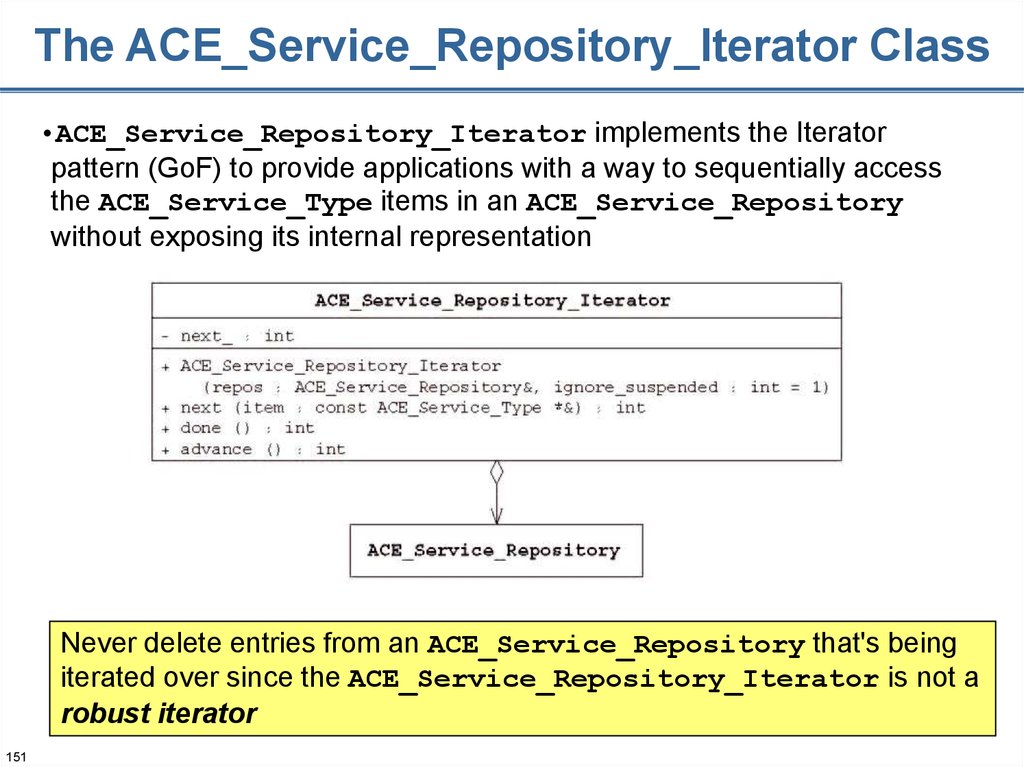

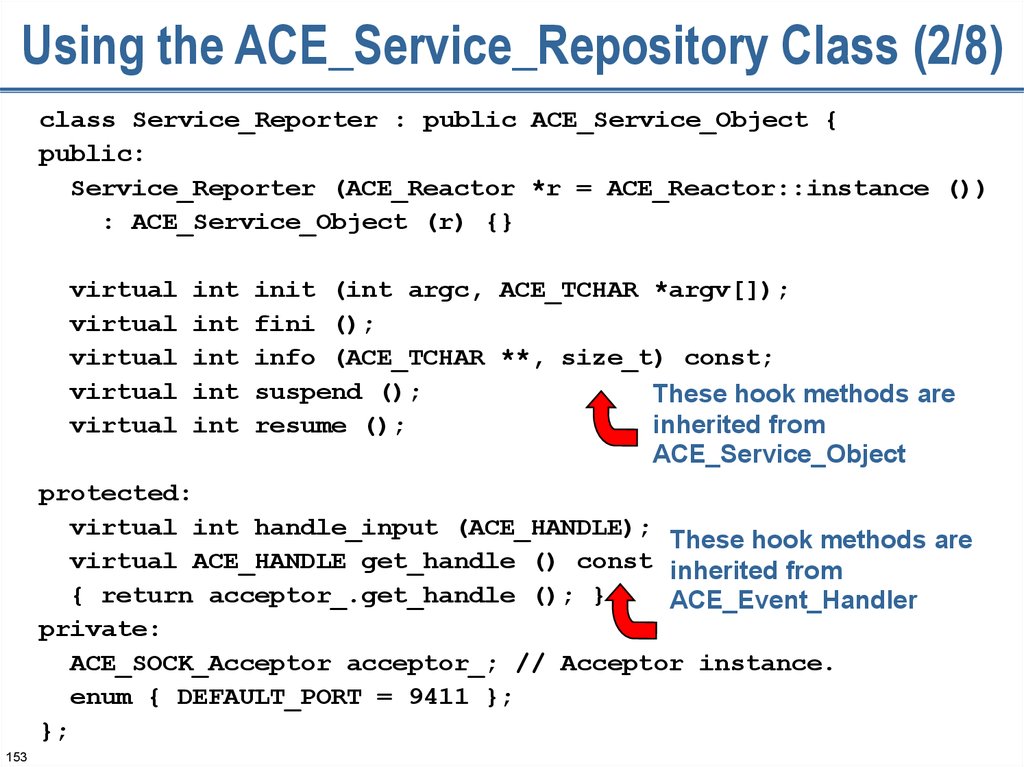
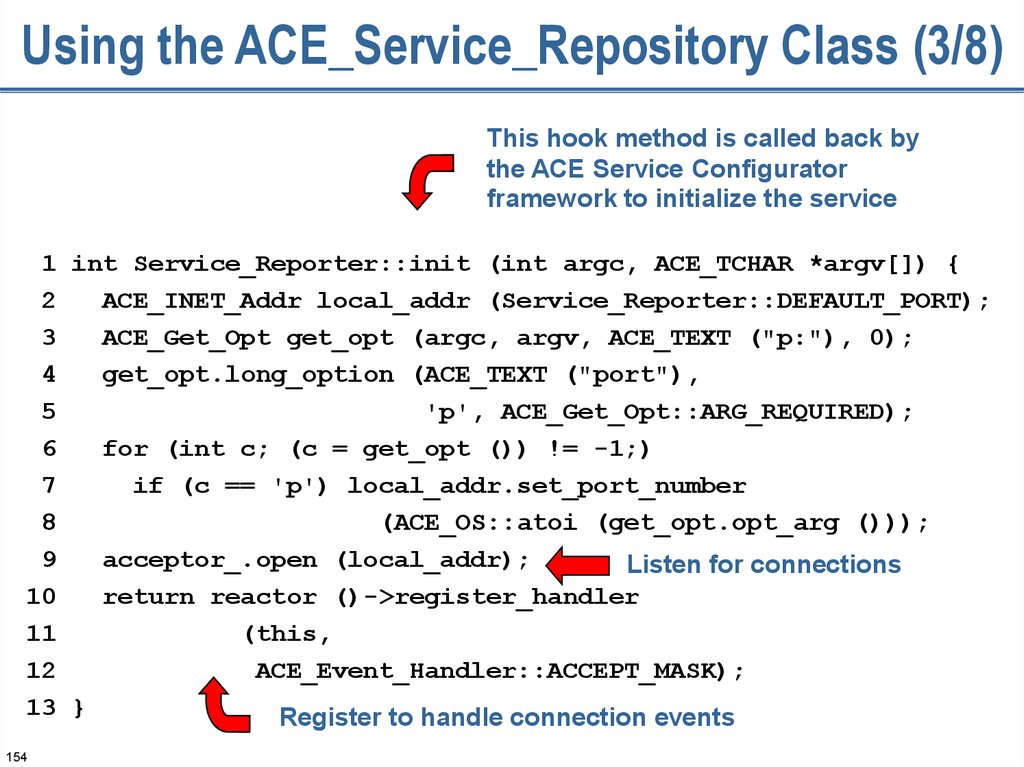
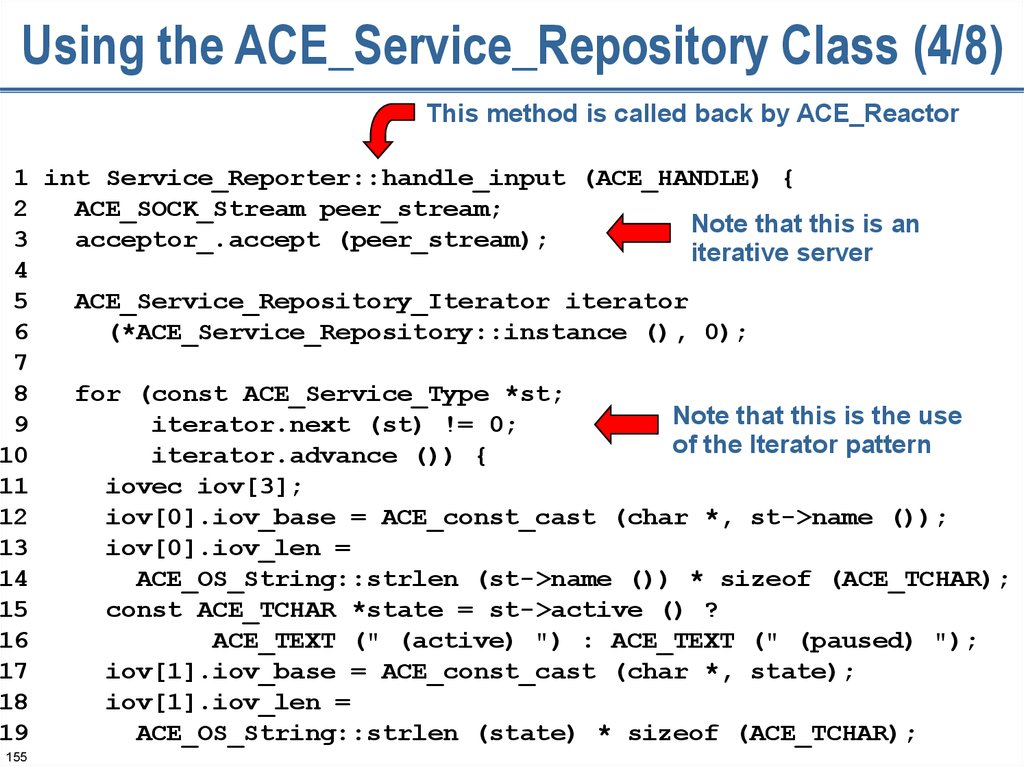

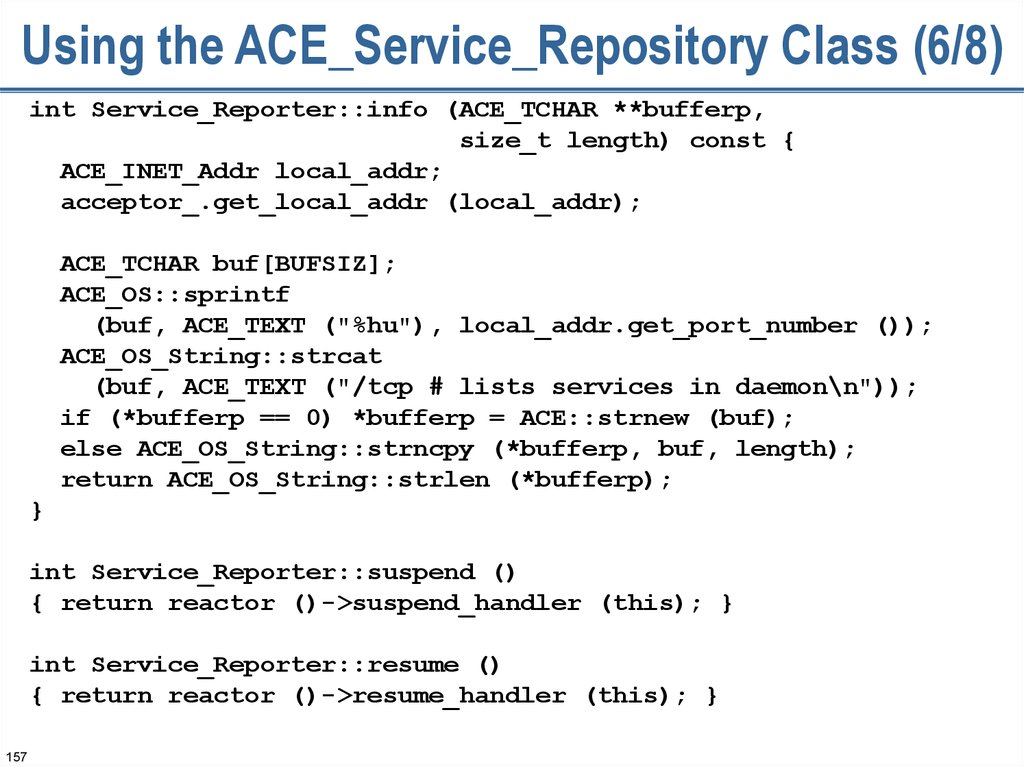
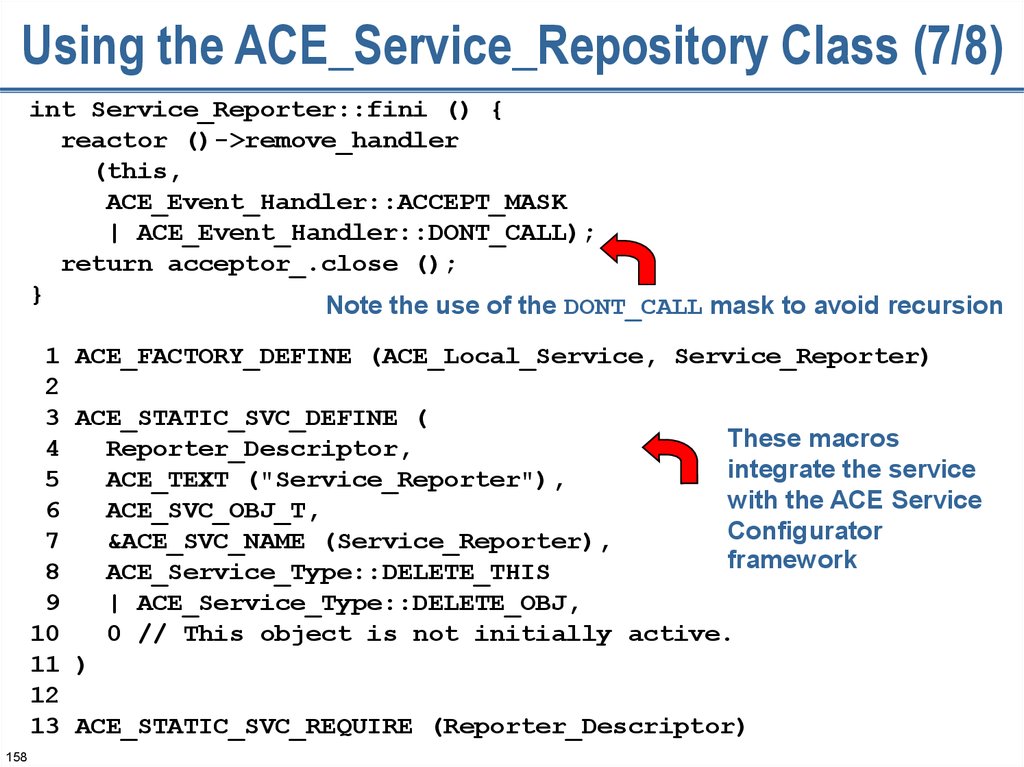
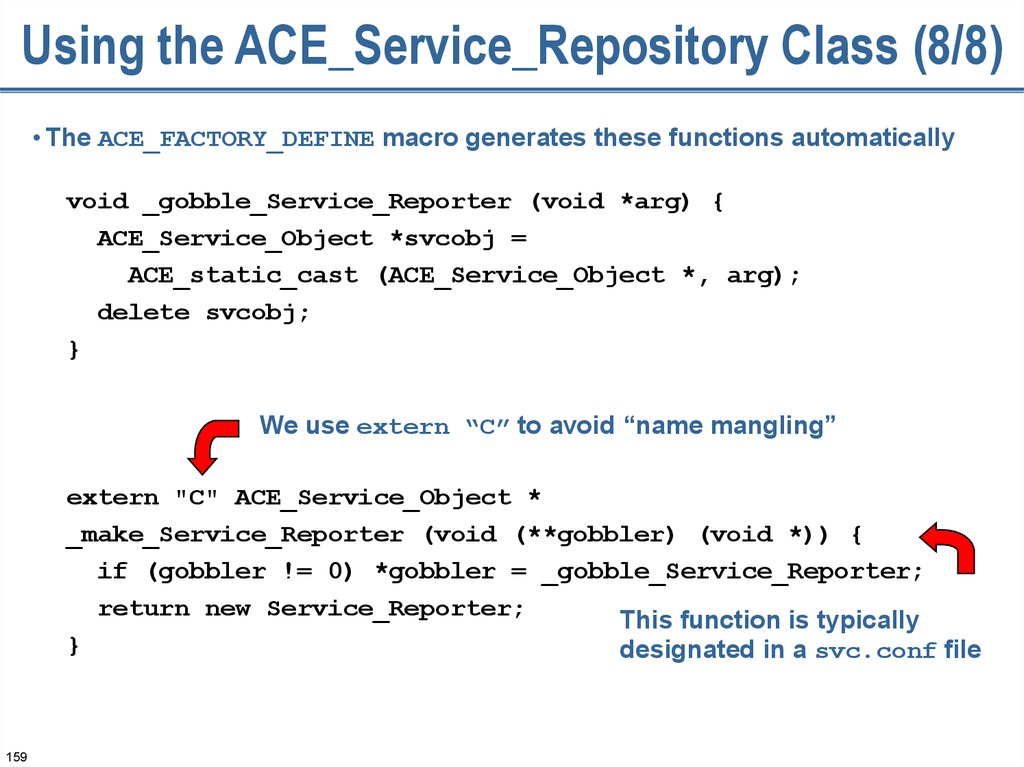
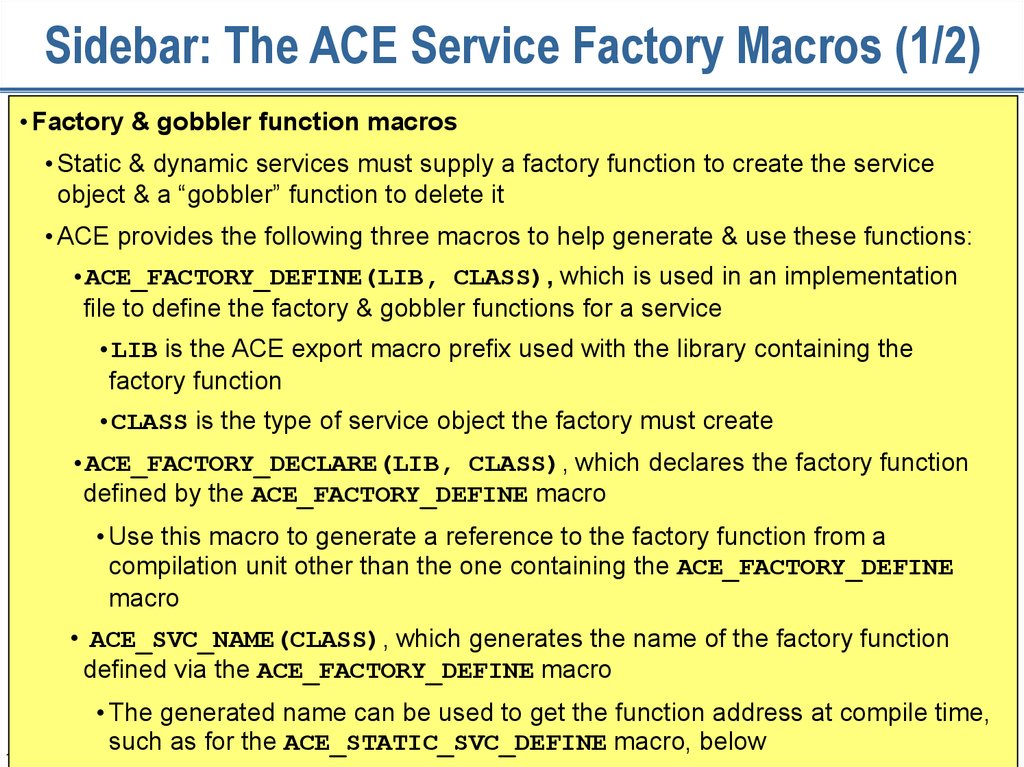
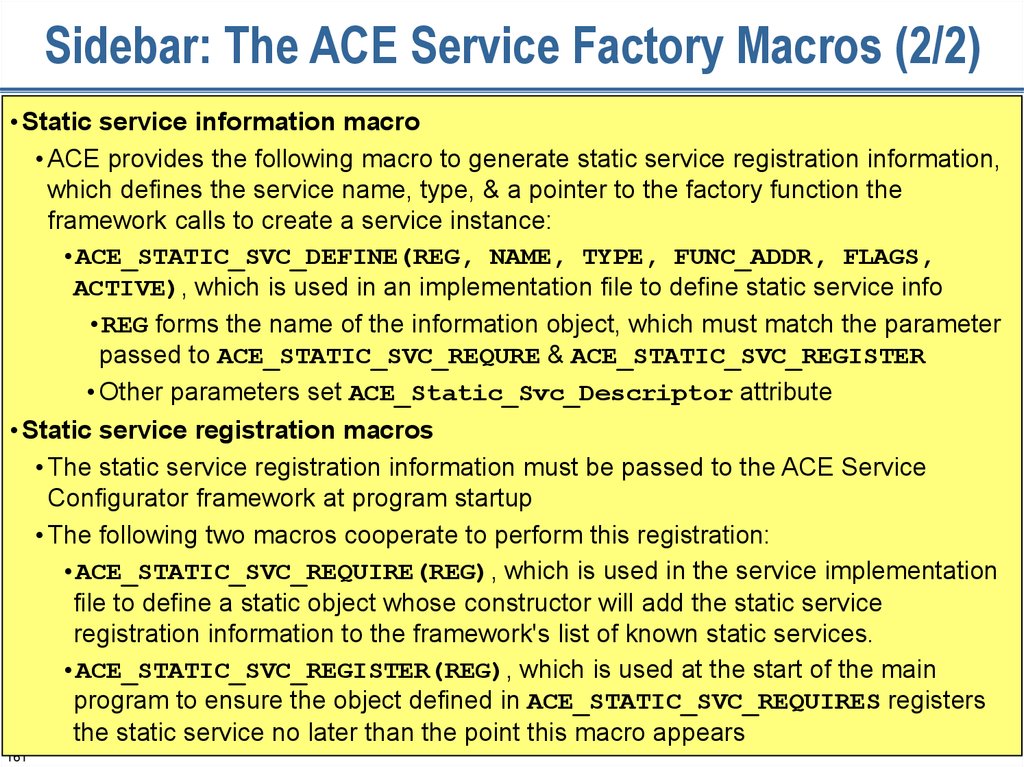


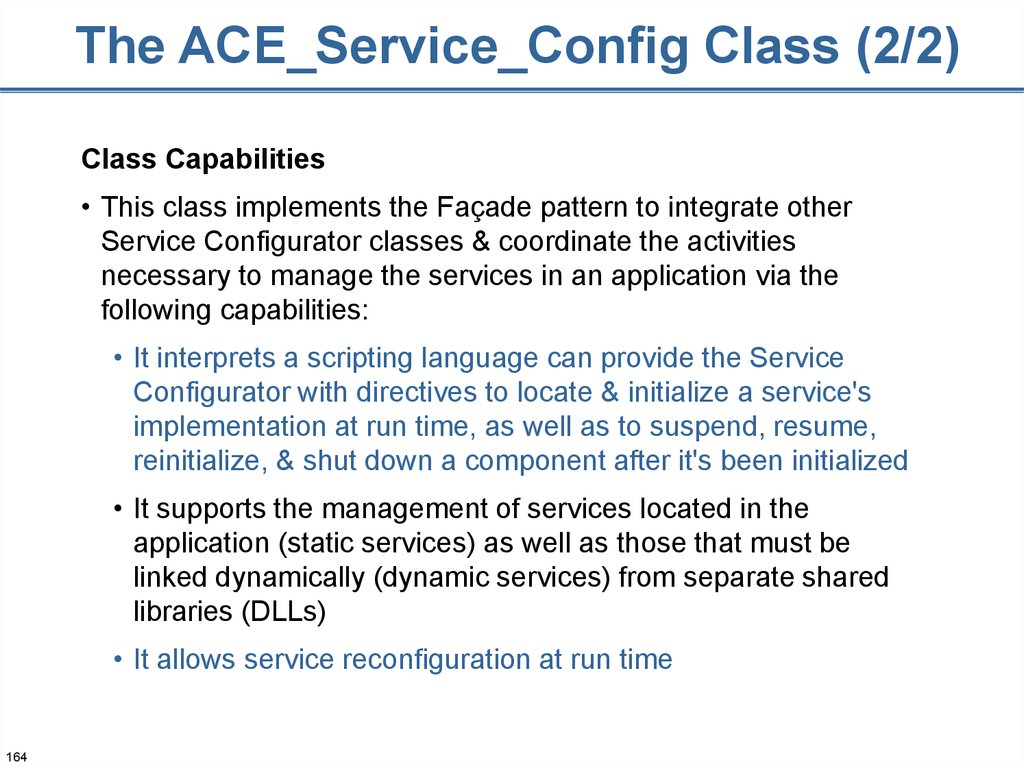
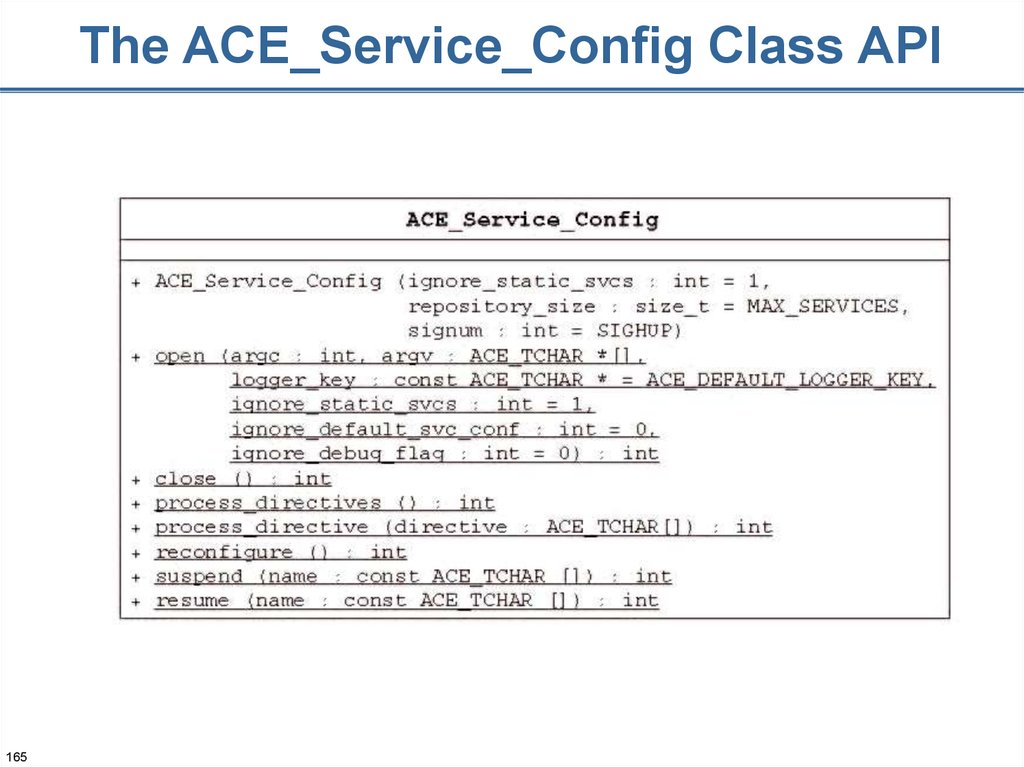
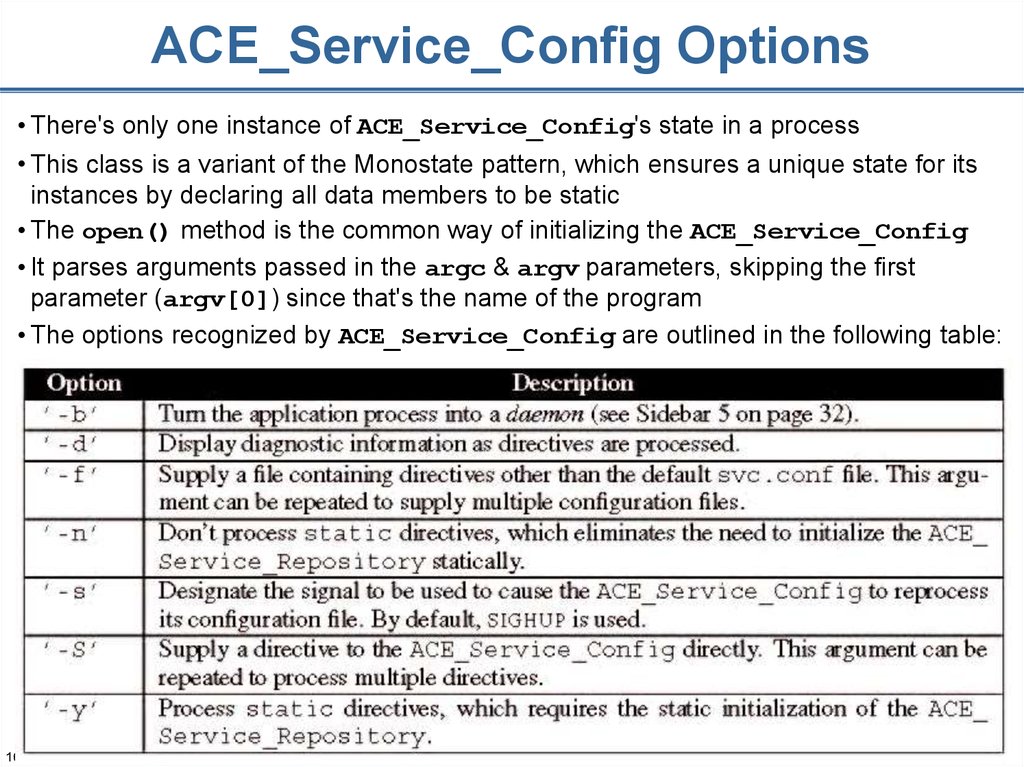
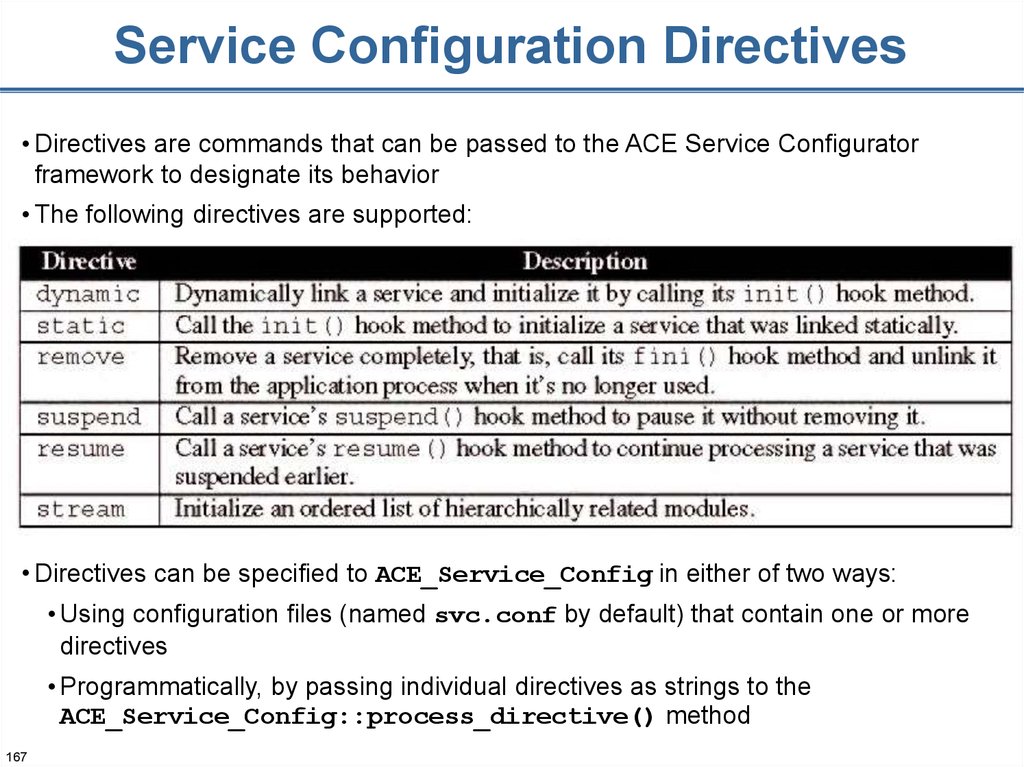
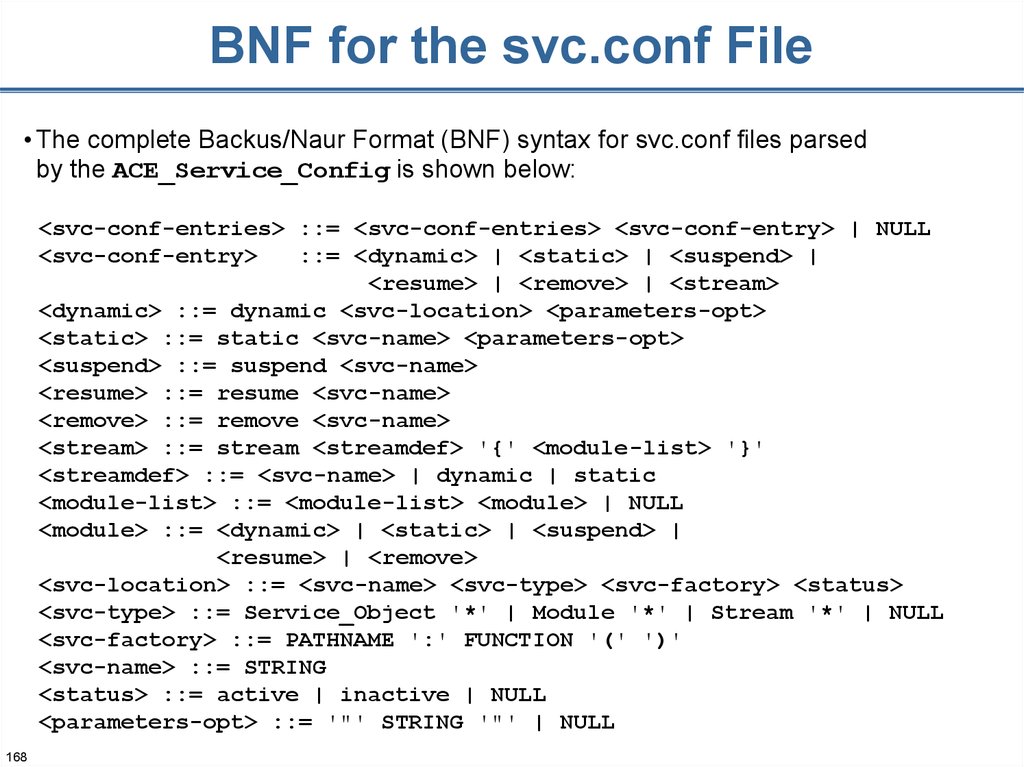
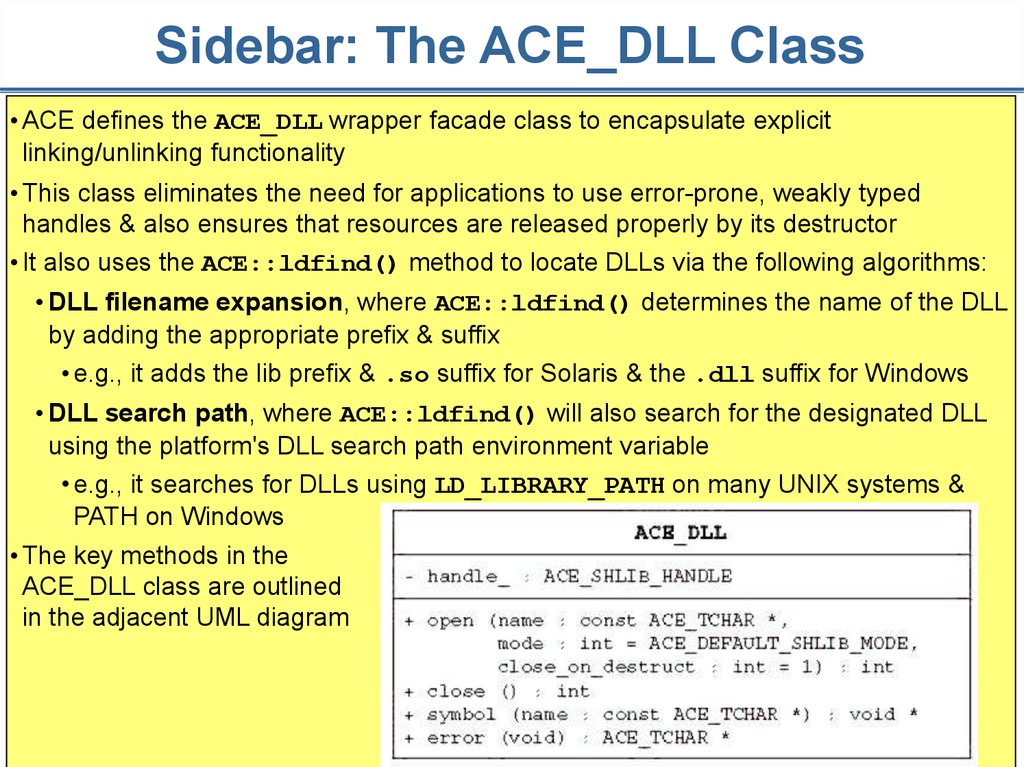
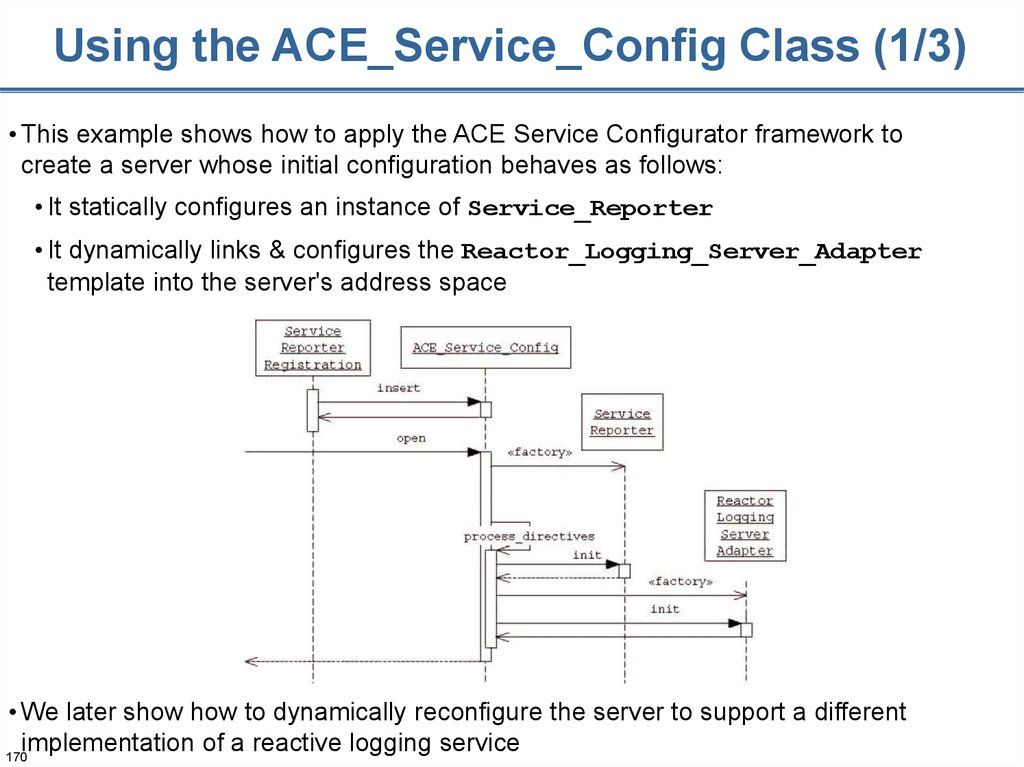

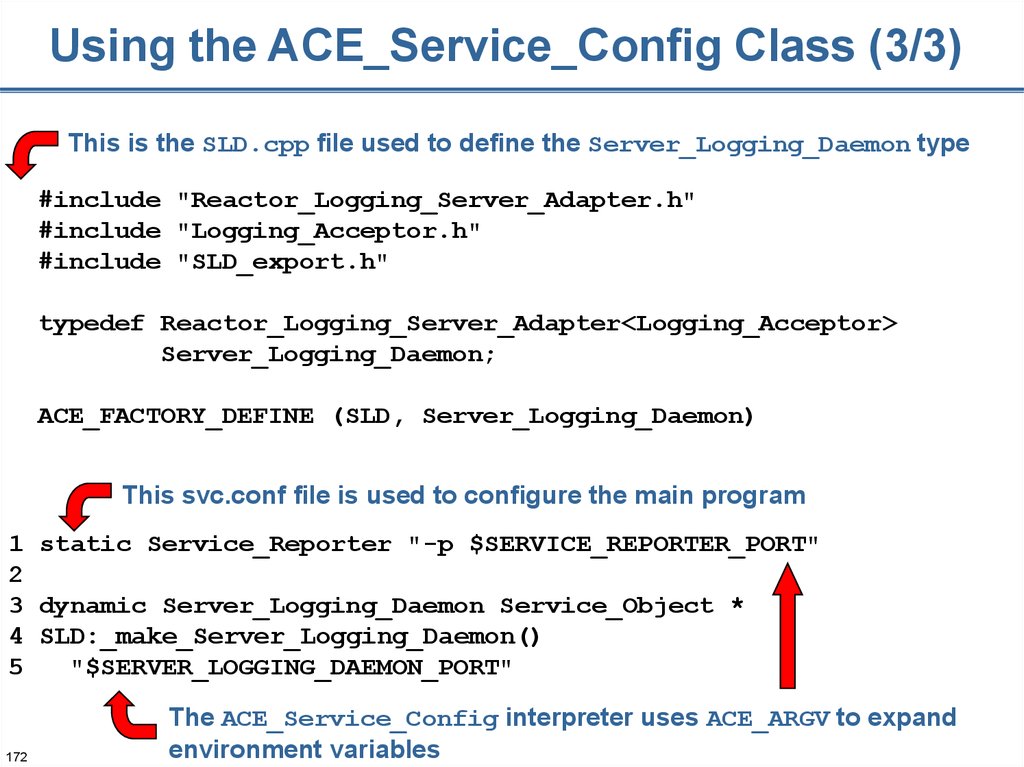
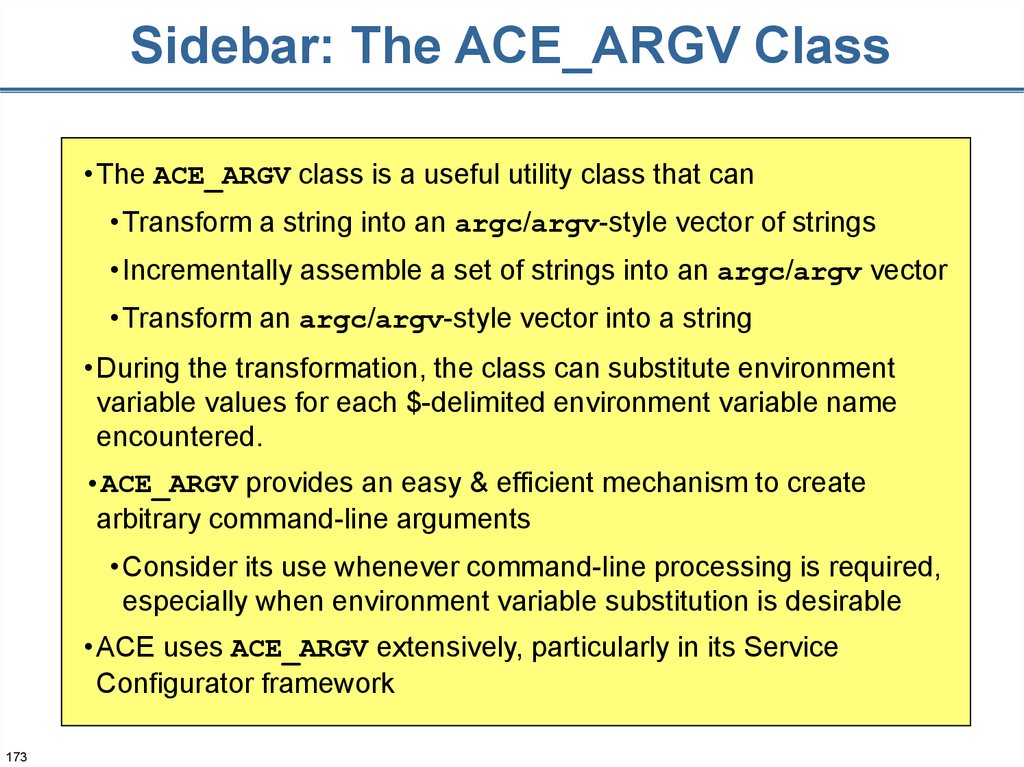
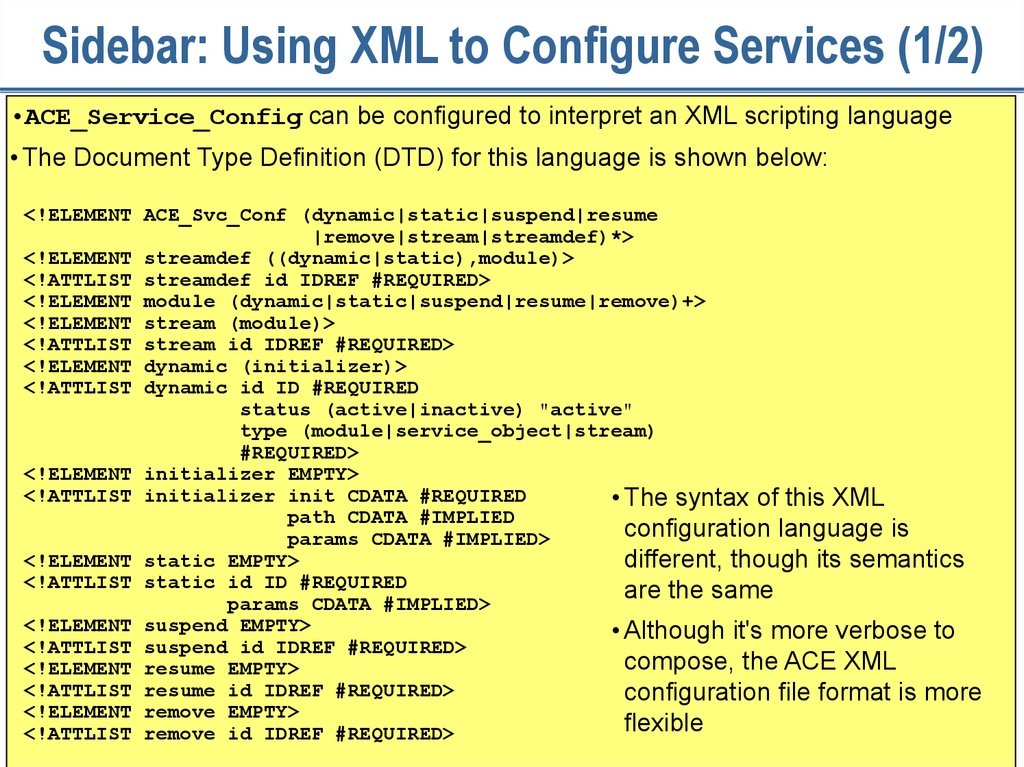


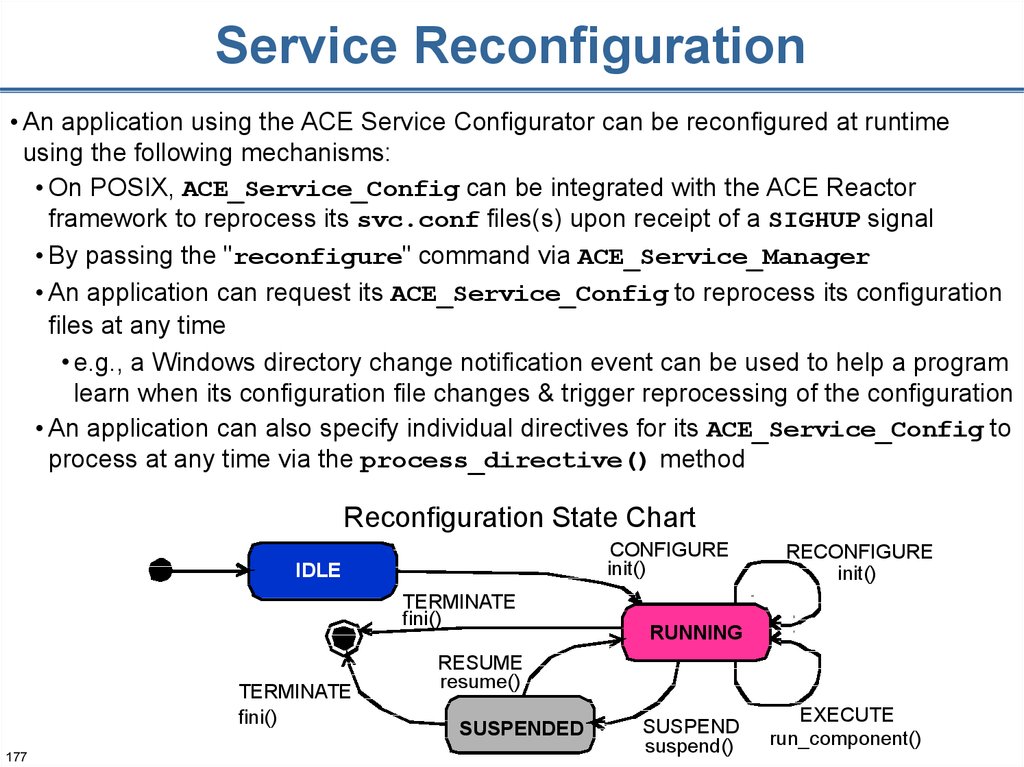
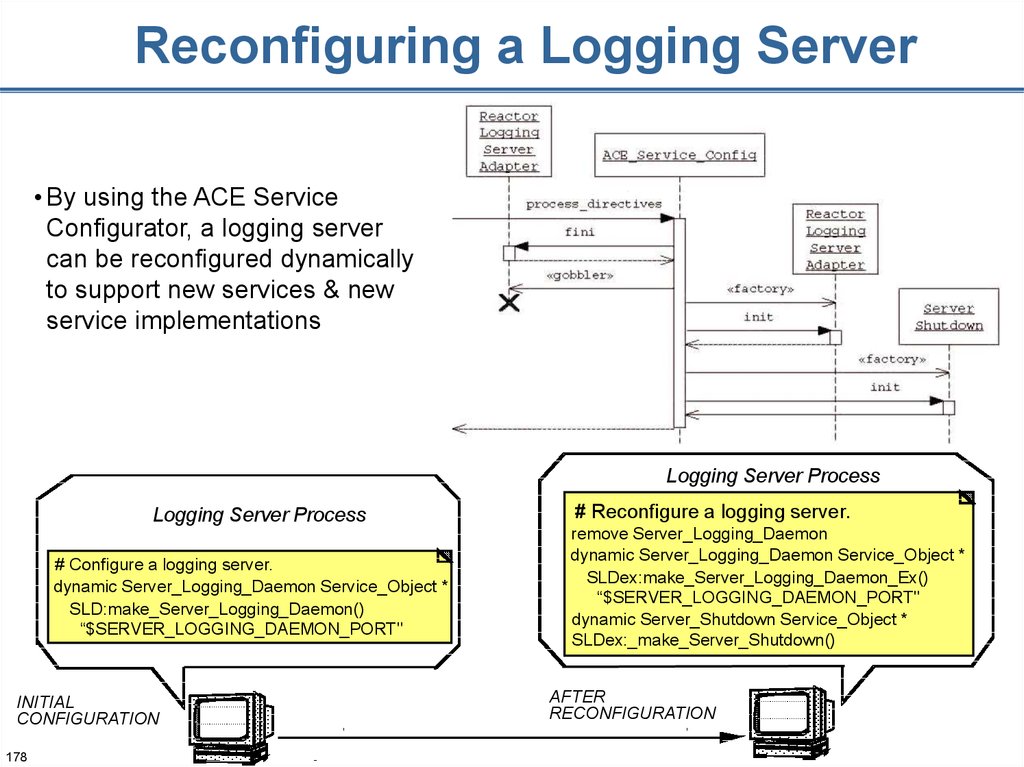

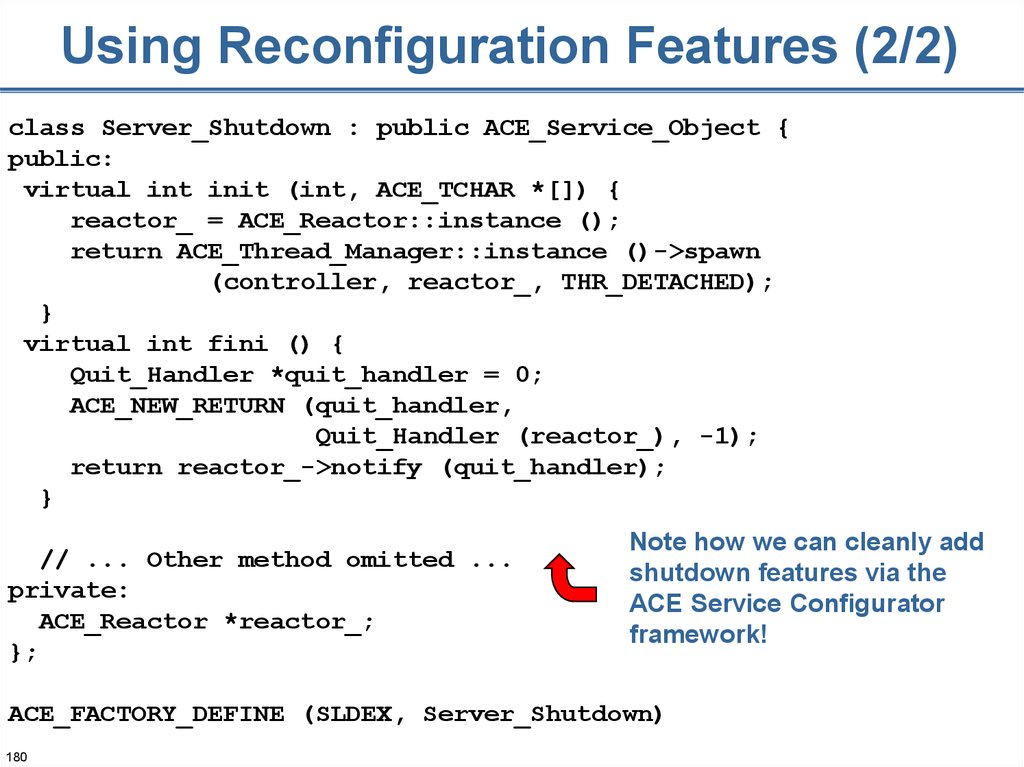

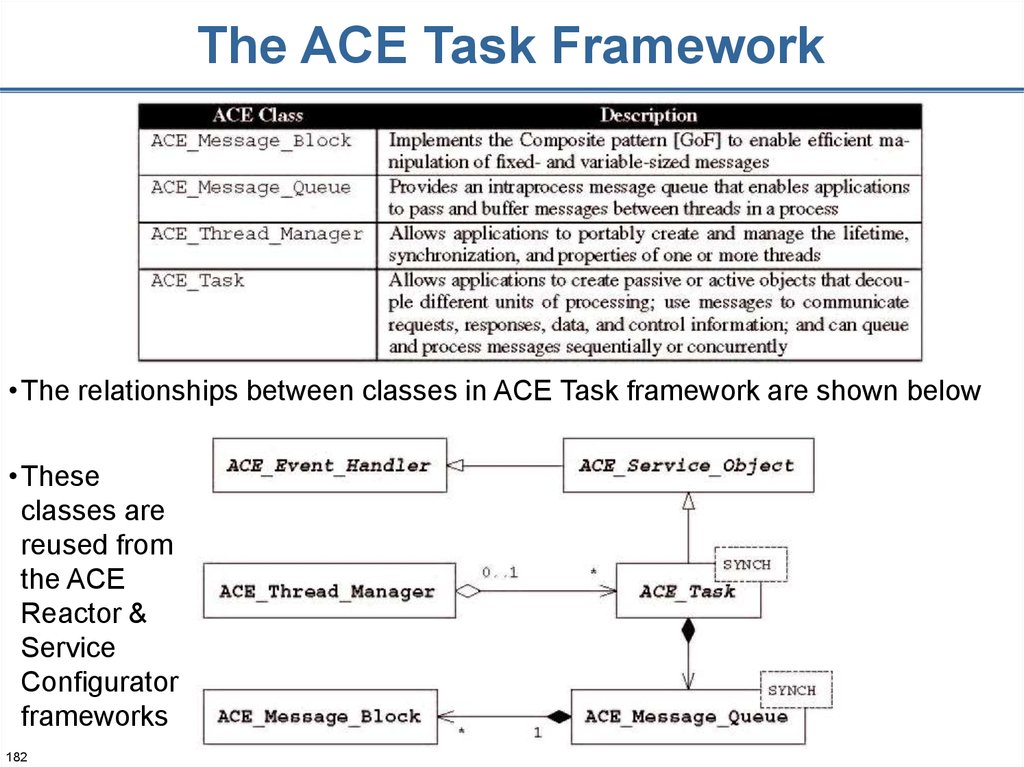

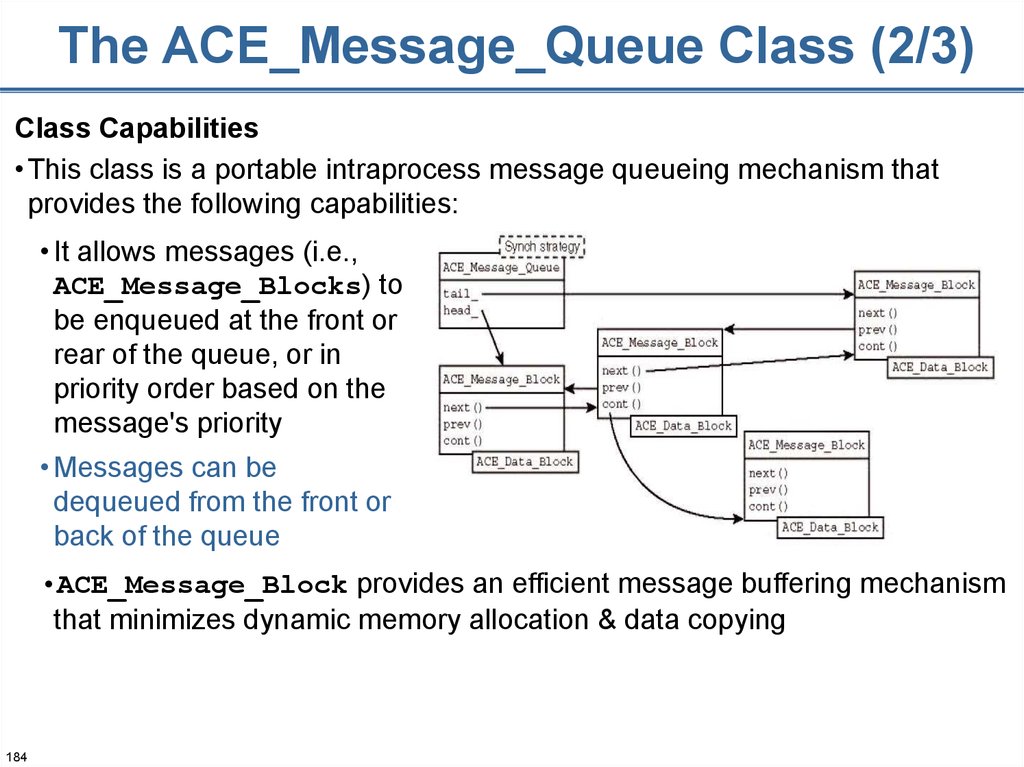
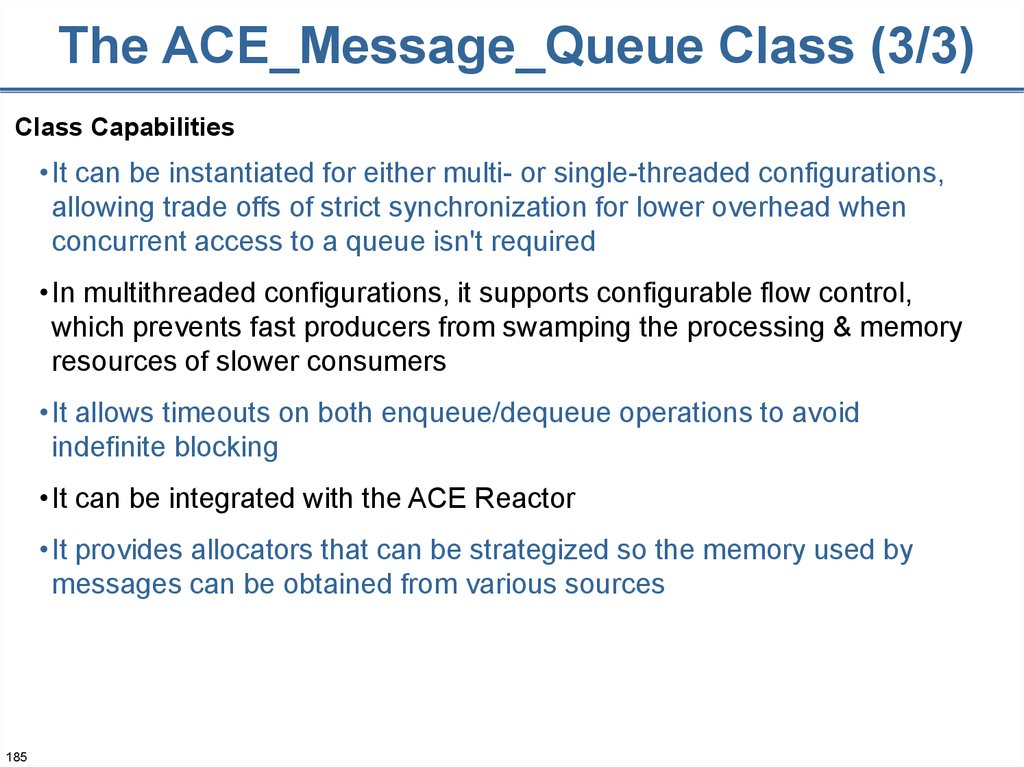

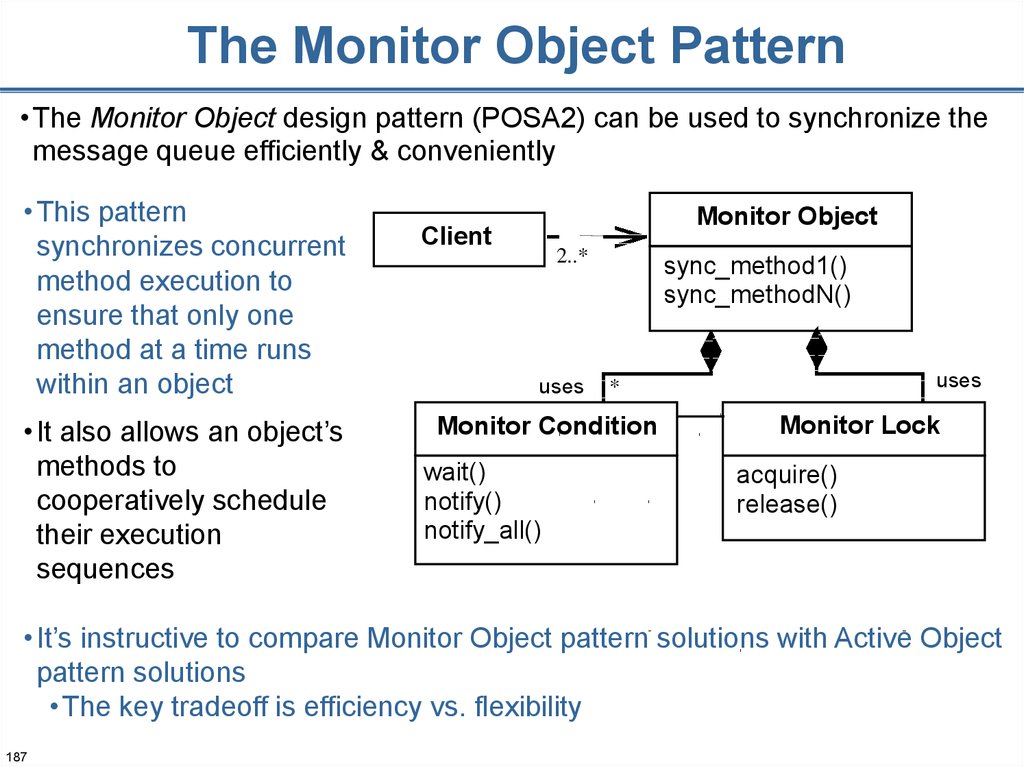
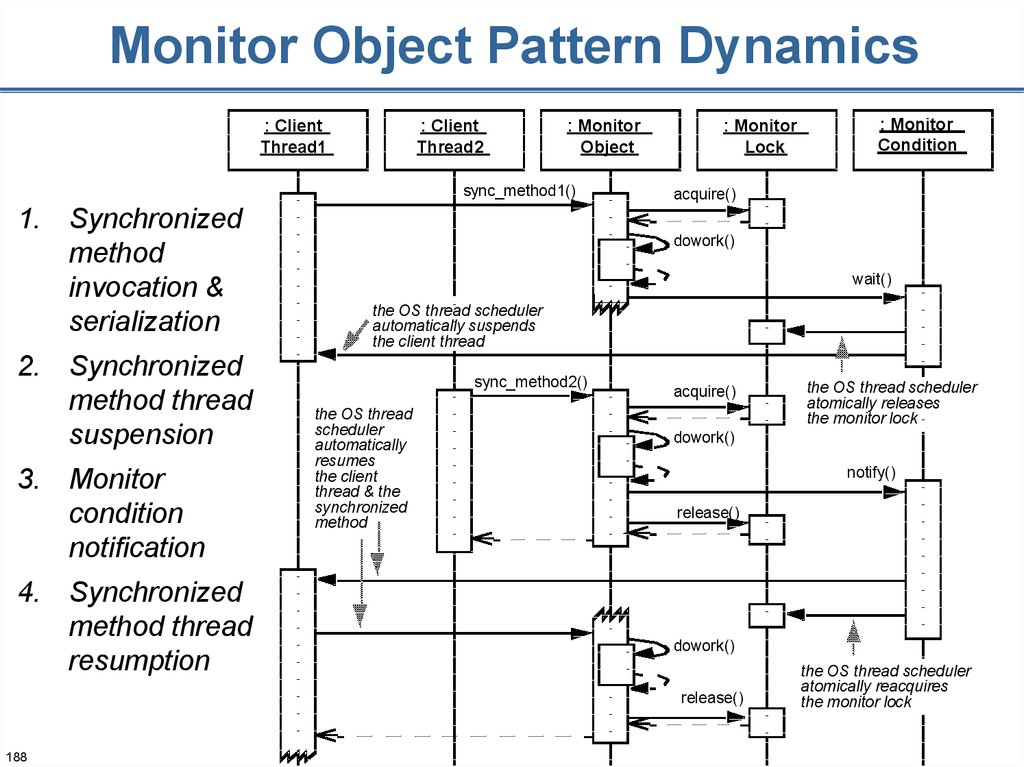
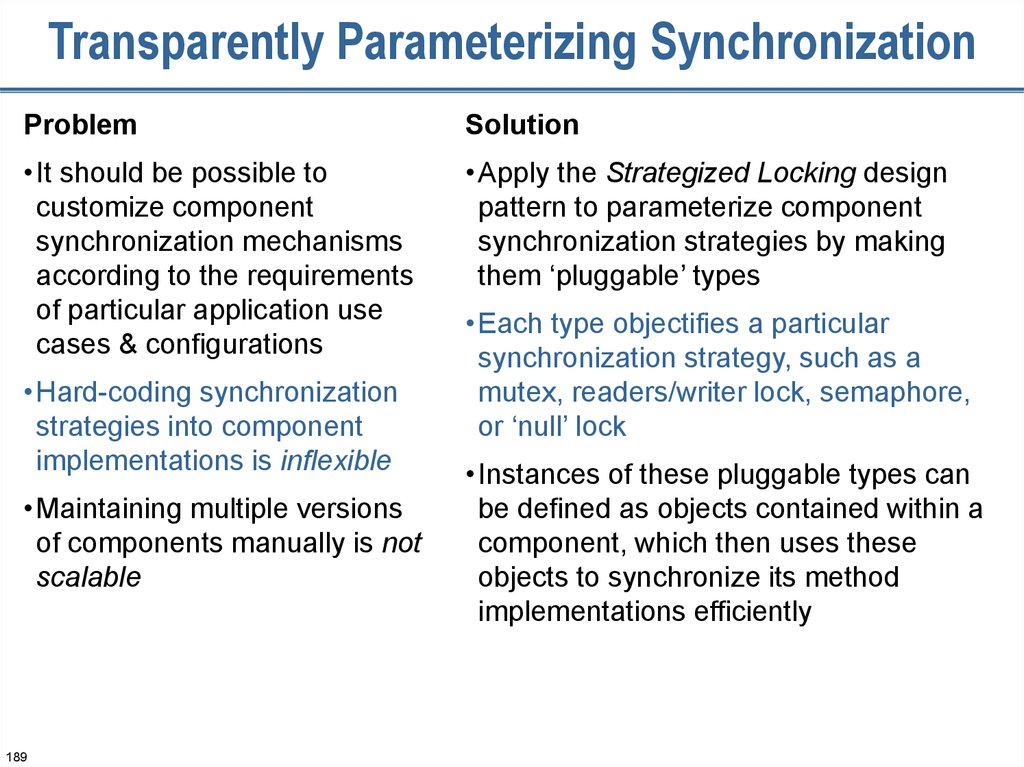
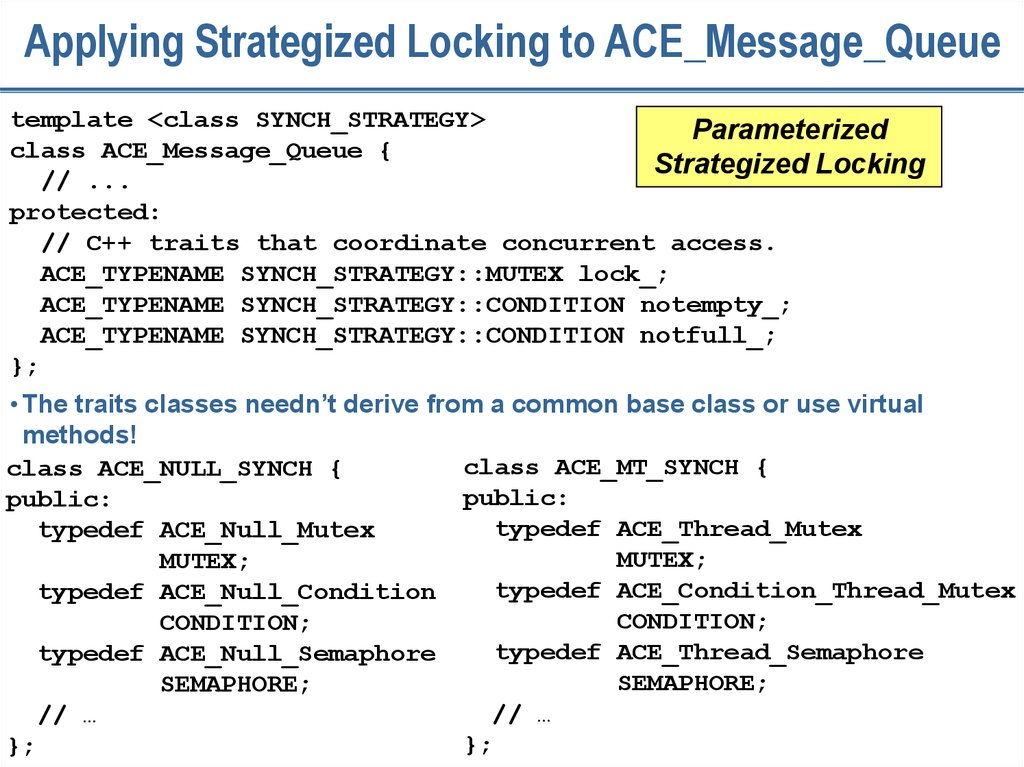

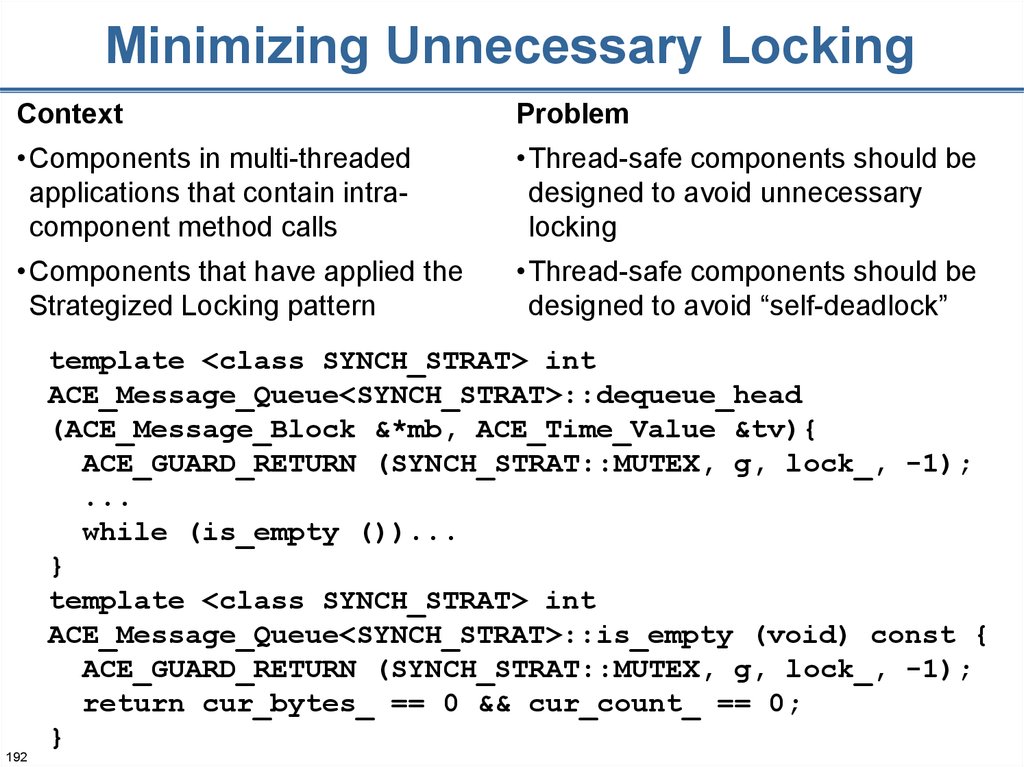
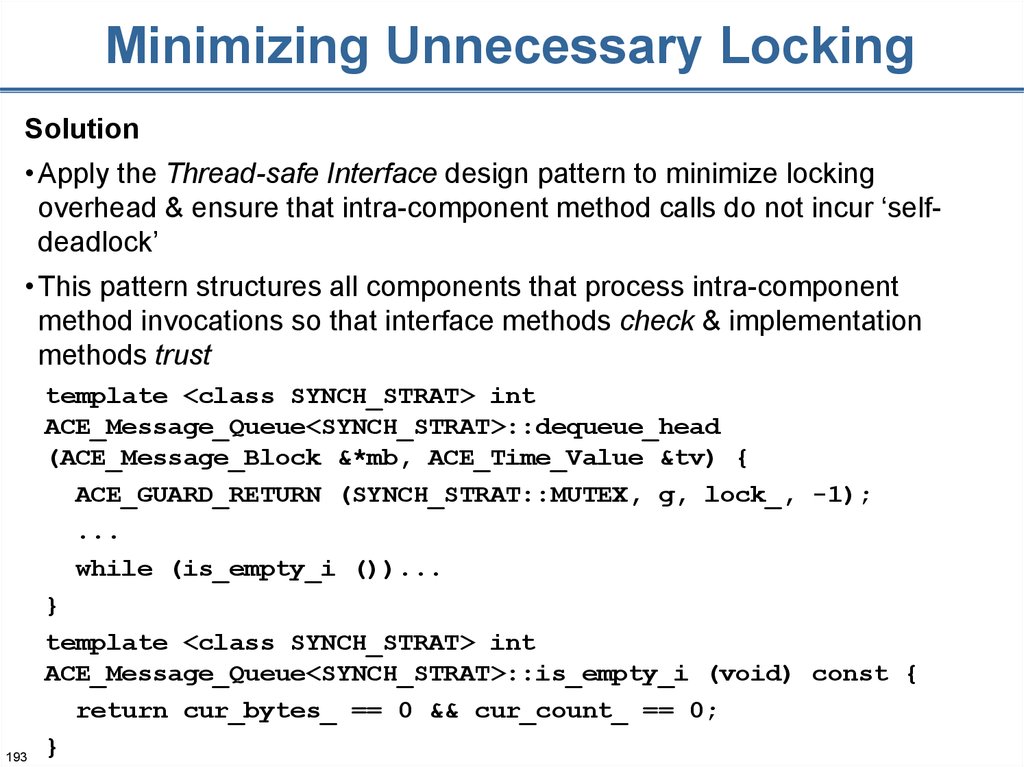
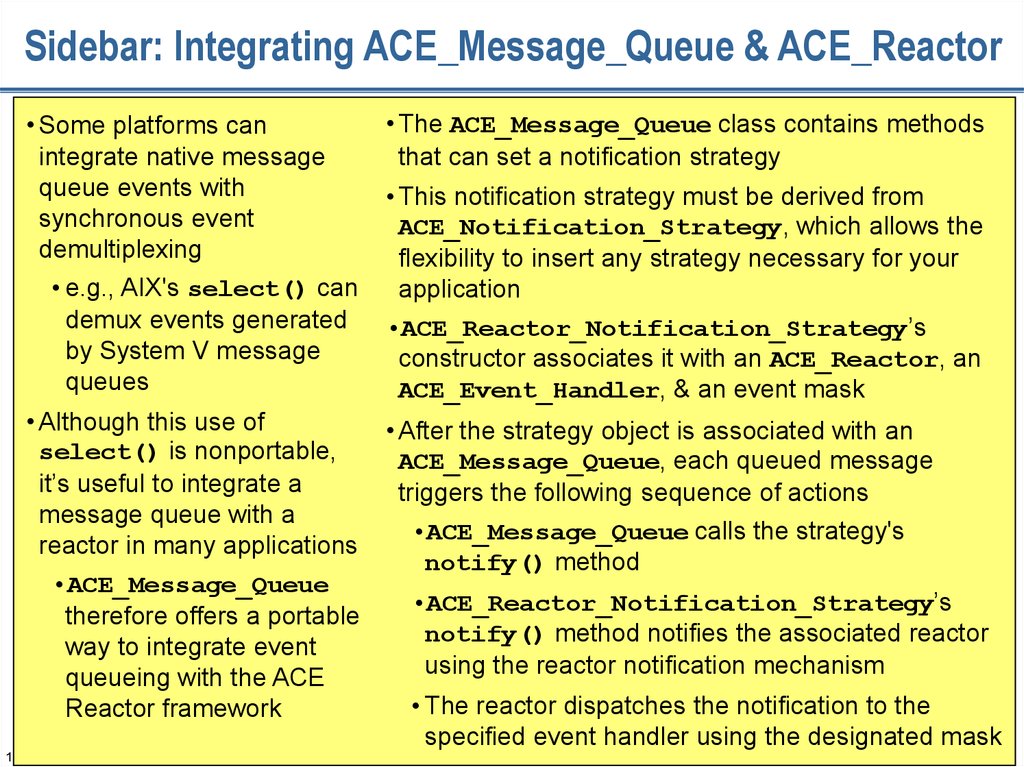

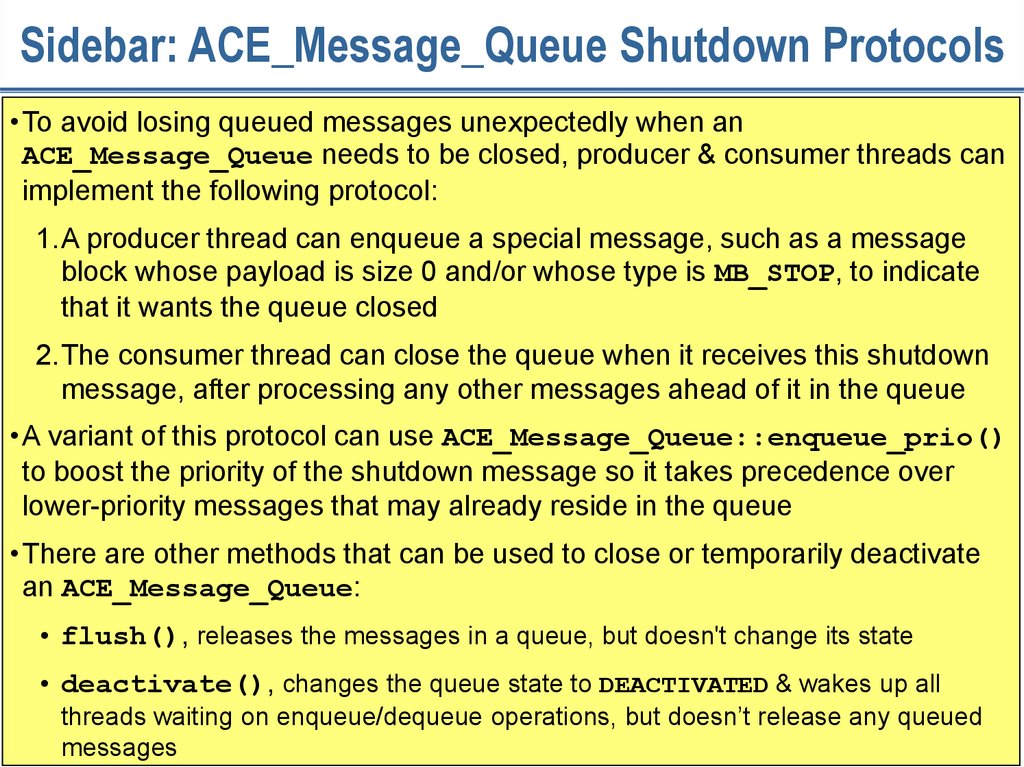

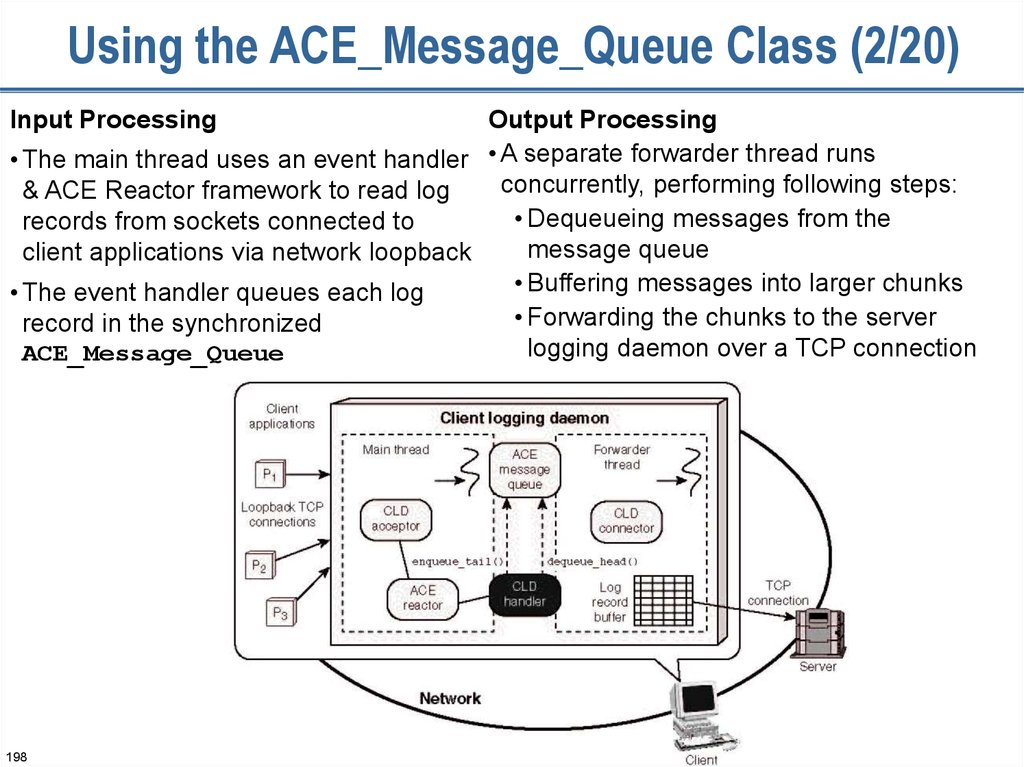
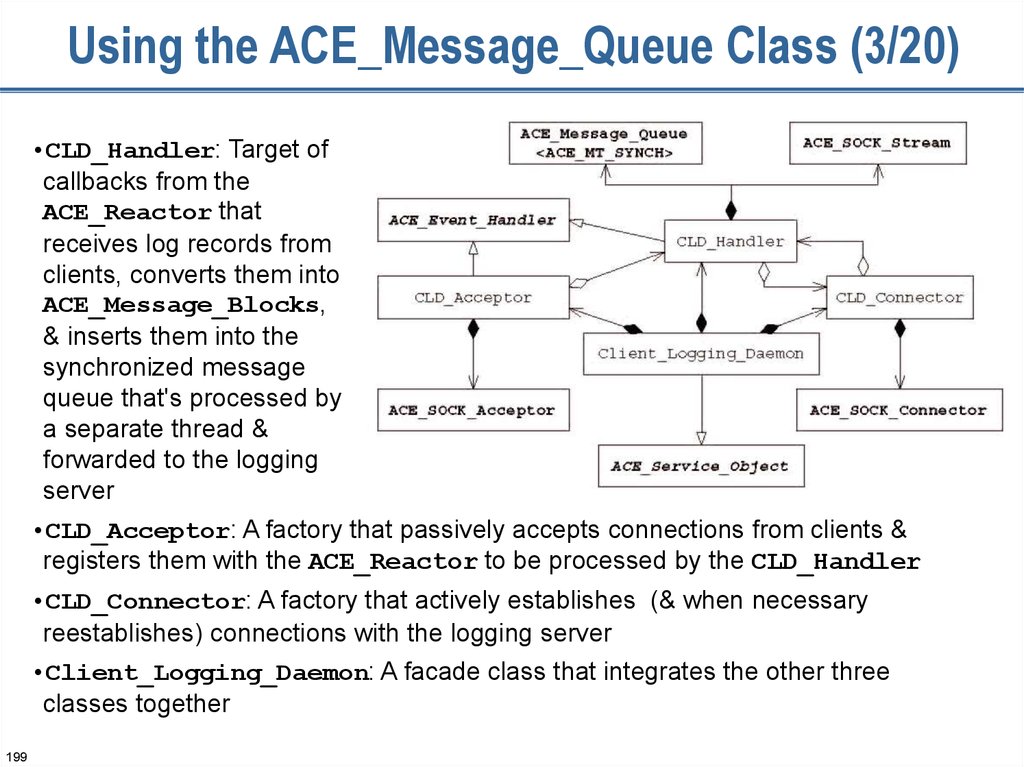
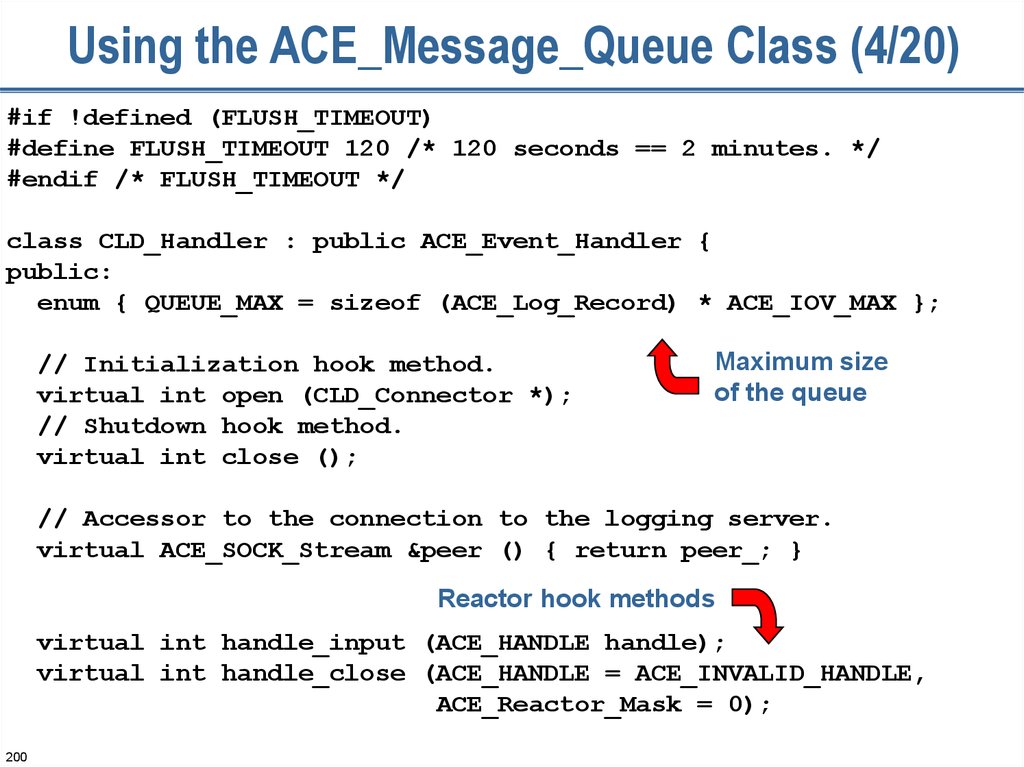
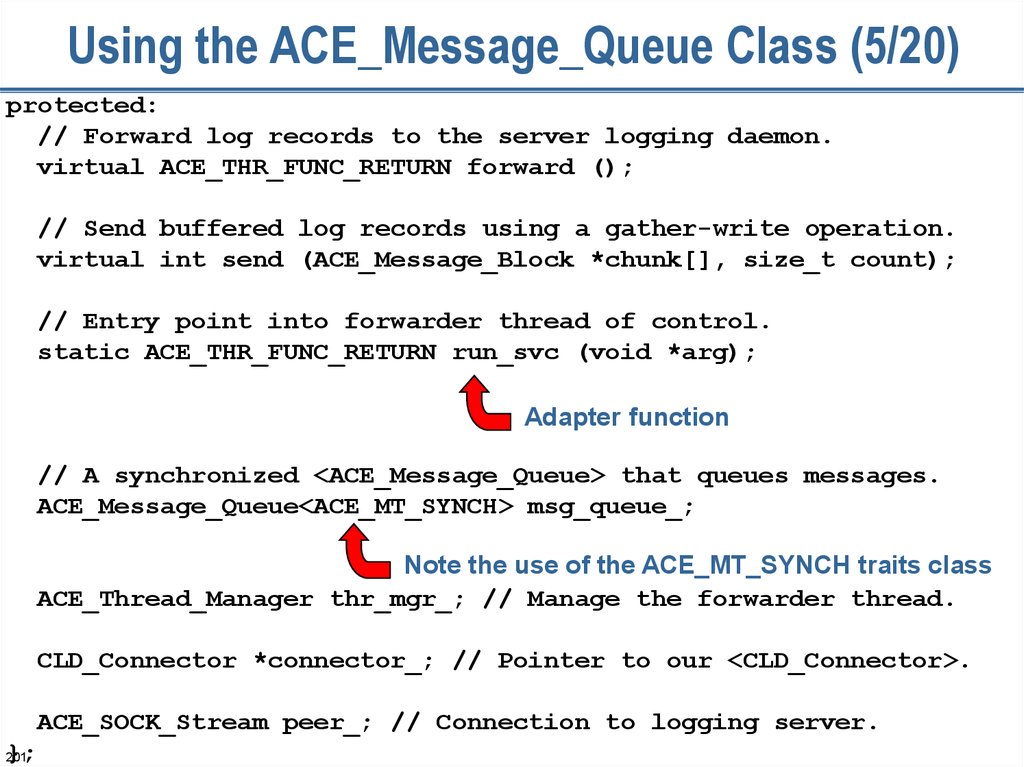

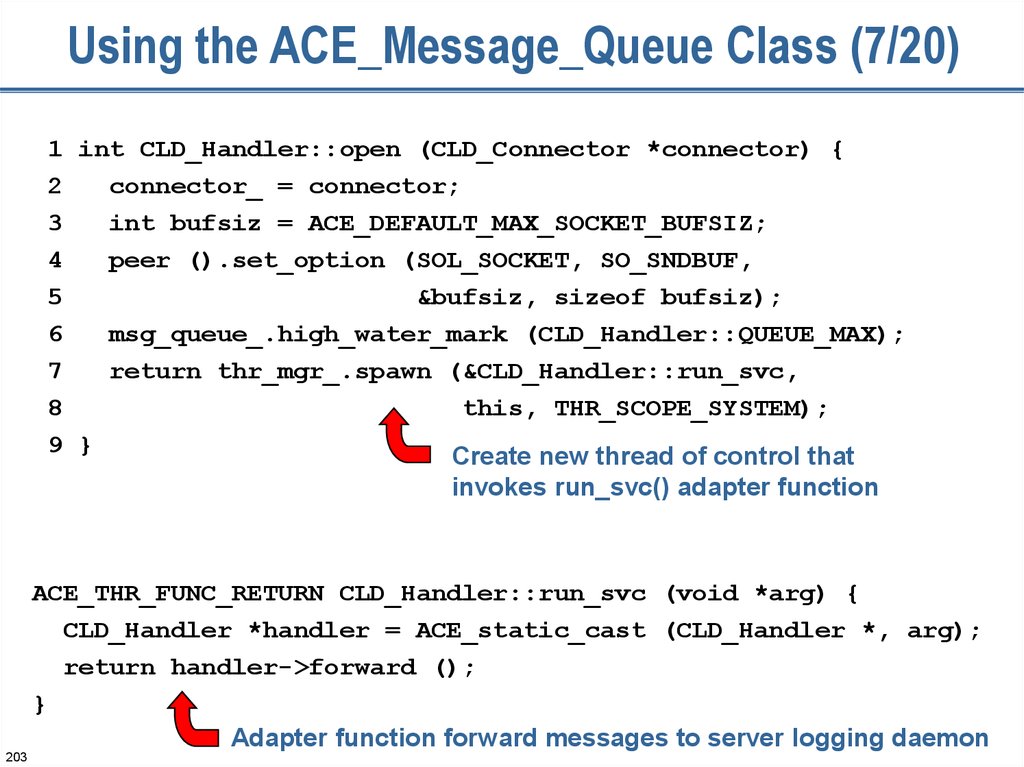
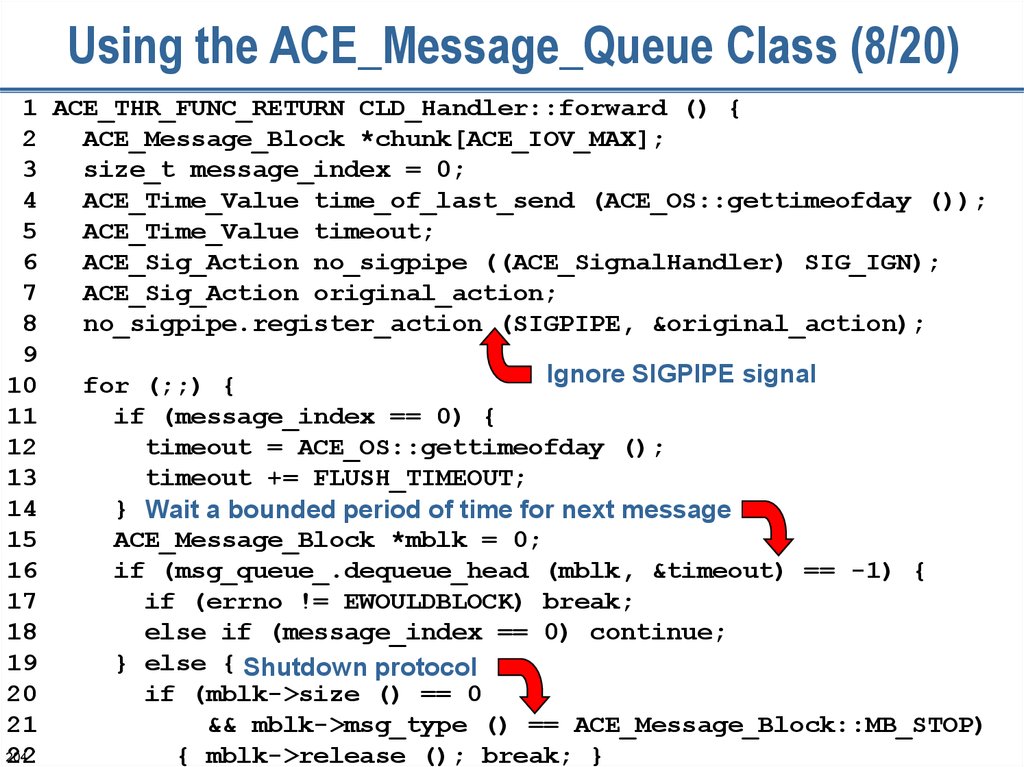
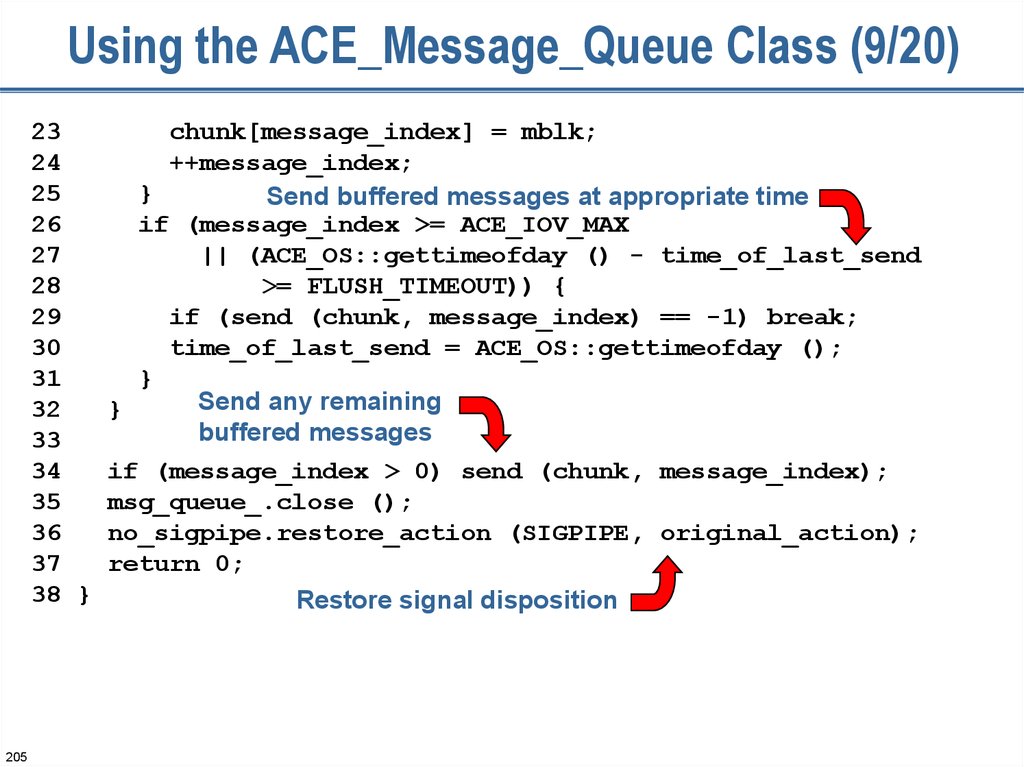

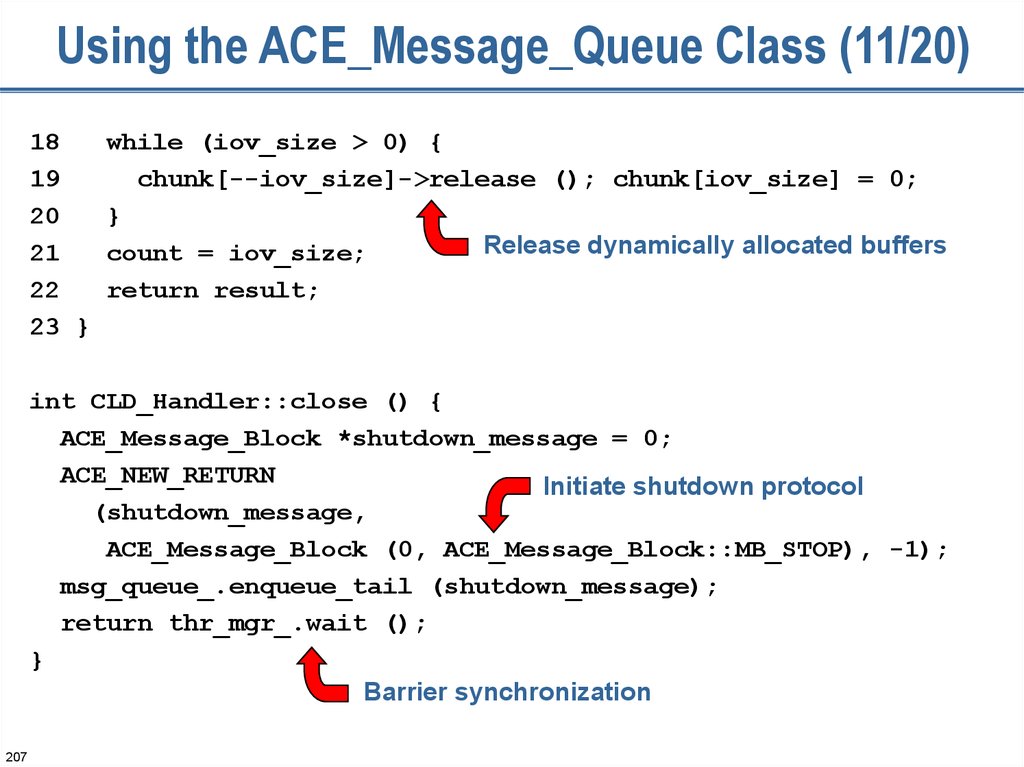
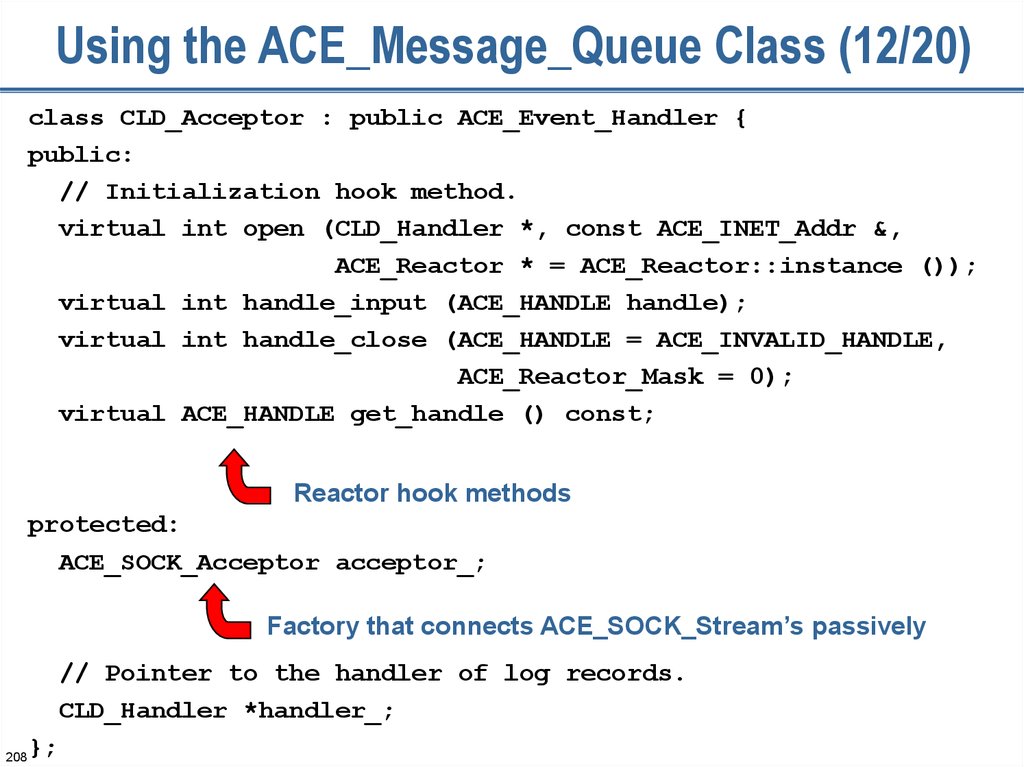
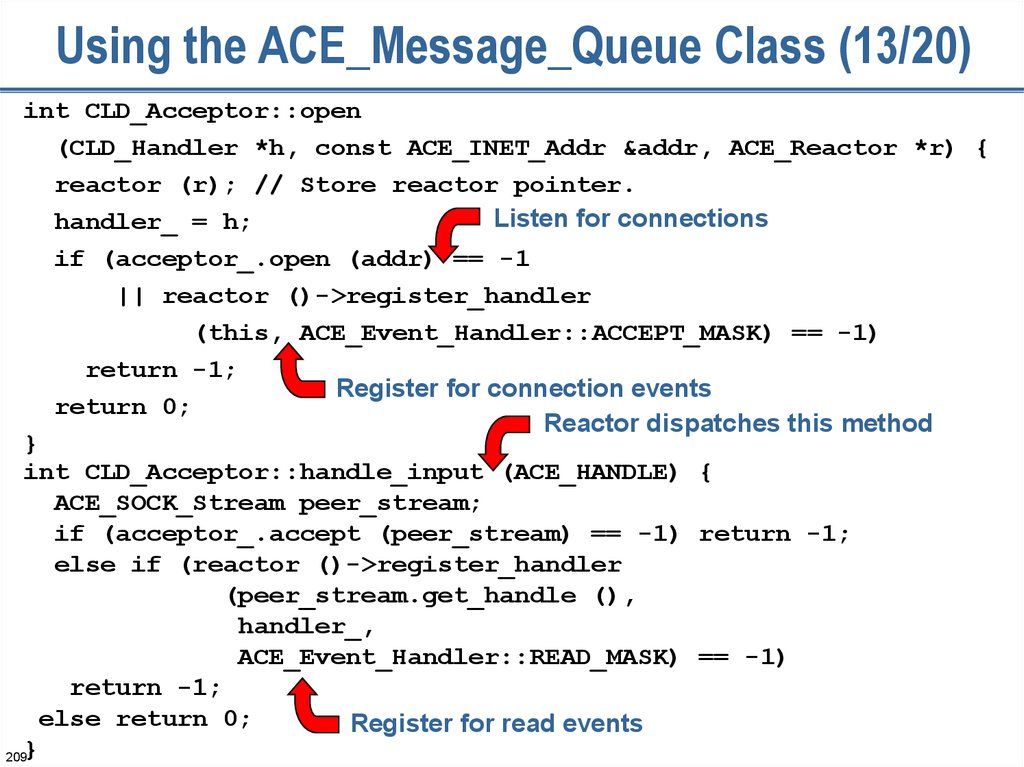
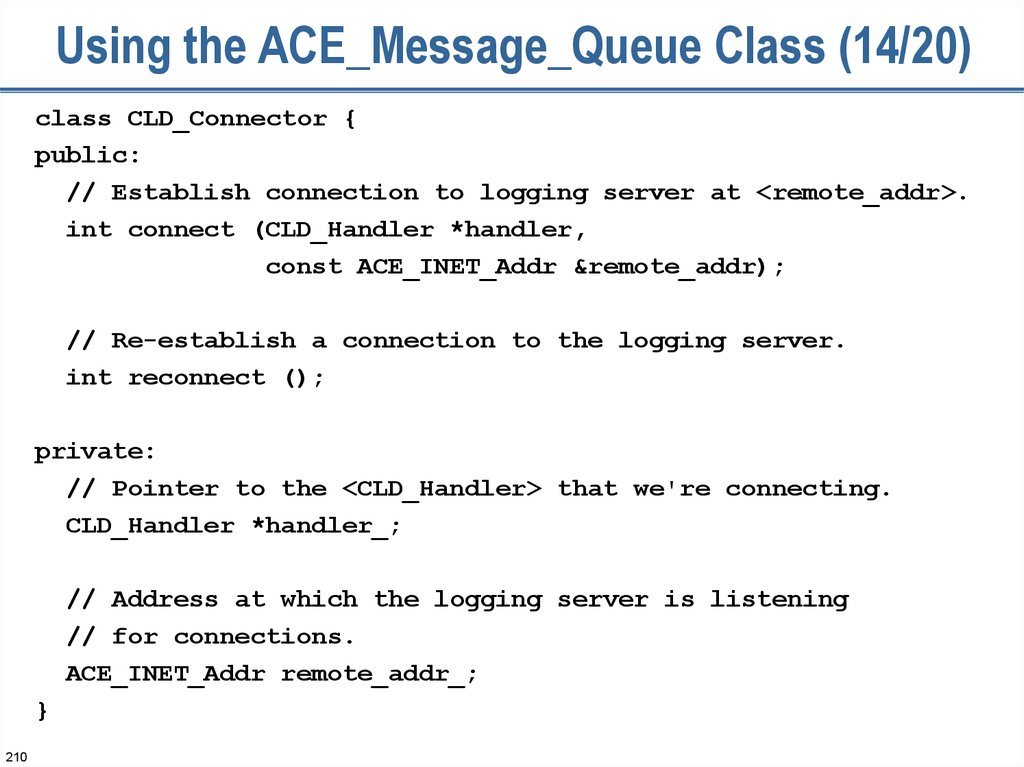




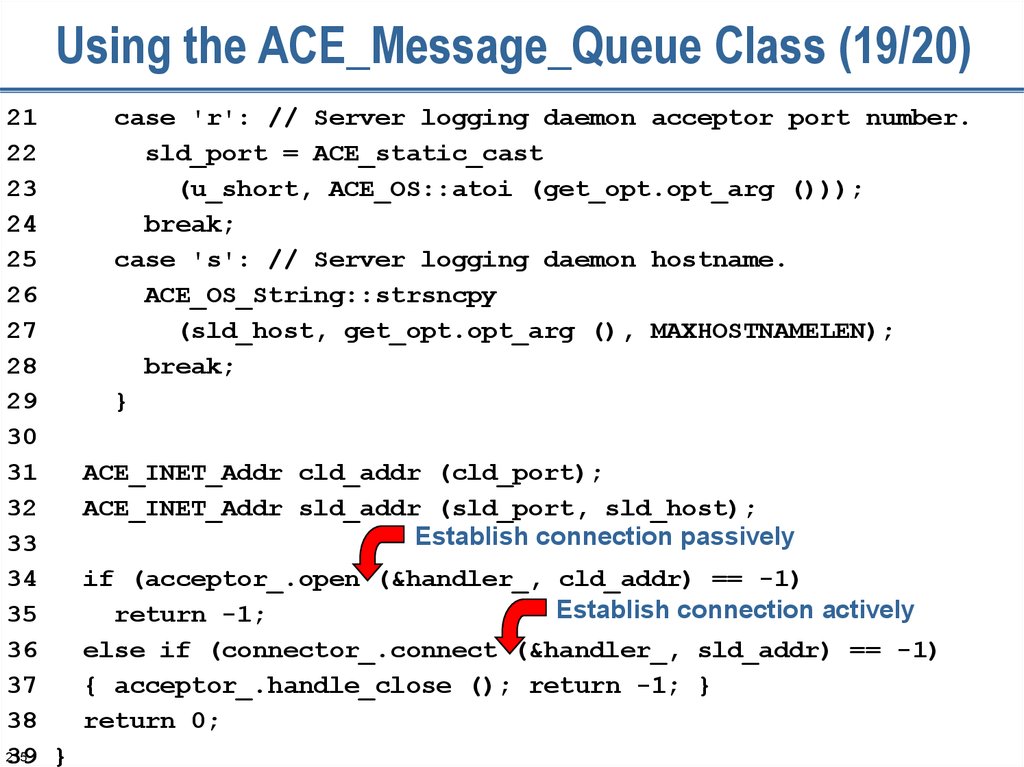
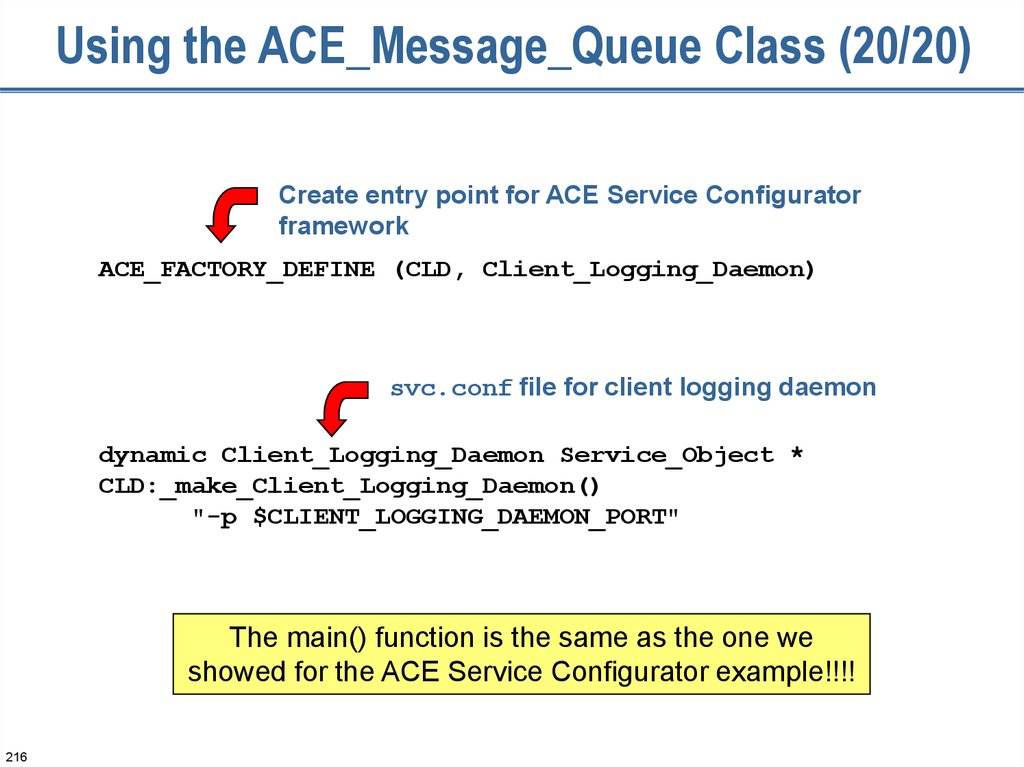


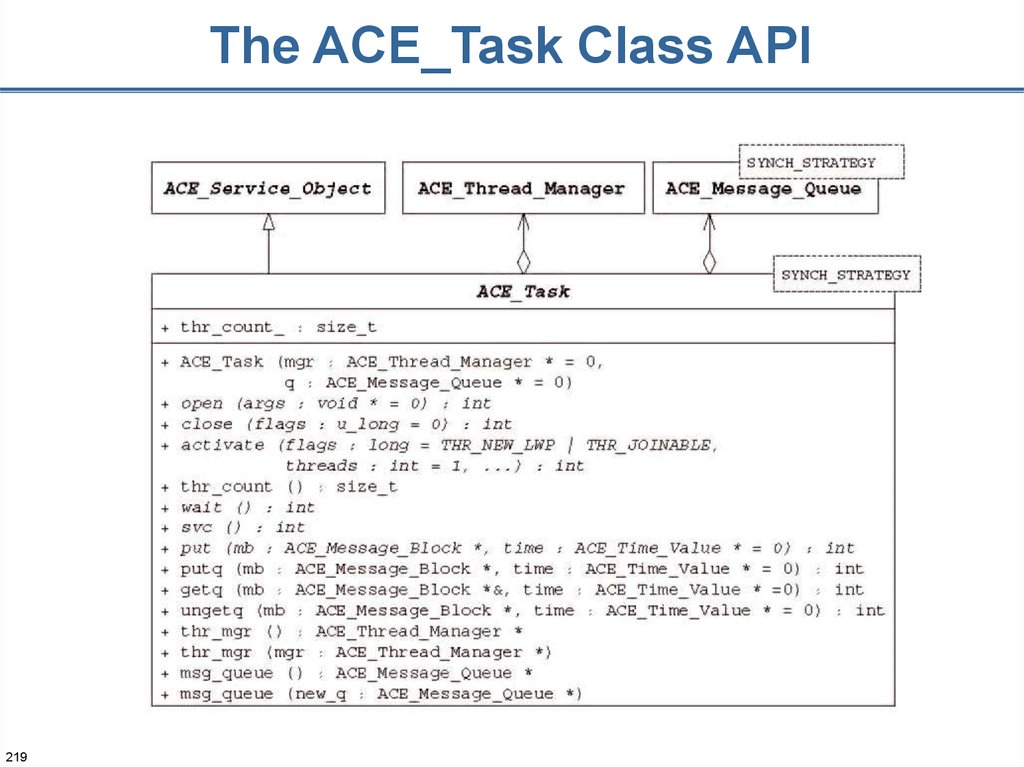
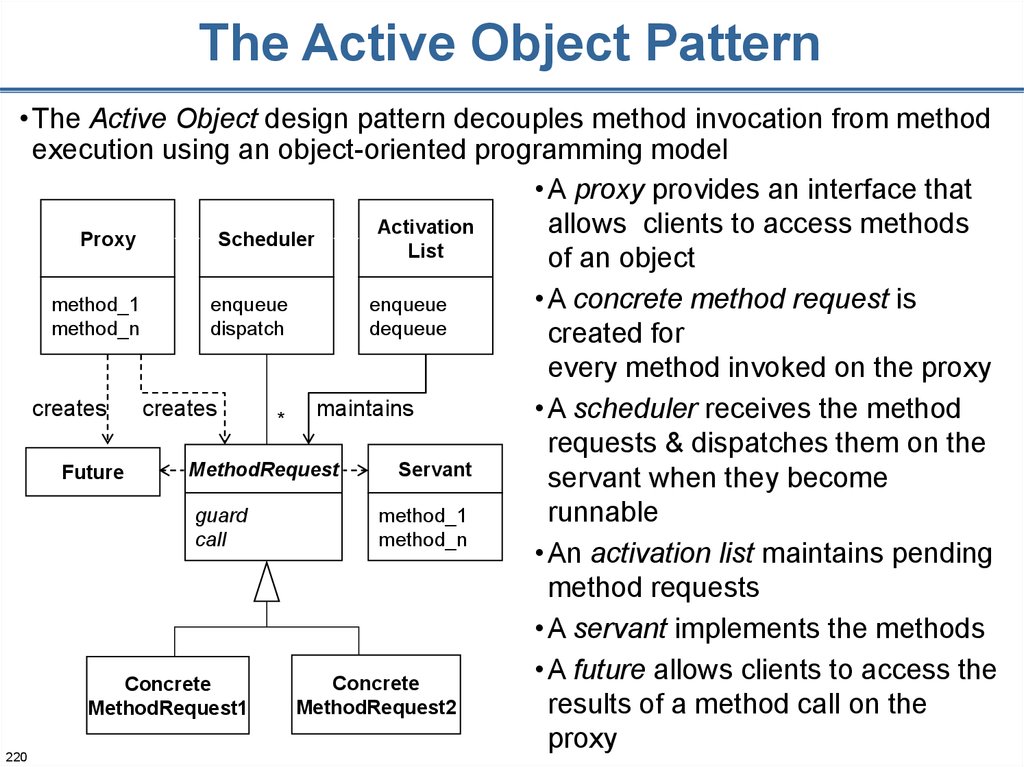
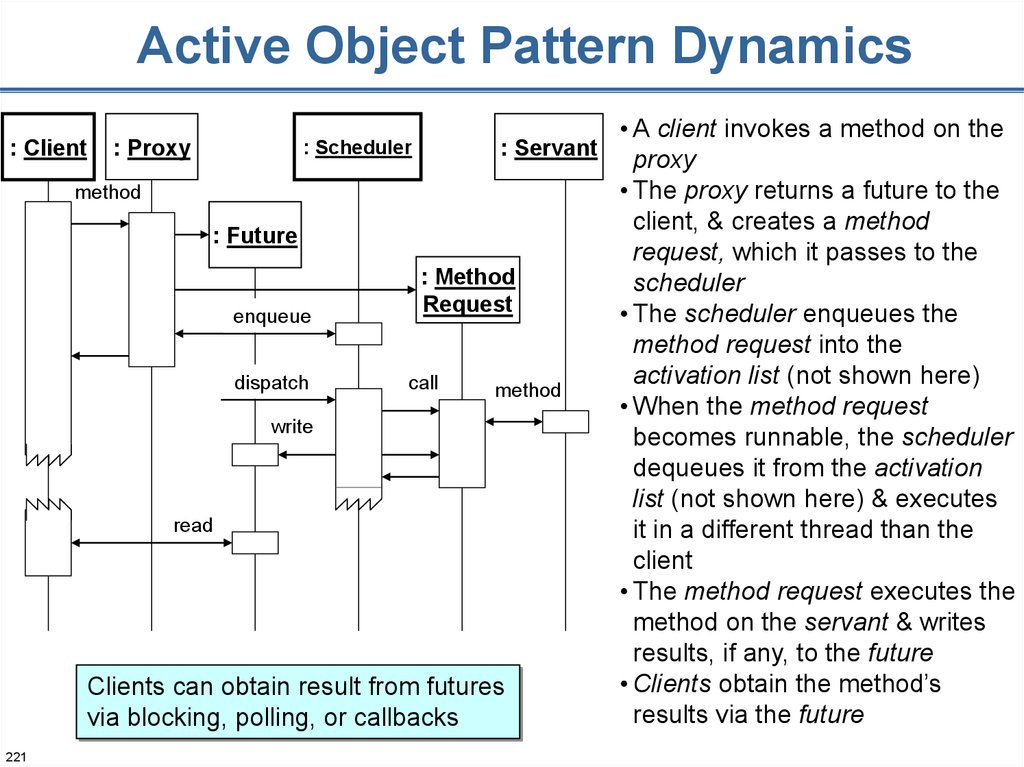
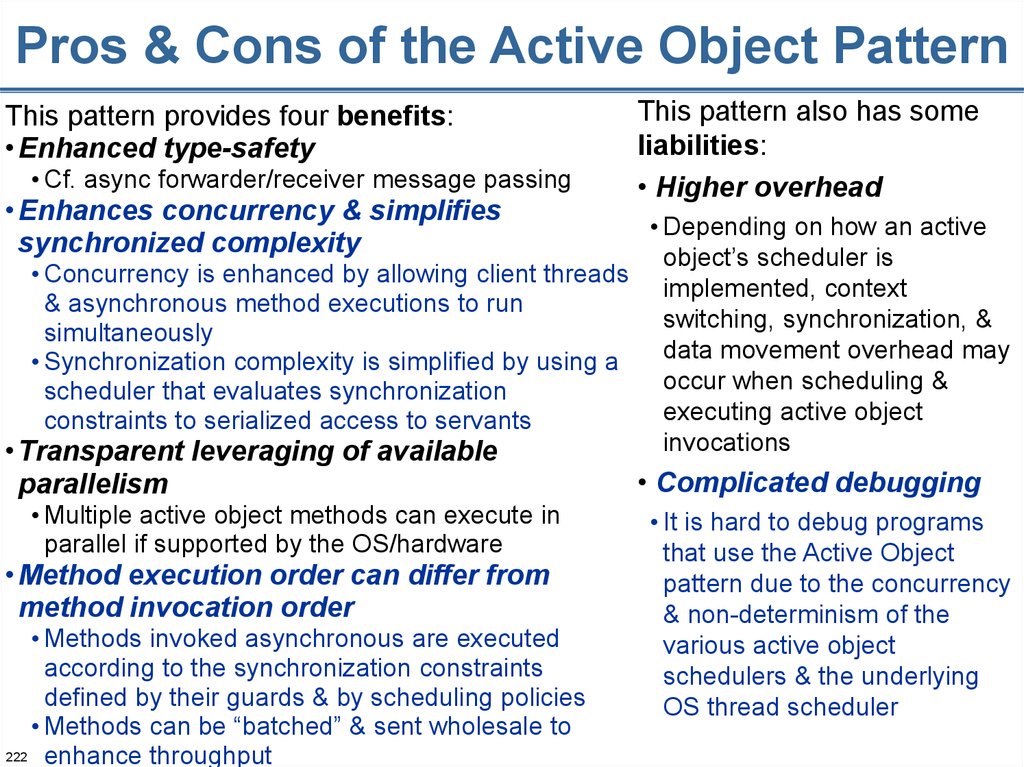
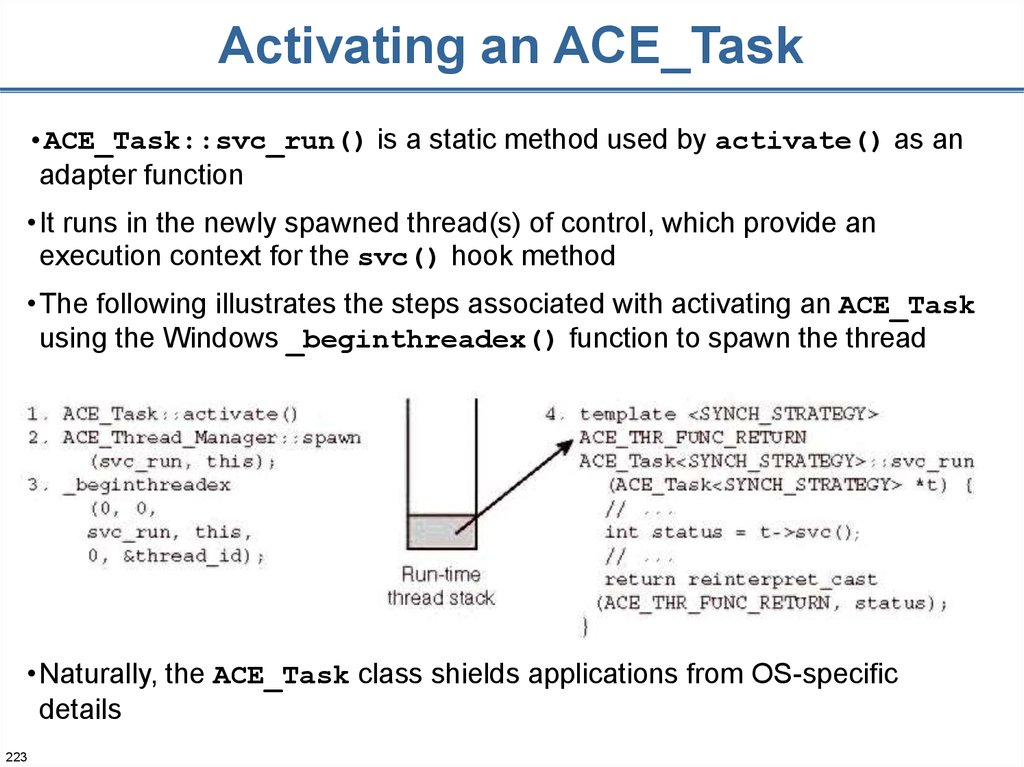

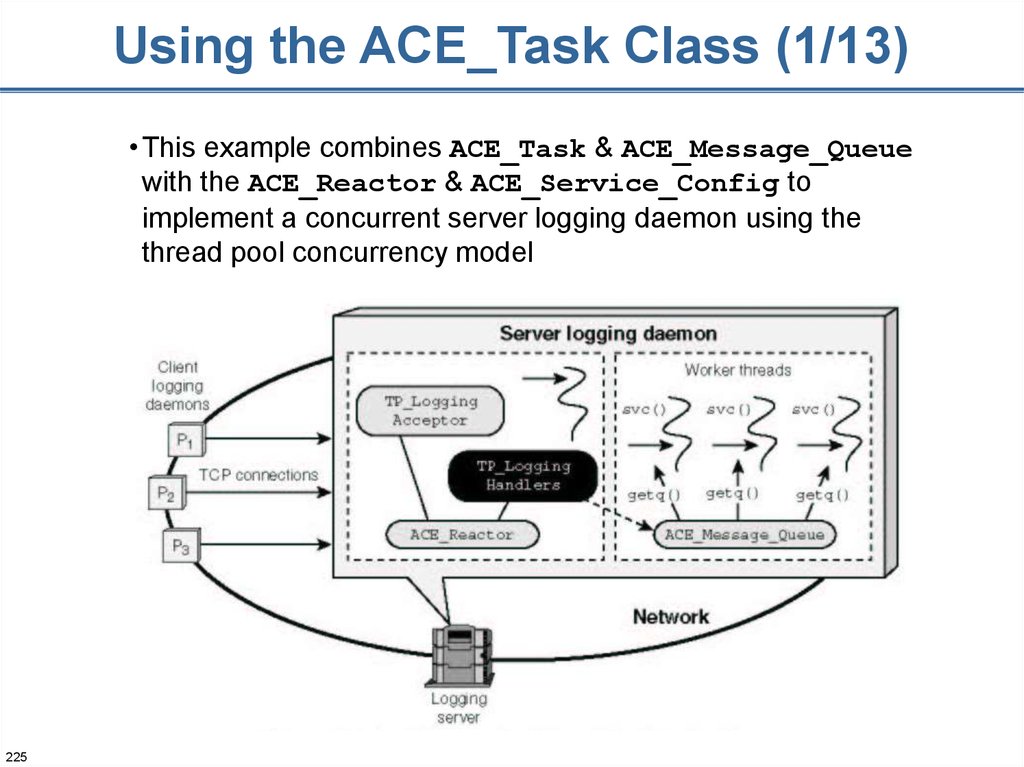
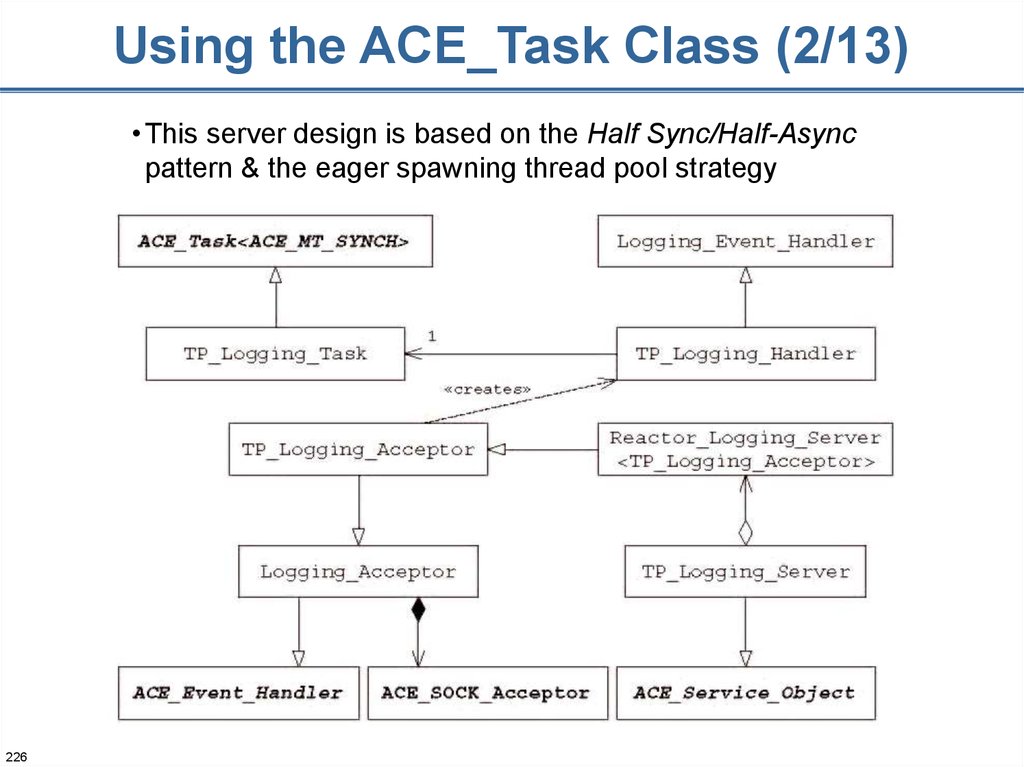
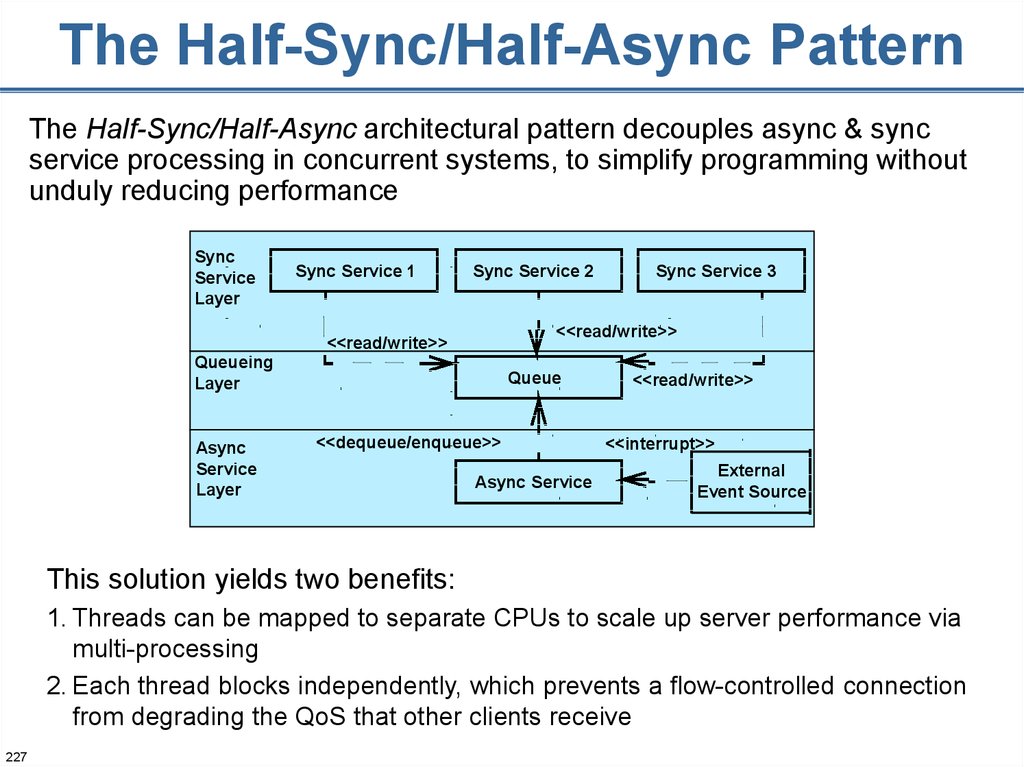


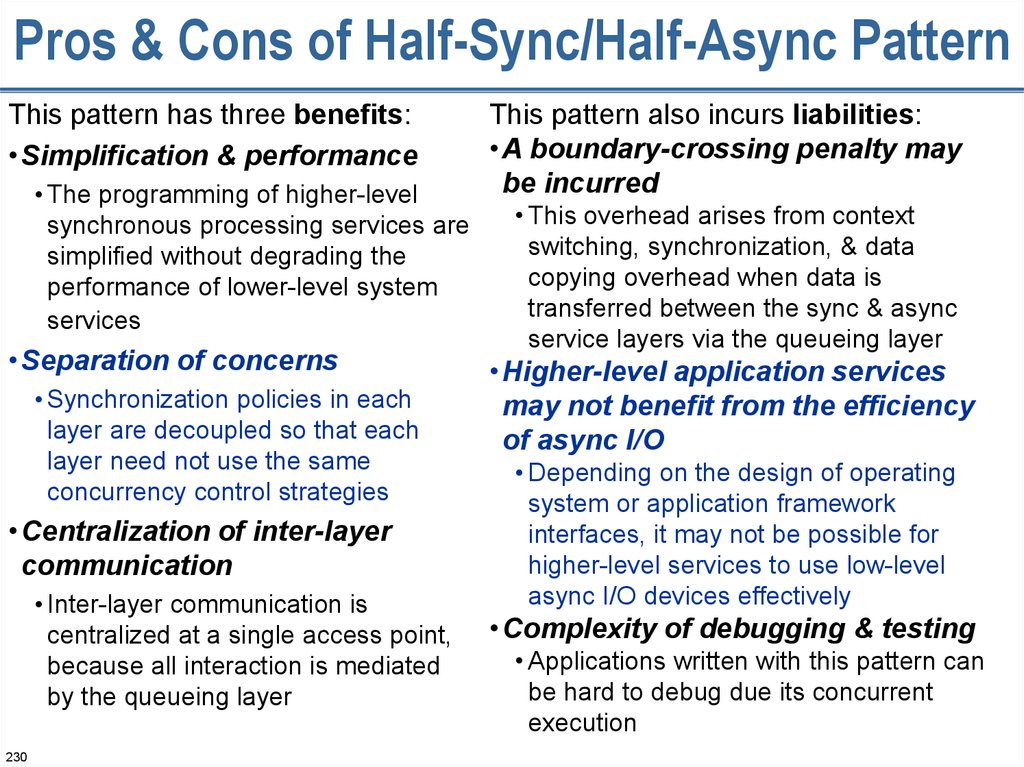
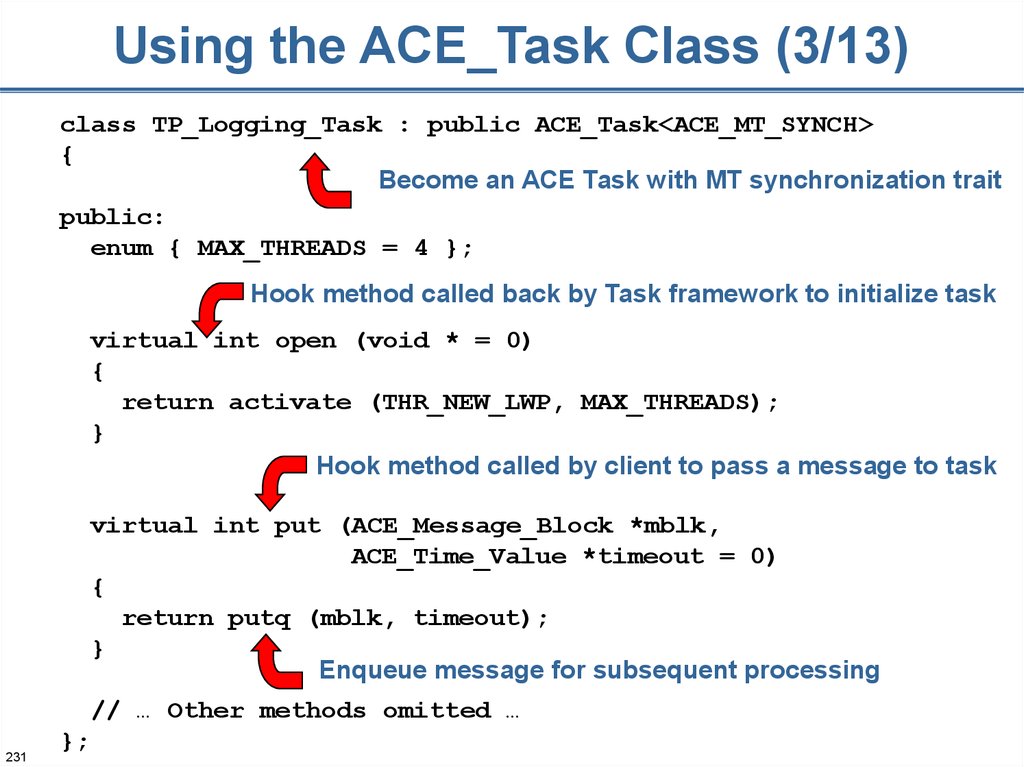


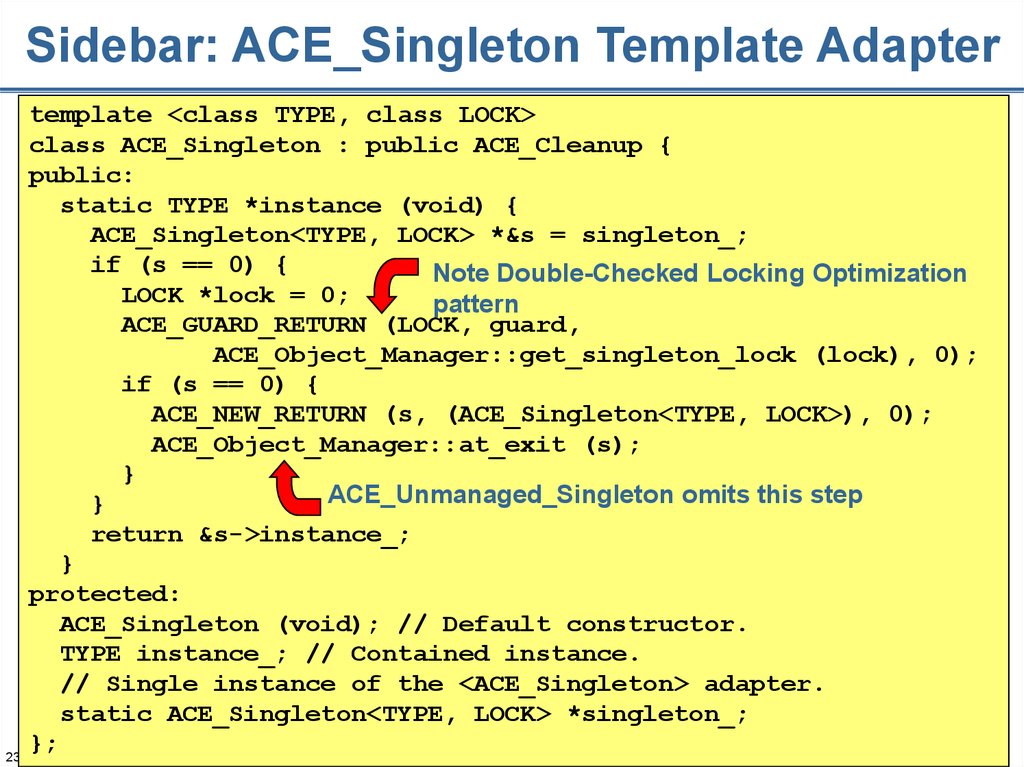
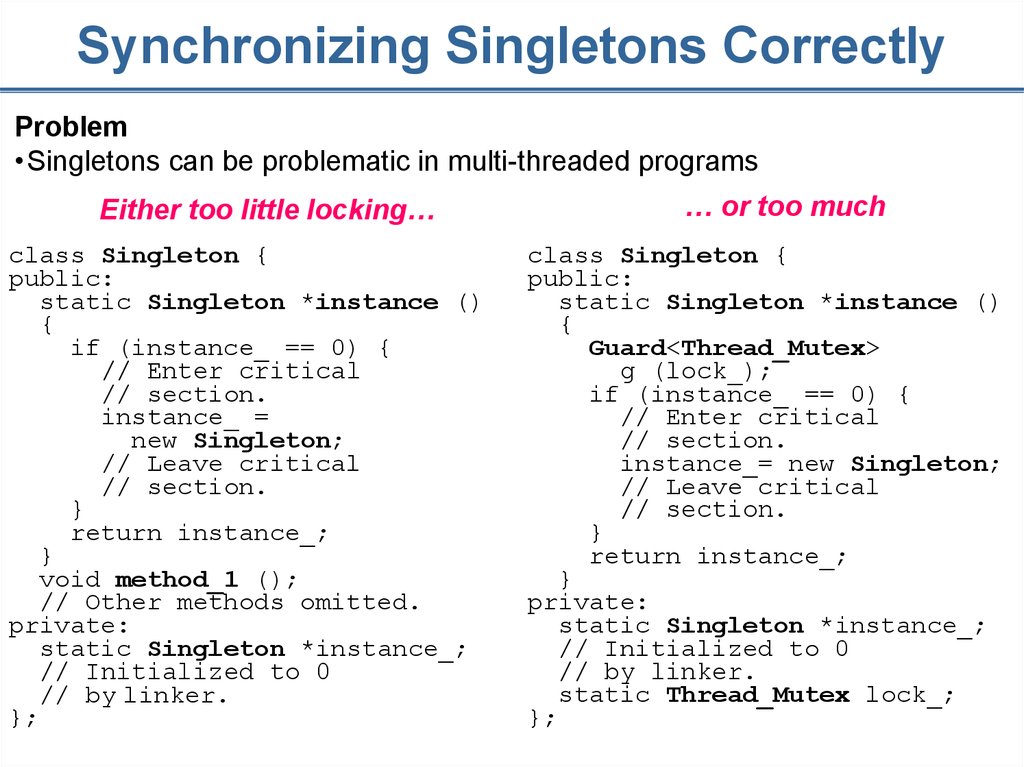
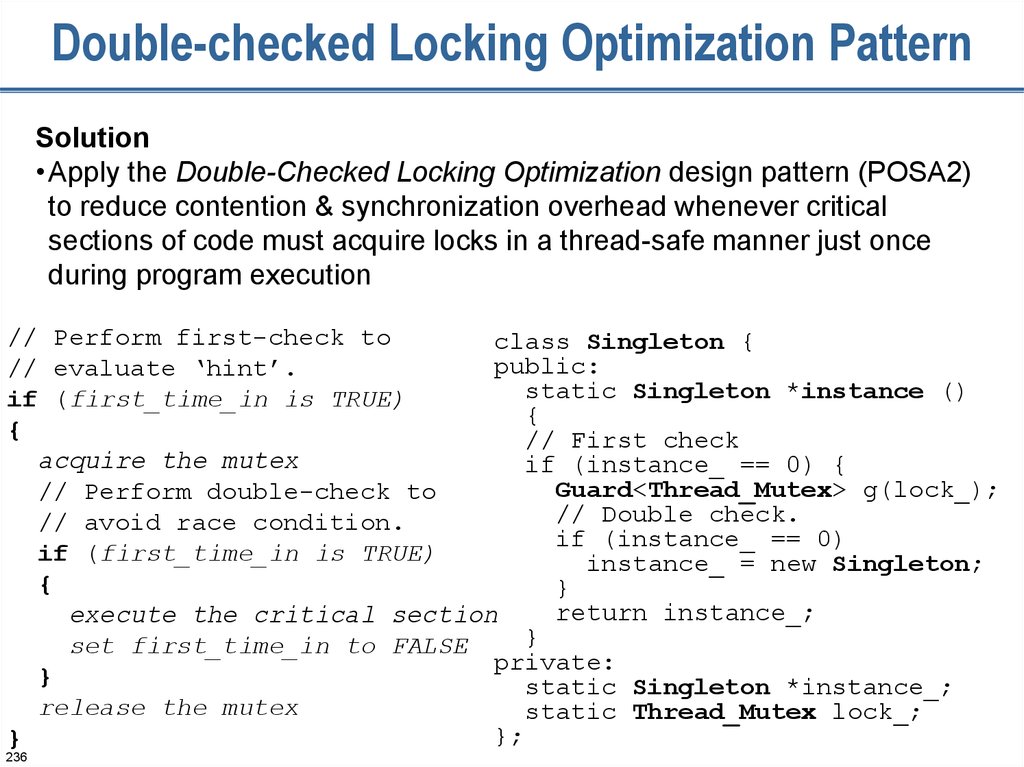



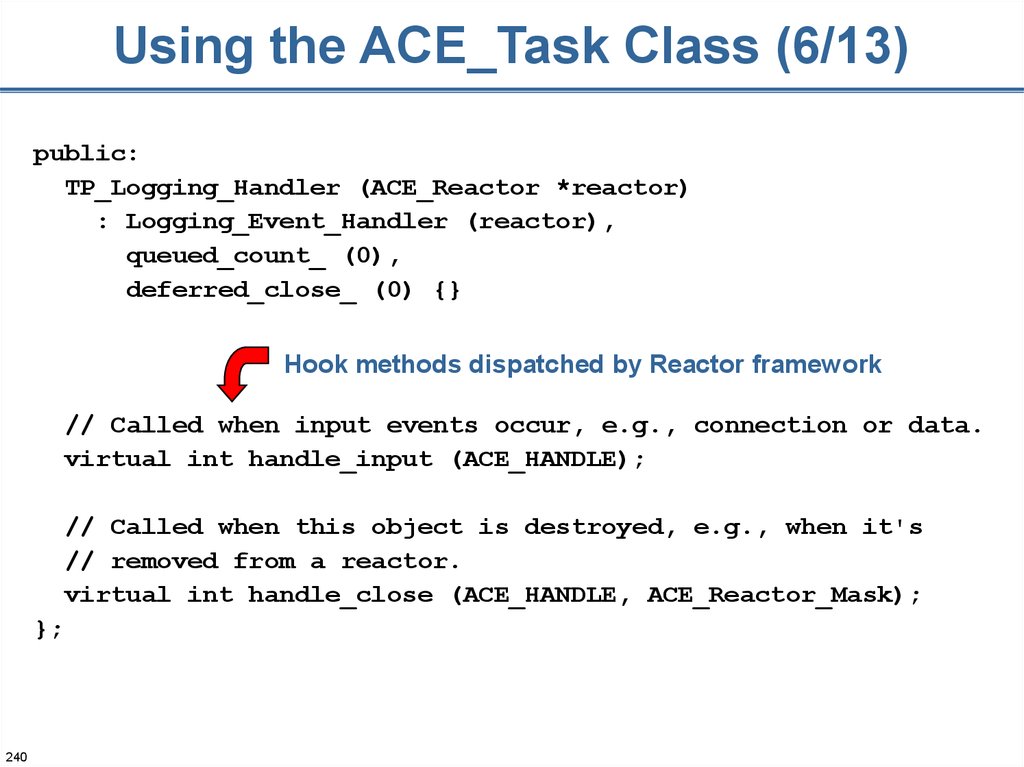





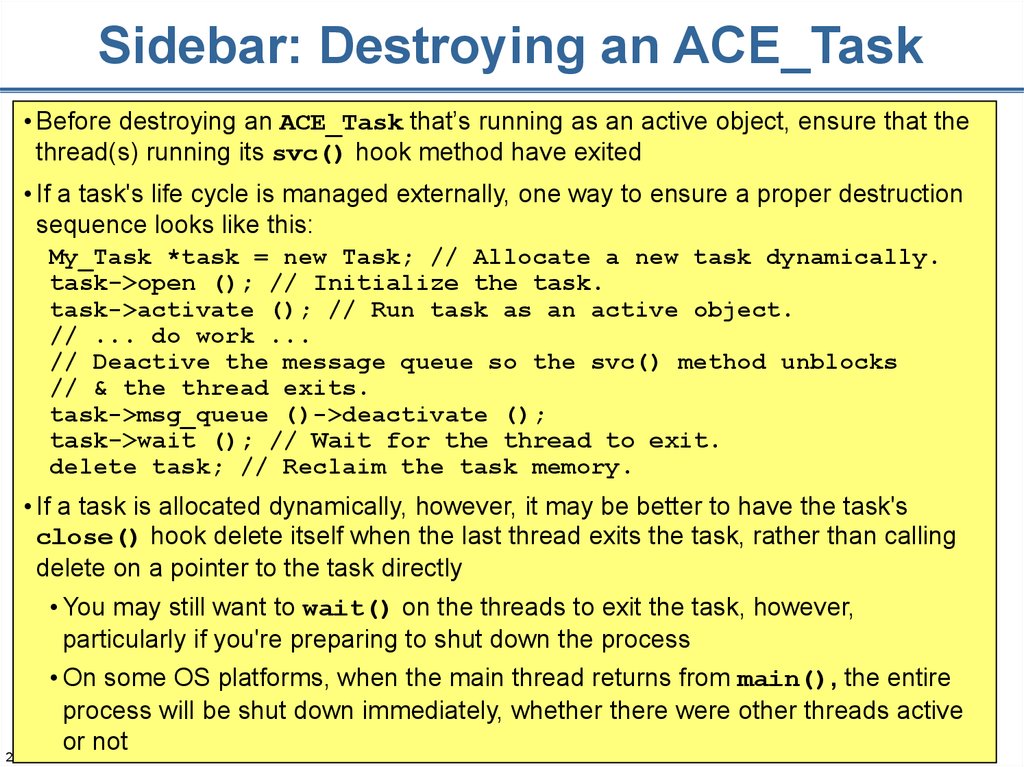



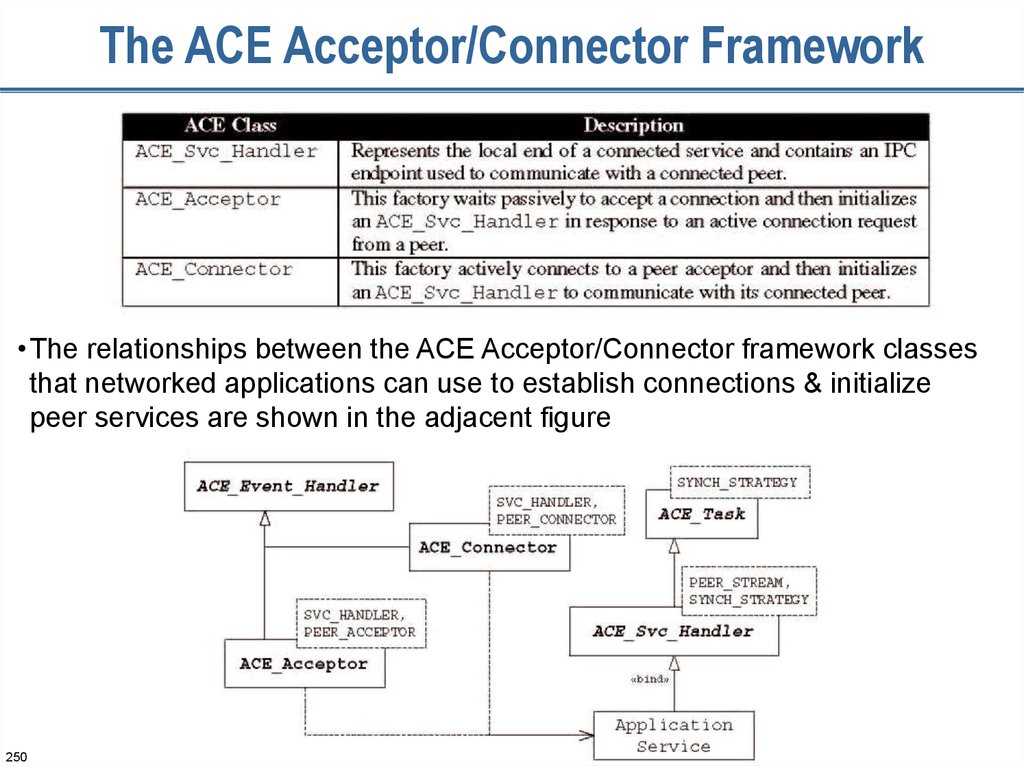
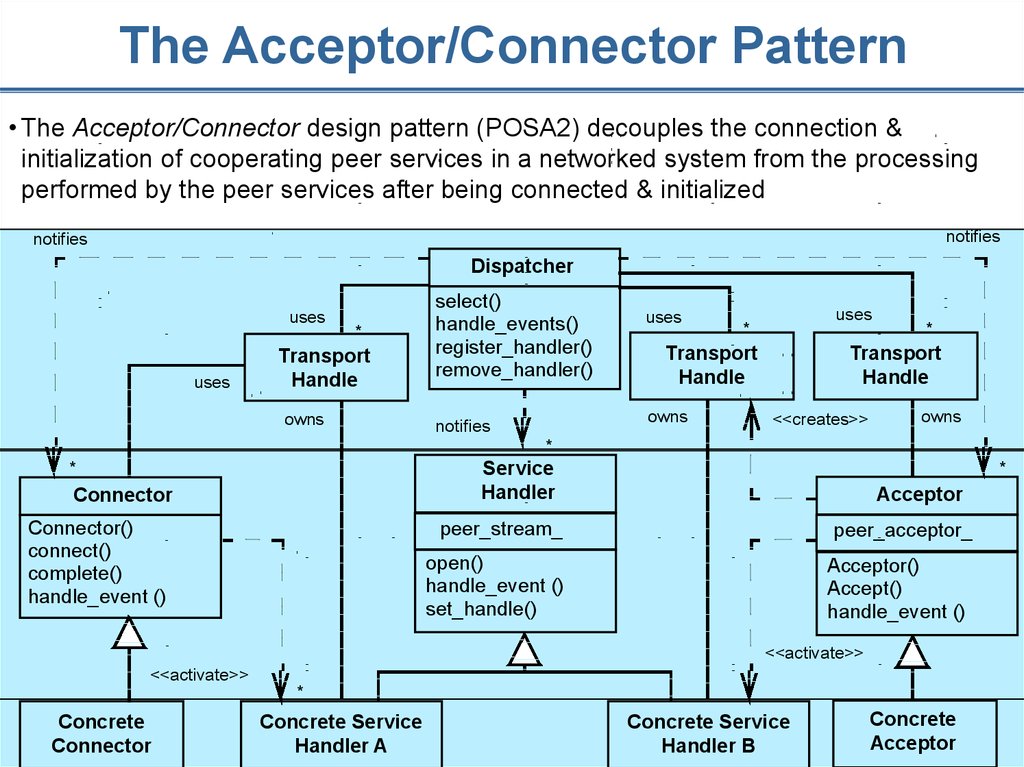
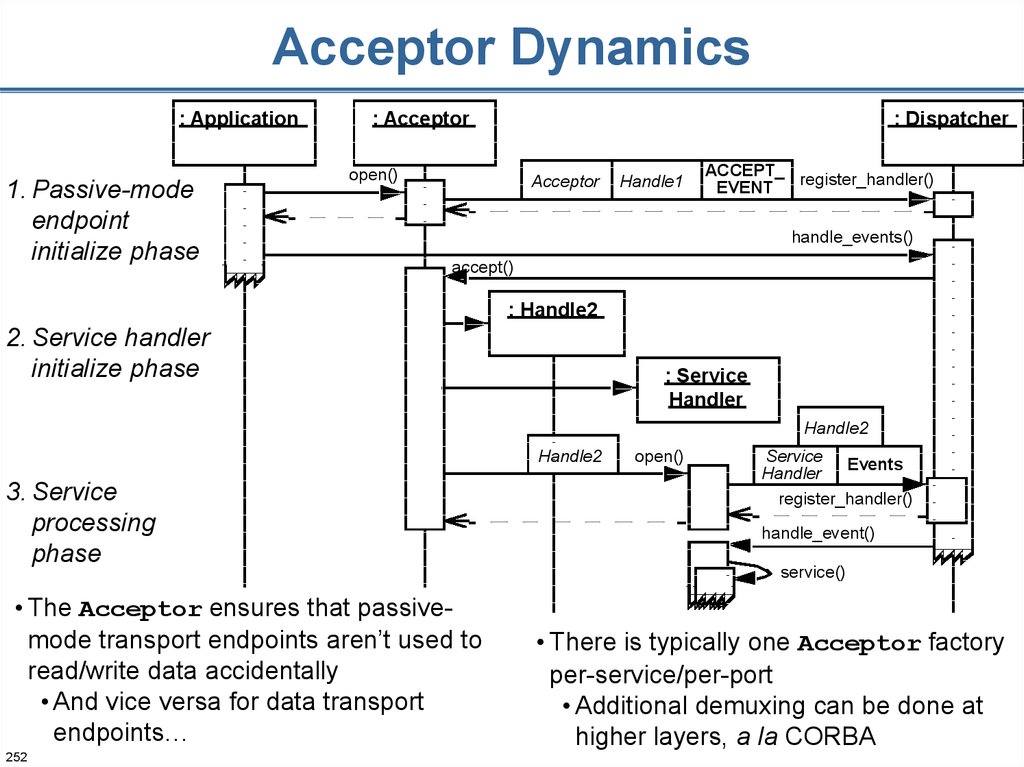

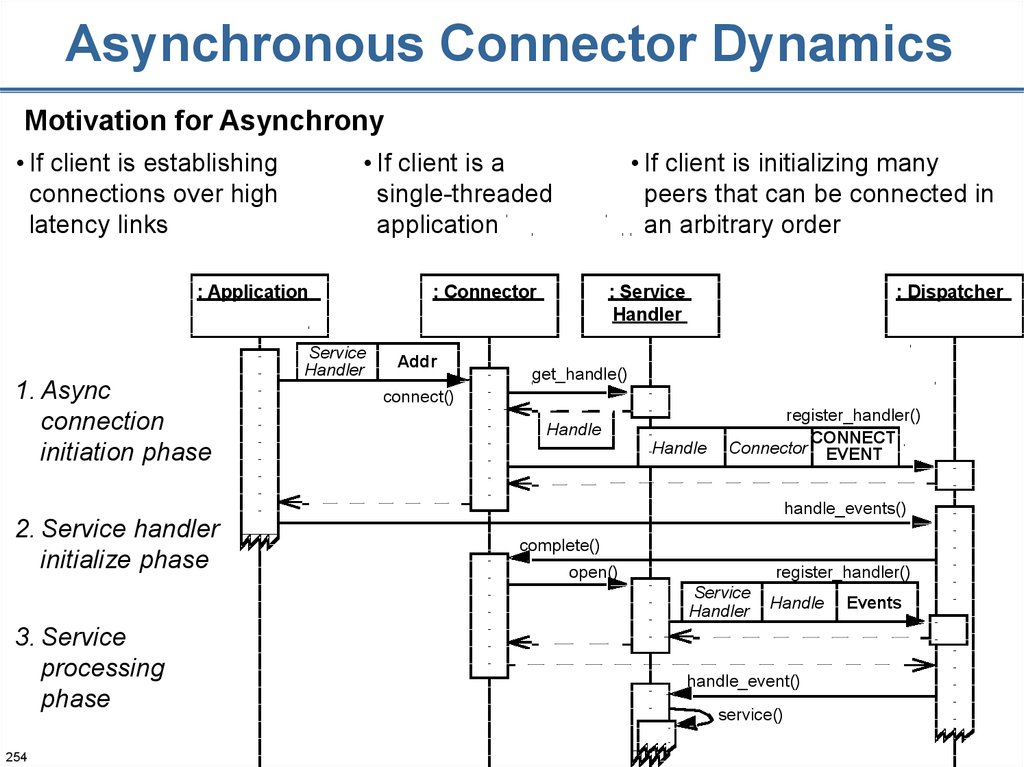

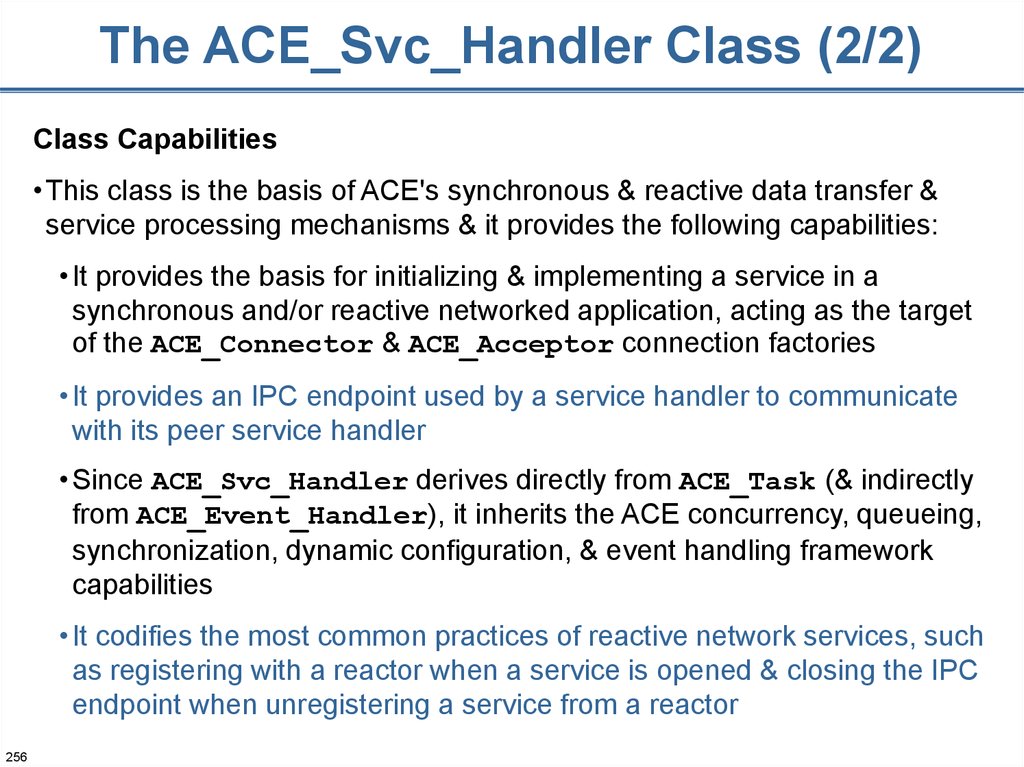
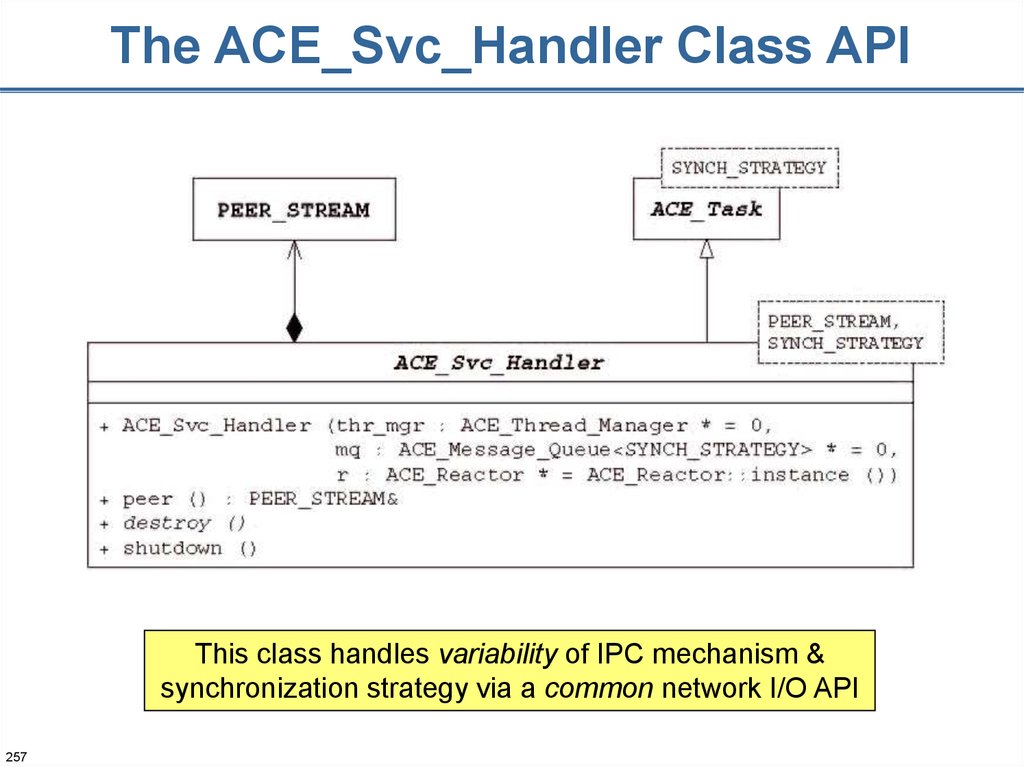

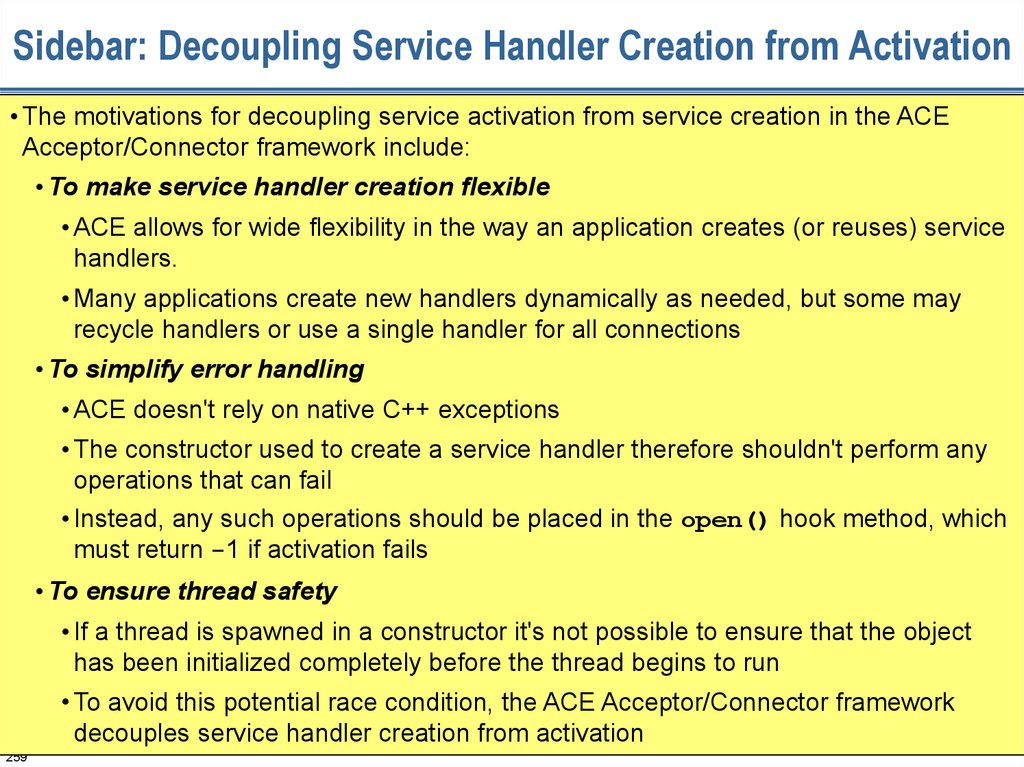

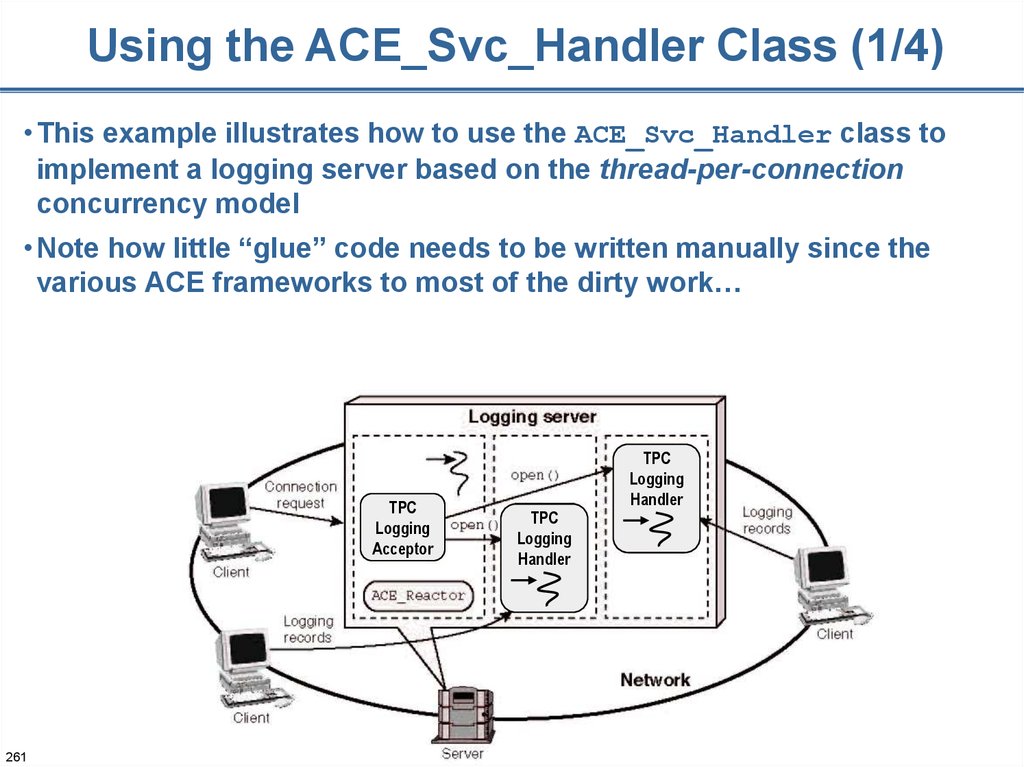



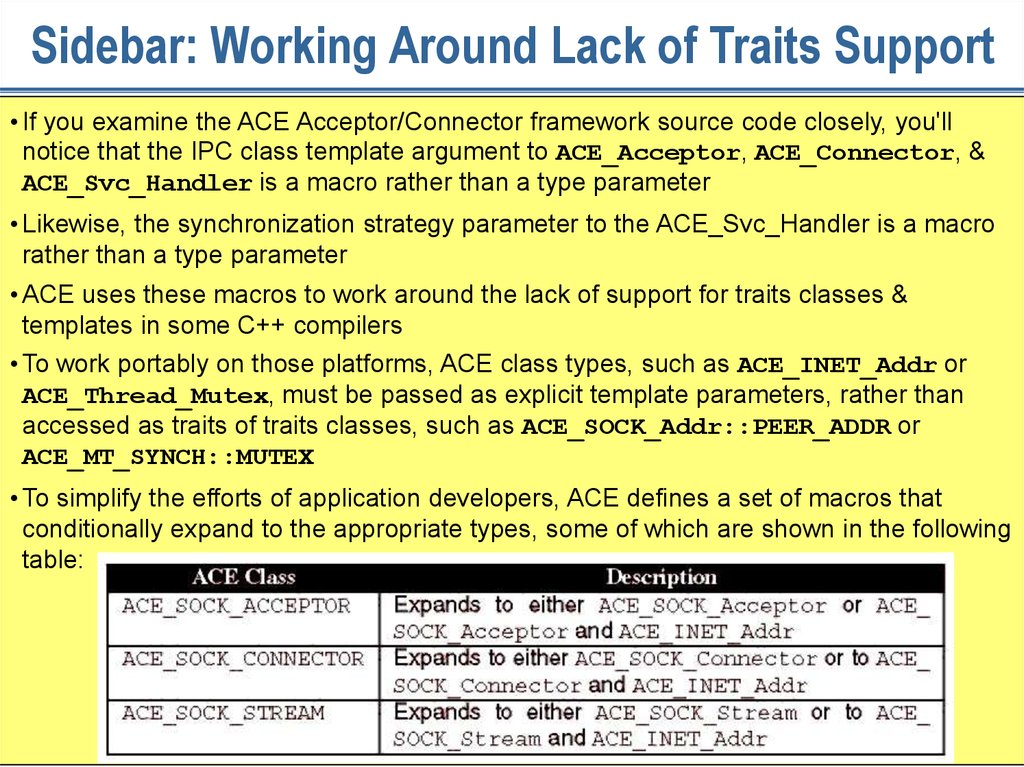




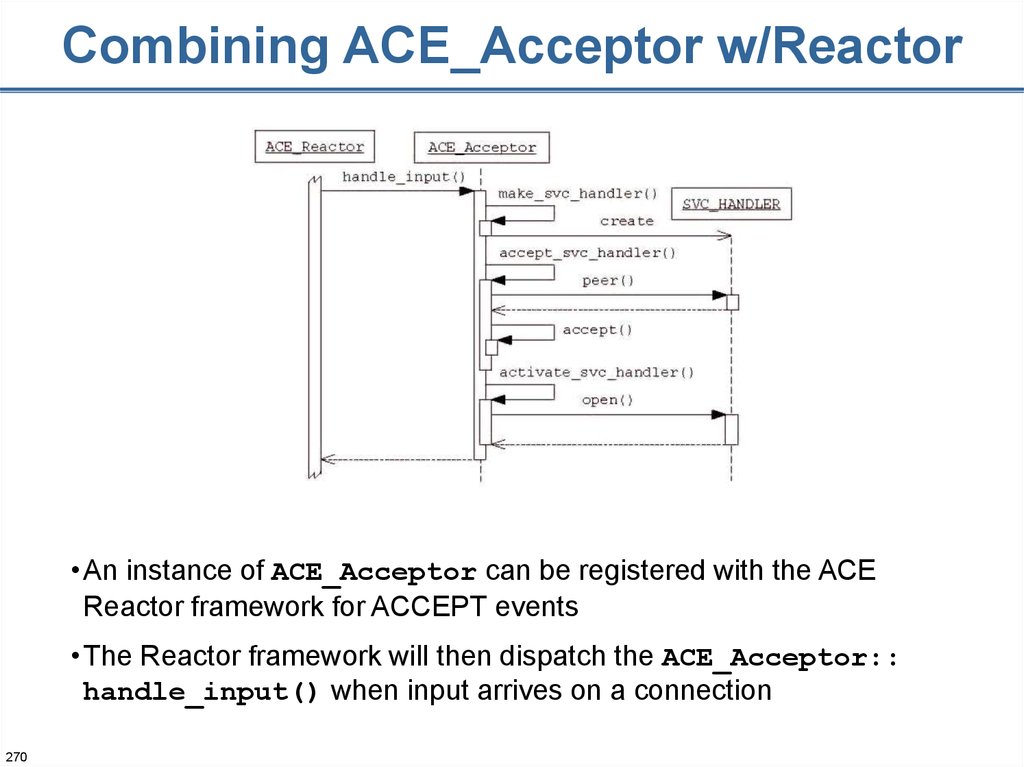
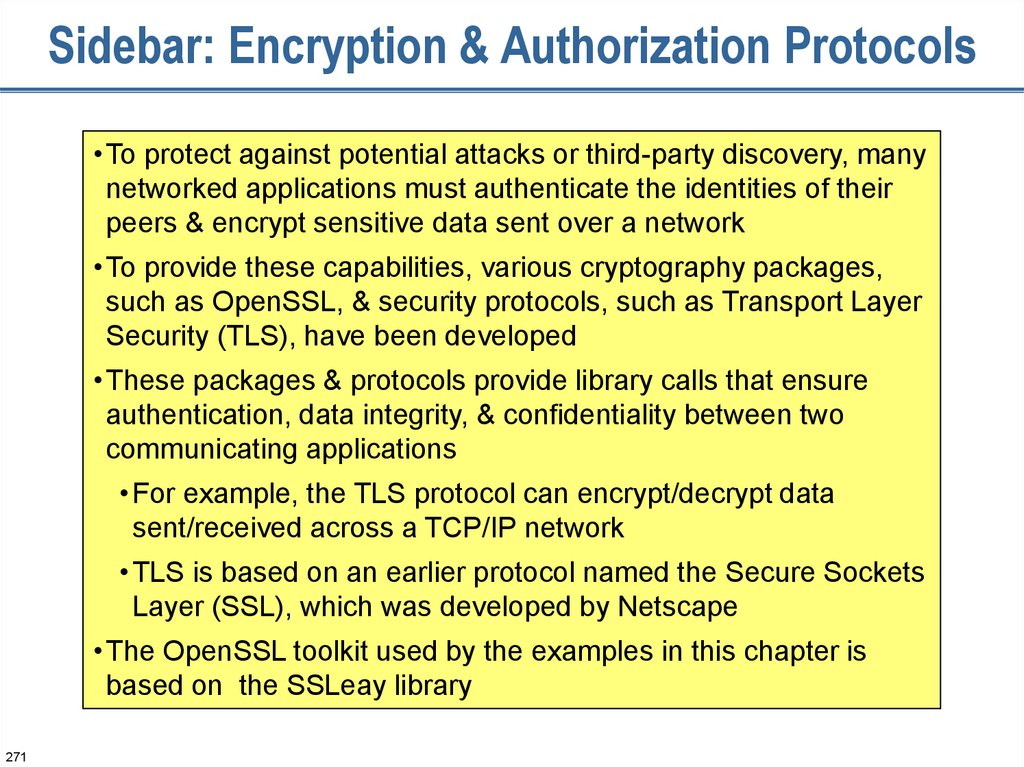
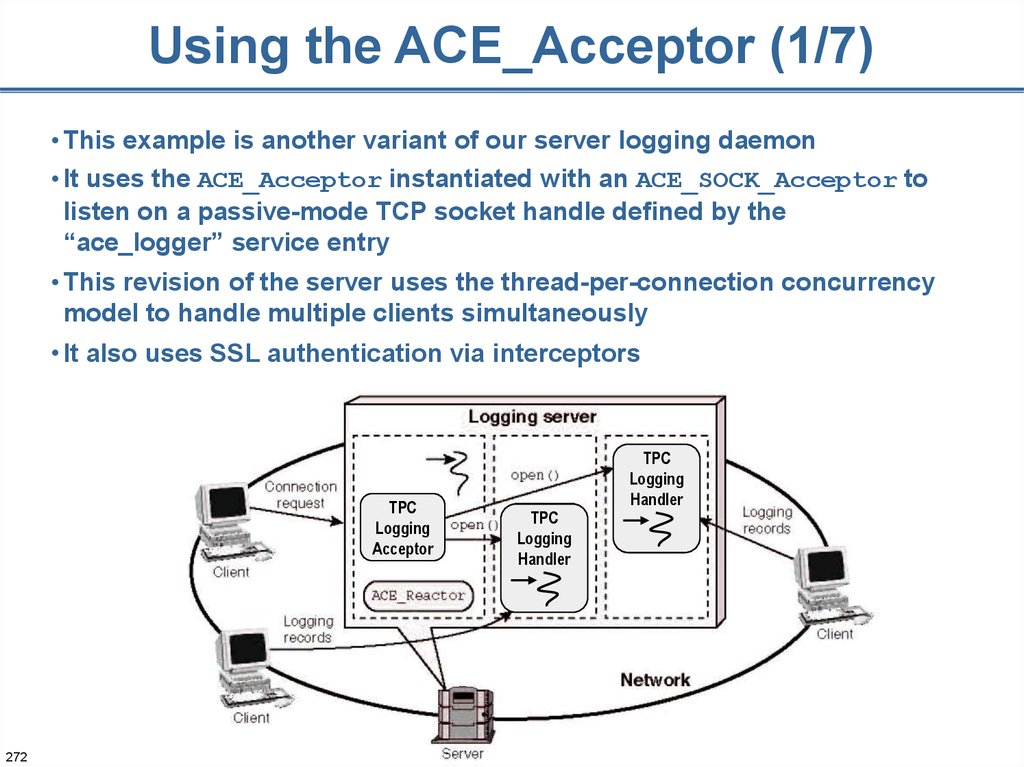
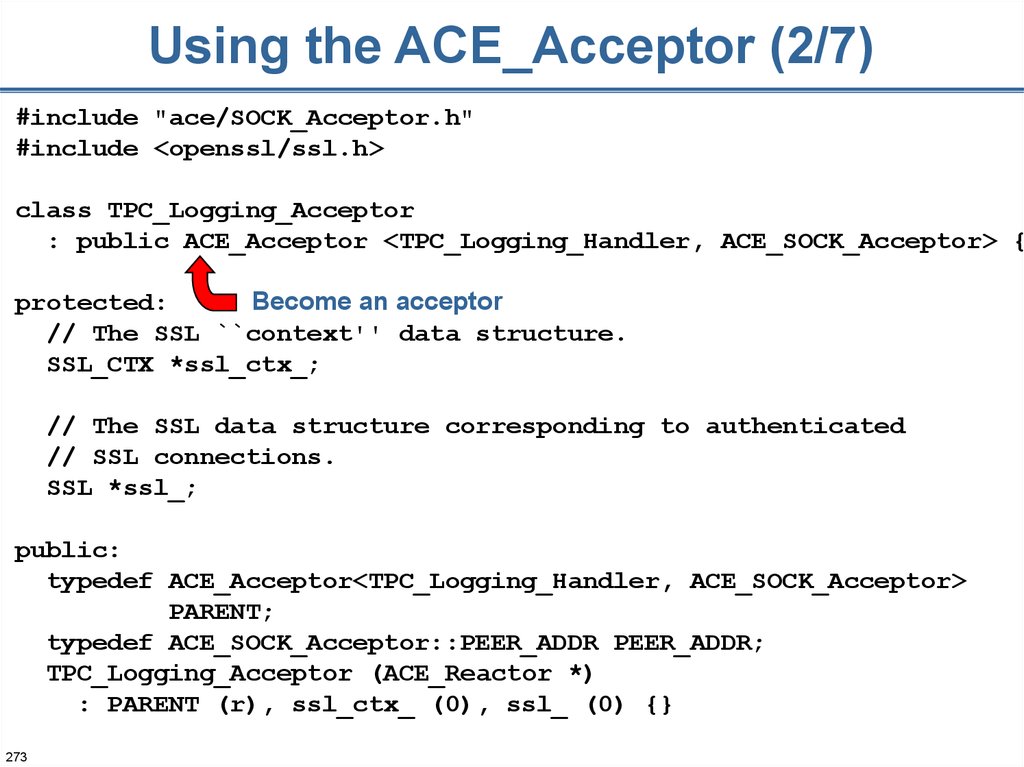
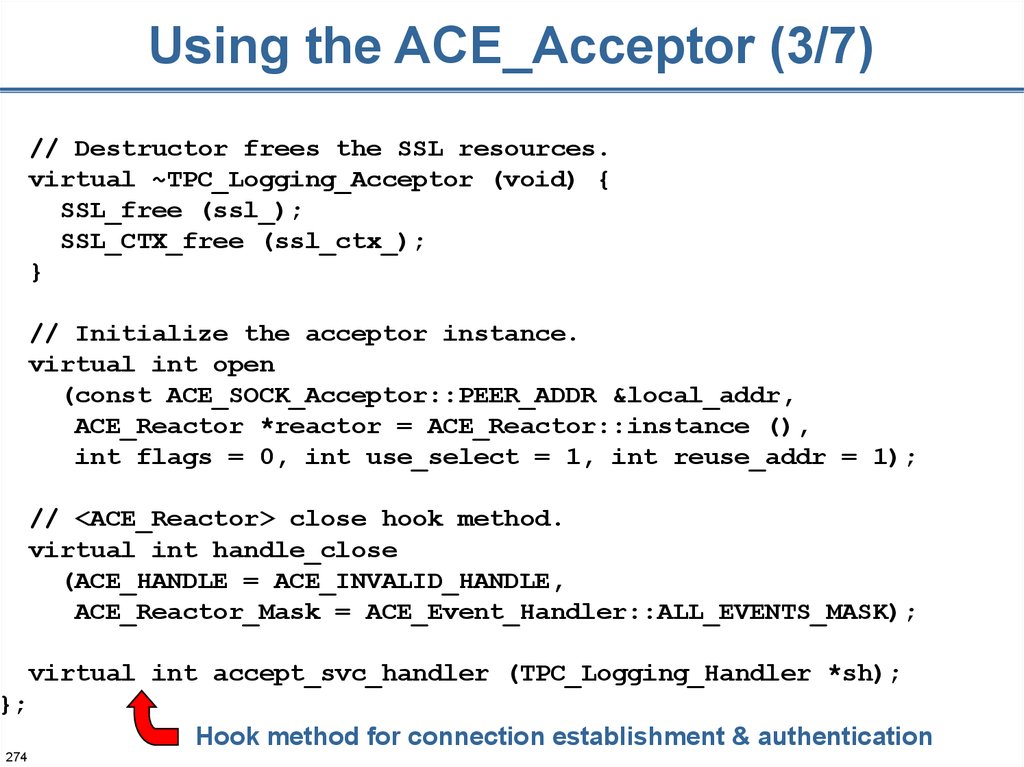
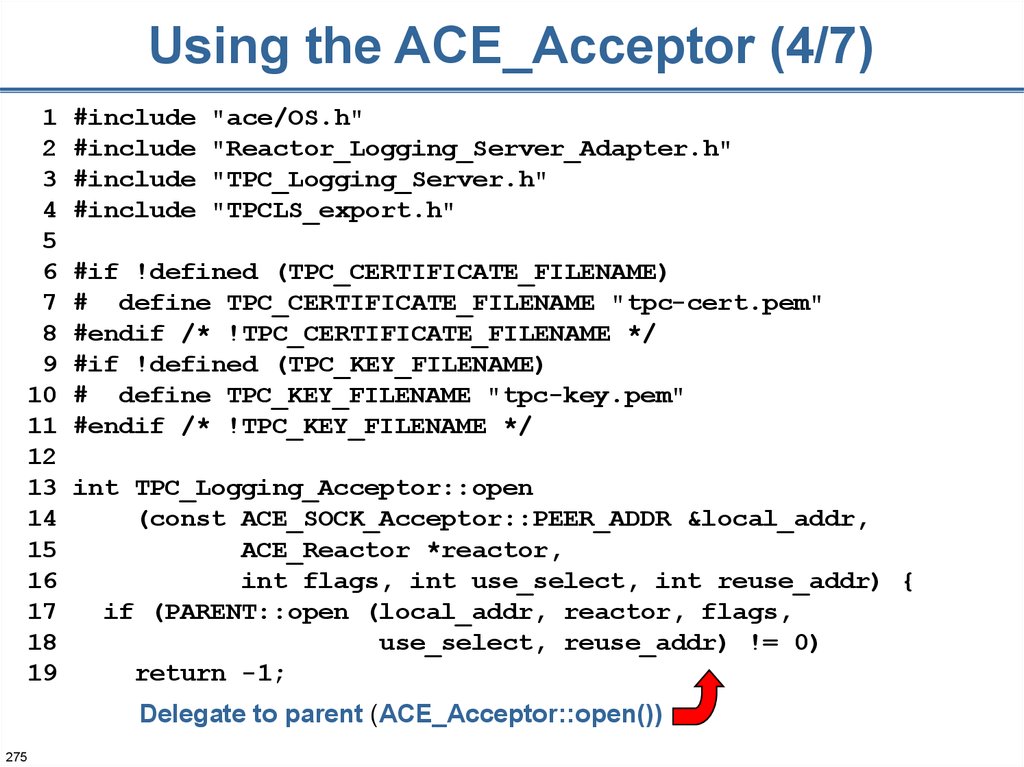
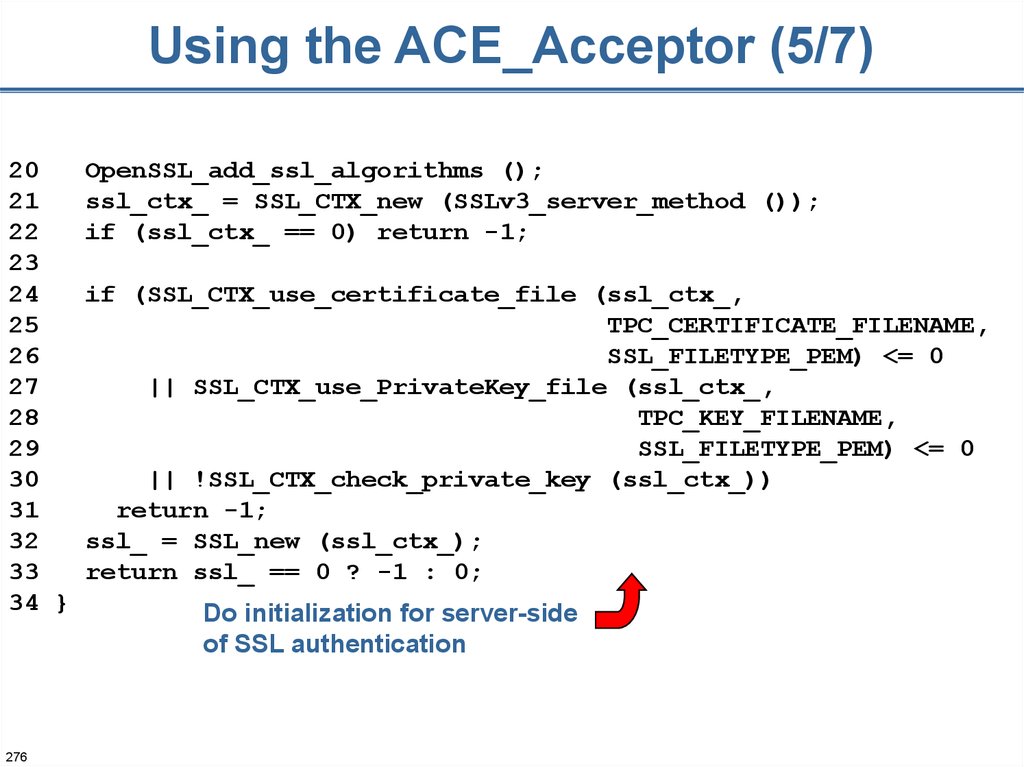
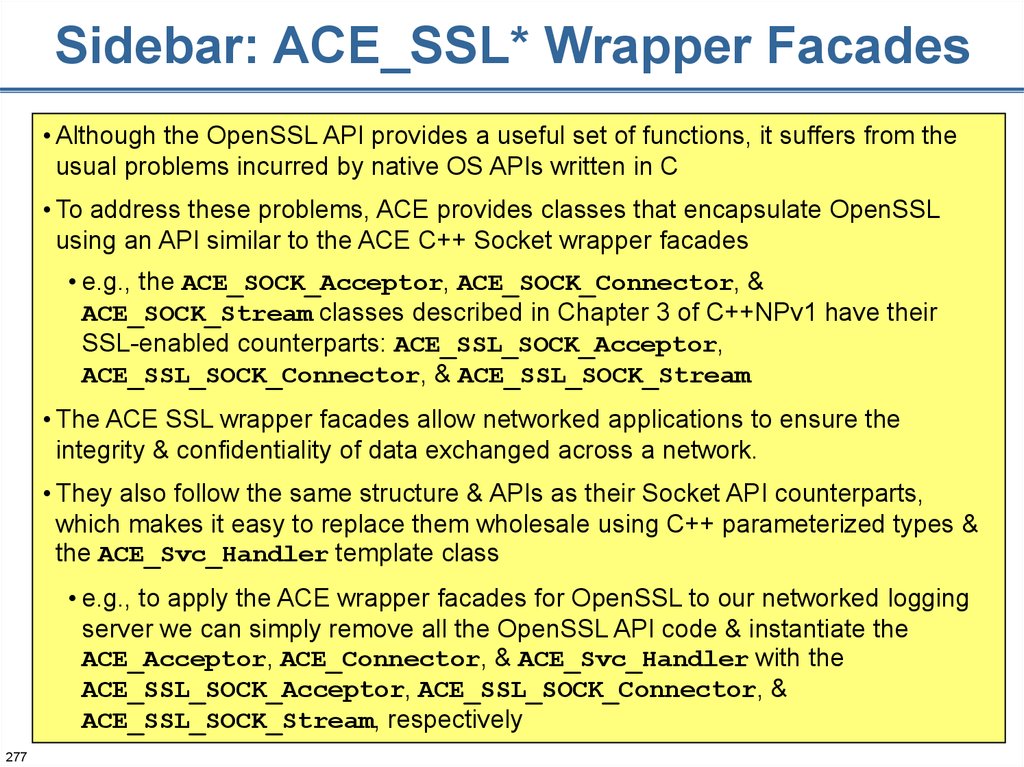
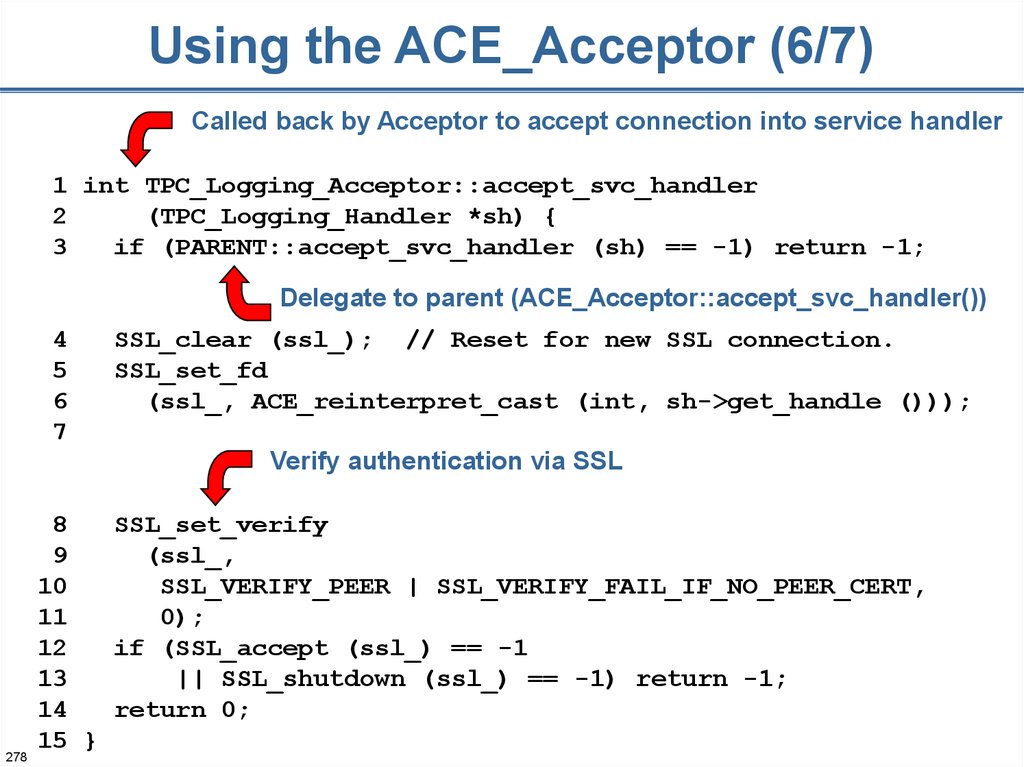
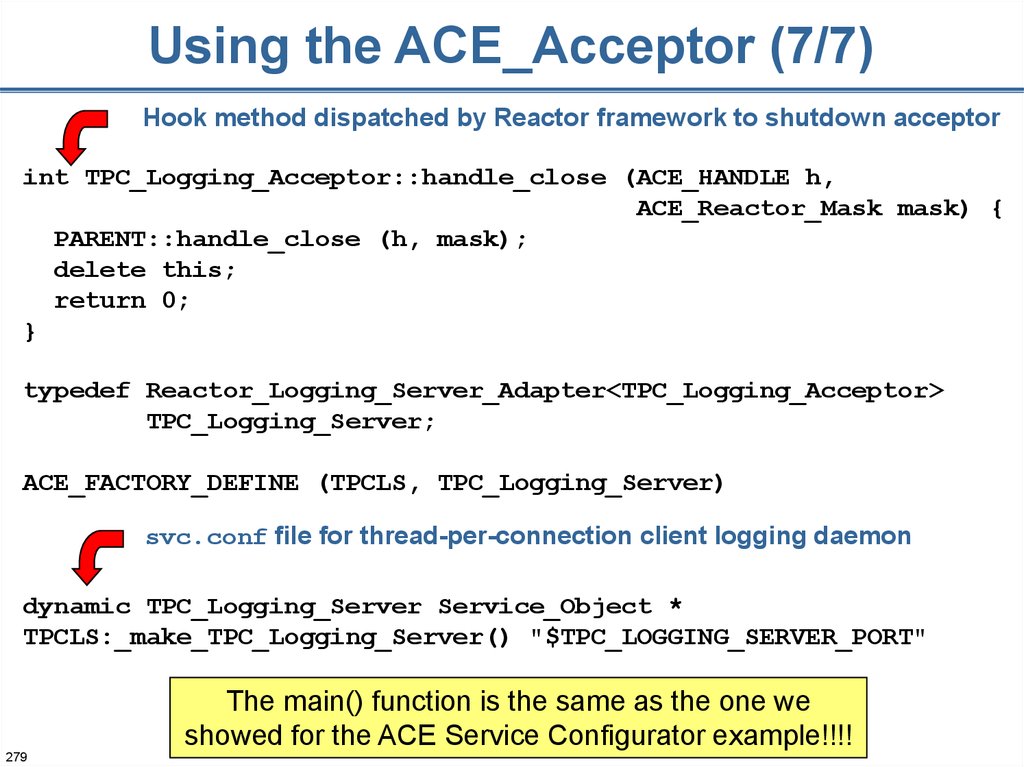


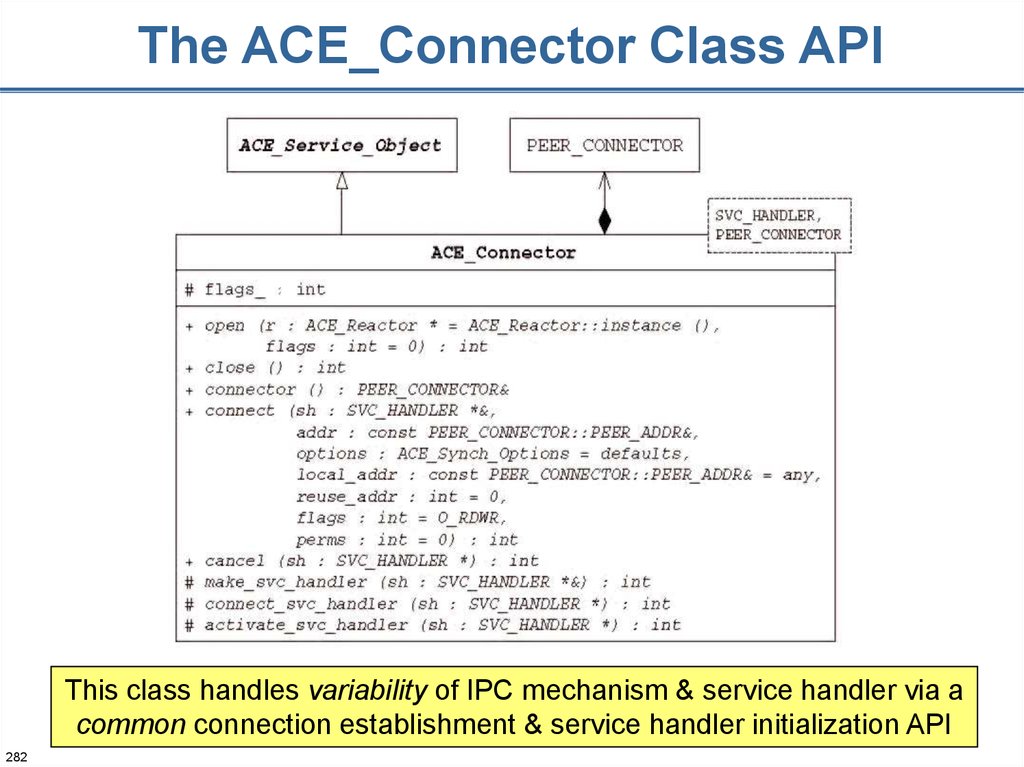

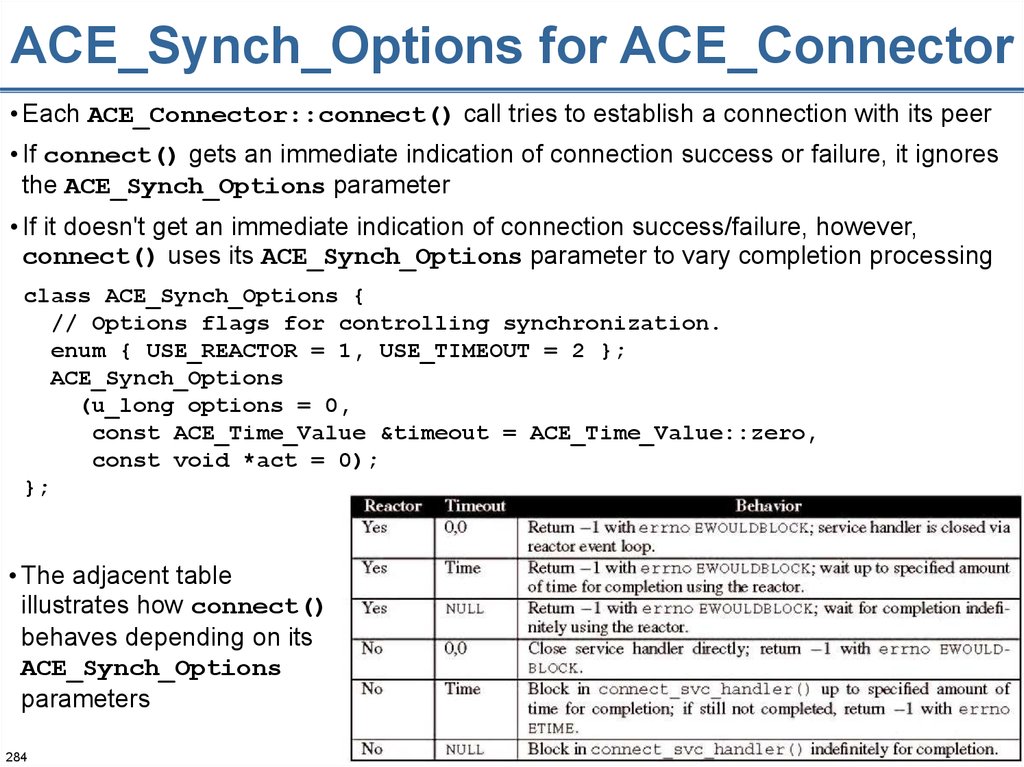

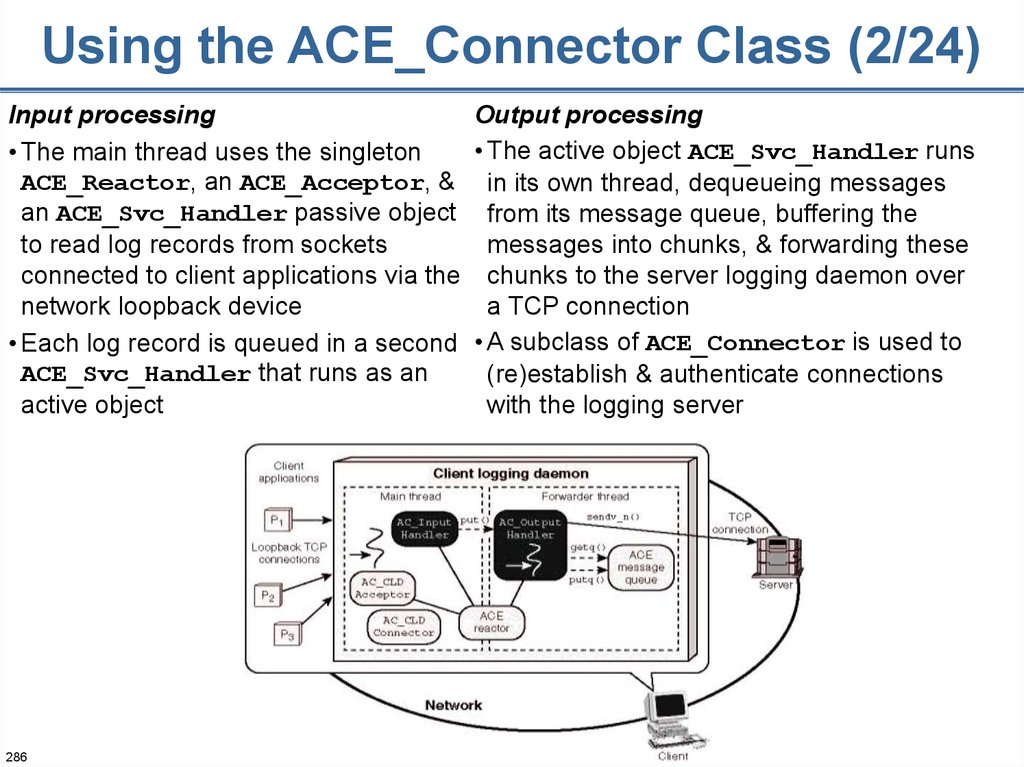
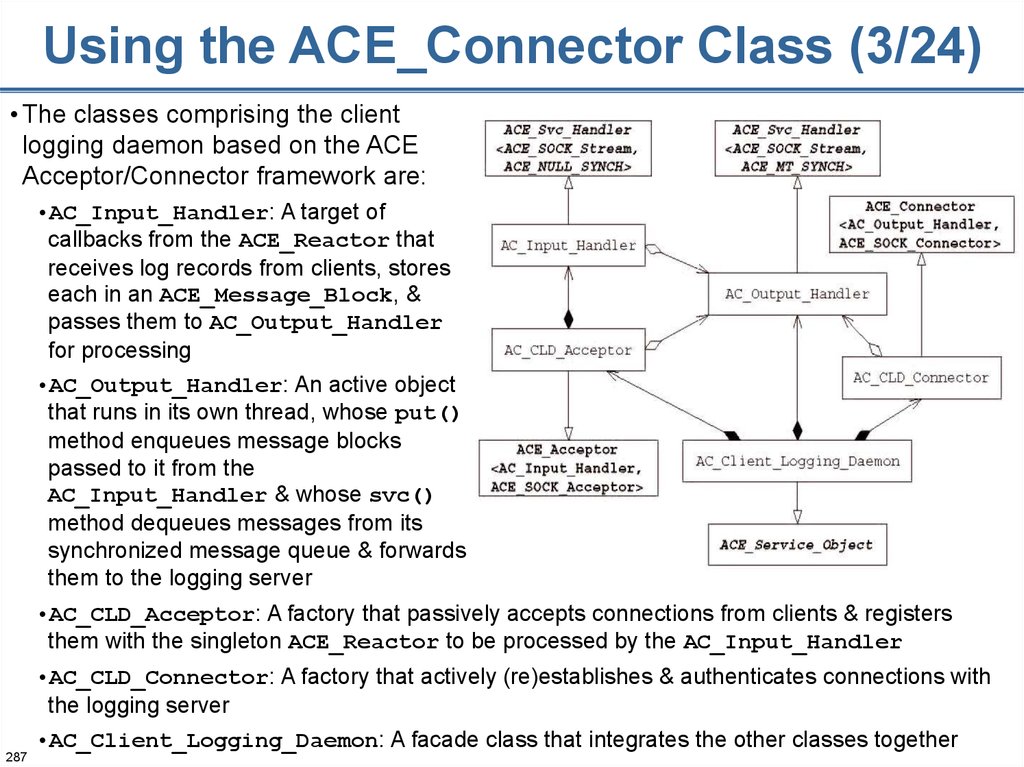
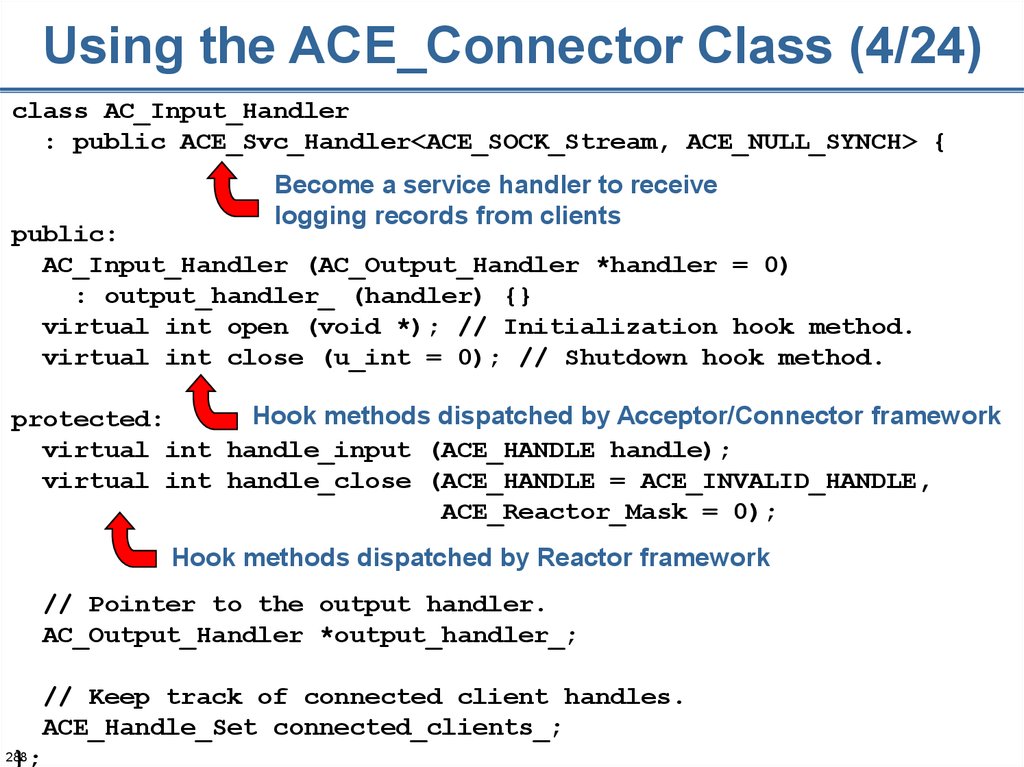

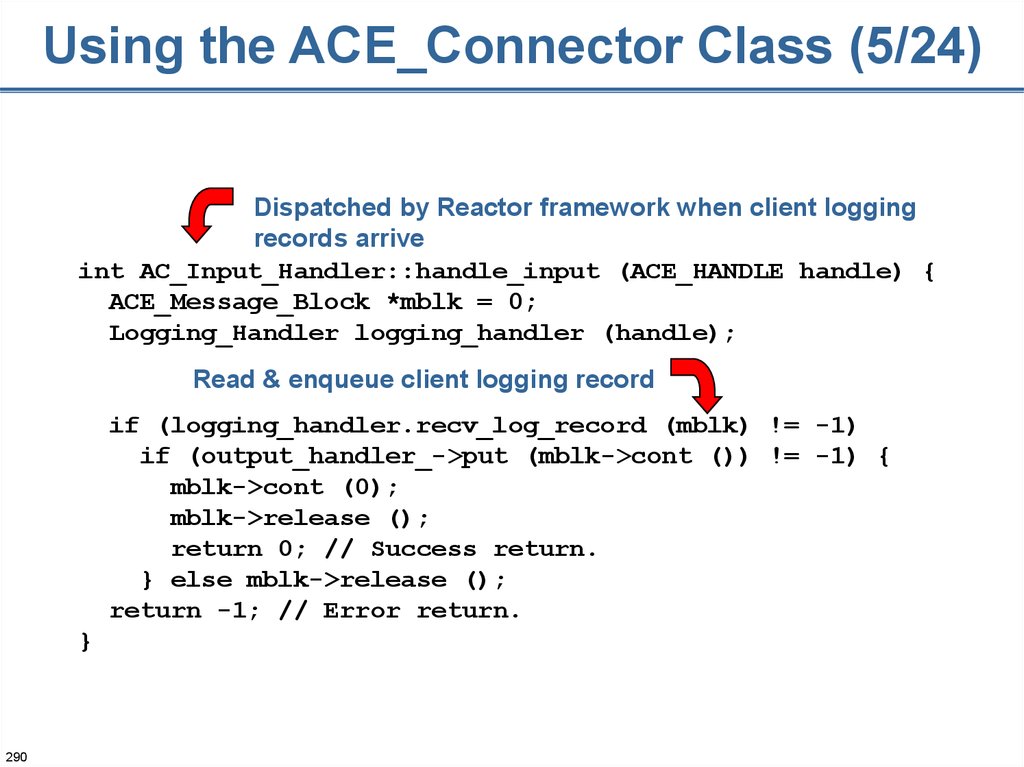

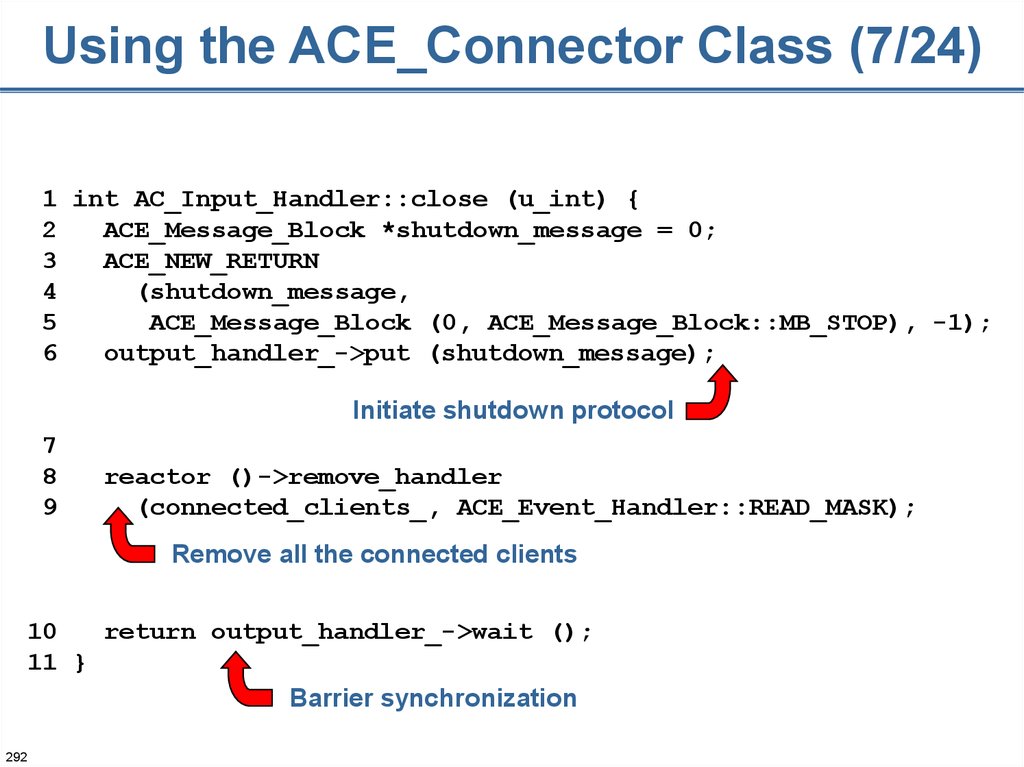

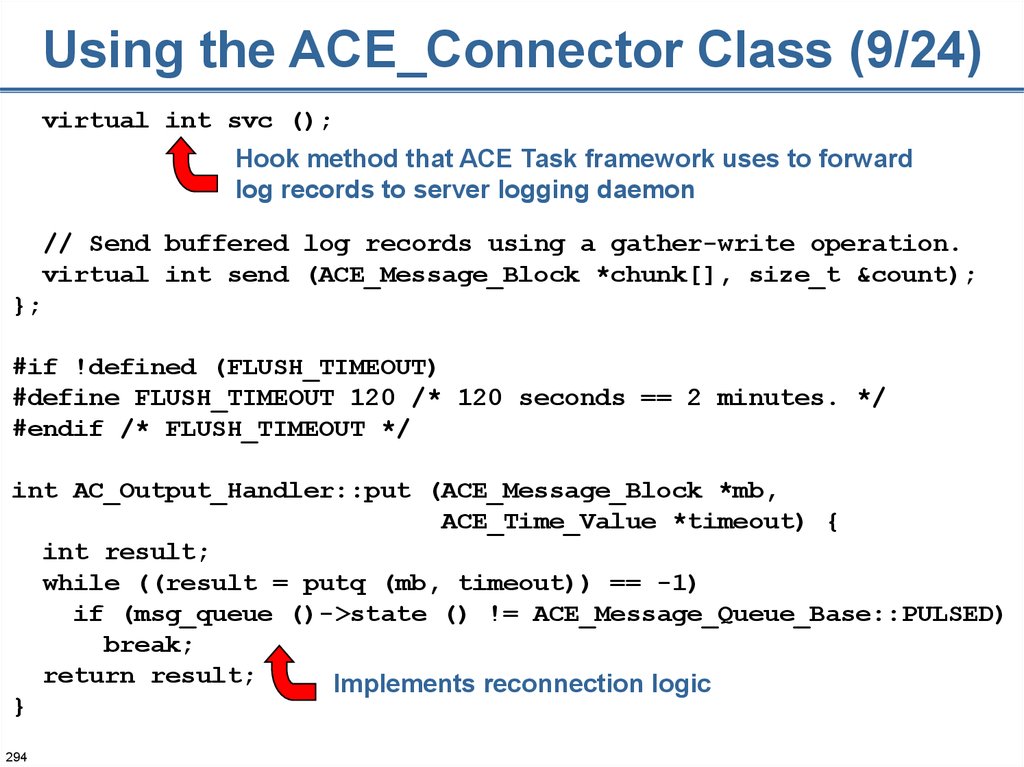
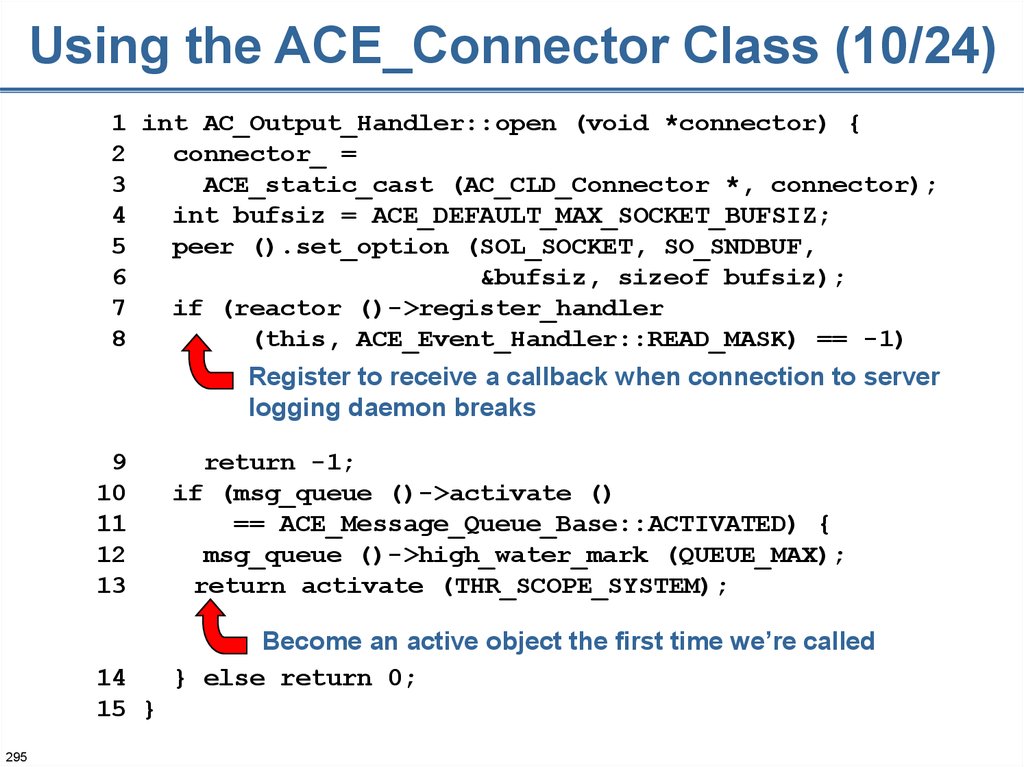

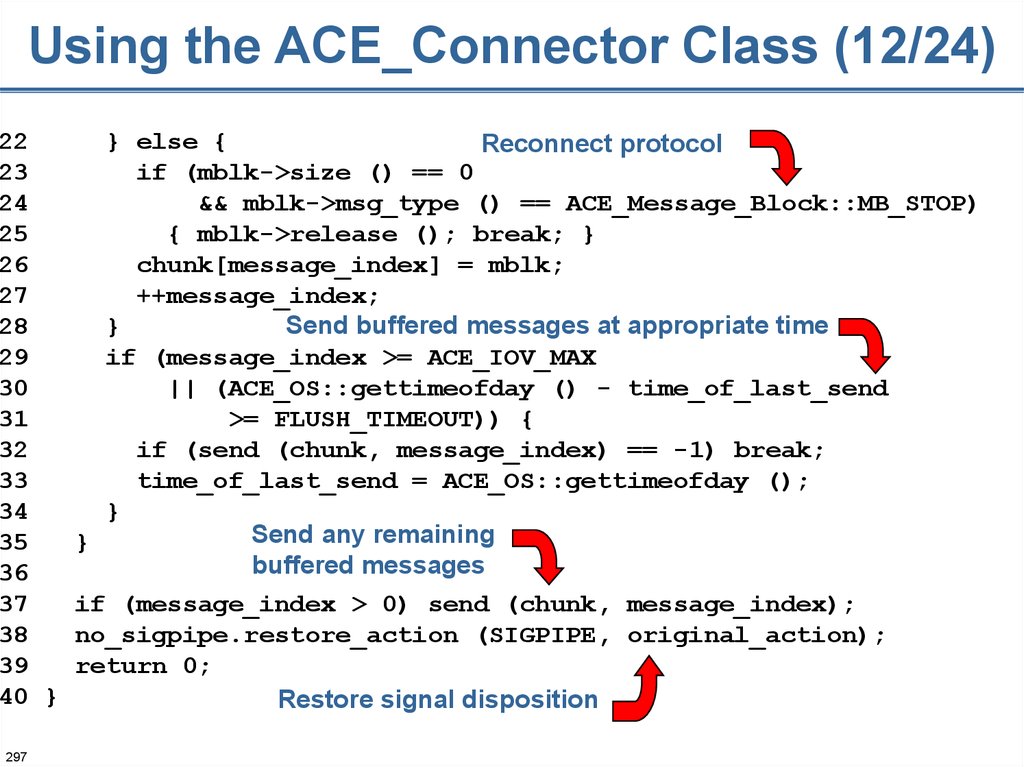
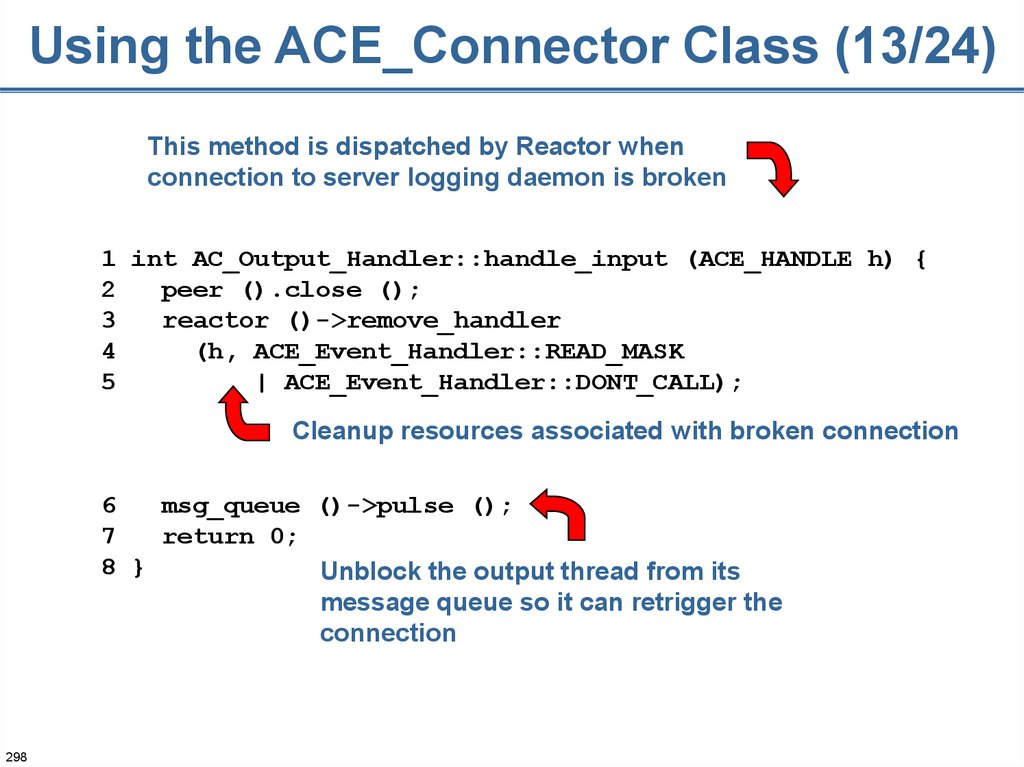
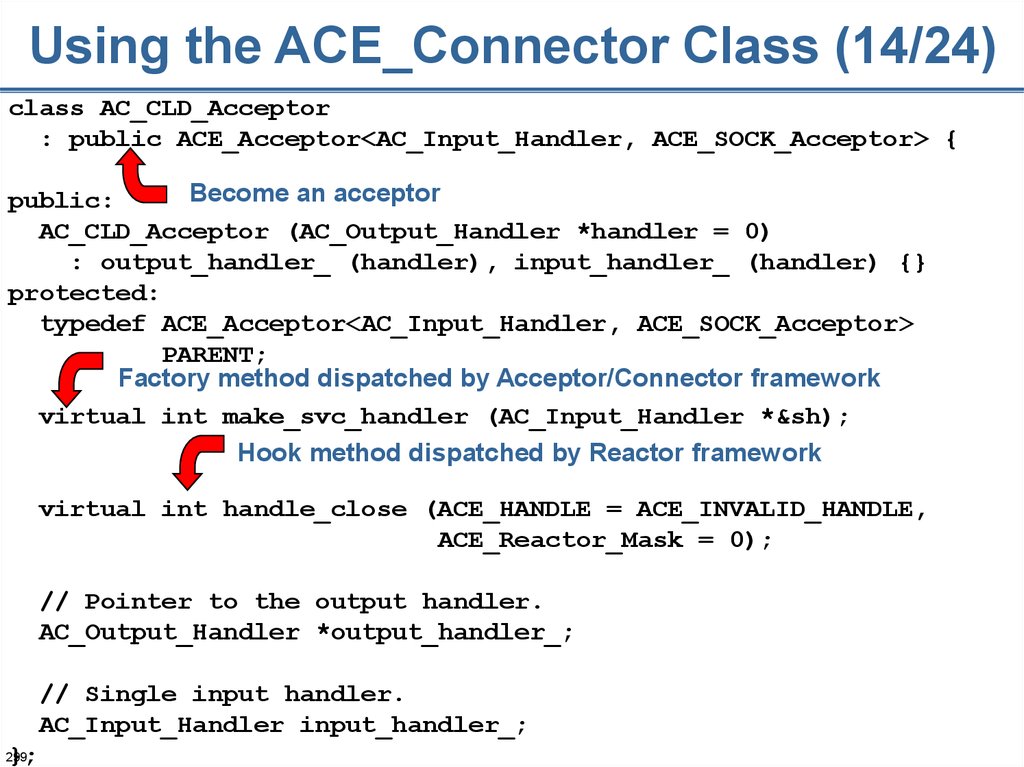
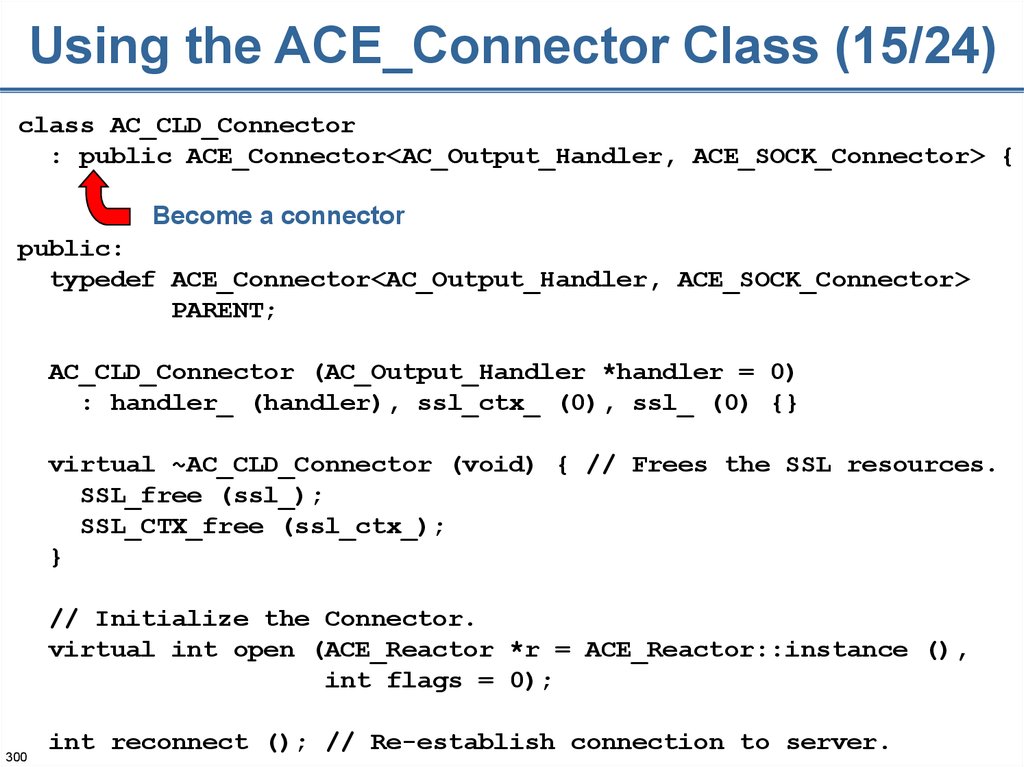
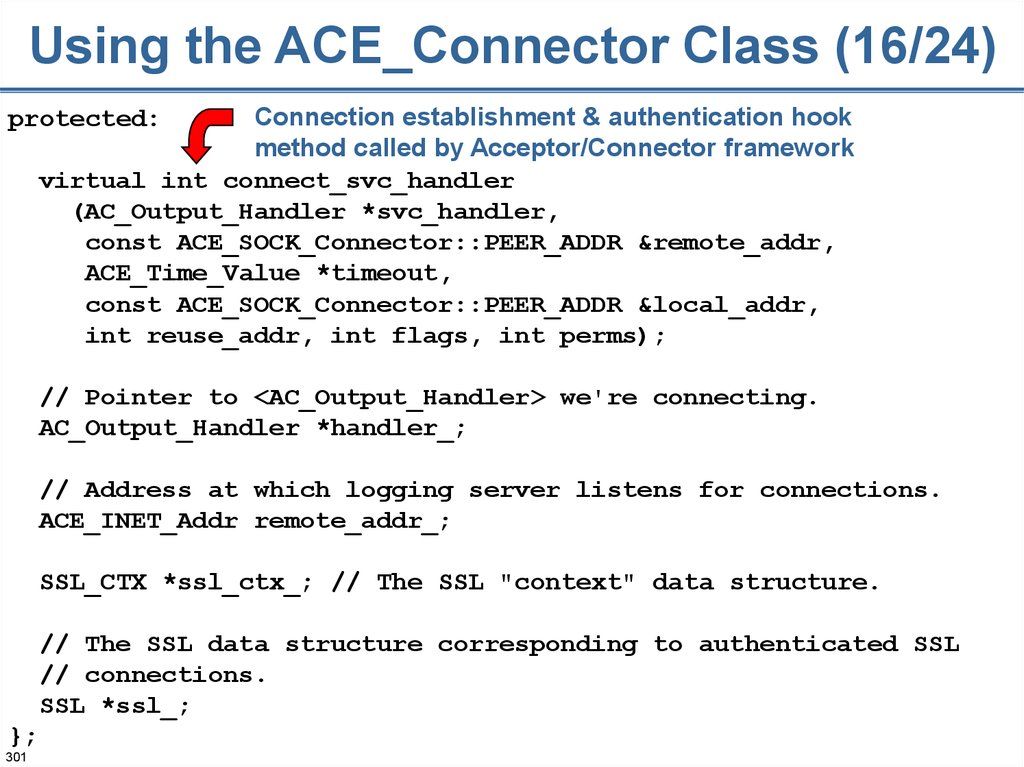
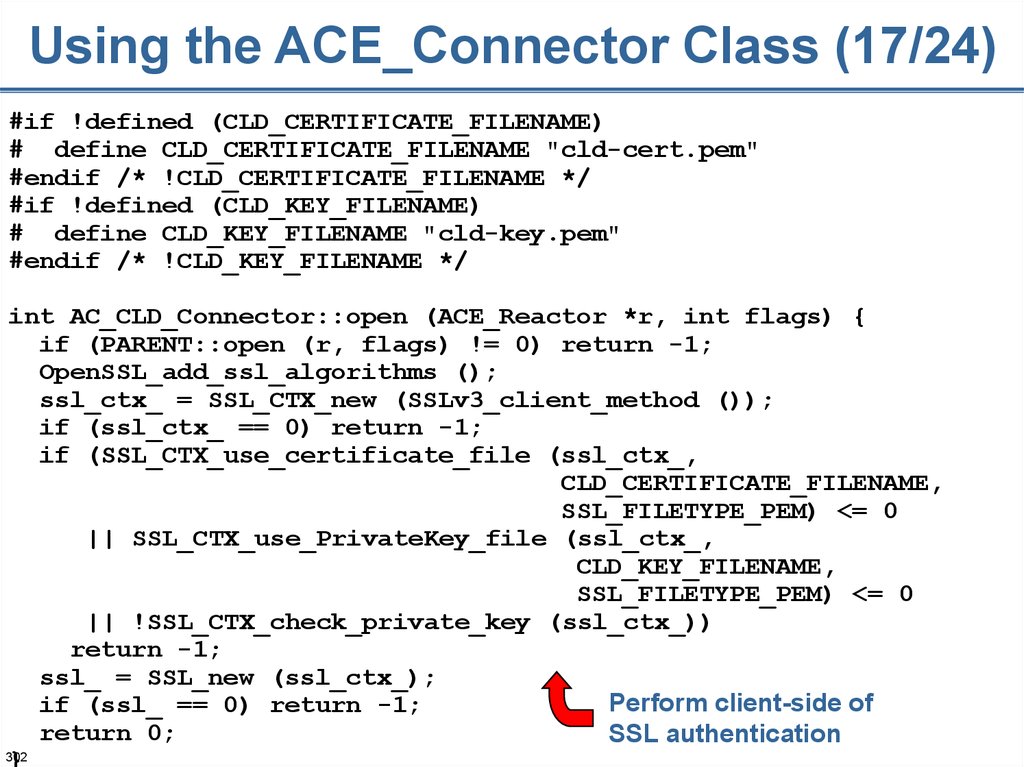
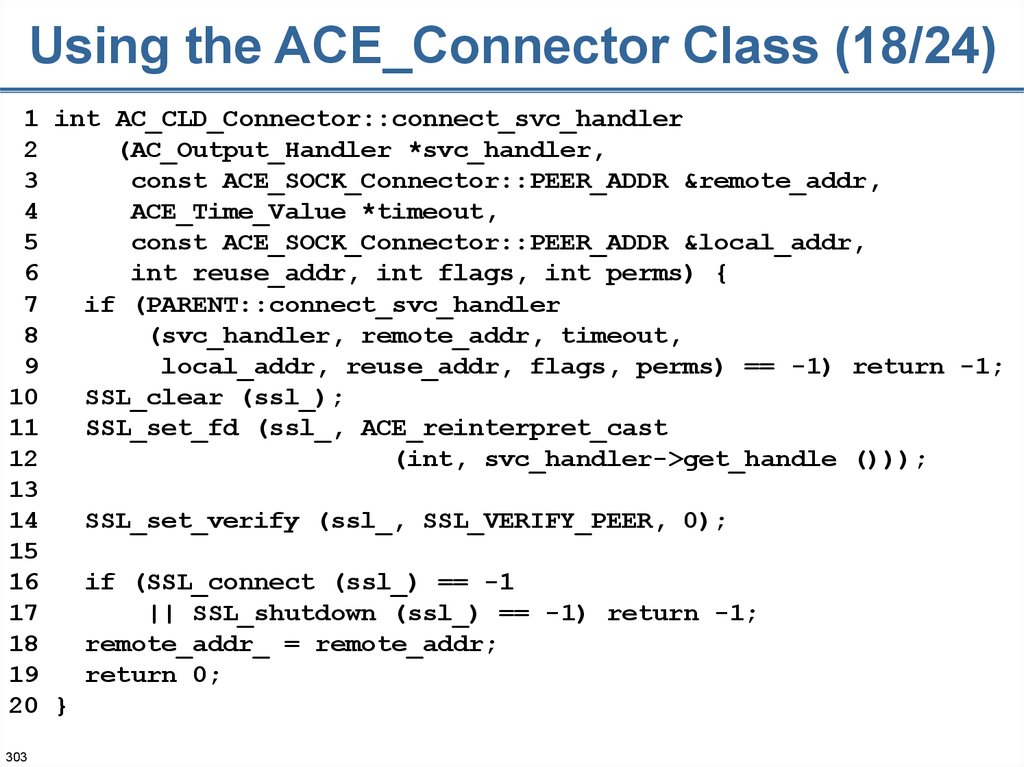
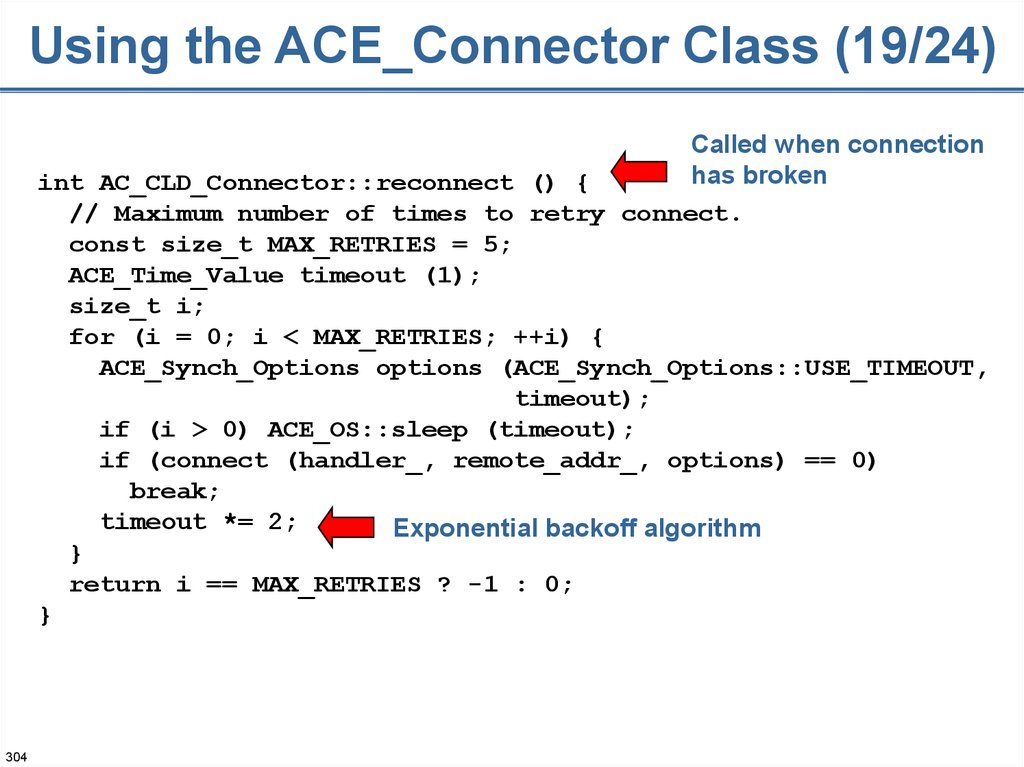

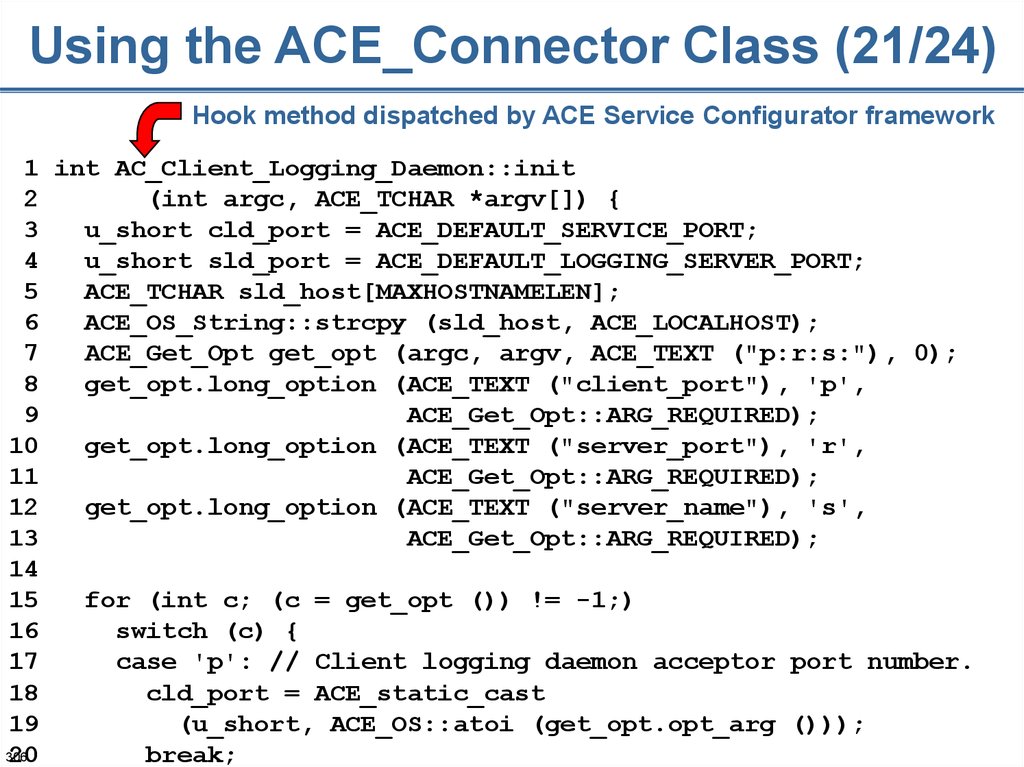
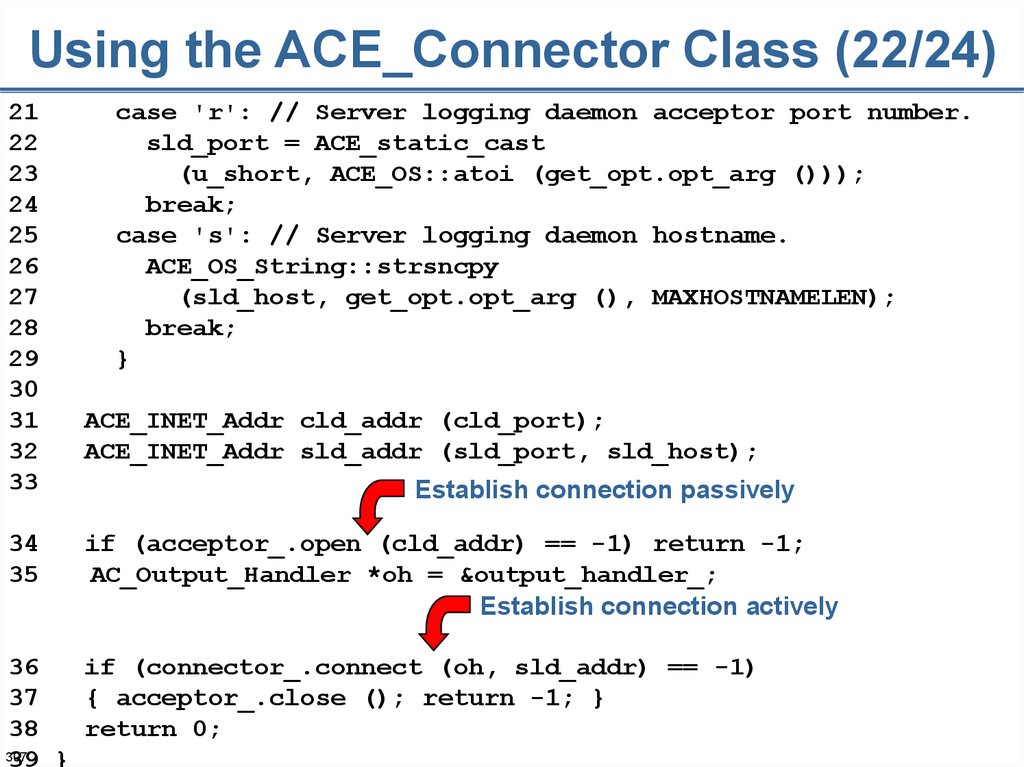
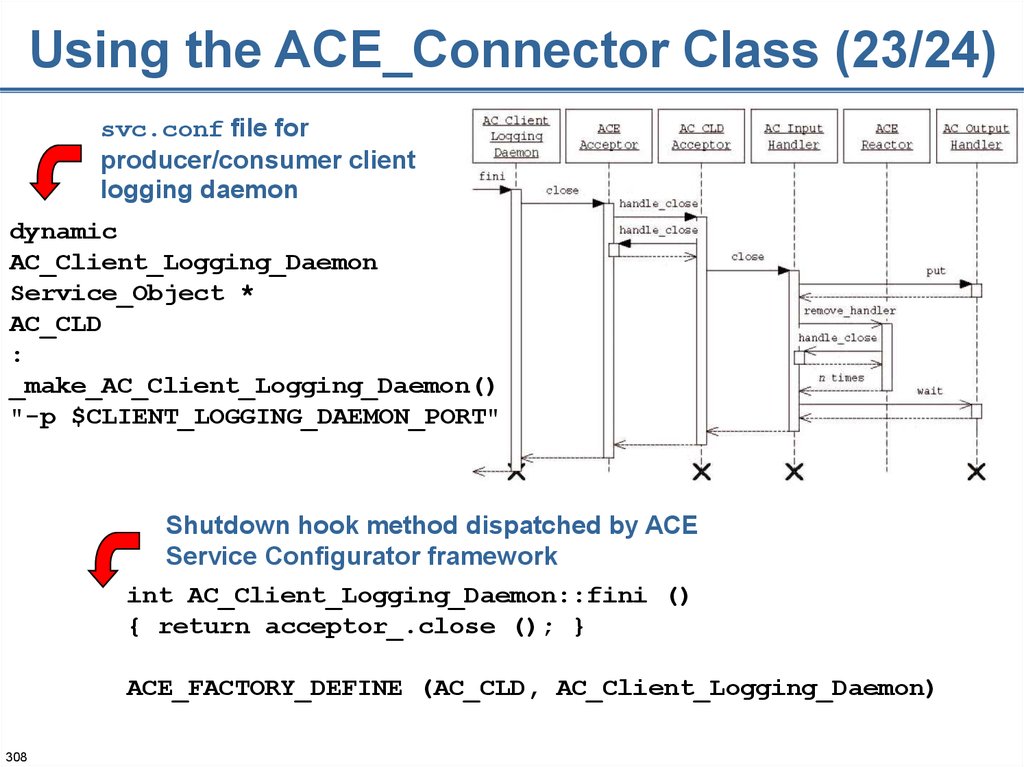

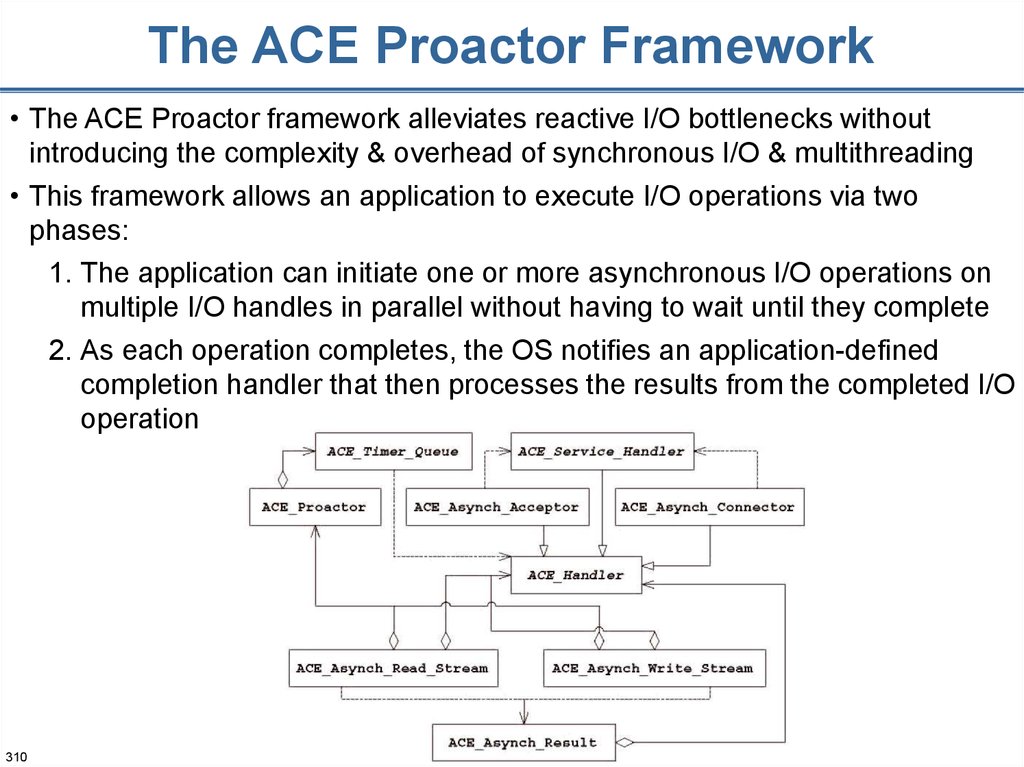


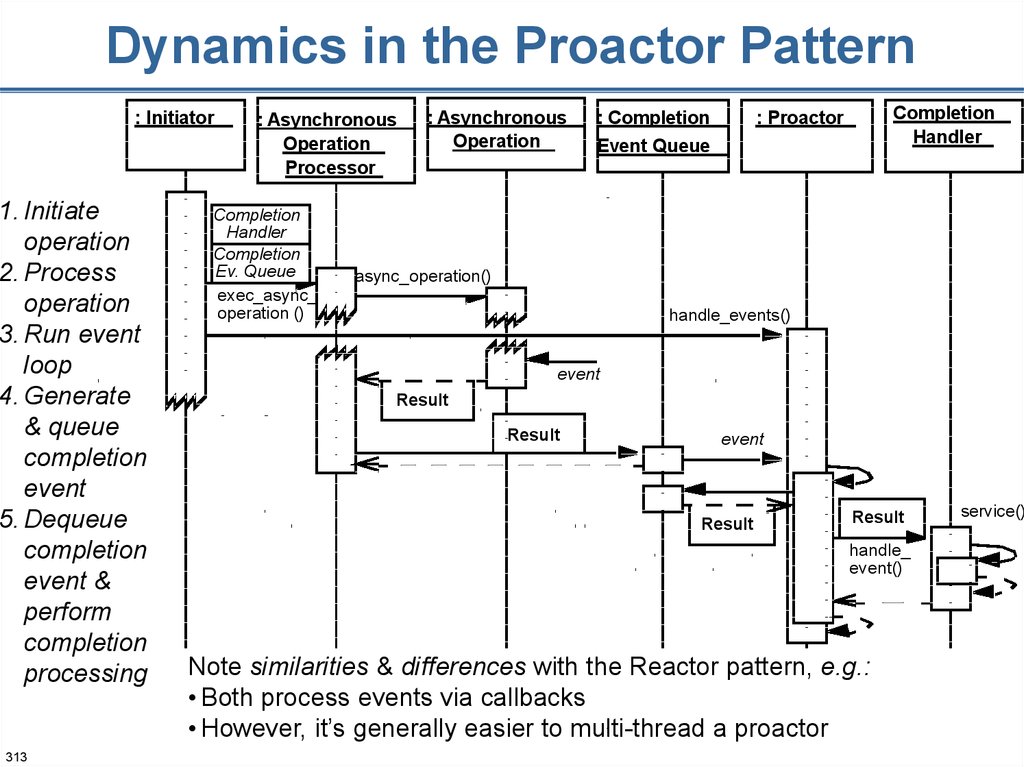
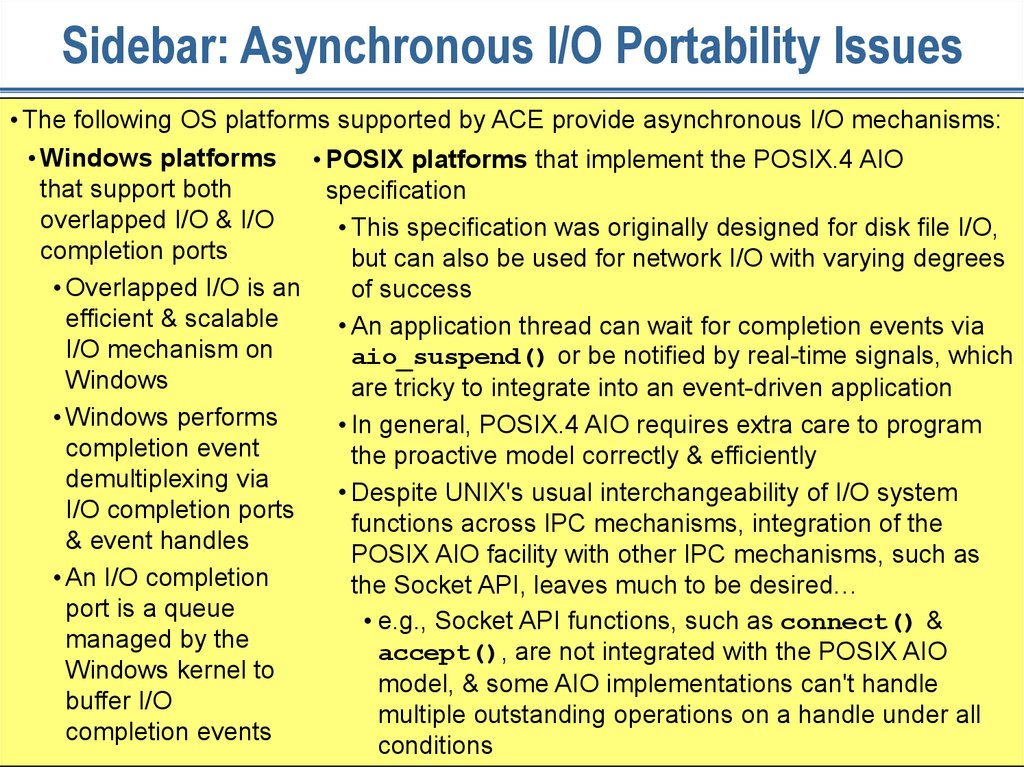

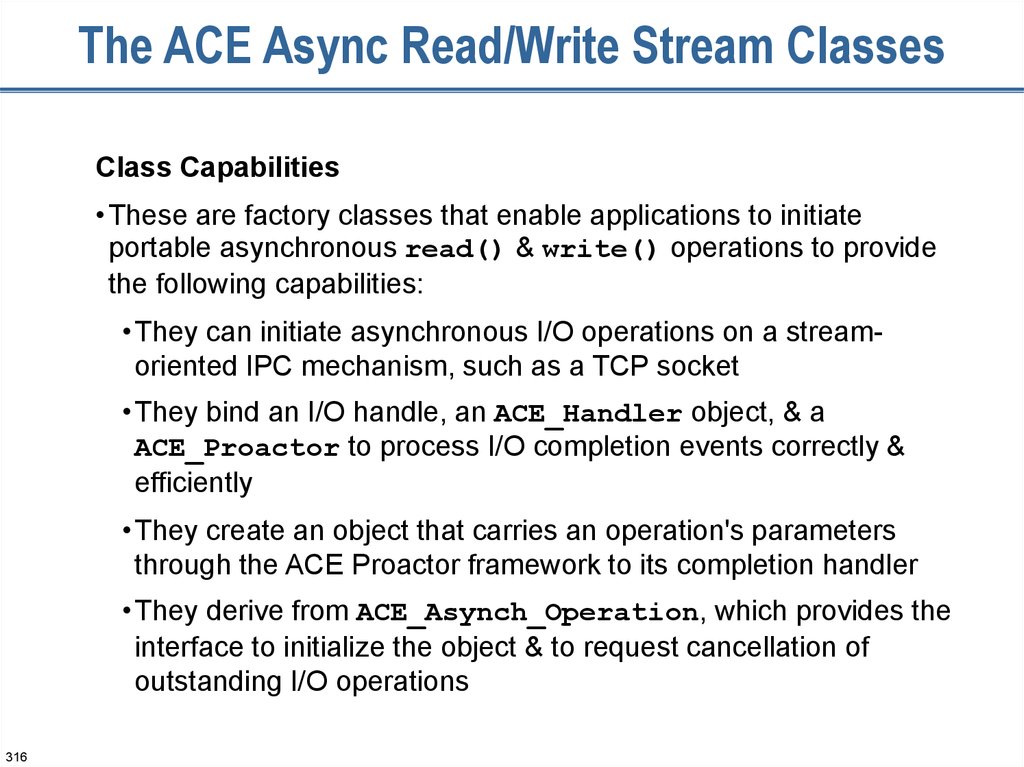
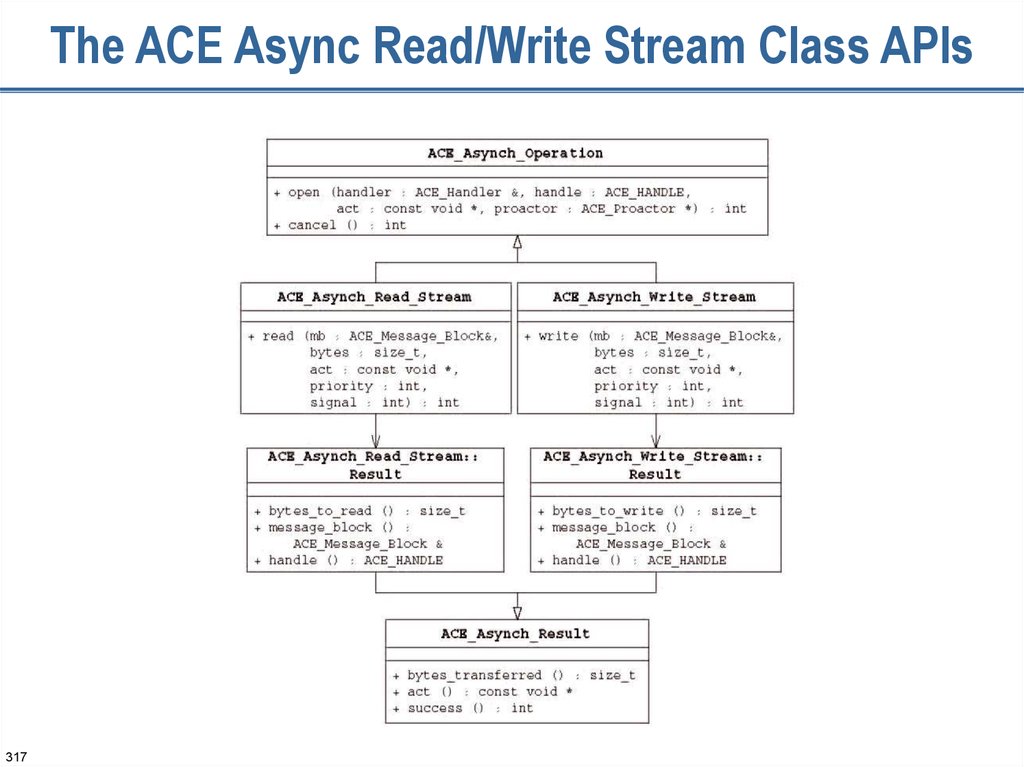
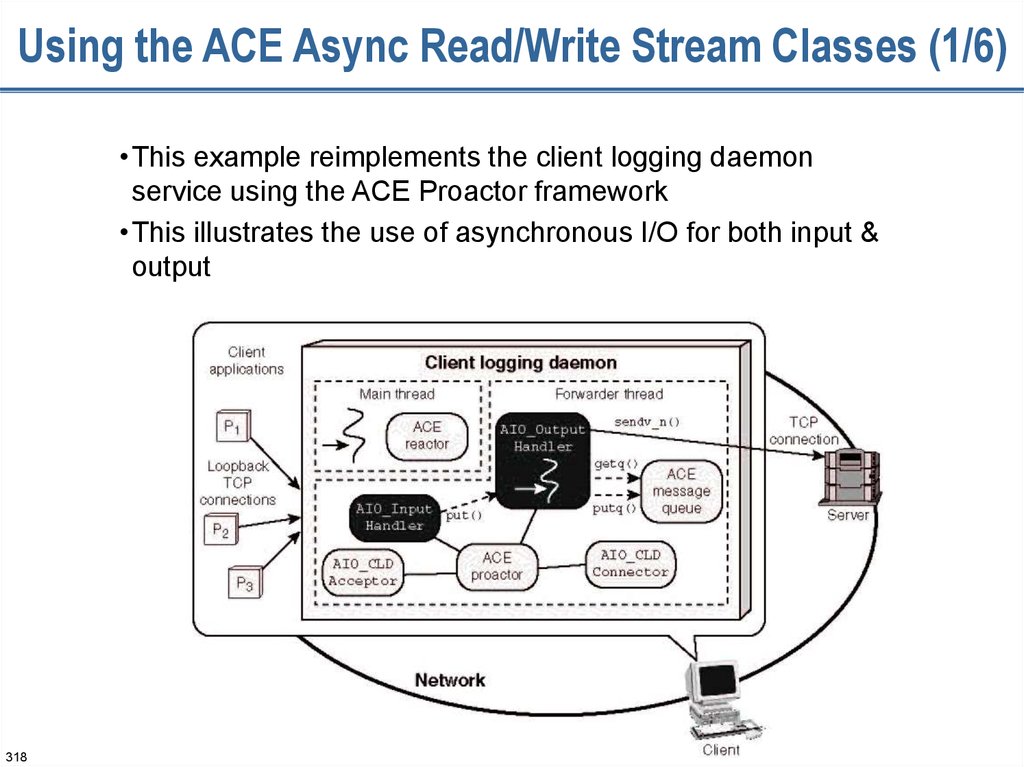
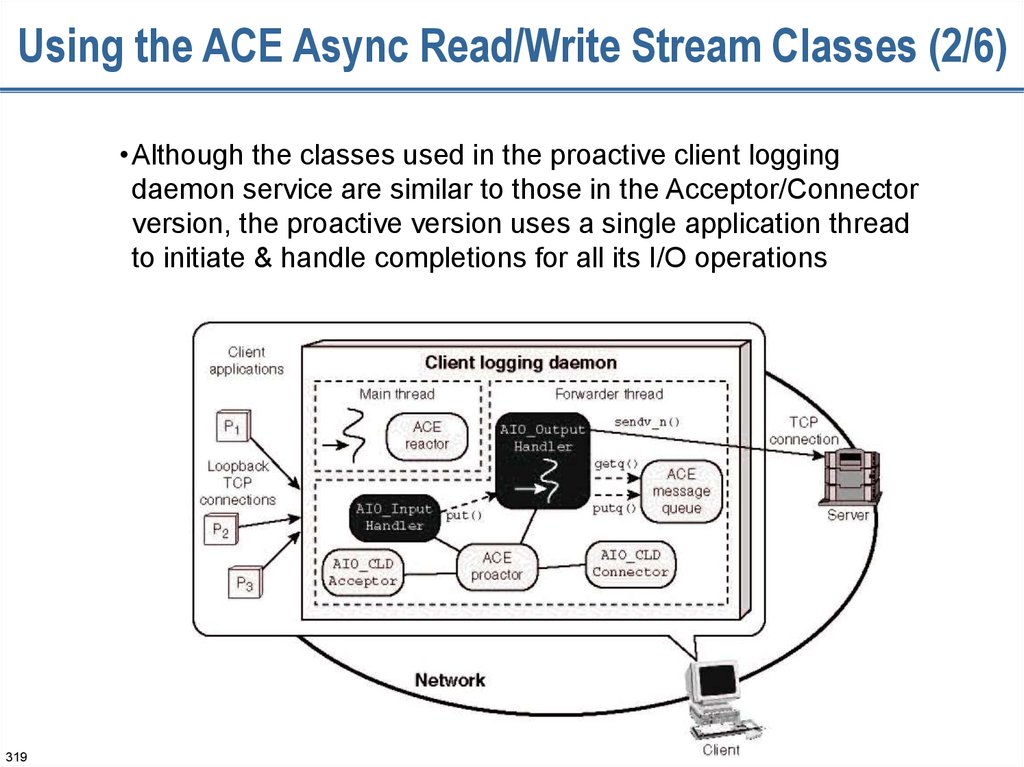


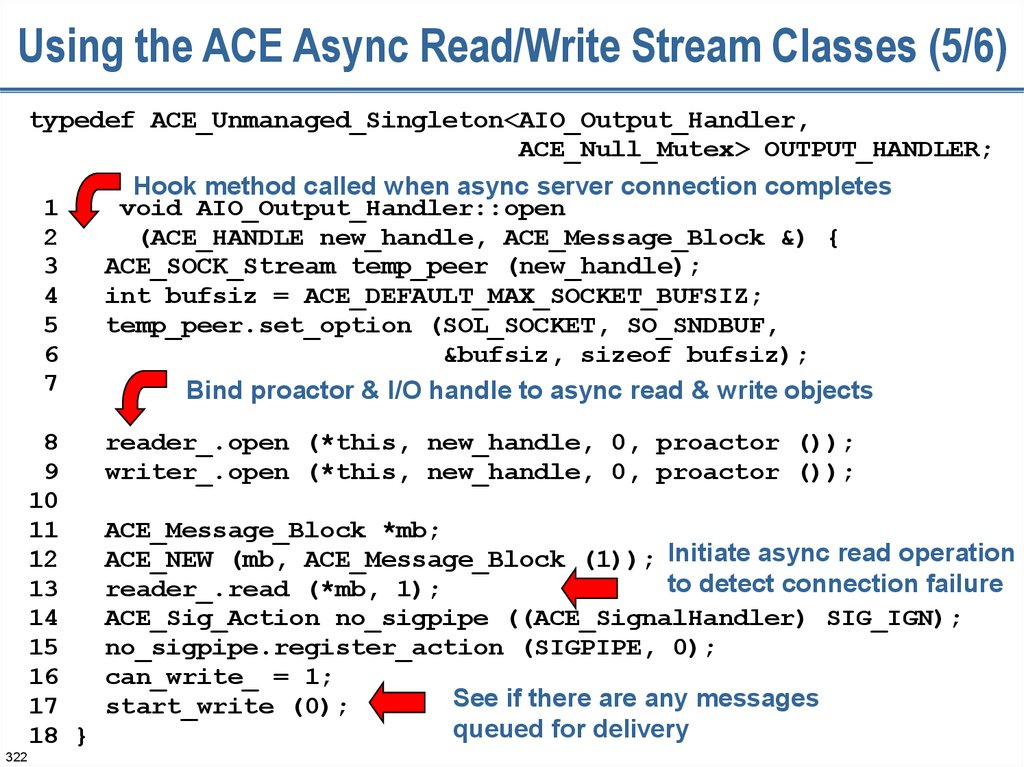
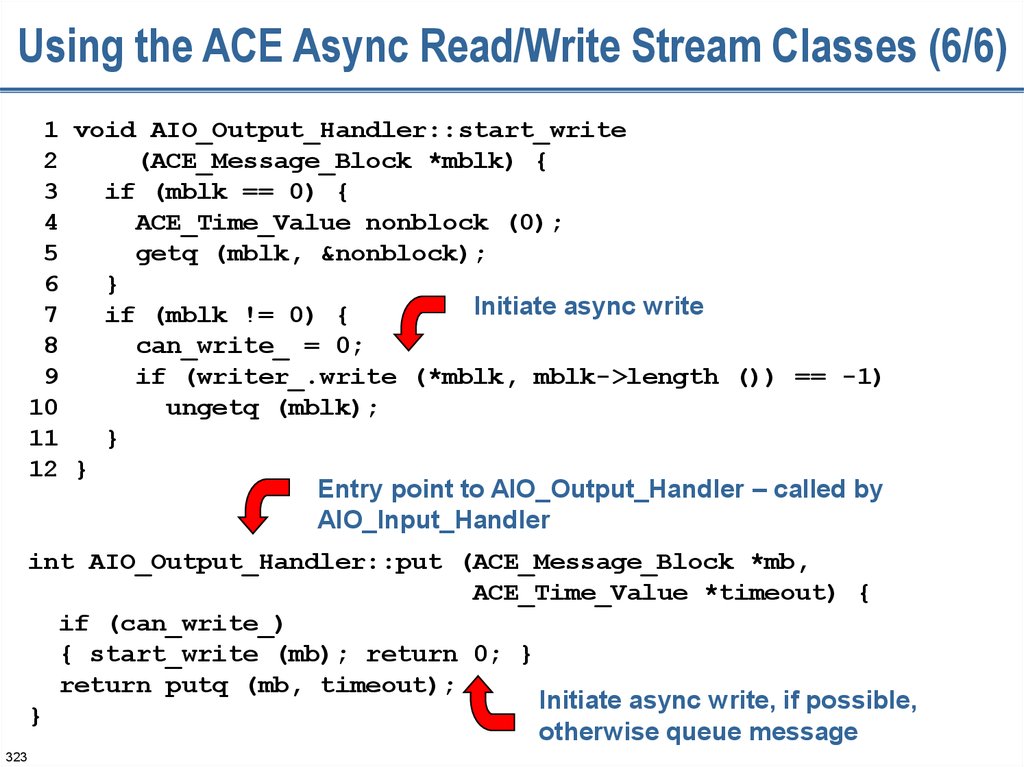
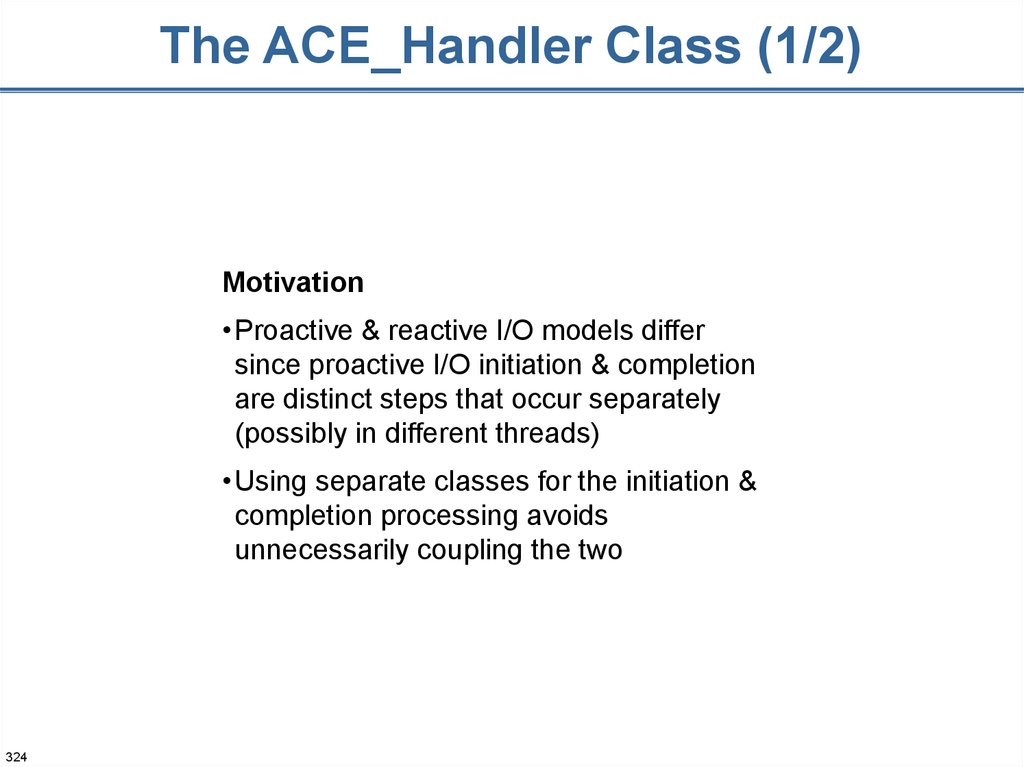
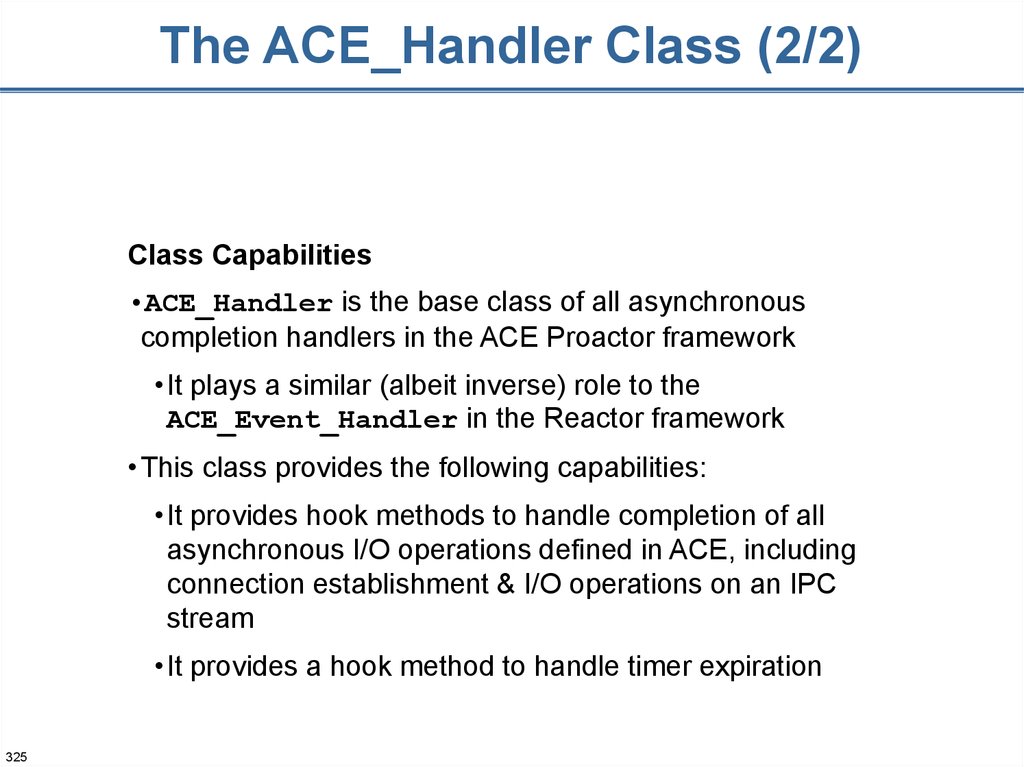
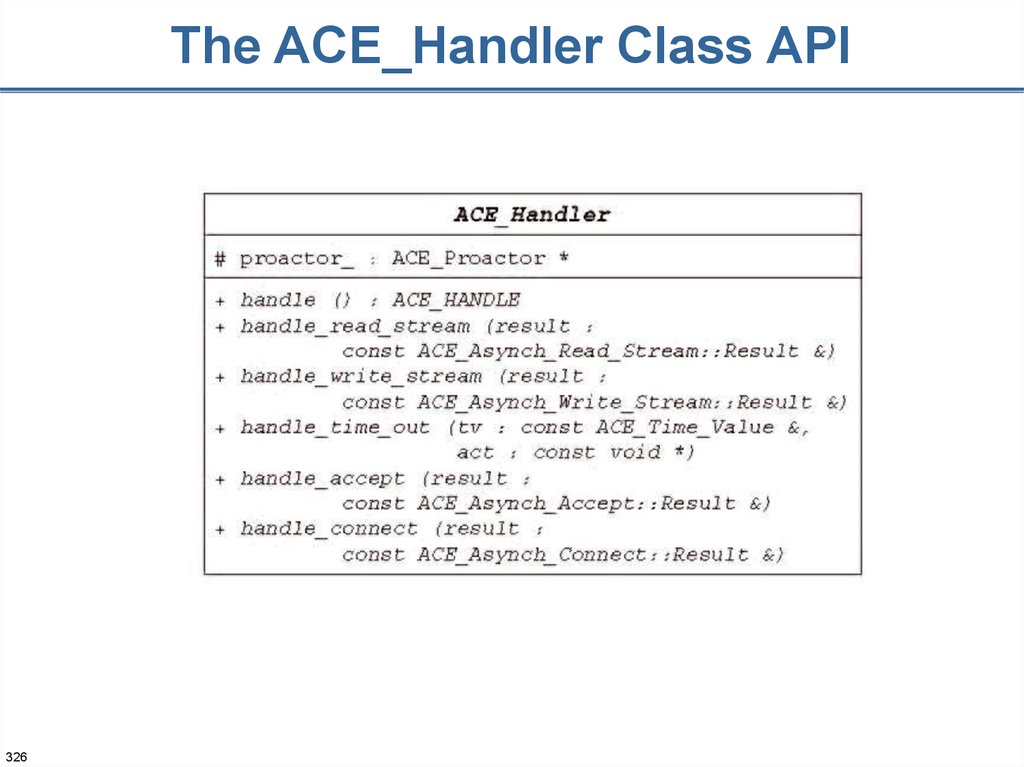
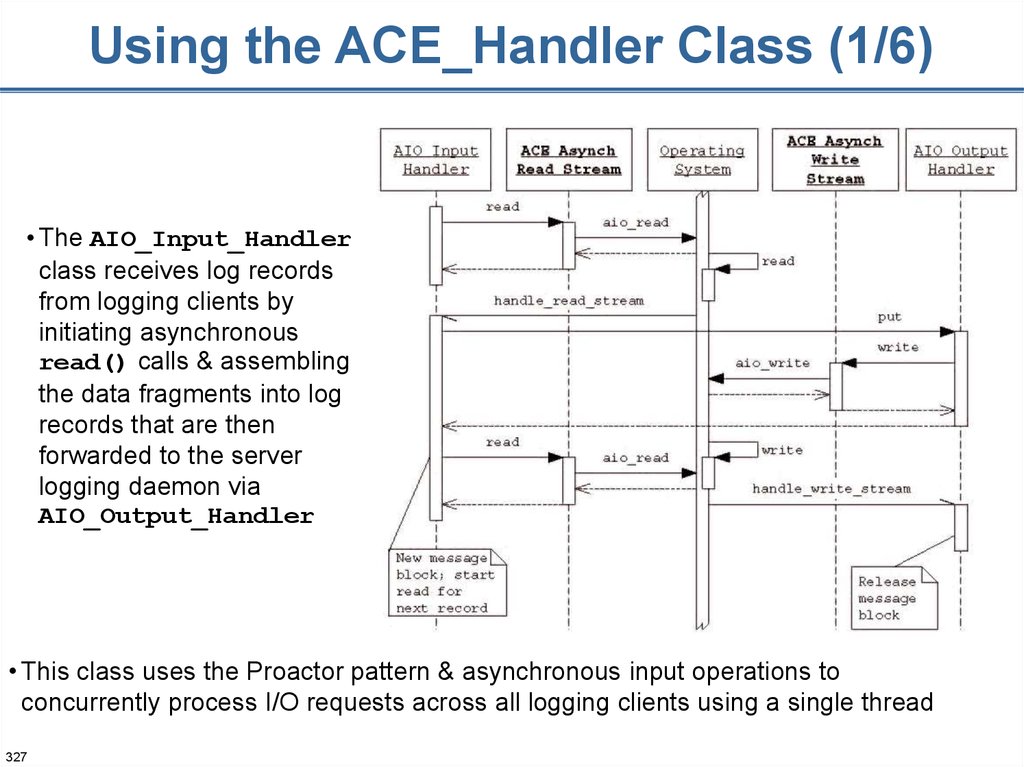

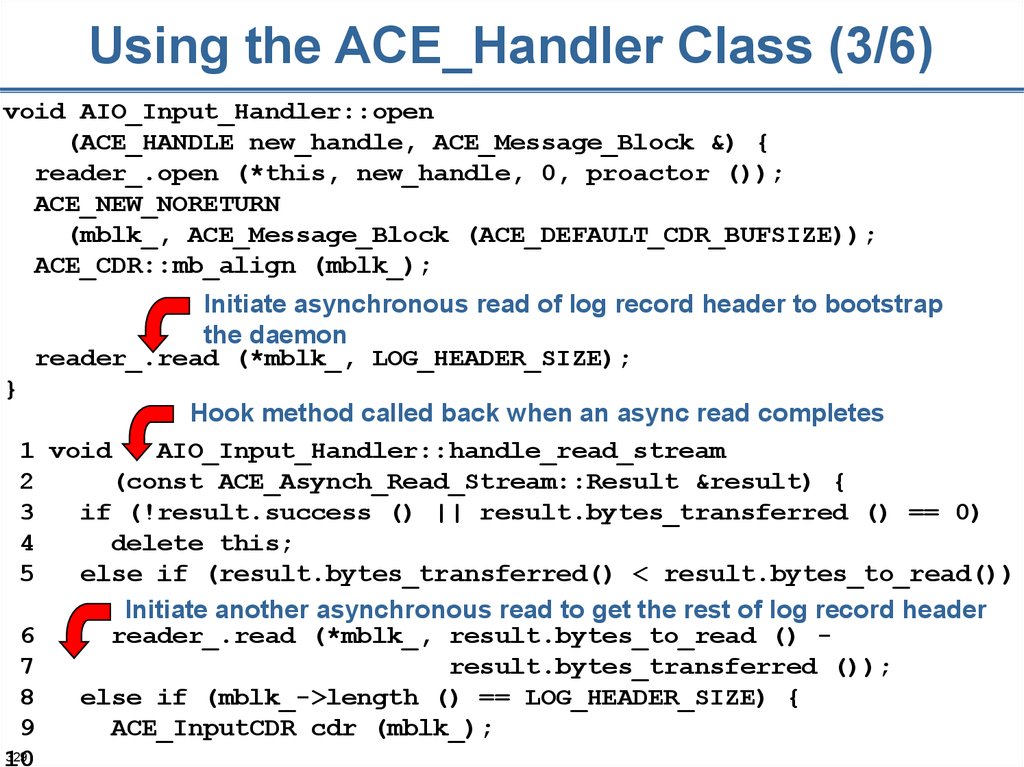


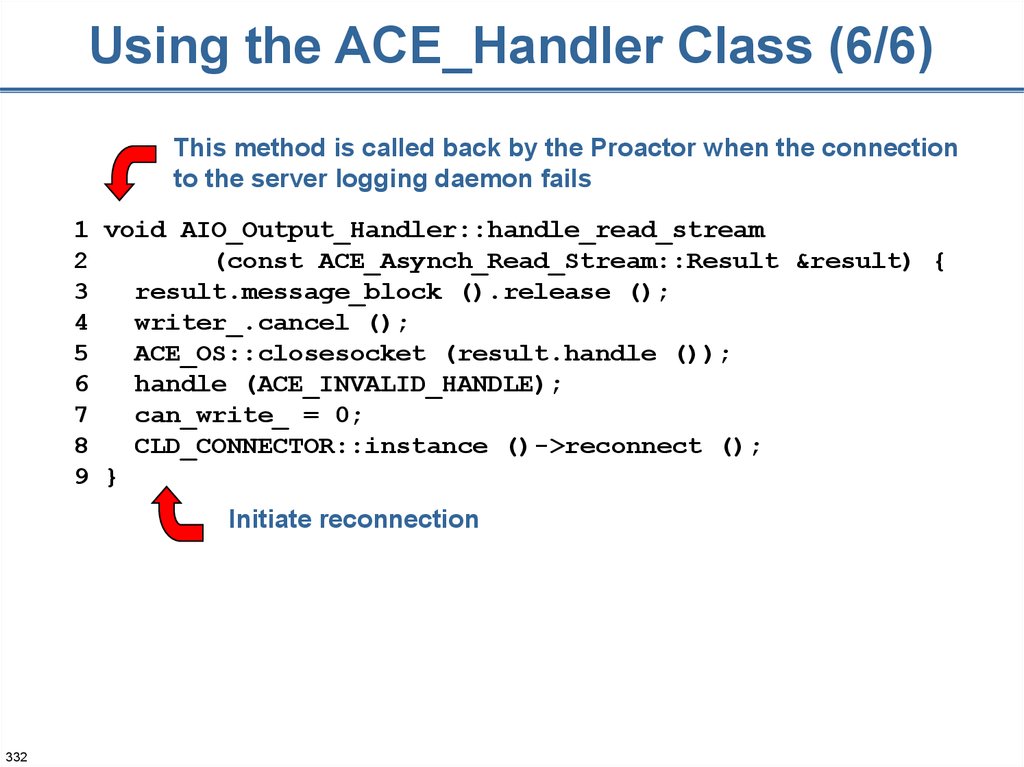
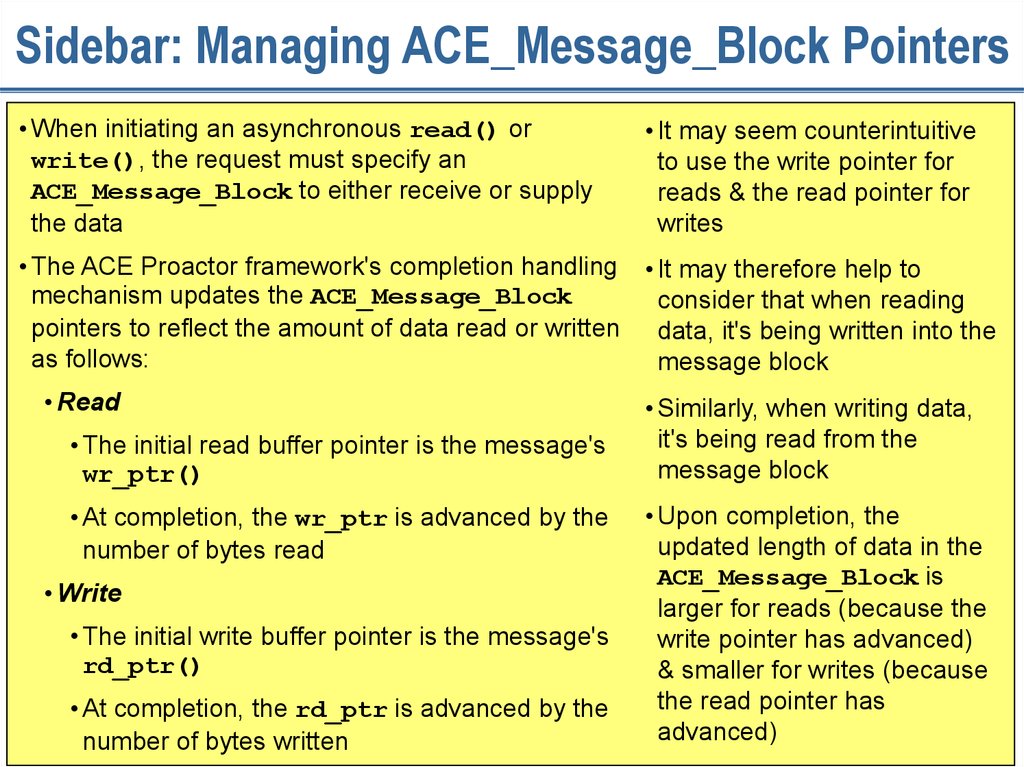

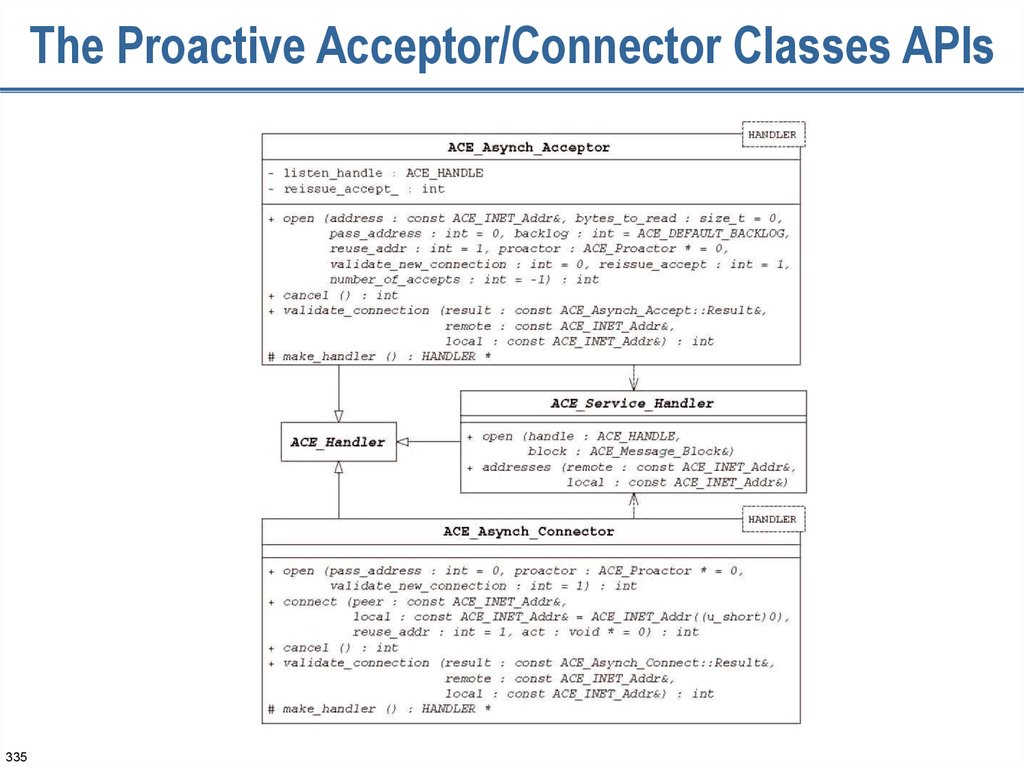
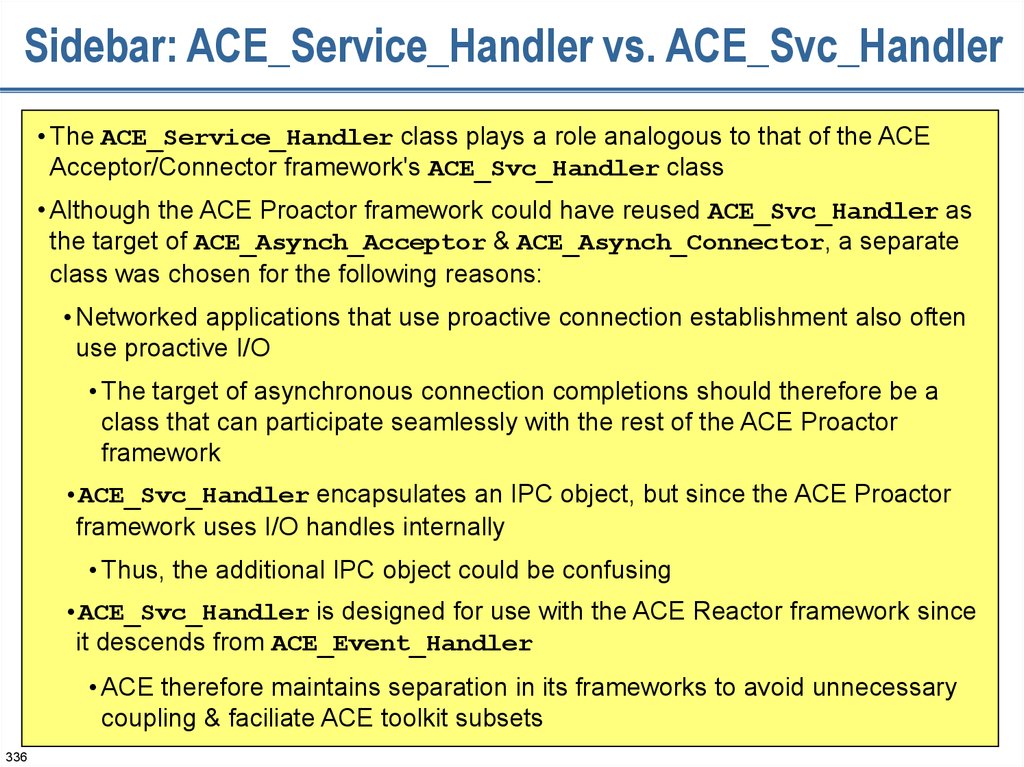


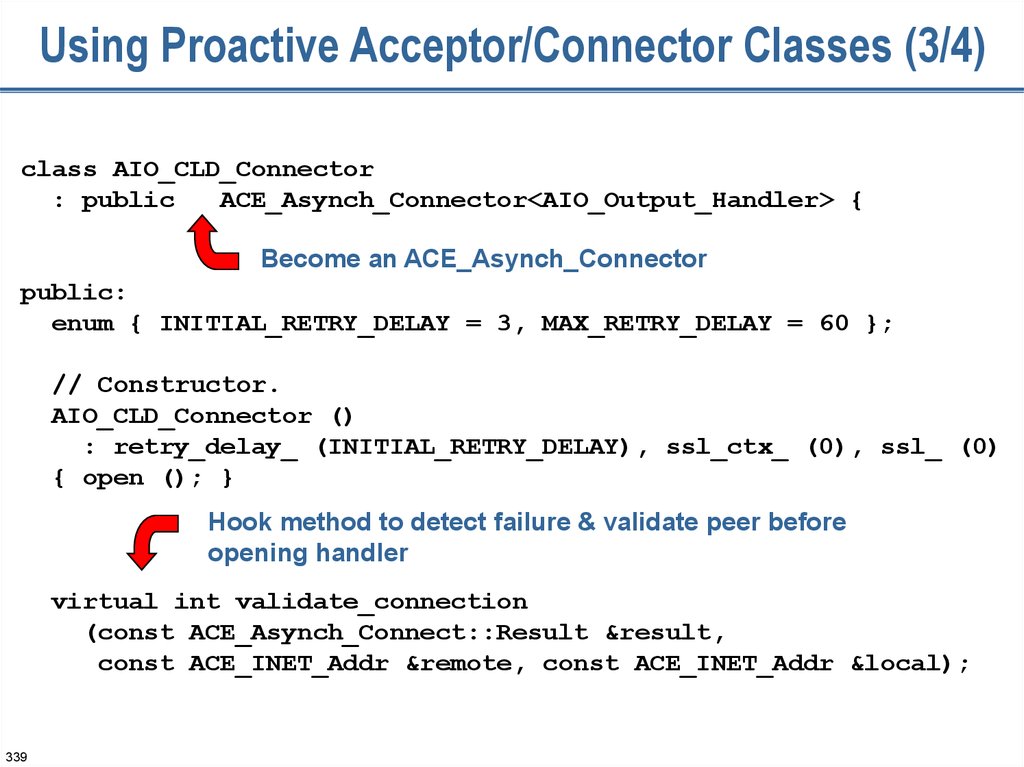

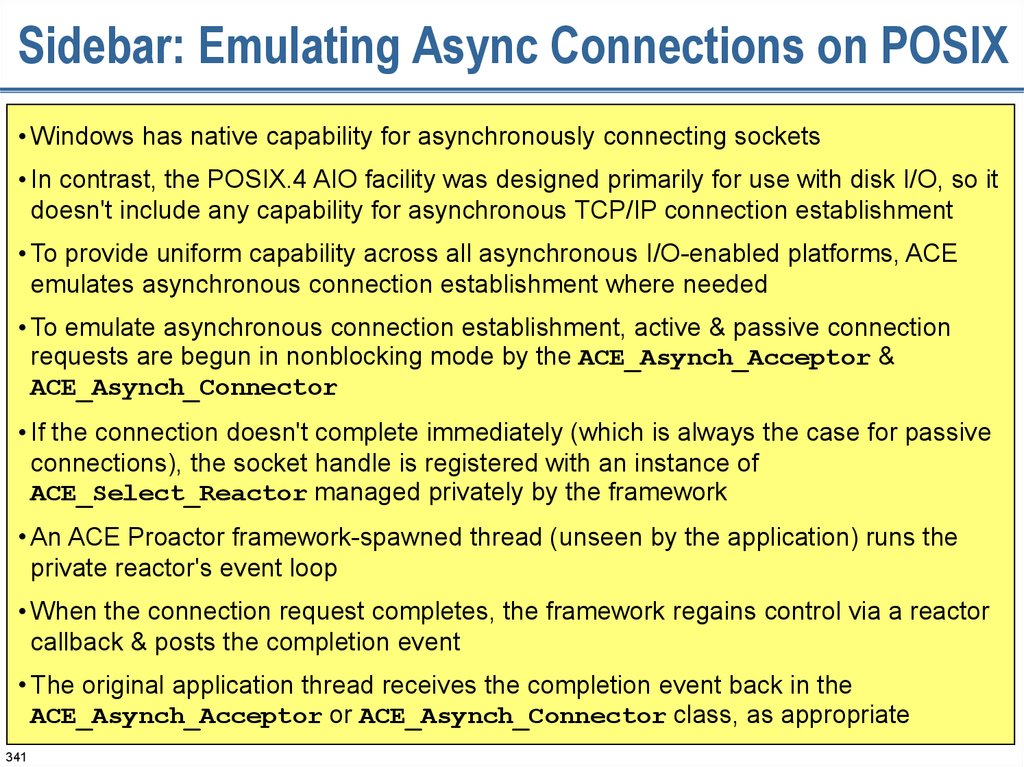

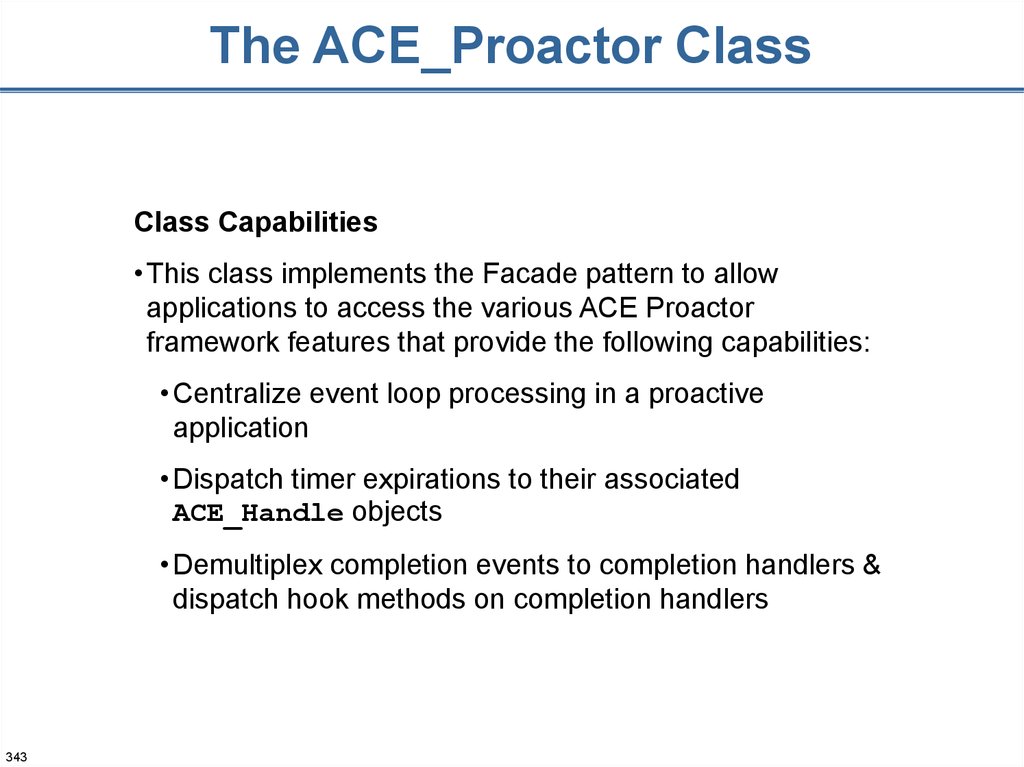
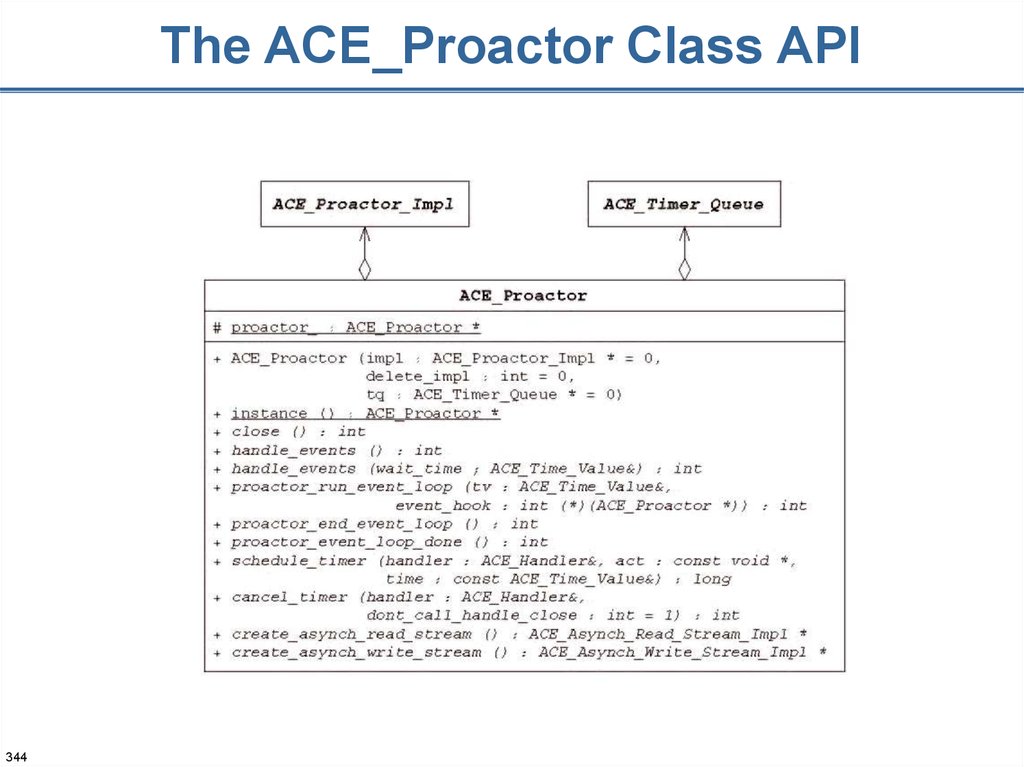
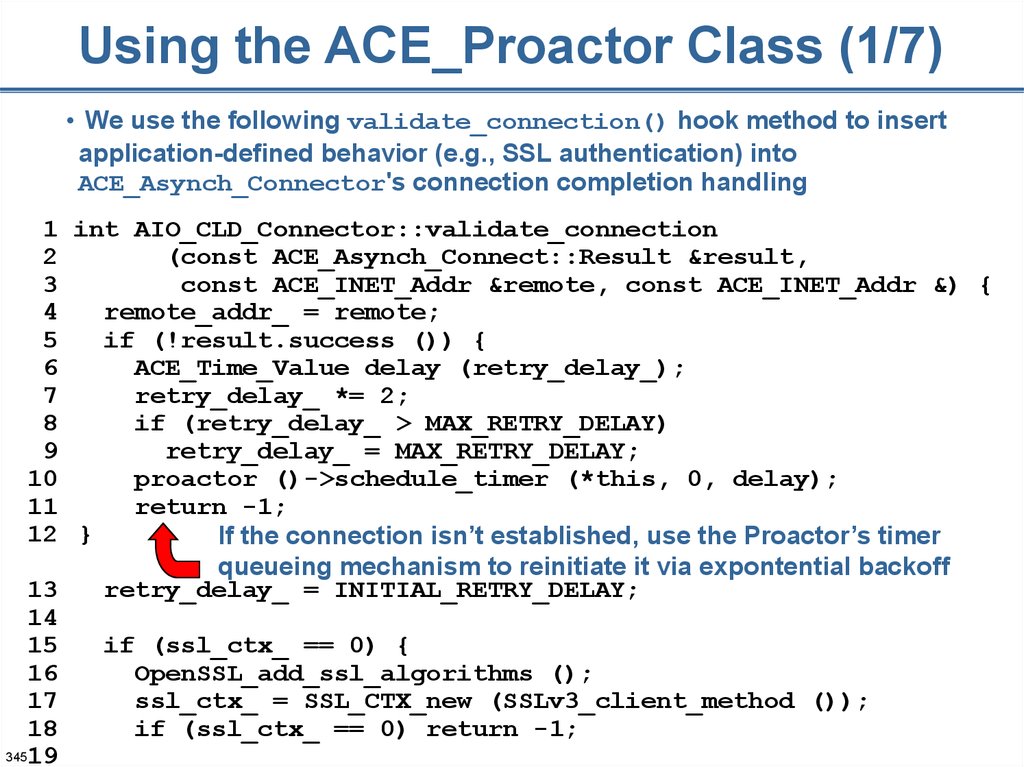




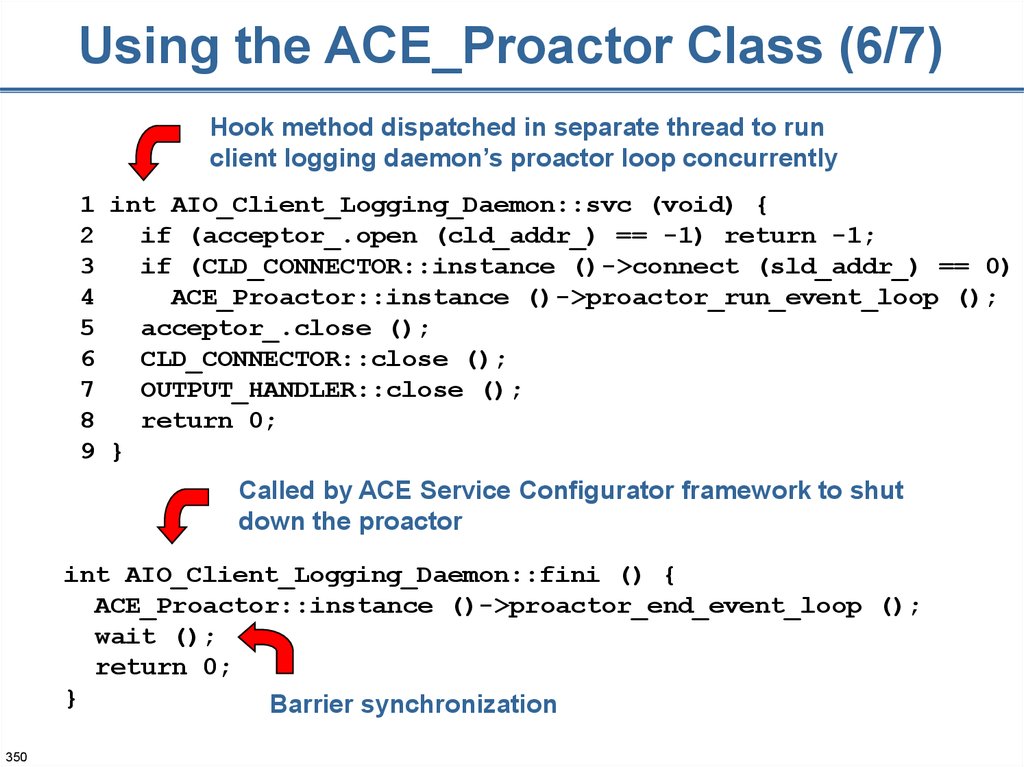
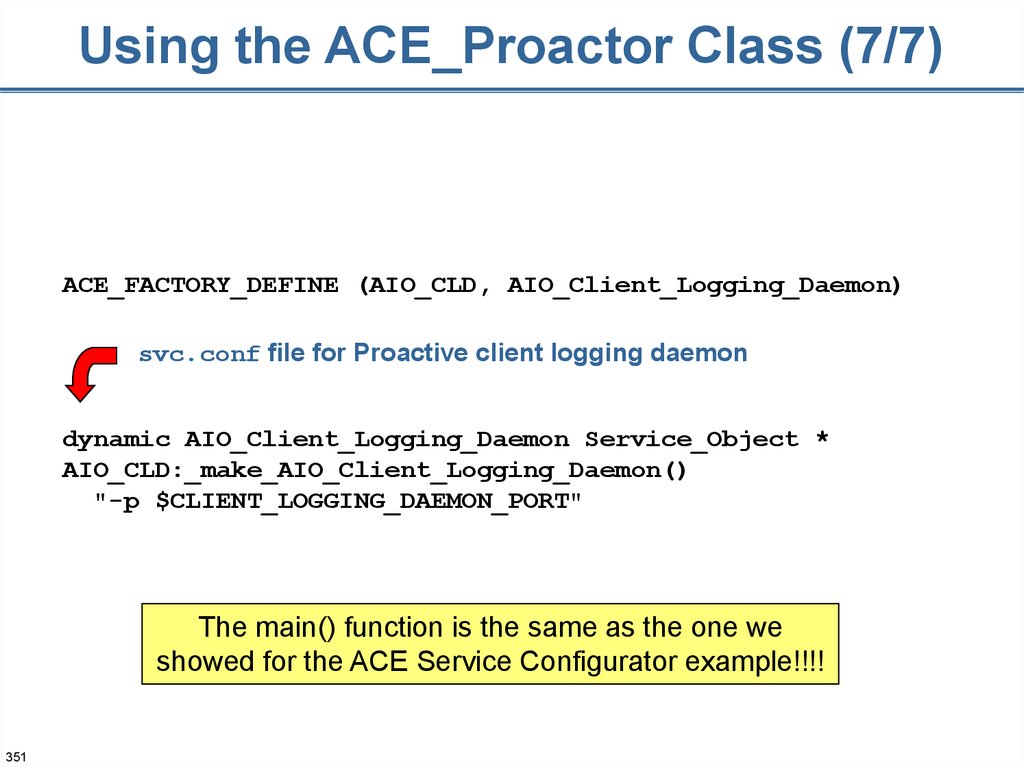
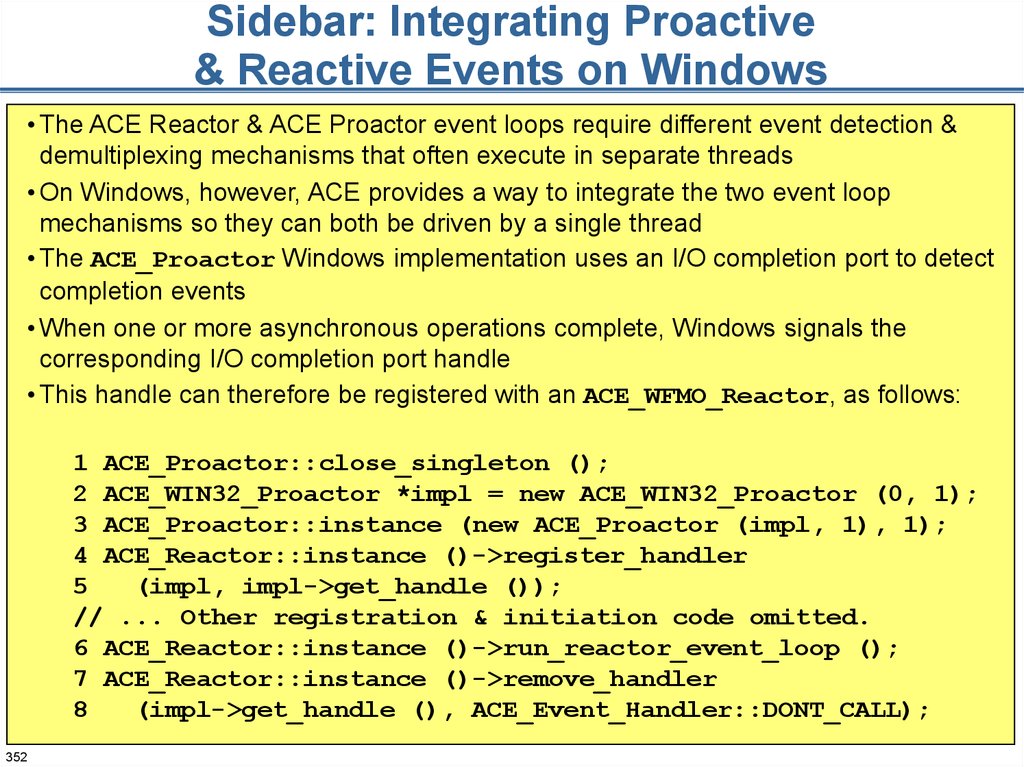
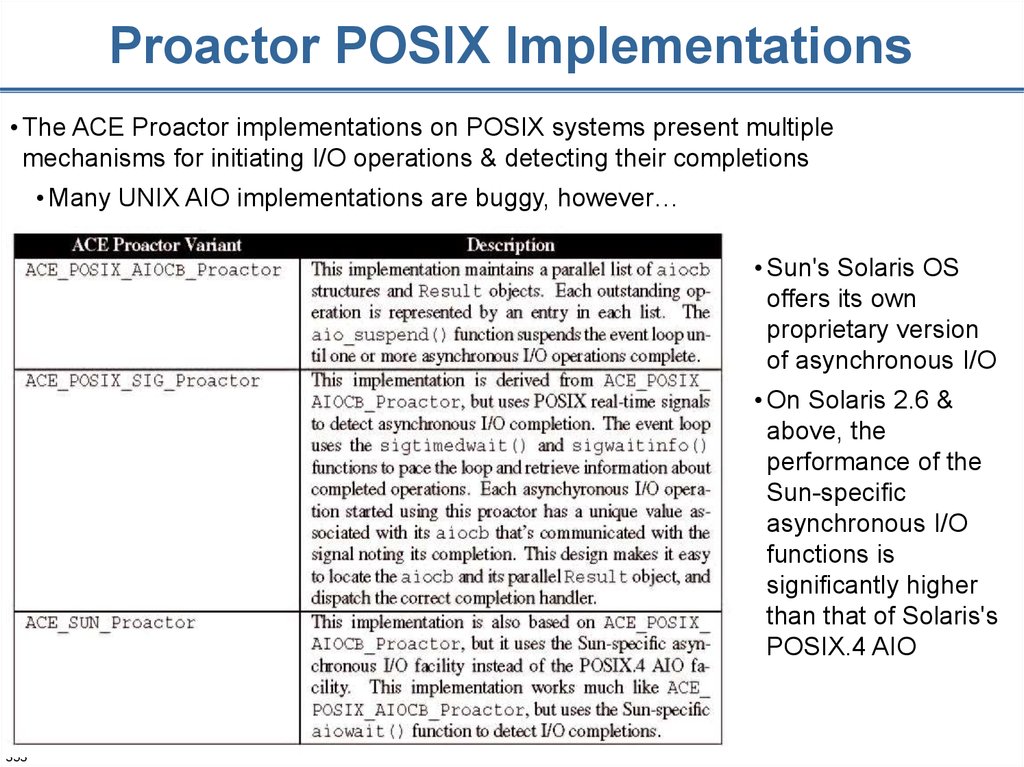
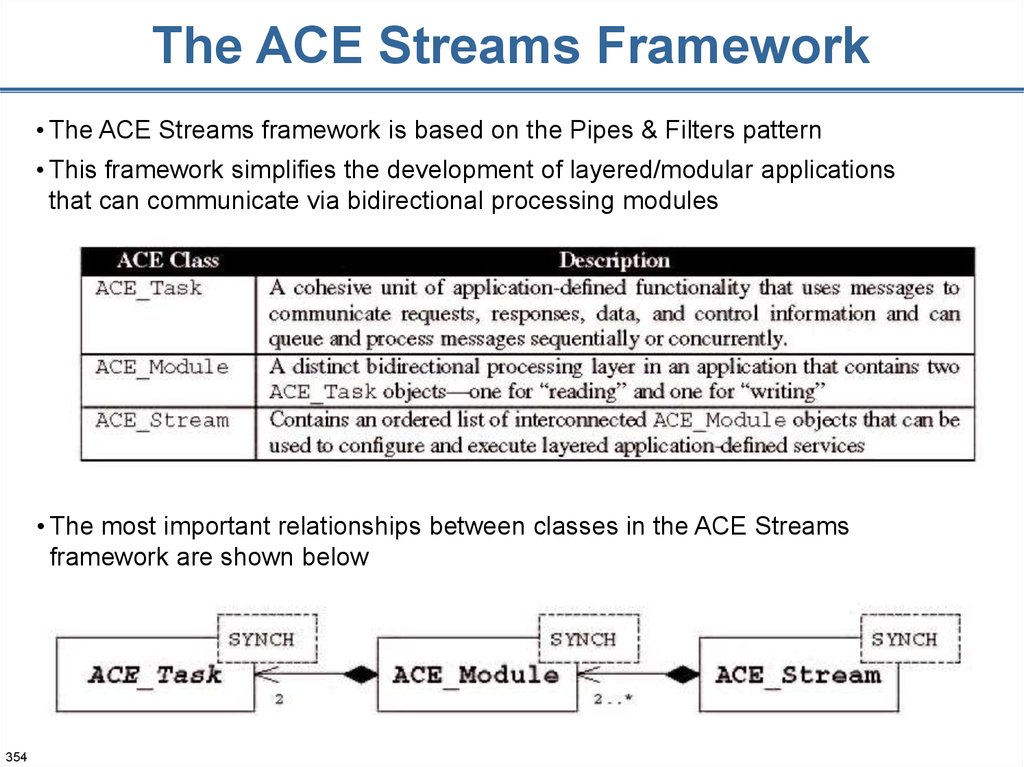
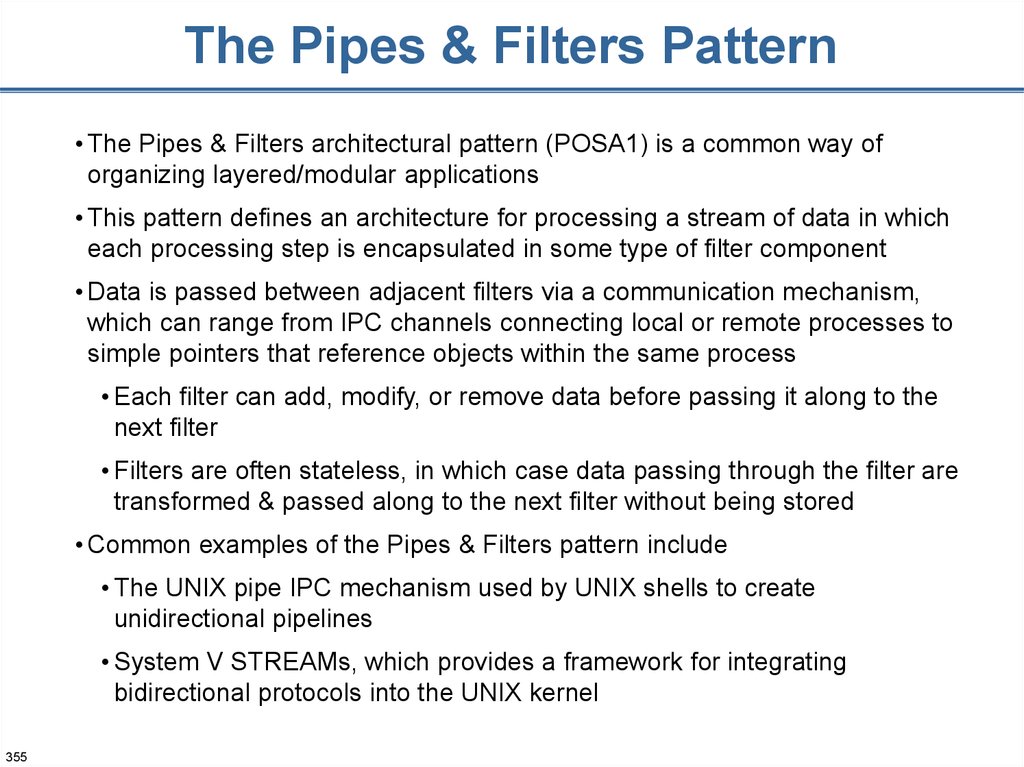
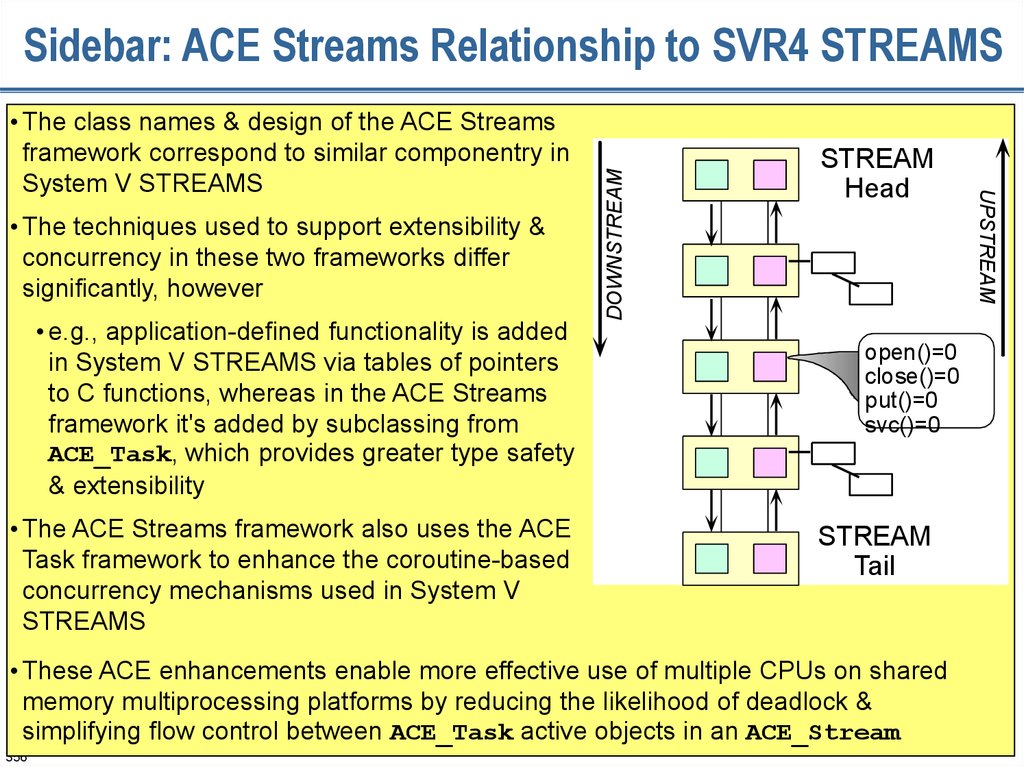

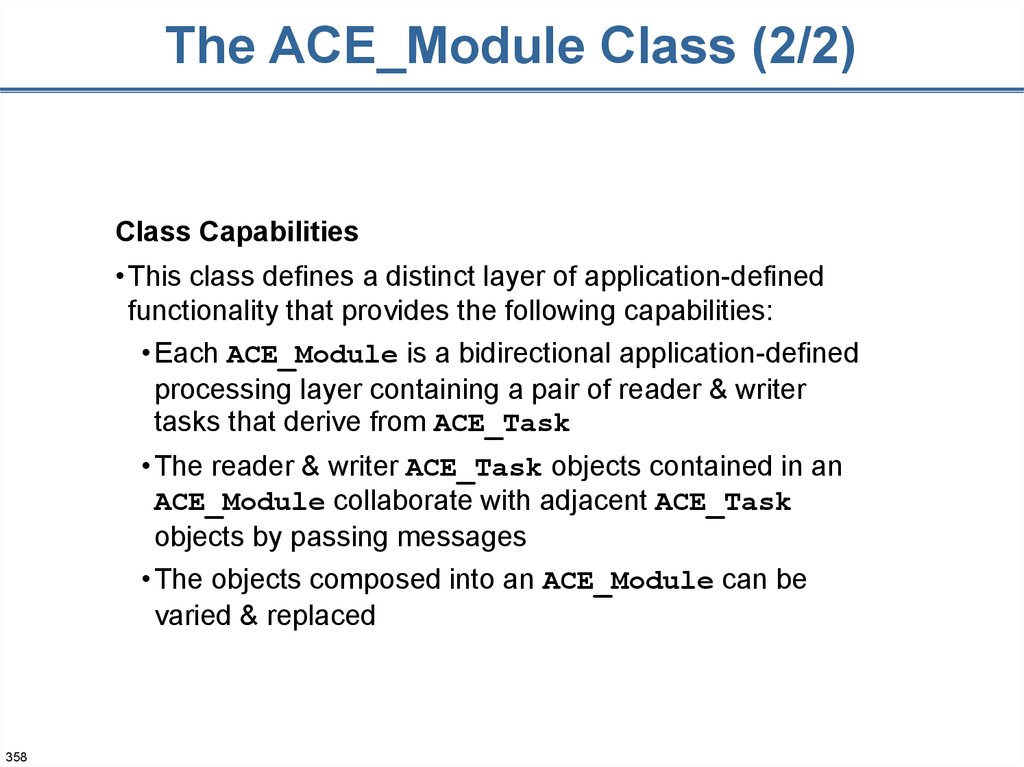
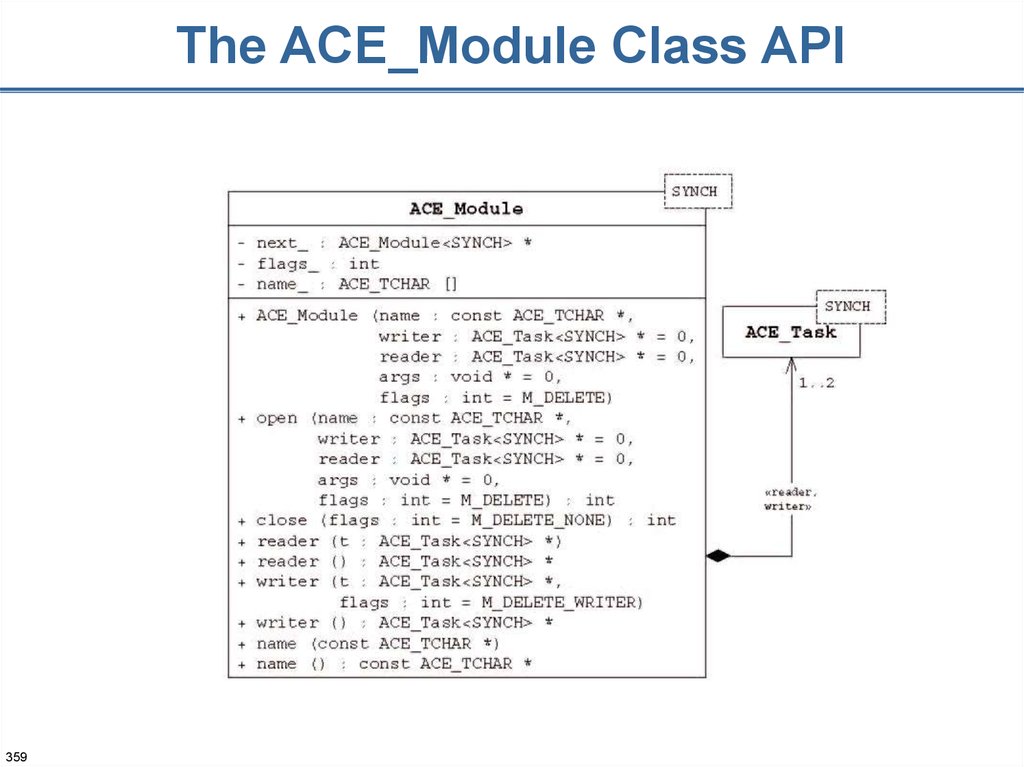

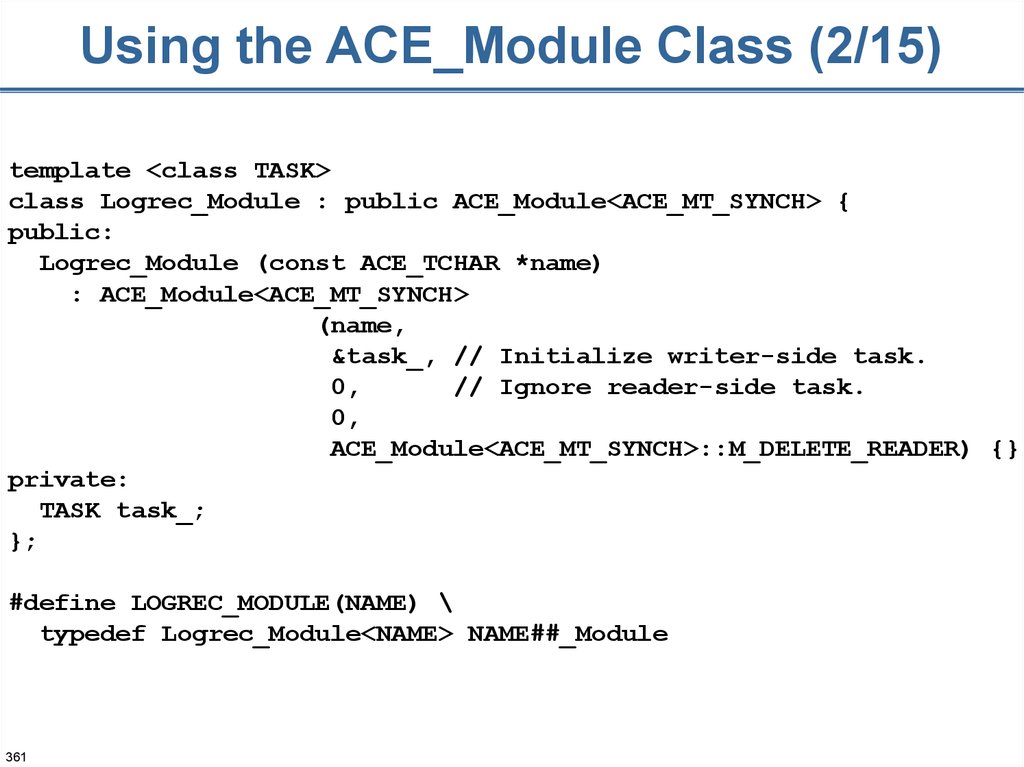

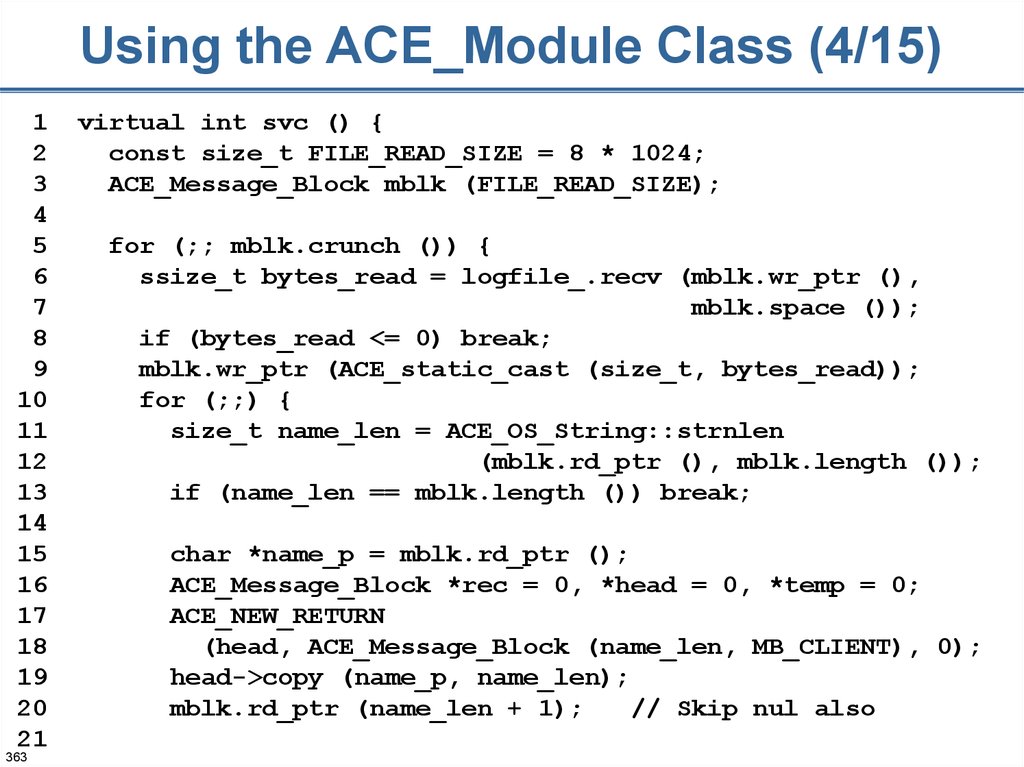




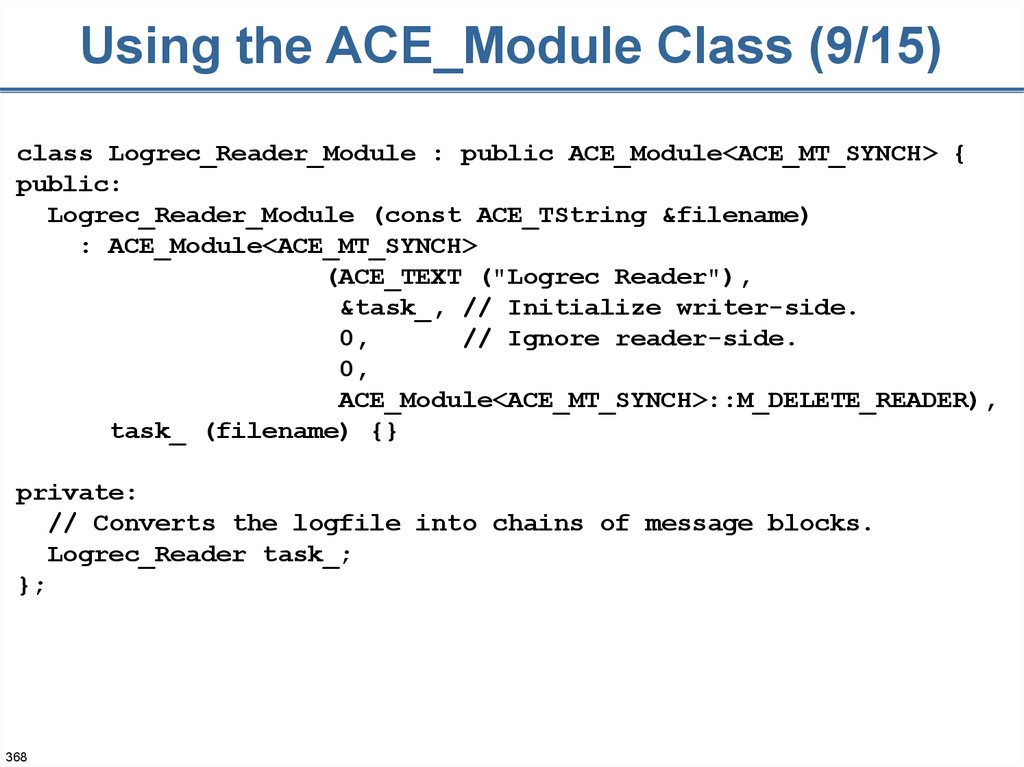
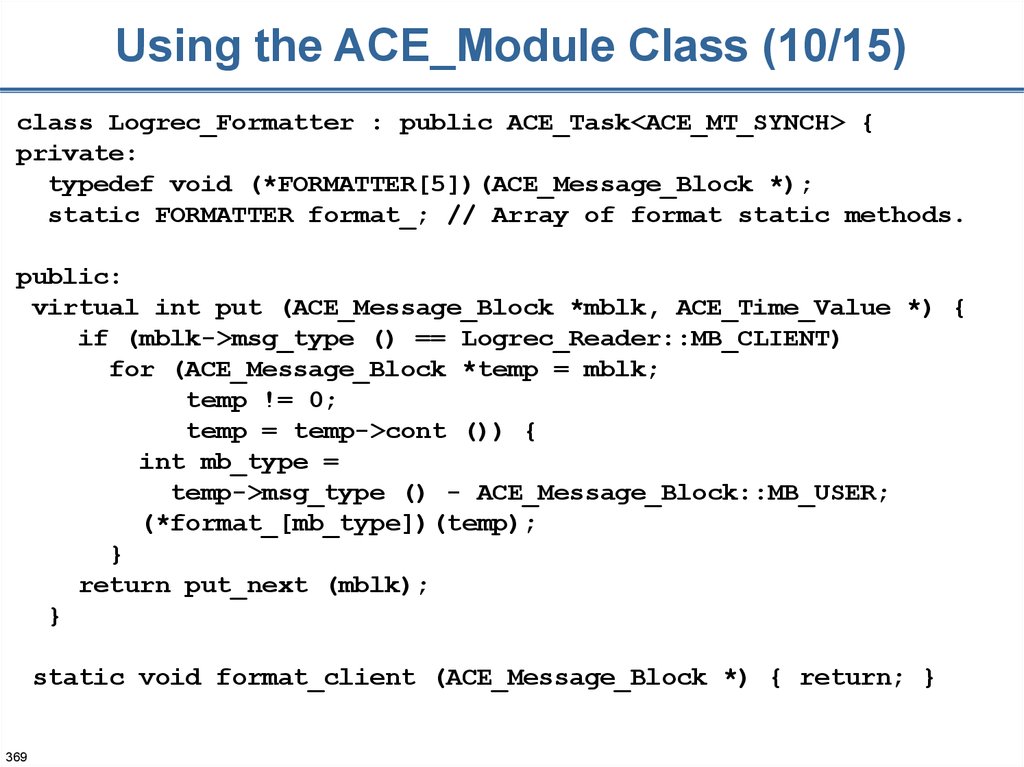
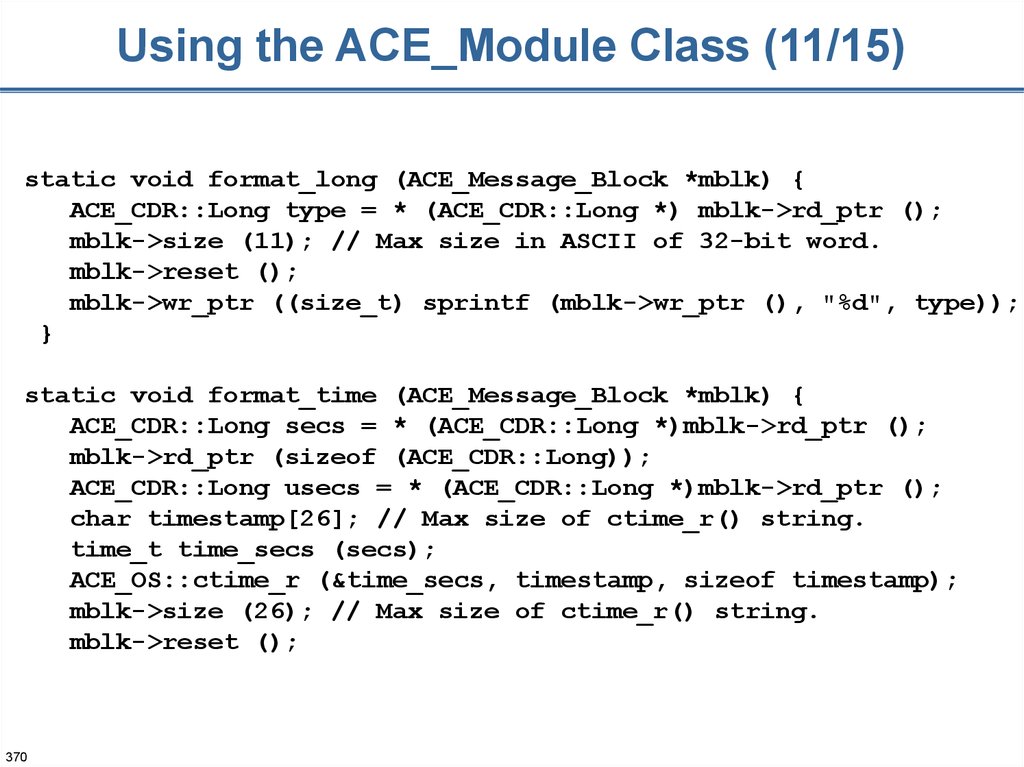
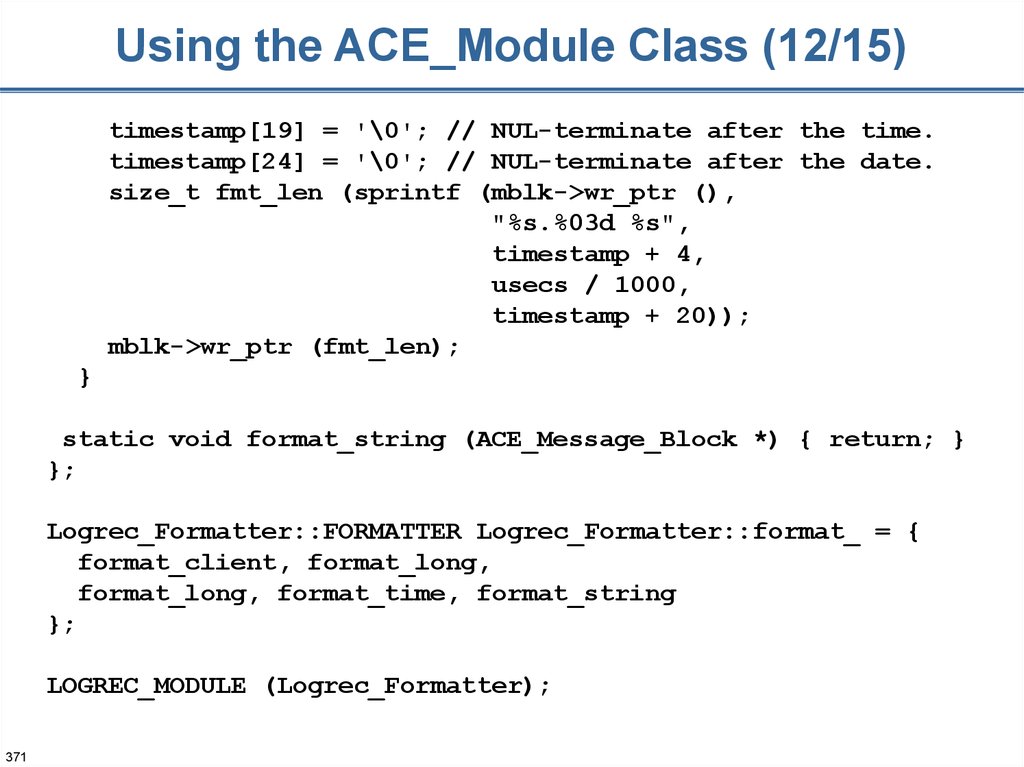


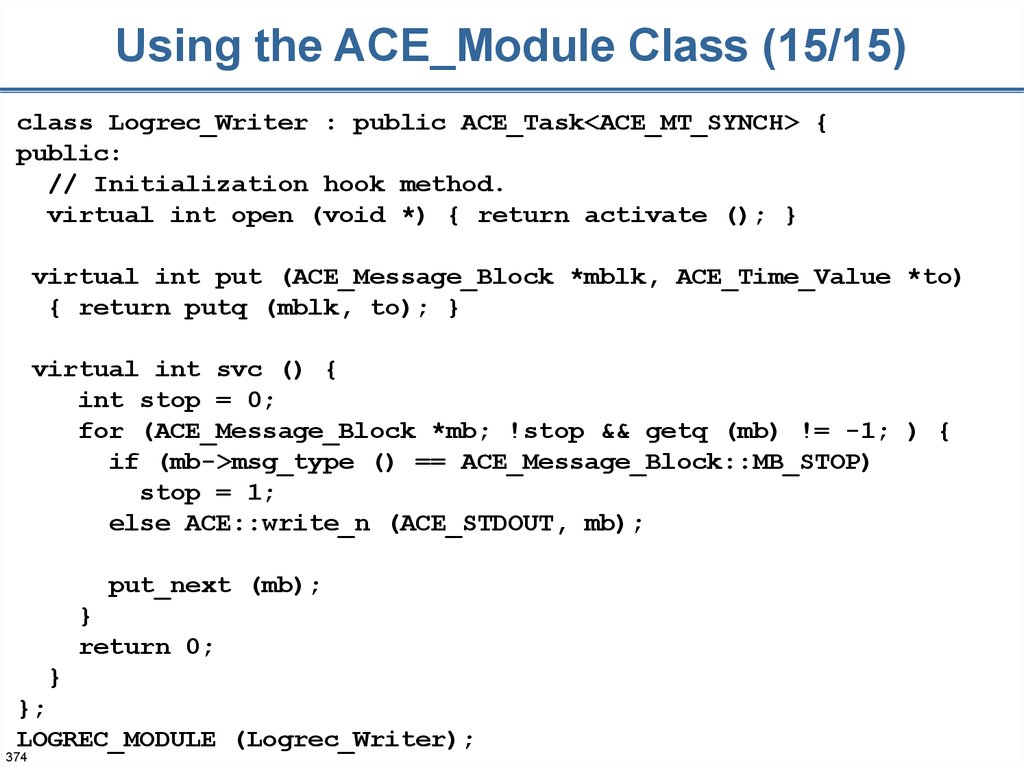
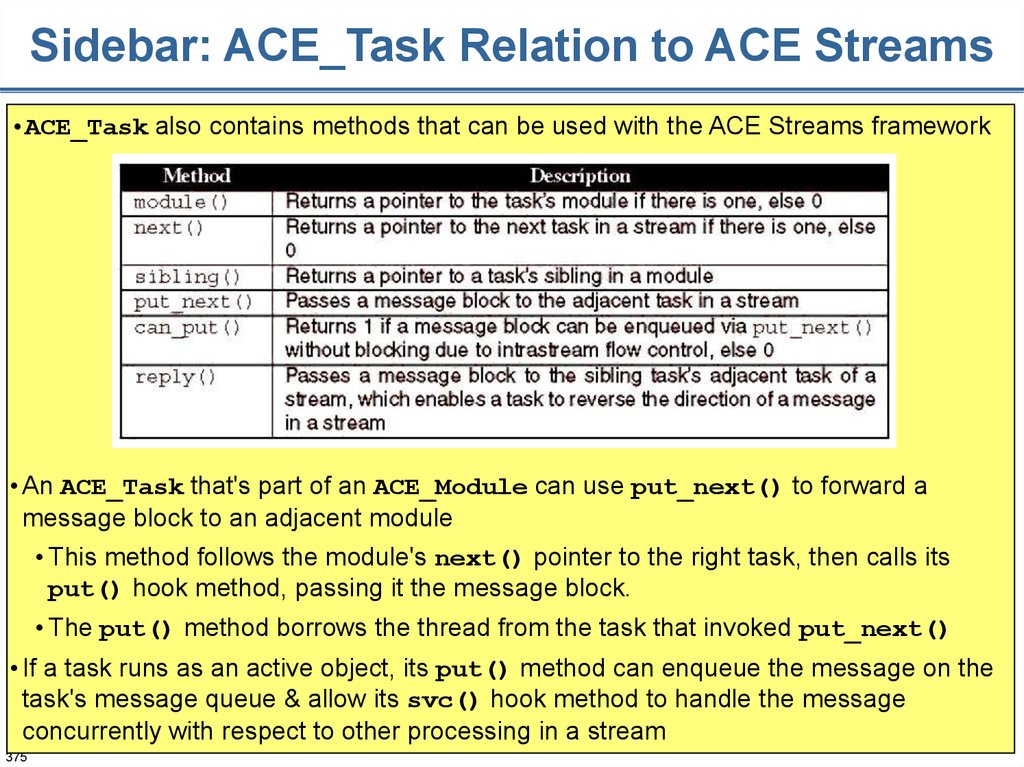

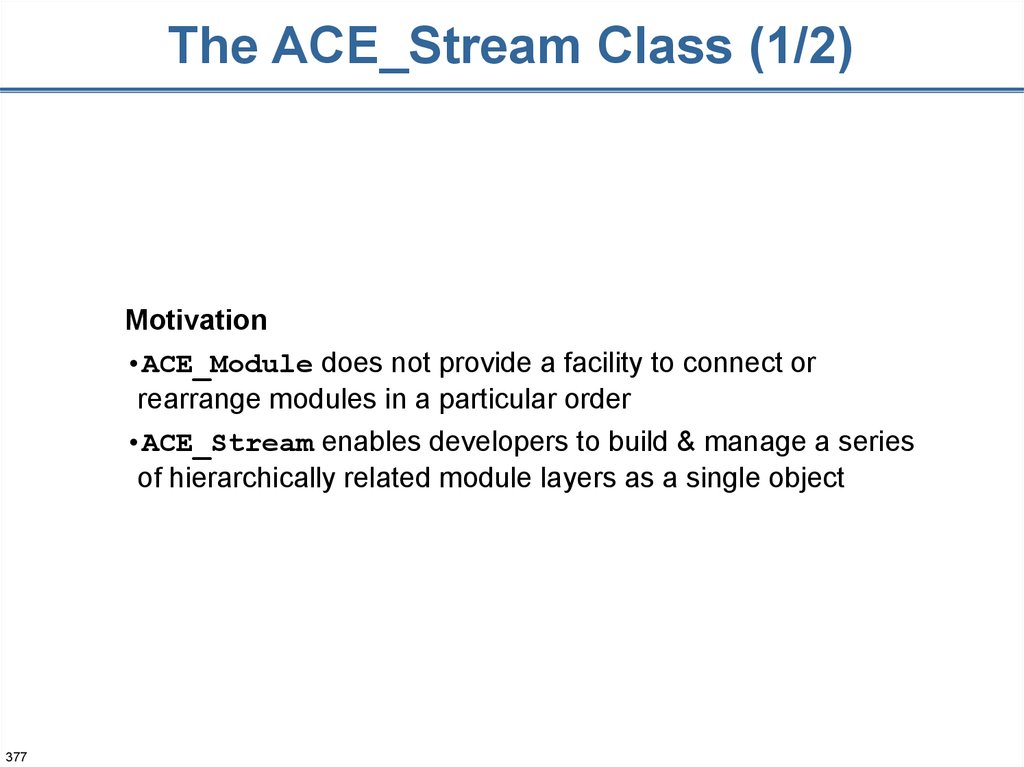
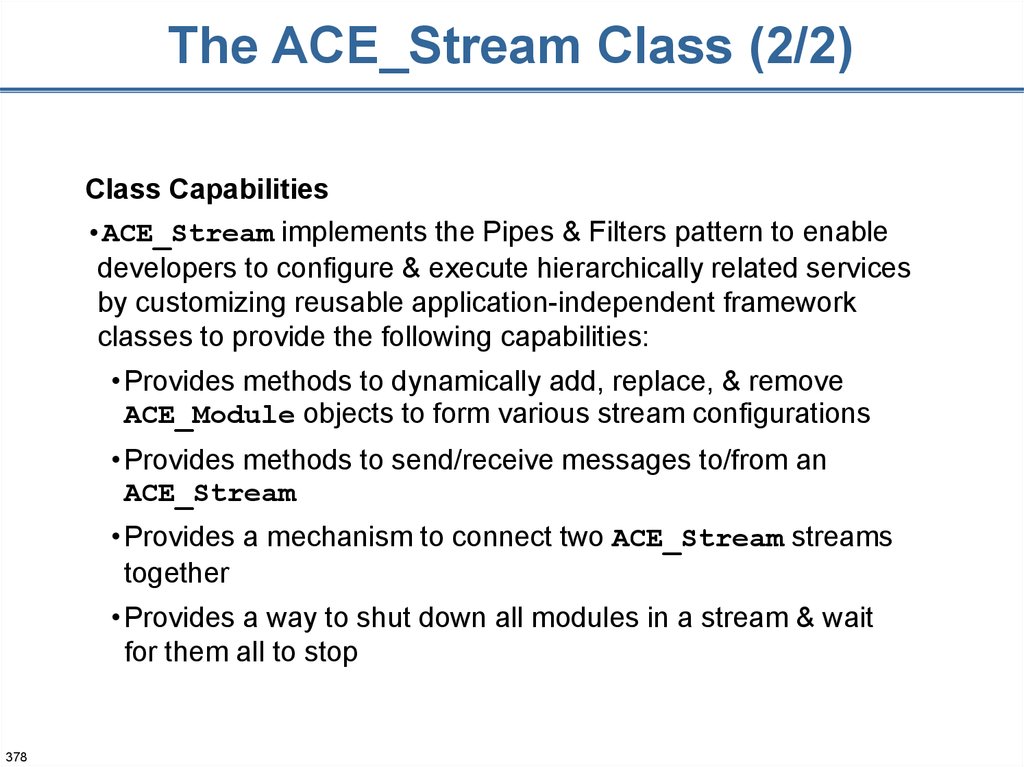
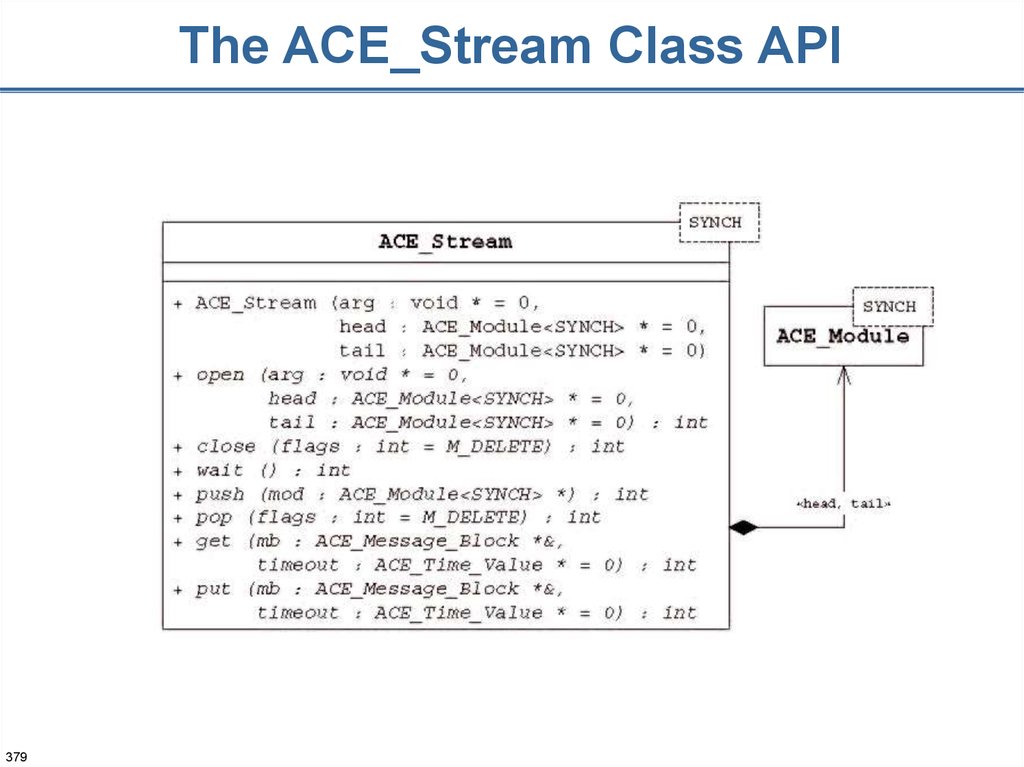
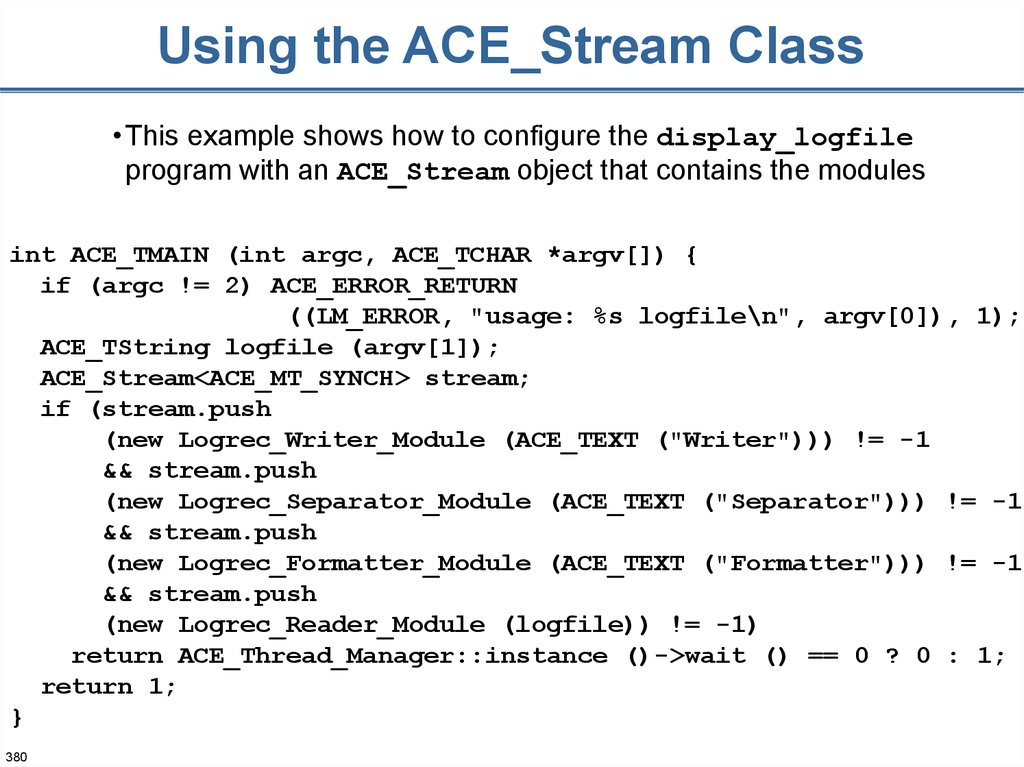


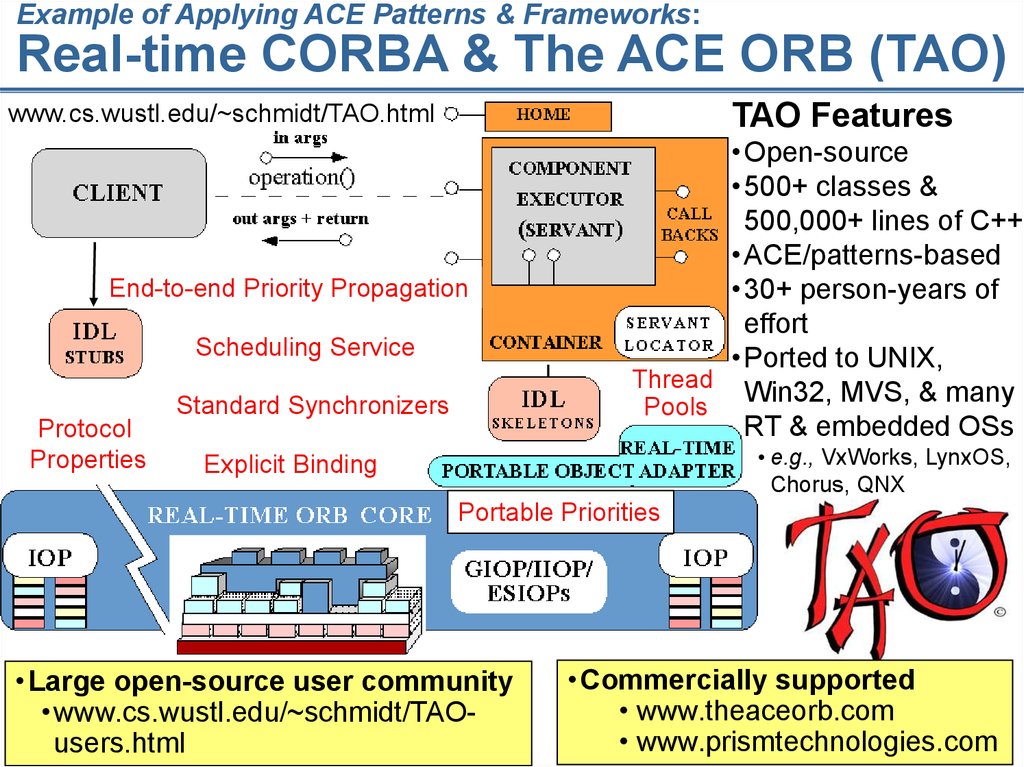
 internet
internet programming
programming








